- South Africa
- Afghanistan
- North Korea
- Adventure + Outdoors
- Amusement Parks
- Backpacking Trips
- Boating + Cruises
- Budget Travel
- Bus + Train Travel
- Coasts + Islands
- Country Trips
- Fall Vacations
- Family Vacations
- Green Travel
- Heritage + History
- Honeymoons + Romance
- Inspiration + Guide
- Landmarks + Attractions
- LGBT Travel
- Markets + Bazaars
- National Parks + Reserves
- Nature + Wildlife
- Parks + Gardens
- Pets + Animals
- Photography
- Airlines + Airports
- Budgeting + Currency
- Business Travel
- Celebrity Travel
- Customs + Immigration
- Deals + Rewards
- Family Travel
- Hotels + Resorts
- Luggage + Packing Tips
- Offbeat News
- Photography Tips
- Responsible Travel
- Solo Travel
- Tech + Gear
- Travel Etiquette
- Travel Warnings
- Bars + Clubs
- Celebrity Chefs
- Restaurants + Cafés
- Wine + Vineyards
- Beach Hotels
- Boutique Hotels
- Hotel Openings
- Hotel Reviews
- Luxury Hotels
- Mountain + Ski Resorts
- Spa Resorts
- Vacation Rentals
- Asia Cruises
- European Cruises
- Festivals + Events
- Museums + Galleries
- Style + Design
- Travel’s Best
- Hotel with Agoda.com
- Hotel with Booking.com


Bohol blog. The ultimate guide to the island of Bohol
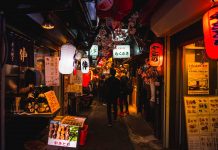
Suggested Tokyo travel itinerary 3 days. How to spend 3 days…
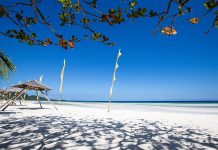
Bohol travel blog — The fullest Bohol travel guide for first-timers
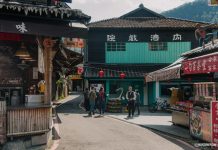
Where to go in Hsinchu? 14 famous attractions, best places to…

The complete Seoul subway guide: How to use, lines, fares for…

How much does it cost to travel to Korea? Tips on…

The ultimate guide to NETS FlashPay Card: What is it, how…

How much will it cost to go to Singapore? Tips on…

13 best, most famous & popular bubble tea in Taiwan

Where to eat in Penang? 17 best places to eat &…

Best bubble tea in Taiwan — Top 11 most famous &…

29+ must-try foods in Thailand

11+ best homestays in Kuala Lumpur near famous tourist attractions

Mövenpick Resort Kuredhivaru Maldives reviews. The detailed review of my vacation…

Hyatt Regency Danang Resort and Spa reviews. The resort is highly…

+7 luxury resorts you must stay in Danang, Vietnam

10 must-know things for your best first time European river cruise

Top 3 best luxury cruises in Halong Bay, Vietnam

Cherry blossom festival Korea 2024 — Top 5 cherry blossom festivals…

Ghibli museum blog — The fullest Ghibli museum guide for first-timers

Kyoto festival — Top 10 best events & most famous festivals…

National Palace Museum Taipei blog — What to see in National…

Japanese waterfall — Top 10 most beautiful waterfalls in Japan in…

19+ most beautiful towns in Europe every tourist need to visit…

Georgia travel photos — 20+ captivating photos show Georgia is heaven…

Explore Damnoen Floating Market — The oldest floating market of Thailand

Visiting Fenghuang Ancient Town — One of the most charming ancient…

Mekong Delta travel blog — Beyond rivers of Southwestern Vietnam

14 reasons why you should travel when you are young

Shigaraki Tanuki – An animal symbol of good luck in Japan

Living in the charms of cave houses in Andalucia, Southern Spain

20+ jaw-dropping tiny homes around the world
Potsdam blog — the super potsdam travel guide for first-timers.
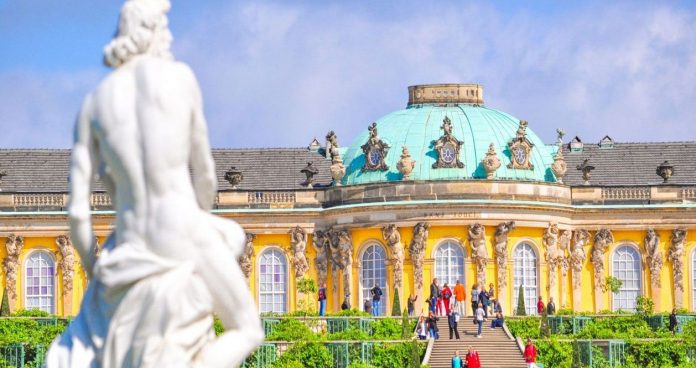
Less than an hour traveling by train from Berlin is the city of Potsdam, one of the best day trip destinations from Berlin , a tourist paradise for those looking to escape the hustle and bustle of Berlin and an ideal place to stop for those who love to explore history, quaint architectures, a peaceful atmosphere, grand gardens and magnificent palaces and churches. Potsdam is one of the most richest cities in terms of history of Germany. So, is Potsdam worth visiting, what to do and how to plan a perfect budget trip to Potsdam for the first-time? Let’s check out our Potsdam blog with the fullest Potsdam travel guide (Potsdam guide, Potsdam tourist guide) from how to get there, best time to come, where to stay, best places to visit and top things to do to find out the answer!
- What to buy in Germany? — Top 19+ gifts, souvenirs & best things to buy in Germany
- Zugspitze blog — The fullest Zugspitze travel guide for a spectacular Zugspitze trekking trip
- Dresden travel blog — The fullest Dresden travel guide for first-timers
- Frankfurt travel blog — The fullest Frankfurt travel guide for first-timers
- Bonn travel blog — The fullest Bonn travel guide & what to do in Bonn Germany
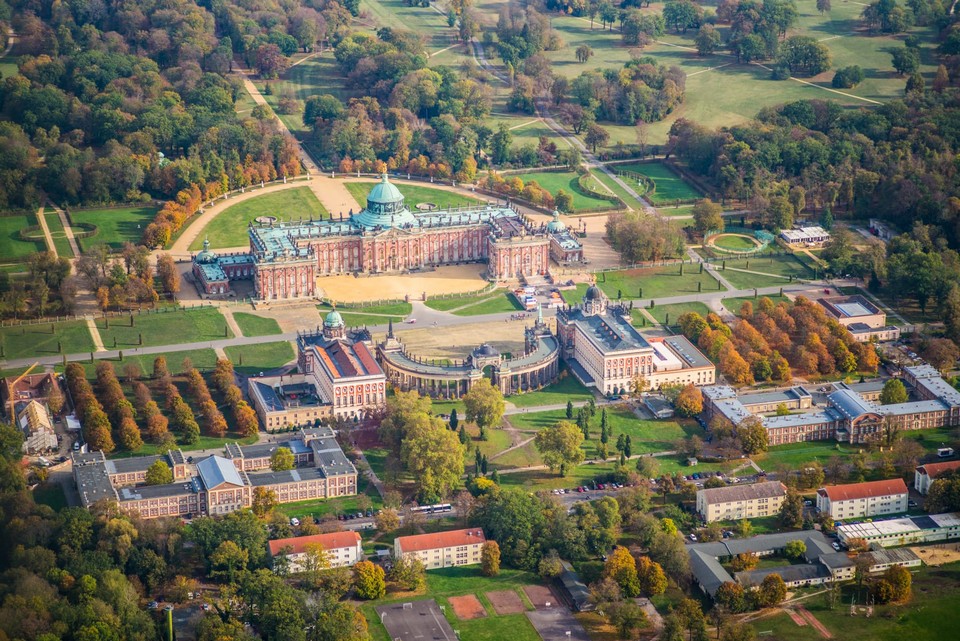
Potsdam blog: Overview of Postdam
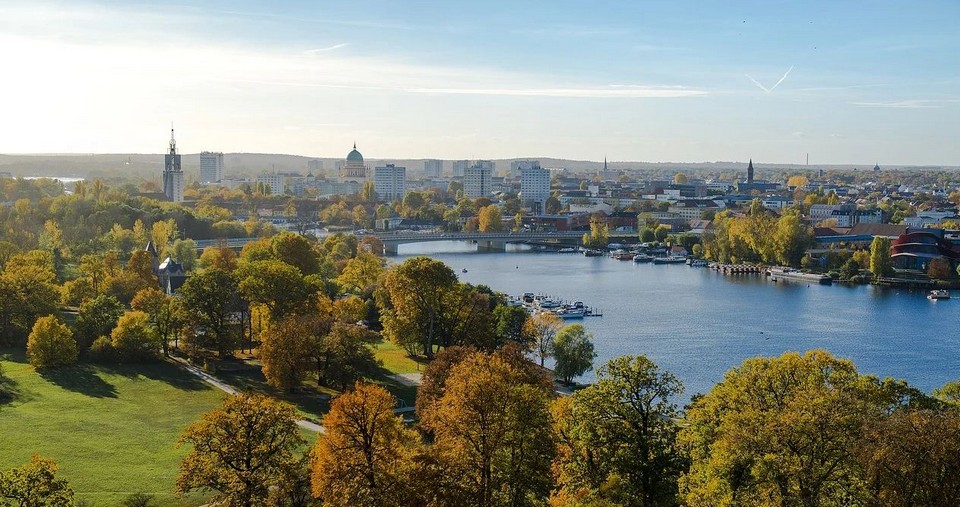
Potsdam is the capital of the state of Brandenburg and is 35 km from Berlin. This city was known as the ancient capital of the Kingdom of Prussia (1701-1918) with many famous, stunning palaces. The city has been recognized as a UNESCO World Heritage Site in Dec, 1990 and has officially became the largest recognized complex in Germany.
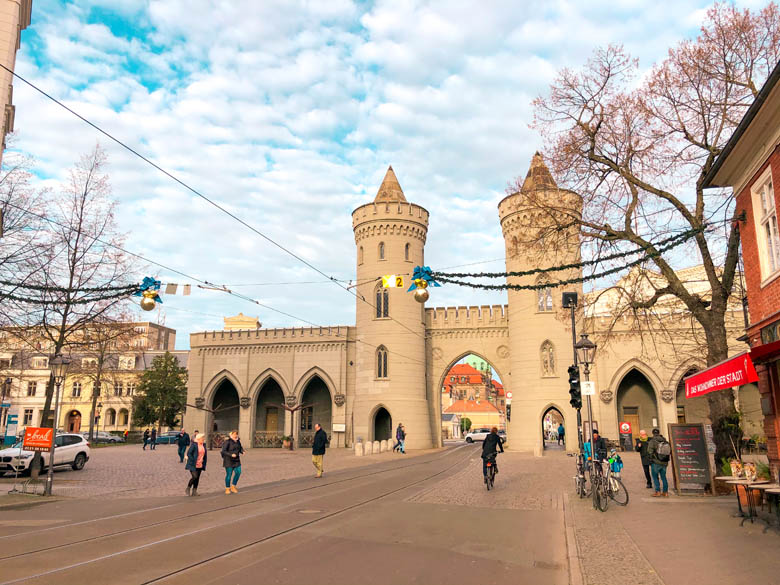
Potsdam is dubbed the Hollywood of Germany, the neighbor of Berlin, has the largest number of palaces in Germany. Multinational influences from France, Switzerland, the Netherlands and many other countries have strongly influenced the lifestyle, culture and architecture of this city. In addition, the unique architecture and landscape of Potsdam, which has long been chosen by kings as their residential place, is also chosen by filmmakers as an ideal filming location. A series of famous movie works were filmed in Potsdam such as: The Blue Angel (Der blaue Engel), The Pianist (Der Pianist), Around the World in Eighty Days (Reise um die Erde in 80 Tagen), Inglourious Basterds…
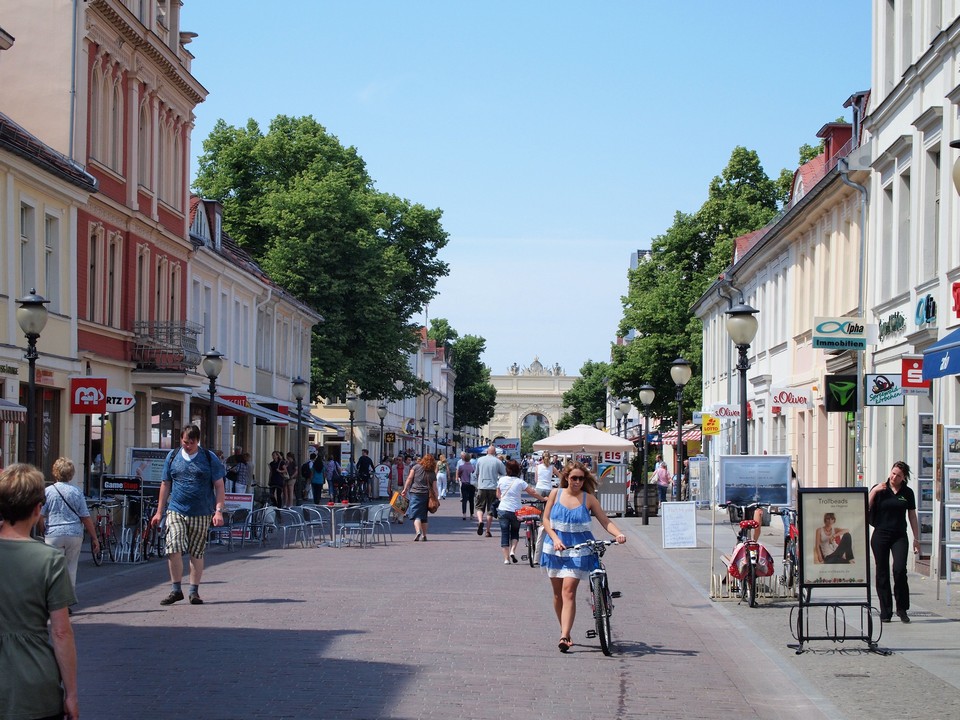
Potsdam blog: When to come?
Potsdam owns the oceanic climate prevailing with chilly winters and warm summers. The rainiest months fall in months of Nov, Dec and Jun. The average temperatures ranging from 3 Celsius degrees (Jan) to 24 Celsius degrees (Jul).
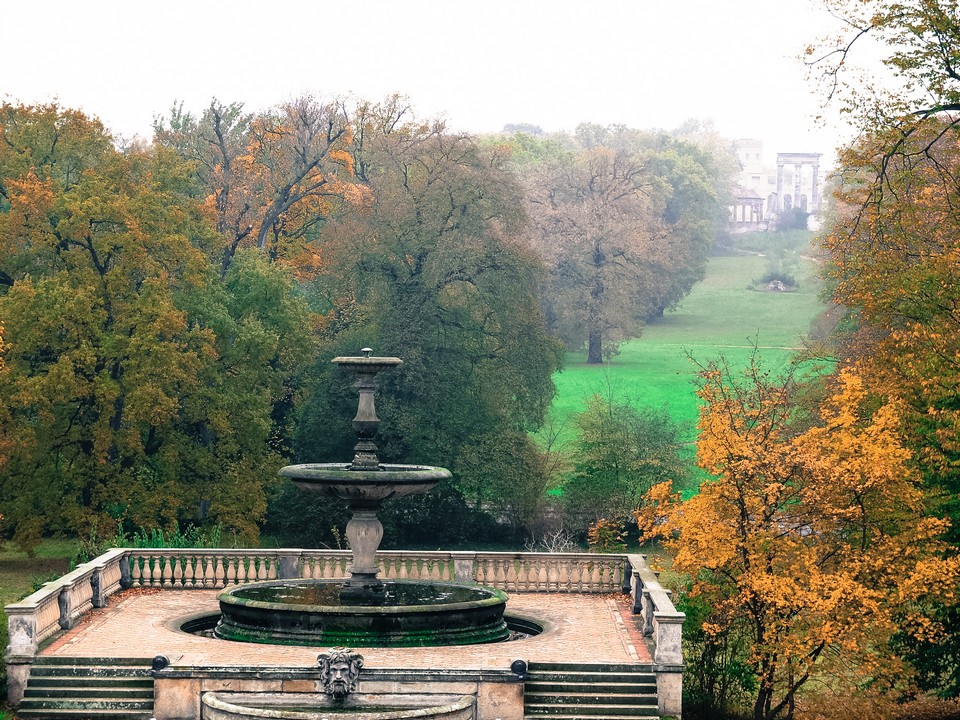
The best time to travel to Potsdam is from July to September with pleasant temperature (maximum of 25 Celsius degrees in July) and limited rainfall and during spring season (March through May) with pleasant weather and cherry blossoms bloom everywhere. However, winter is also a good time to come if you love snow and the atmosphere of Christmas markets while autumn is gentle, charm and calm.

Potsdam travel guide: How to get to Potsdam from Berlin?
There 2 ways to travel to Potsdam, one by S-bahn (skytrain) S7 or the other by RE1 (DB train) as describe in the table below.
You should buy Berlin Zone ABC ticket to be able to travel comfortably in the center of Berlin and the city of Potsdam. Because Potsdam is located in Zone C, so buying this type of ticket is more convenient than buying a single ticket to travel from Berlin to Potsdam. I highly recommend to buy a day pass (day ticket) of EUR 7.7 because a single ticket costs EUR 3.4/way. With a day pass, you can go all buses/trams in Potsdam for free! For more information about transportation and train tickets in Berlin, please refer to my previous post here .
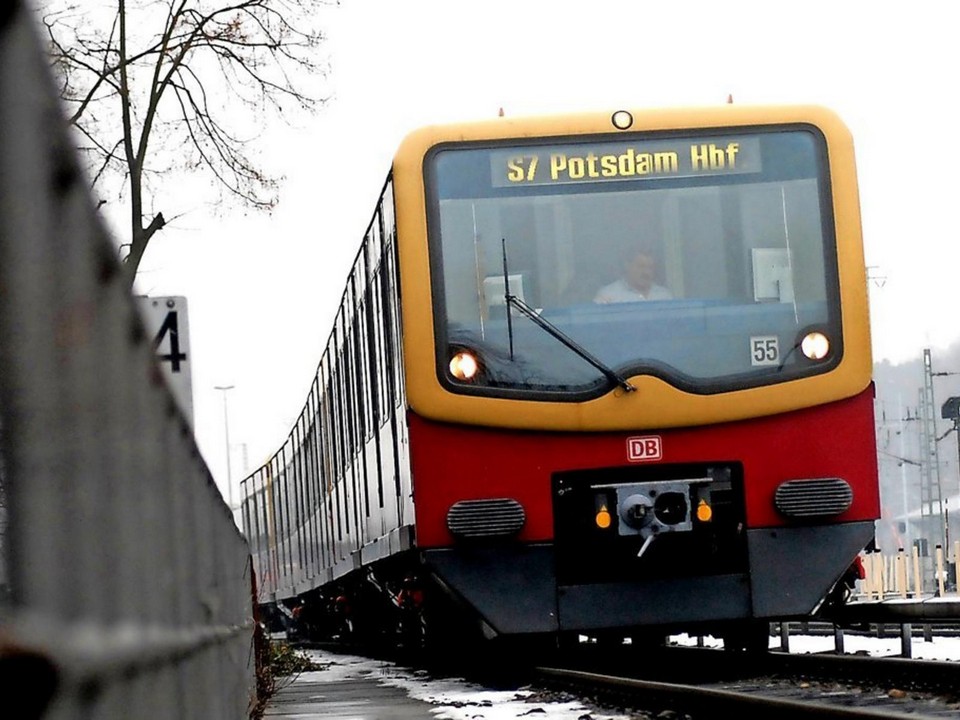
Depending on where you stay in Berlin to choose to take S-bahn or DB train for your convenience. However, I recommend (for convenience and save time):
- If travel by RE1: Get off at Potsdam-Park Sanssouci station (don’t get off at Potsdam Hauptbahnhof because you have to take a bus ride to Sanssouci park).
- If travel by S7: Get off at Potsdam-Babelsberg station, walk about 2 minutes to Rathaus Babelsberg station, take bus 616 to visit the first Babelsberg Palace (vice versa the route above).
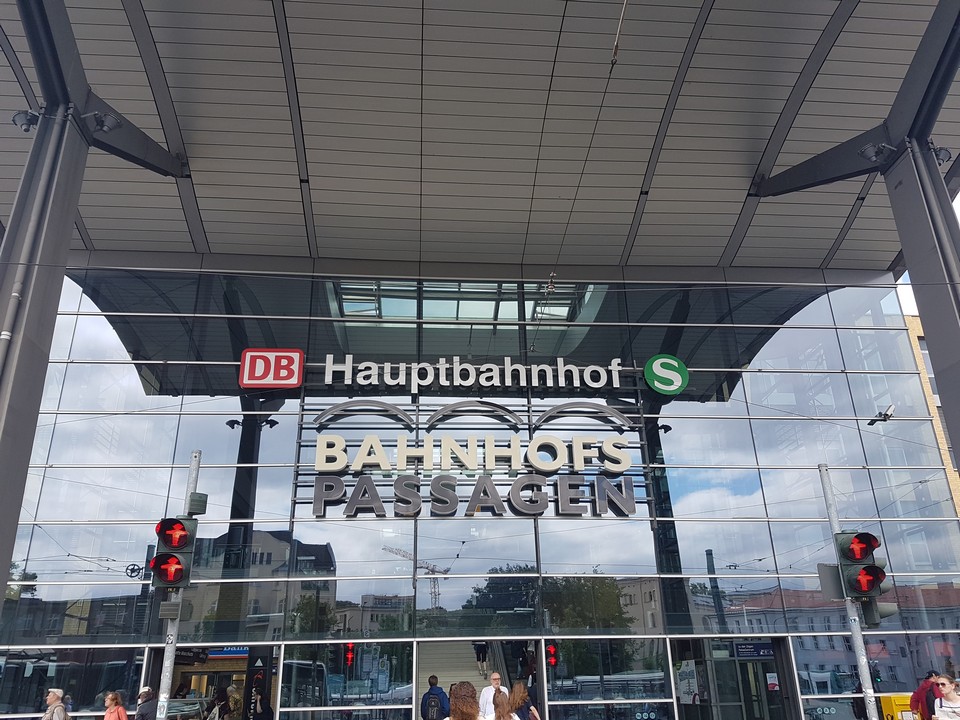
Potsdam tourist guide: Getting around Potsdam
You can also use the Berlin Zone ABC ticket above to take means of transport in Potsdam. The famous tourist attractions of Potsdam can be reach by bus easily.
Hop-on Hop-Off: €17. If you have a Welcome Card, it will be reduced to €12.5/person. The time I went in July was too hot, so I was afraid to find the way. So I bought hop-on hop-off sightseeing bus tour for convenience. The ticket counter is right at the entrance of the shopping mall where you will get off the train.
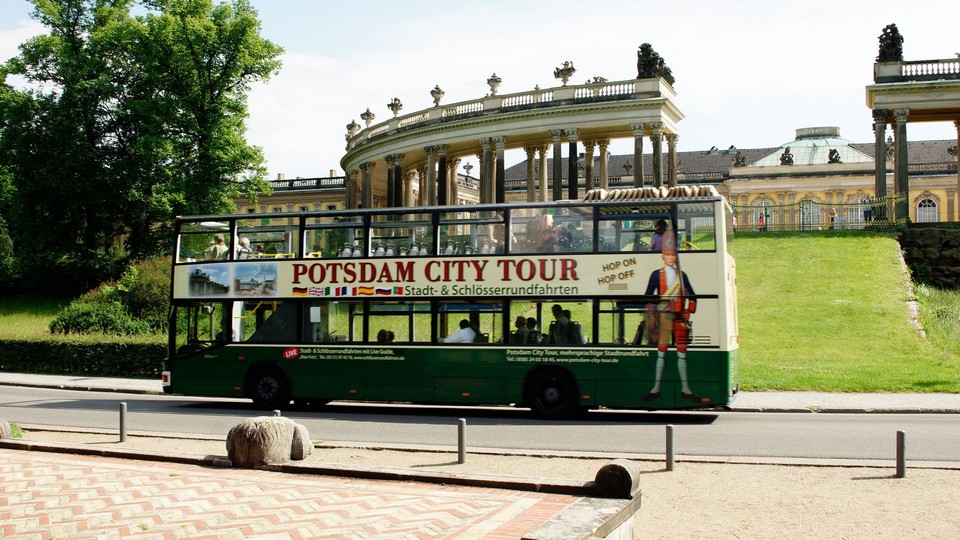
Potsdam blog: What to do and where to go?
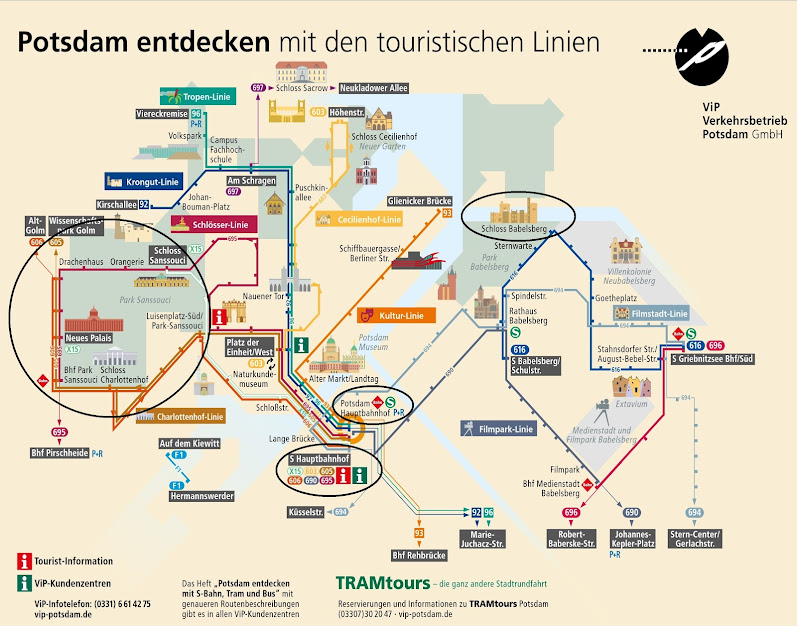
- Sanssouci Park: Including the entire part in the leftmost circle in the diagram above which is extremely large with a number of castles, palaces, churches, structures and gardens scattered.
- Sanssouci Palace (Schloss Sanssouci): The palace of the Prussian Royal Family. This is probably the most famous palace in Potsdam (though it’s not the biggest).
- New Palace (Neues Palais): The largest and second famous palace in Potsdam. It is also the largest Baroque Prussian palace.
- Charlottenhof Palace (Schloss Charlottenhof).
- Orangery Palace (Orangerieschloss): A palace for guests from other royal families stay when they visit Potsdam.
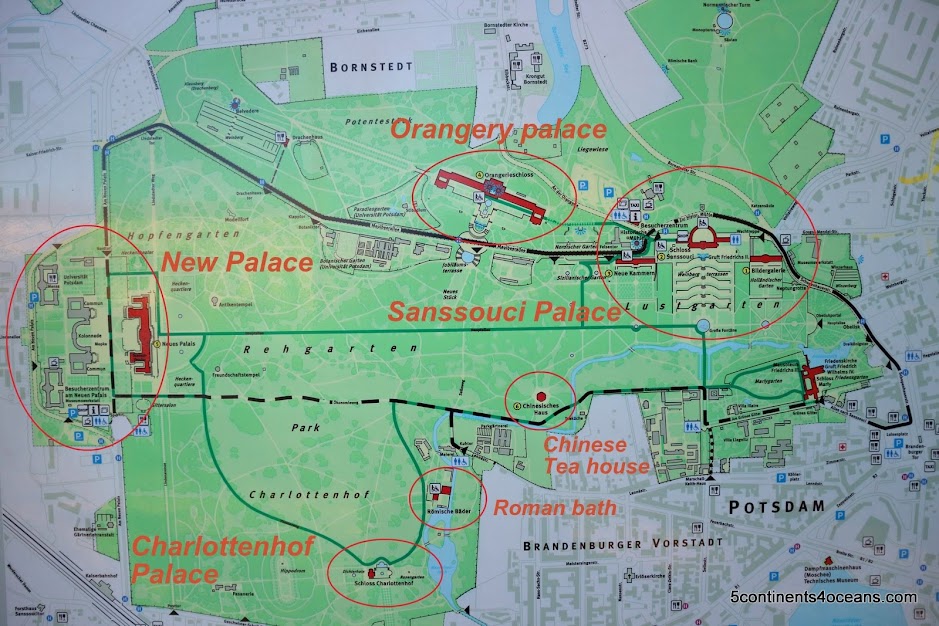
- Old Market Square (Alter Markt): This old square is located in the center of Potsdam.
- Dutch Quarter (Holländisches Viertel): Including 150 old Dutch-style houses.
Cecilienhof Palace (Schloss Cecilienhof): For those who love history, this is the site of the Potsdam Conference in 1945 when the three great powers of Britain, the United States, and the Soviet Union discussed the fate of Germany after World War II.
Babelsberg Palace (Schloss Babelsberg): Located on the Eastern part of the city (rightmost circle in the diagram above).
Suggested Potsdam itinerary 1 day
With only one day, I chose to visit the Eastern and Western areas of the city, skipping the central area (with 2 years living in the Netherlands, the “Dutch Old Quarter in Germany” is not attractive at all ^^!) and the northern area. To explore all the remaining places, the itinerary will be arranged as the picture below.

Sanssouci Park
Built as a royal garden around the Sanssouci palace at the request of Frederick the Great of the Kingdom of Prussia, it is now a complex of parks – botanical gardens – chapels – large palaces. Besides the architectural works, you will have the opportunity to visit the large flower gardens with the lake and many sculptures placed all over the ground.
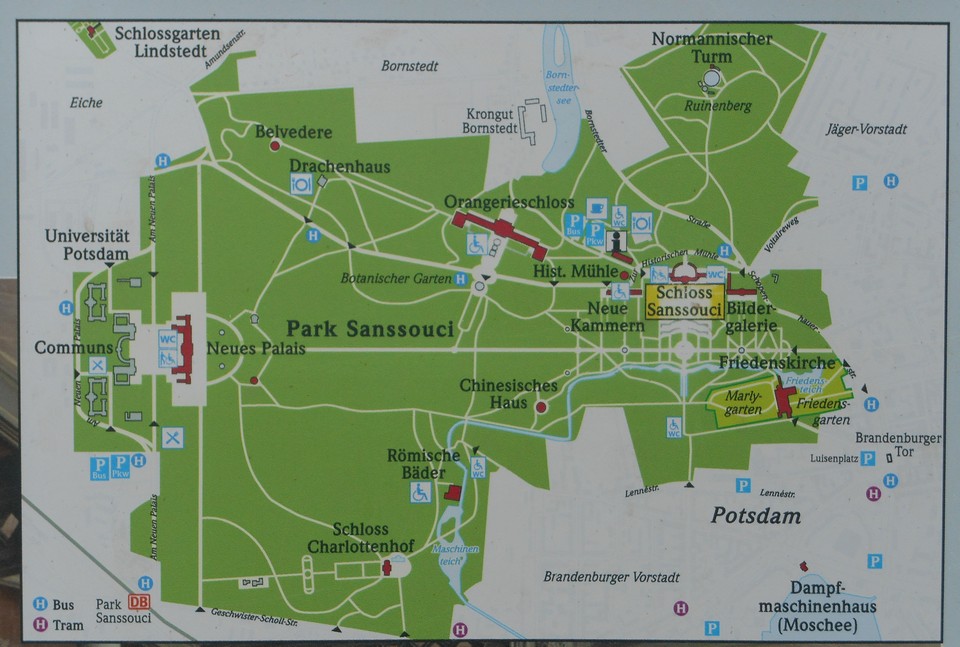
Sanssouci Park is now a UNESCO World Heritage Site, and you can visit it for free.
With seemingly endless roads but absolutely no vehicles, well-groomed hundreds of years old forests, ancient architectural works scattered all over the roads, Sanssouci Park is a Great destination for a day of outdoor activities, such as picnic, sports, travel, dating…
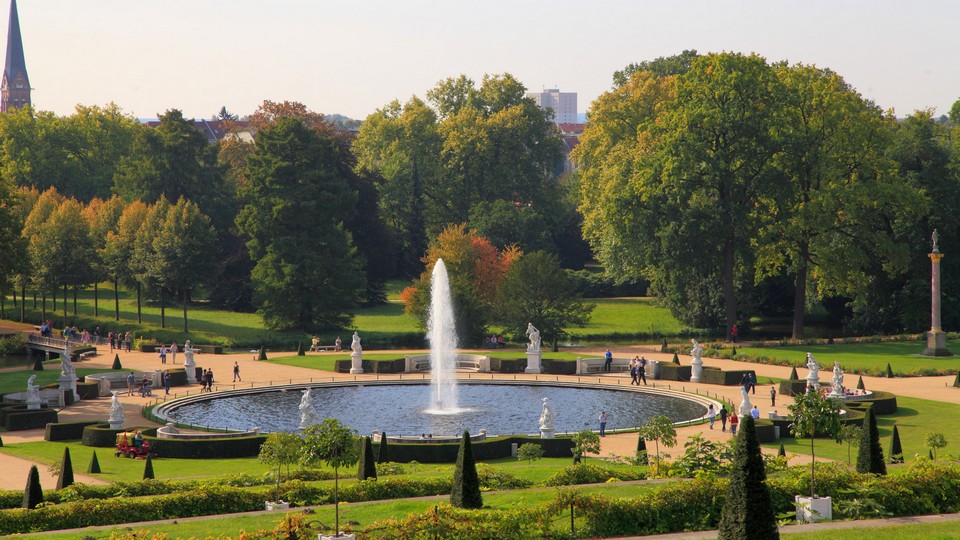
The fastest way to get to Sanssouci Park – Potsdam’s most popular tourist complex – is to take bus 695 from Potsdam Hbf Station. About 20 minutes by bus, then walking to come.
Sanssouci Palace
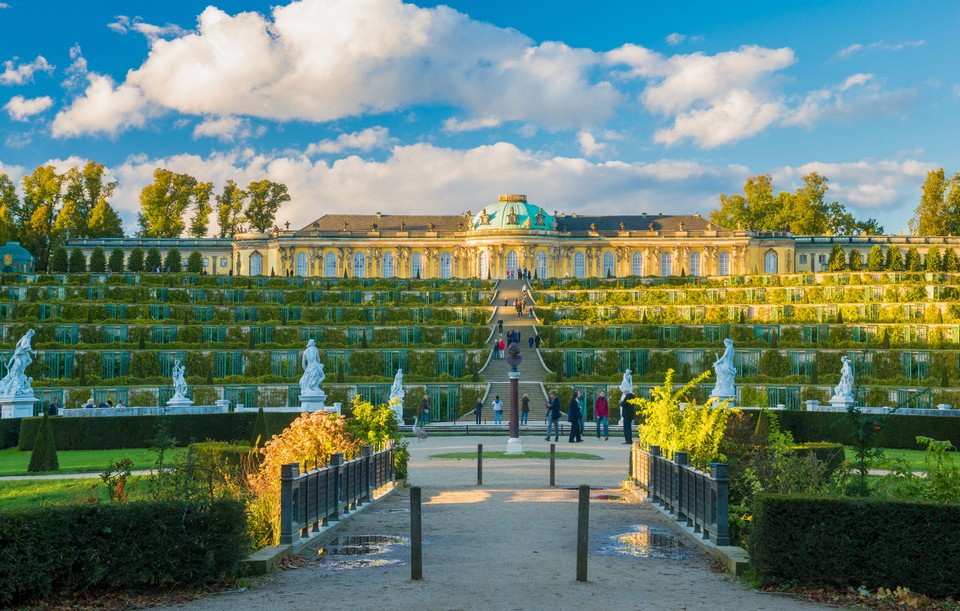
Referring to the city of Potsdam, the place cannot help but to mention is Sanssouci Palace – the summer palace of Frederick the Great II – King of Prussia, the Potsdam’s most famous attraction which was built in the architectural style of the 18th century and also one of the most visited places in Europe with more than 2 million visitors per year. The Palace of Sanssouci is often compared to the palace of Versailles in France with more than 200 large and small rooms, four ballrooms and a theater in Rococo style. Along with more than 400 statues from the ancient world of gods used to decorate the facades and railings, roofs.

This magnificent palace was built at the request of King Frederick the Great where he could rest and relax away from all the worries of court meetings in Berlin. The name of this palace is derived from a French word of “Sans Souci” which translates to “no worry”, “carefree” or “without worry” — is a resting place, relaxing, not involved in political affairs. The palace was built on top of a terraced hill in the center of the park of the same name.
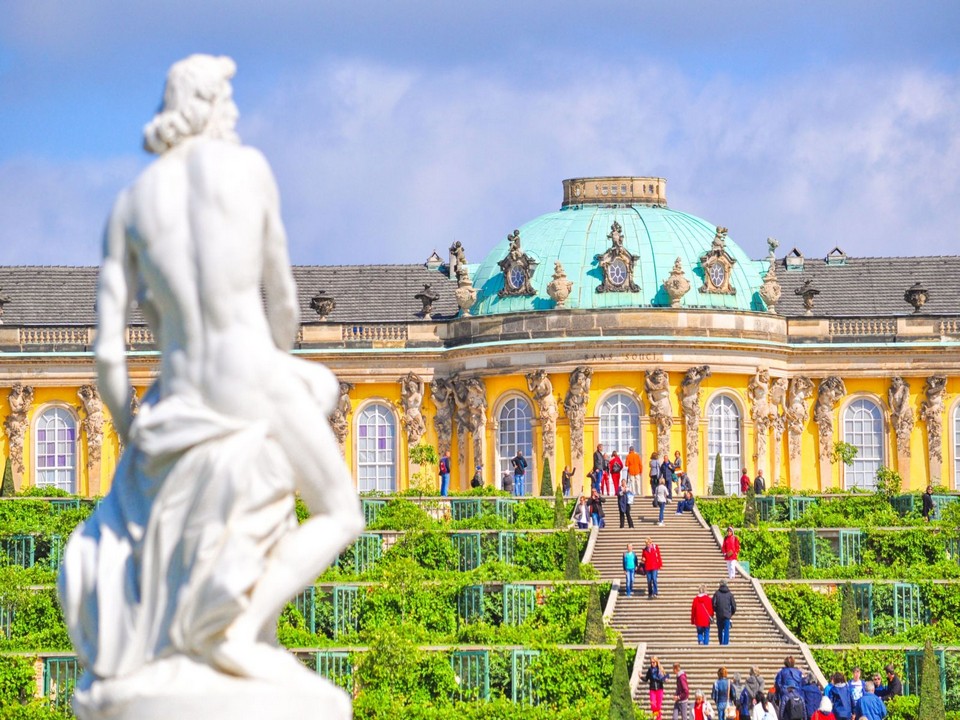
Sanssouci Palace is located opposite a beautiful terraced garden. During the 19th century, this was the residence of King Frederick William IV of Prussia, although Germany was severely damaged after World War II, the Sanssouci Palace remained almost intact, it shows a prosperous period of Germany in 18th century and the great talent of the architect Von Knobelsdorff. It is no coincidence that the palace of Sanssouci is considered the most formidable “rival” of the famous French palace of Versailles.
Address: Maulbeerallee, 14469 Potsdam, Germany Hours: 9AM–5:30PM/Monday: Closed
The Church of Peace (Friedenskirche)
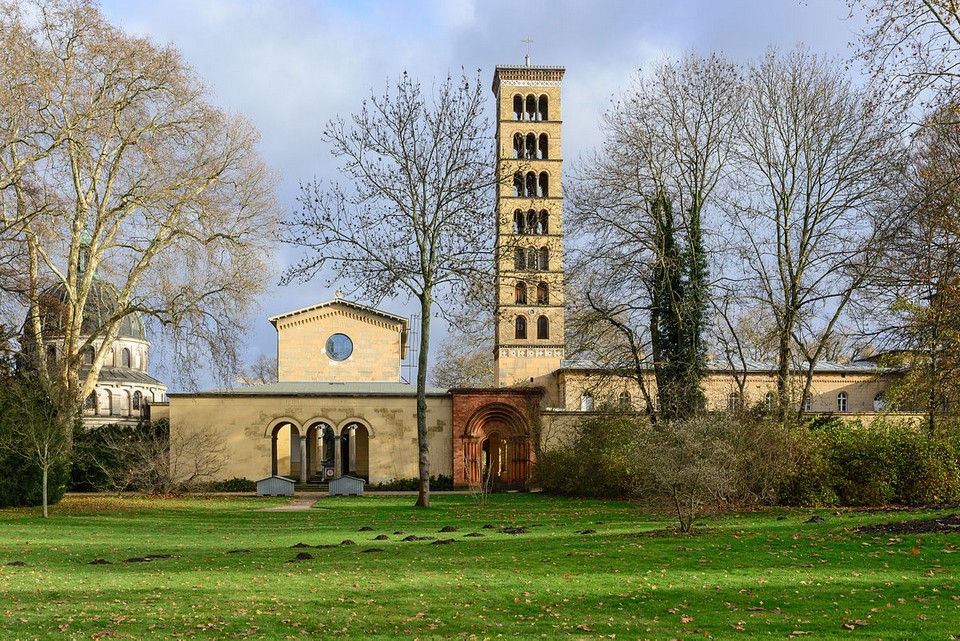
At the eastern end of Sanssouci Park is the Friedenskirche church (Church of Peace) built in accordance with the wishes of King Frederick William IV, this Protestant church completed in 1854, in medieval Italian style.
Address: Am Grünen Gitter 3, 14469 Potsdam, Germany Hours: Saturday: 11AM–4PM/Sunday: 11:30AM–4PM
Sanssouci Picture Gallery
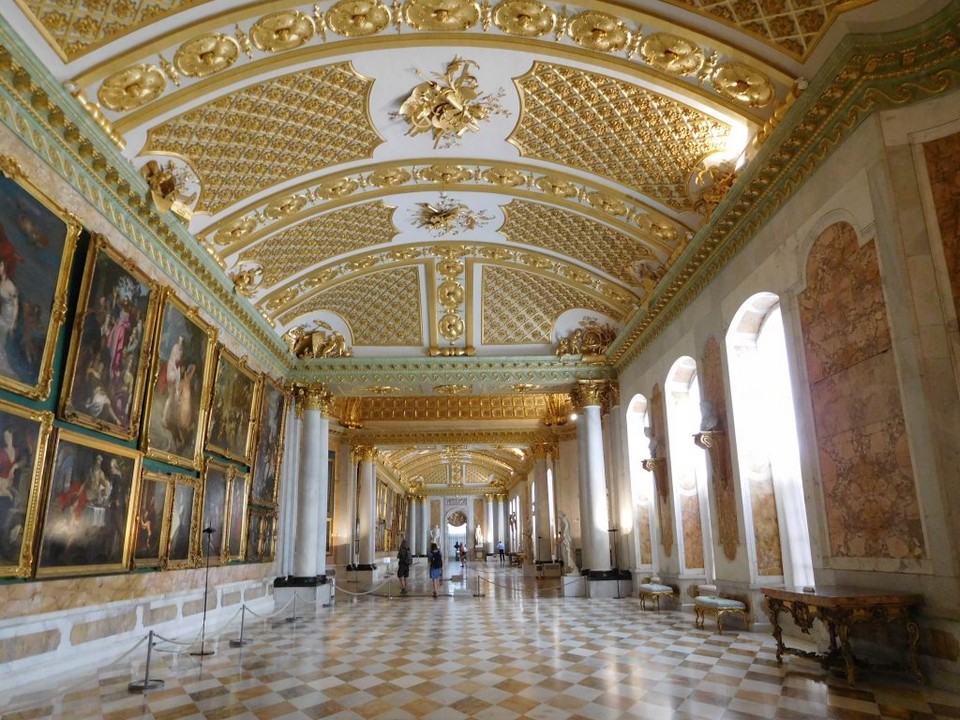
King Frederick II of Prussia was a man with a passion for the arts. So he built this art gallery. Having existed since 1764, it is now the oldest private picture gallery of a German ruler.
A 3-min walk from Sanssouci Palace Address: Im Park Sanssouci 4, 14469 Potsdam, Germany Hours: 10AM–5:30PM/Monday: Closed
Chinese House and Roman Bath
On the walk from Sanssouci Palace to Charlottenhof Palace, you will pass these 2 places. These two works are small, so it only takes about 10 minutes to visit them.
Chinese House is a small pavilion built by King Frederick the Great to decorate his fruit garden. It is called “Chinese House” because it has a very Chinese “chinoiserie” architecture.
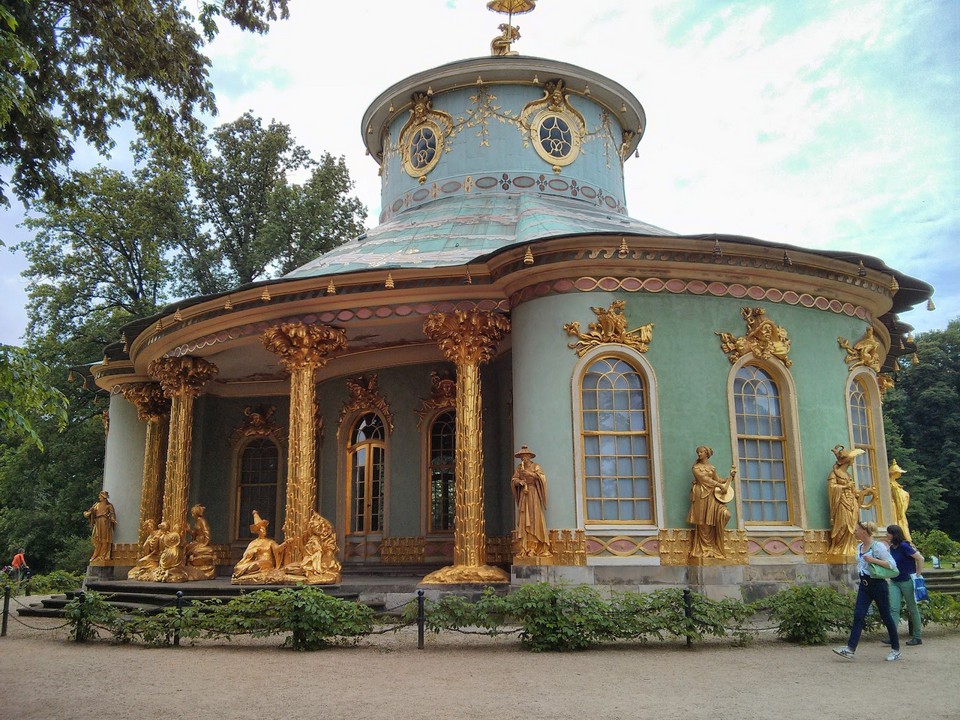
Address: Am Grünen Gitter, 14469 Potsdam, Germany
New Palace (Neues Palais)
It is the most magnificent architecture of Sanssouci Park, located at the western end of the park. Neues Palais was built between 1763-1969 with stand out of red brick walls and a large bronze dome. The interior of the palace is splendid decorated, especially in the Marble Hall, Upper and Lower State Apartments, Marble Gallery and Theatre. The palace has valuable furniture, paintings, porcelain and works of art.
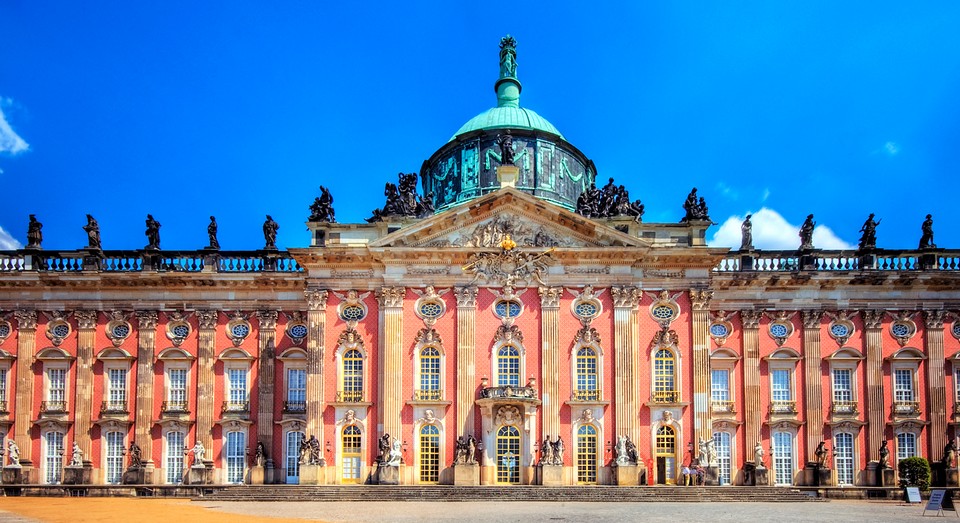
The construction started in 1763 and completed in 1769, after the 7-year war, the New Palace is considered the largest Prussian baroque structure ever built. Some of buildings of this palace are also used by the University of Potsdam as its campus, the school is very beautiful.
Address: Am Neuen Palais, 14469 Potsdam, Germany Hours: 10AM–5:30PM/Tuesday: Closed
Charlottenhof Palace
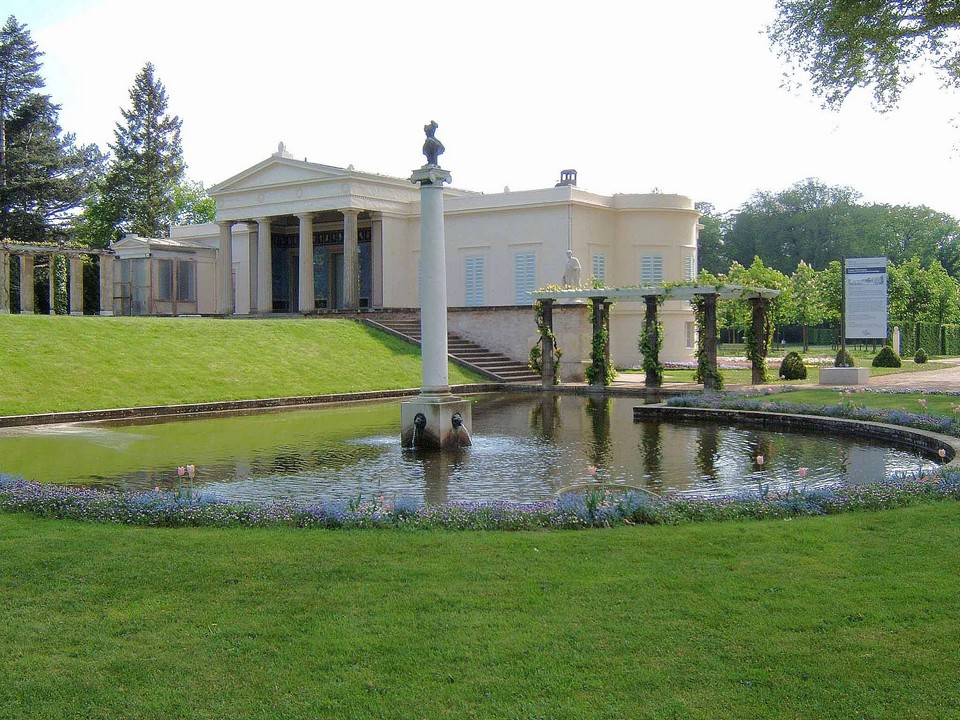
The Neoclassical architecture palace is neither big nor flashy, but it has a corridor covered with grape vines. When autumn comes you will see the red and green grape leaves covering the corridor and full of fruit.
Address: Geschwister-Scholl-Straße 34A, 14471 Potsdam, Germany
Babelsberg Palace
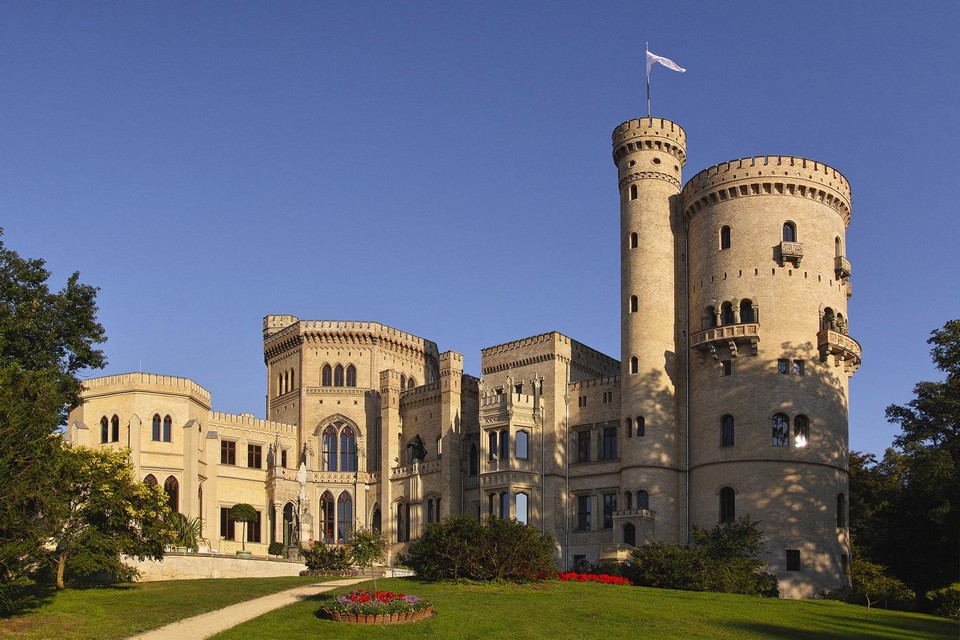
This palace has a direct view of Lake Glienicker and the bridge of the same name. Not too famous, located quite far away from center, having to change buses many times, so it’s very deserted. In return, it’s a beautiful palace, beautiful view and peaceful, I like this beauty.
Located in the Babelsberg forest, Babelsberg Palace was the summer palace of Wilhelm I, the first emperor of the German Empire for almost 50 years. The palace was built in the English Middle Ages style from 1835-1849, a style that also influenced a number of other palace such as Kittendorf Palace in Mecklenburg. The palace once witnessed an important historical event when Emperor Wilhelm I appointed Otto von Bismack as chancellor, who then brought Germany into the ranks of the great powers in Europe.
Address: Park Babelsberg 10, 14482 Potsdam, Germany Opened: 1849
Orangery Palace
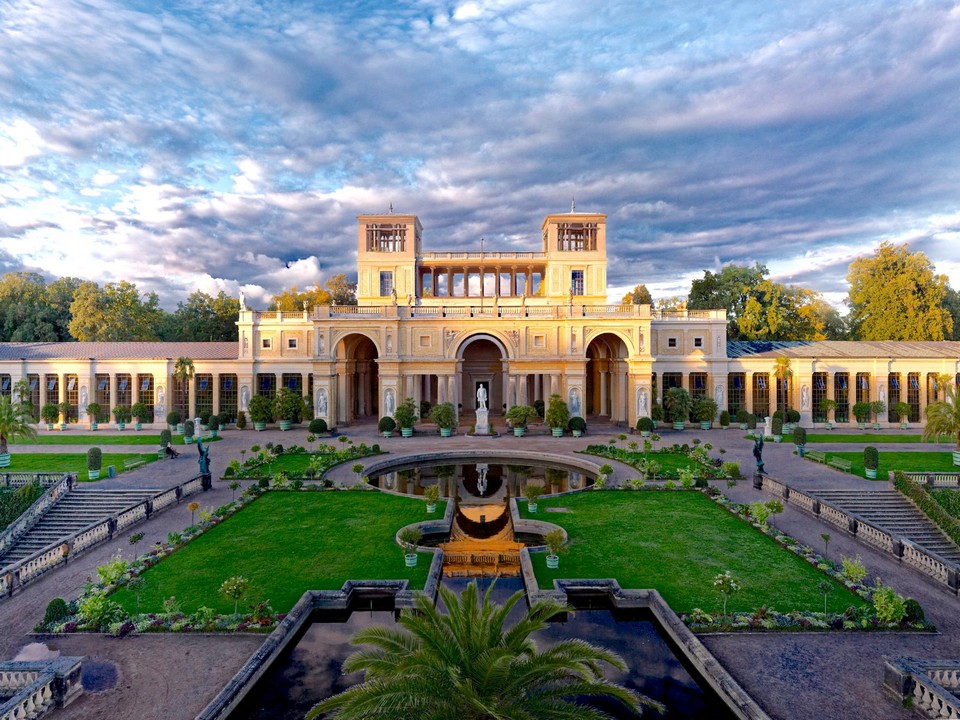
Actually, it is not very beautiful, but the walking path from this palace to Sanssouci passes through many beautiful gardens (especially in autumn).
Address: An der Orangerie 3-5, 14469 Potsdam, Germany Architectural style: Renaissance Revival architecture Opened: 1864
Marmorpalais (or Marble Palace)
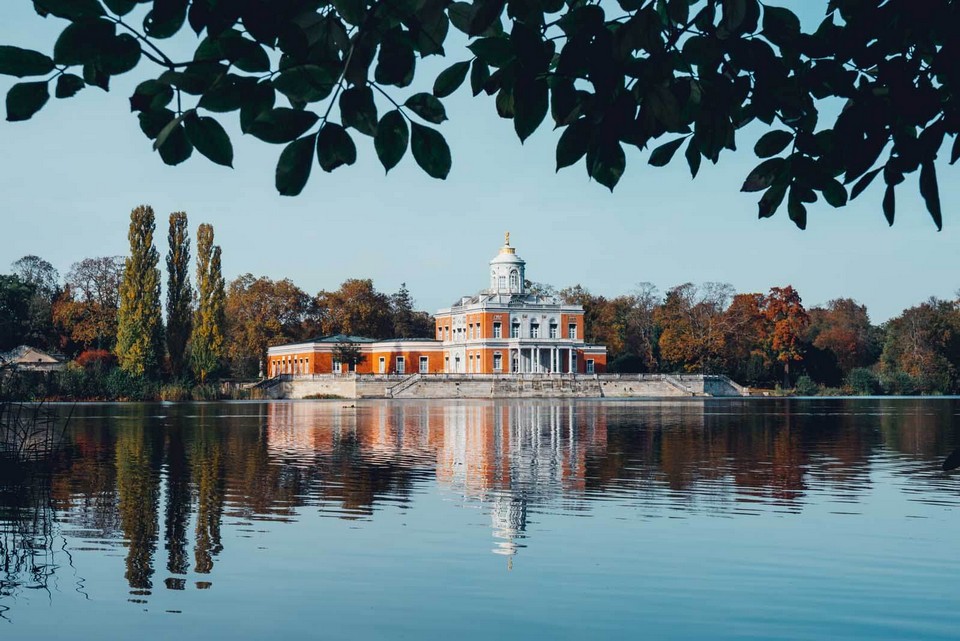
Once the palace of the Prussian royal family until the early 20th century, the Marmorpalais was built by King Frederick Wilhelm II shortly after he succeeded King Frederick the Great. The palace was originally built of red brick, in neoclassical style, with a garden and river view. However, the palace was later named after the white or gray marble from Silesia that was used to support its pillars and decorative motifs.
The palace was given by the king to his mistress, Countess Lichtenau, and she was a direct influence on the interior design process for the palace. After World War II, the East German government used the palace as a military museum. Currently, the palace serves as a cultural and historical museum managed by the Prussian Palaces and Gardens Foundation Berlin-Brandenburg.
Address: Im Neuen Garten 10, 14469 Potsdam, Germany Opened: 1791
The Alte Rathaus (“Old Town Hall”)

Located in Alter Markt square, a splendid Baroque-style marble building built in 1753, featuring Corinthian stone columns. Extensively rebuilt after World War II, the building is used for exhibitions and concerts and houses the Potsdam Museum with its beautiful collections relating to local art, culture and history.
Address: Am Alten Markt 9, 14467 Potsdam, Germany Hours: 12–6PM/Monday: Closed
Babelsberg District
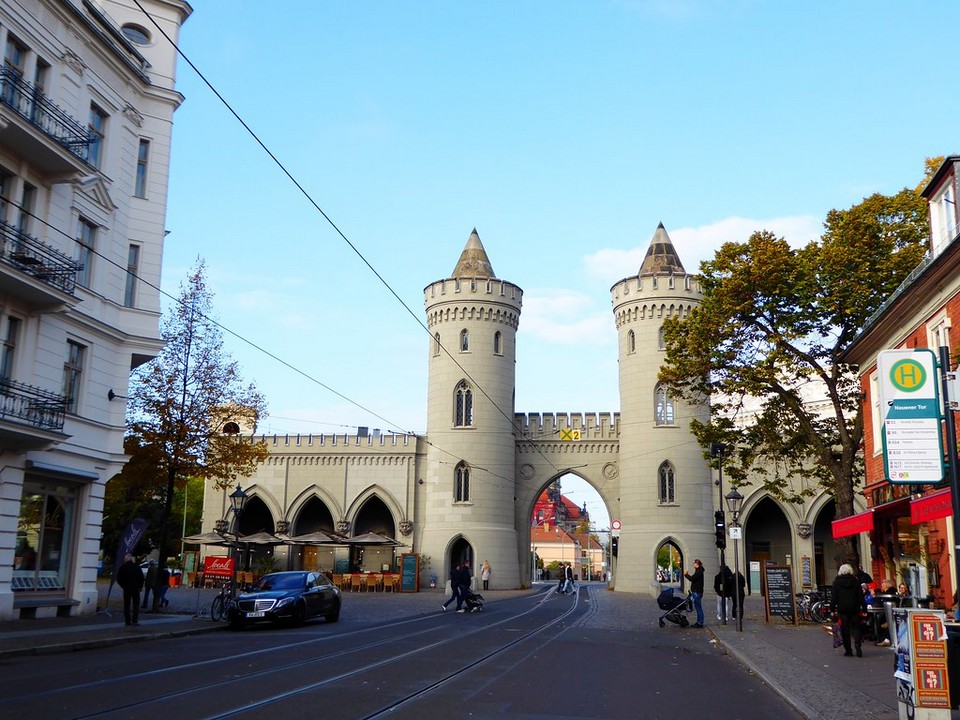
The Babelsberg district is Potsdam’s largest neighborhood, famous in the early days of cinema as the home of the UFA film company. Originally developed around Nowawes, an old quarter of spinners and weavers, the district’s heritage can still be discovered near the church of Weberplatz, a modest building built in 1753. Other highlights of this interesting area include Babelsberg Park, the third largest in Potsdam, established in 1832 and expanded from 1843 and Schloss Babelsberg, an Anglo-Gothic palace built in built in 1834.

Dutch Quarter (Holländisches Viertel)
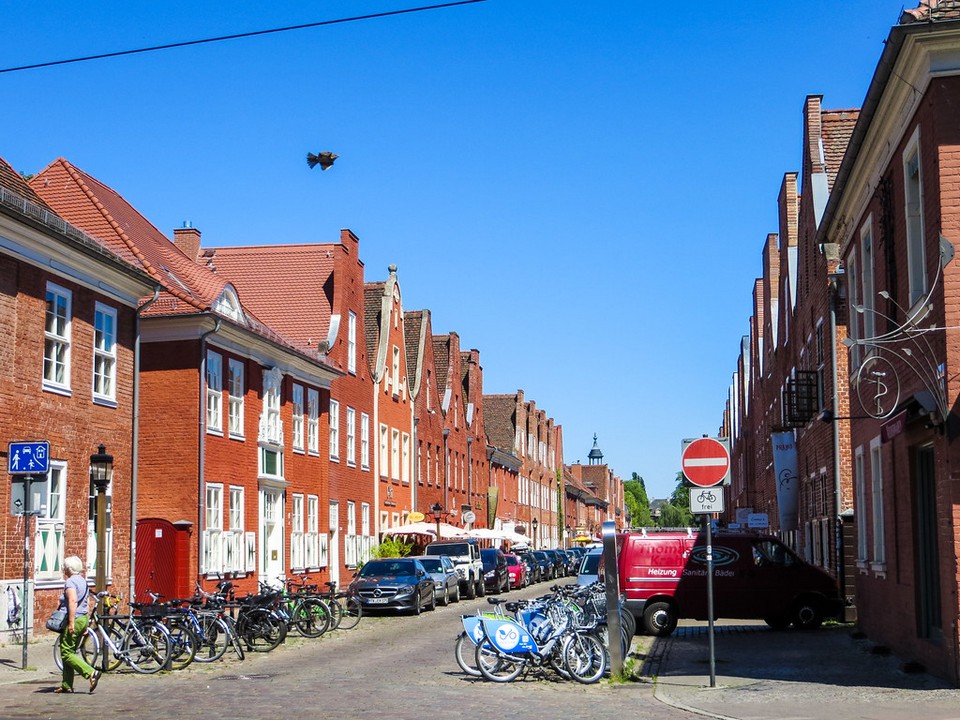
Holländisches Viertel is home to the largest Dutch community abroad. The neighborhood was built between 1737 and 1742 by Dutch craftsmen, headed by Johann Boumann. The neighborhood is housed in 4 blocks, including 134 houses built with typical Dutch red brick and shuttered windows, gables, white borders.
Holländisches Viertel is popular with both locals and tourists for its small shops, cafes and typical Dutch restaurants. In the neighborhood there is also a small house that is used as a museum about Johann Boumann and Dutch culture. Strolling here, easily leads to the Brandenburger Strasse pedestrian area with houses built between 1733-1939 for the mobilization of the army.
New Garden (Neuer Garten)
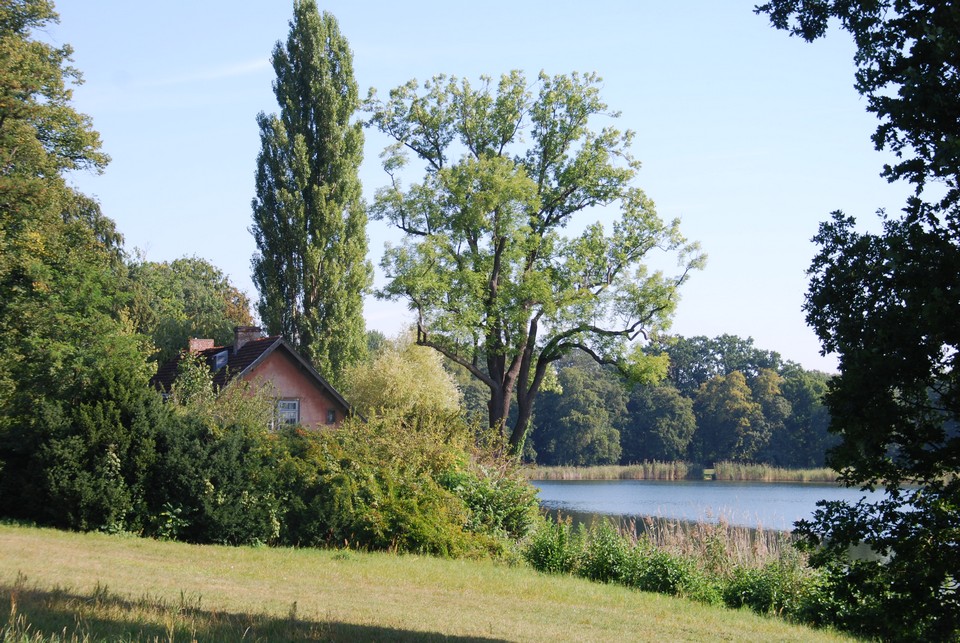
The New Garden is located on the banks of the Heiliger See (Holy Lake) and covers an area of 253 acres. The stunning landscape is in the poetic style of the late 18th century and established in 1789, it is meant to reflect the style of an English countryside.
Address: Am Neuen Garten, 14467 Potsdam, Germany Hours: 8AM–8PM
St. Nicholas’ Church
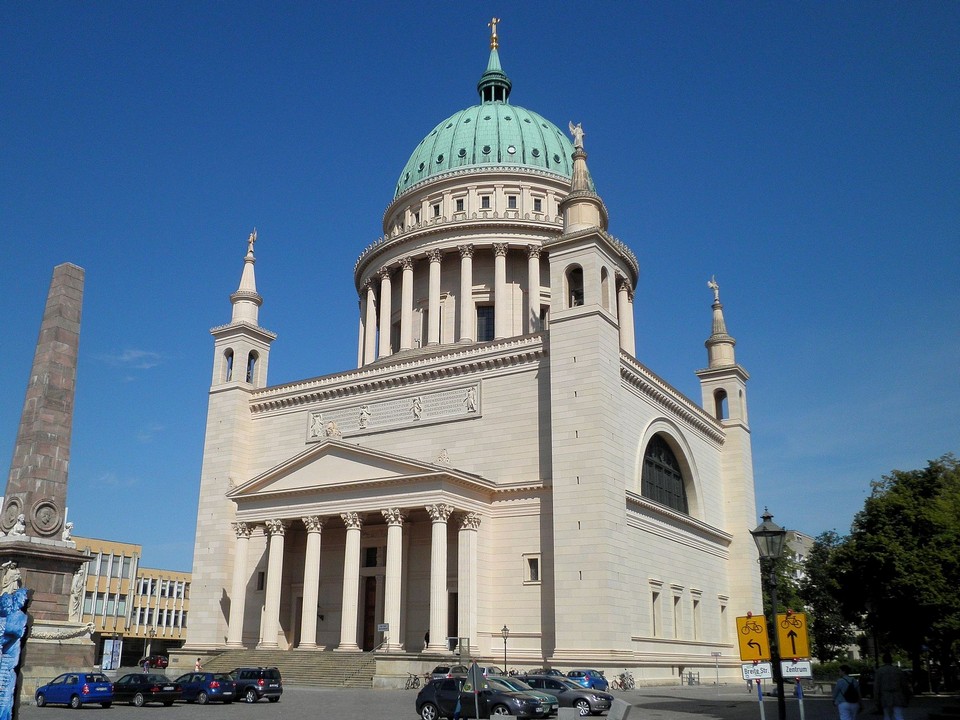
St. Nicholas’ Church is the most majestic church in Potsdam is a neoclassical style built between 1830-1837. The most striking feature of this impressive structure is the 77-meter-high domed main hall. In front of the church is a memorial built in 1753.
The church was heavily destroyed during the Second World War, and then rebuilt in 1981. Today, in addition to its religious function, the church is also open to visitors and hosts concerts.
Address: Am Alten Markt, 14467 Potsdam, Germany Hours: 9:30AM–6:30PM
Filmmuseum Potsdam
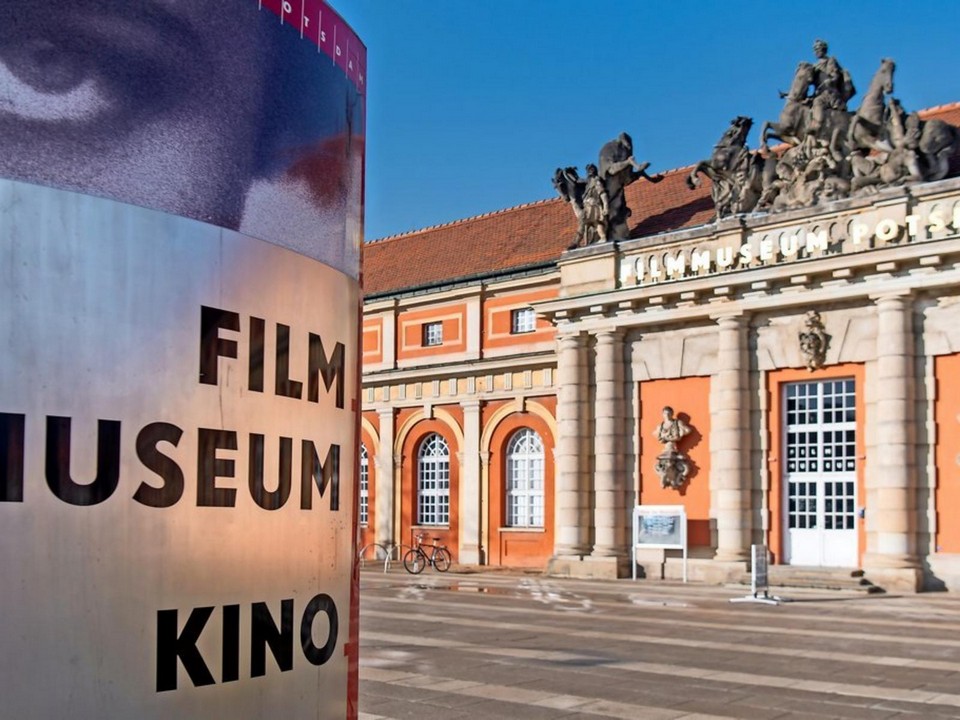
This is Germany’s oldest film museum. Formerly, the museum used to be a Prussian royal horse farm, the building was built with the typical 17th century baroque architectural style. The museum is an interesting destination for visitors who love the Seventh Art, with a collection of the history of world cinema in general and German cinema in particular from the end of the 19th century to the present, in terms of techniques, ideas and originals of famous movies. The museum also displays images of the oldest film studio Babelsberg in German history.
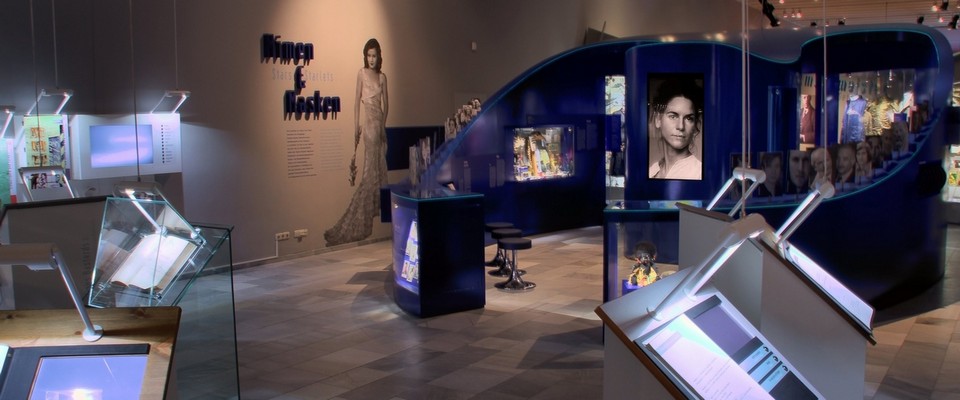
Address: Breite Str. 1A, 14467 Potsdam, Germany Hours: 10AM–6PM/Monday: Closed Opened: 1977
Russische Kolonie Alexandrowka

During the nineteenth century a number of Russian soldiers were part of a choir serving the entertainment needs of the Prussians living in the city. In 1826, Frederick William II ordered the construction of a new neighborhood for these people. It is because of this that “the Russian city” was named Alexandrowka.
In total twelve picturesque wooden houses were built here, you will visit the Russian Orthodox small church, now this place is added another building, Kirche Alexander-Newski
If you don’t have too much time, focus on the main places like:
- Sanssouci complex including palace, flower garden and New palace
- Dutch Quarter
- Downtown Luisenpatz
- Palace of Cecilienhof
You can refer to Klook’s half day tour for €17 . The tour departs from Berlin and does not include entrance tickets or tickets from Berlin to Potsdam. A single ticket costs €3.4 if you do not have a Berlin Zone ABC card.
Potsdam blog: What to eat?
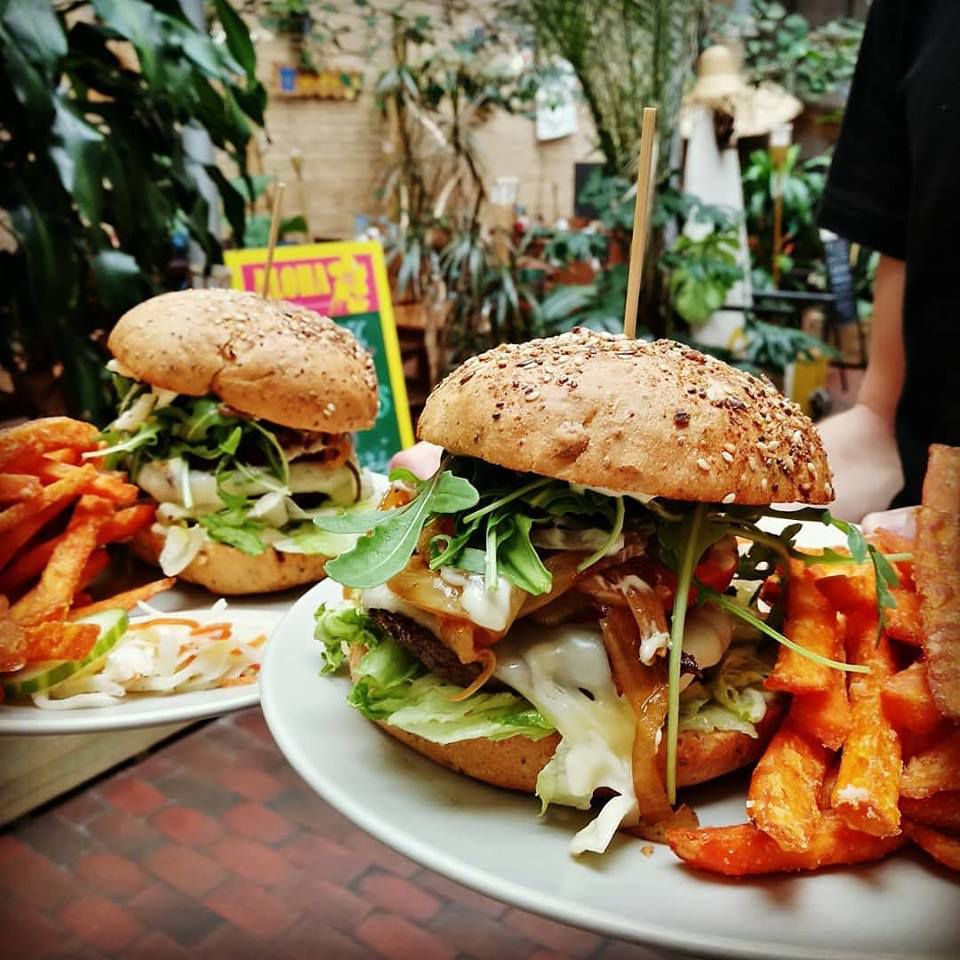
On the day I went, I ate at a Vietnamese restaurant in the shopping mall right next the station. In general, this area is quite large and has a variety of food stalls, restaurant, you can come here to try. If I remember correctly, there are 3 or 4 Vietnamese shops here. The price is also on par with Berlin about €7/meal.
Potsdam guide: Where to stay?
Below we recommend more best budget, mid-range and upscale hotels with good ratings and reviews you can refer to.
- NH Potsdam ( Agoda.com or Booking.com )
- Dorint Sanssouci Berlin/Potsdam ( Agoda.com or Booking.com )
- Seminaris Avendi Hotel Potsdam ( Agoda.com or Booking.com )
- Hotel Brandenburger Tor Potsdam ( Agoda.com or Booking.com )
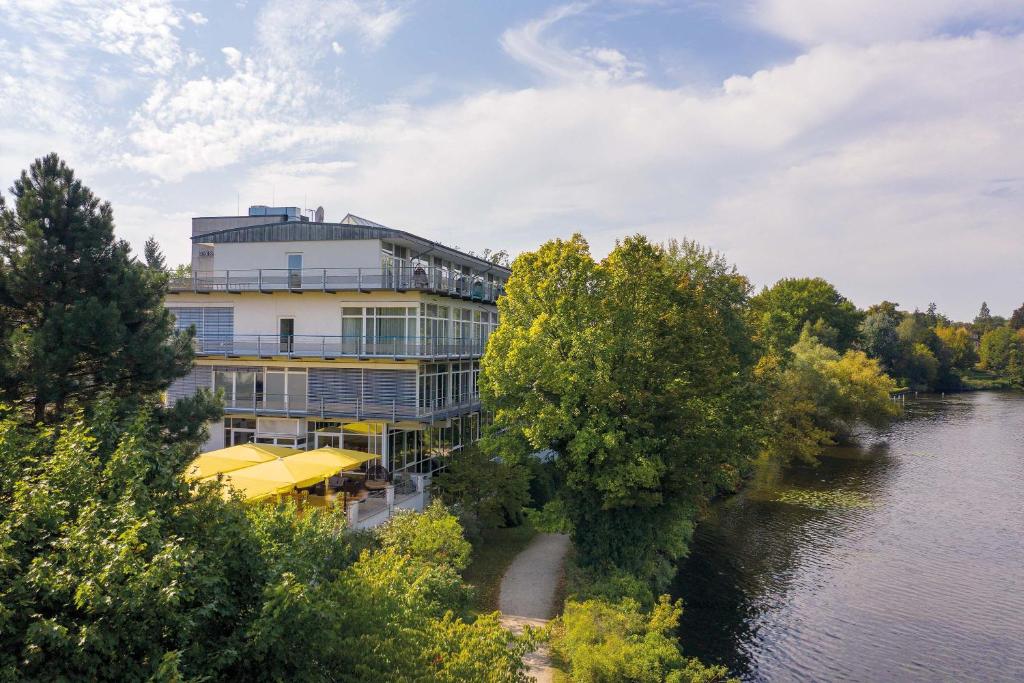
Check-out more top hotels in Potsdam via Agoda or Booking .
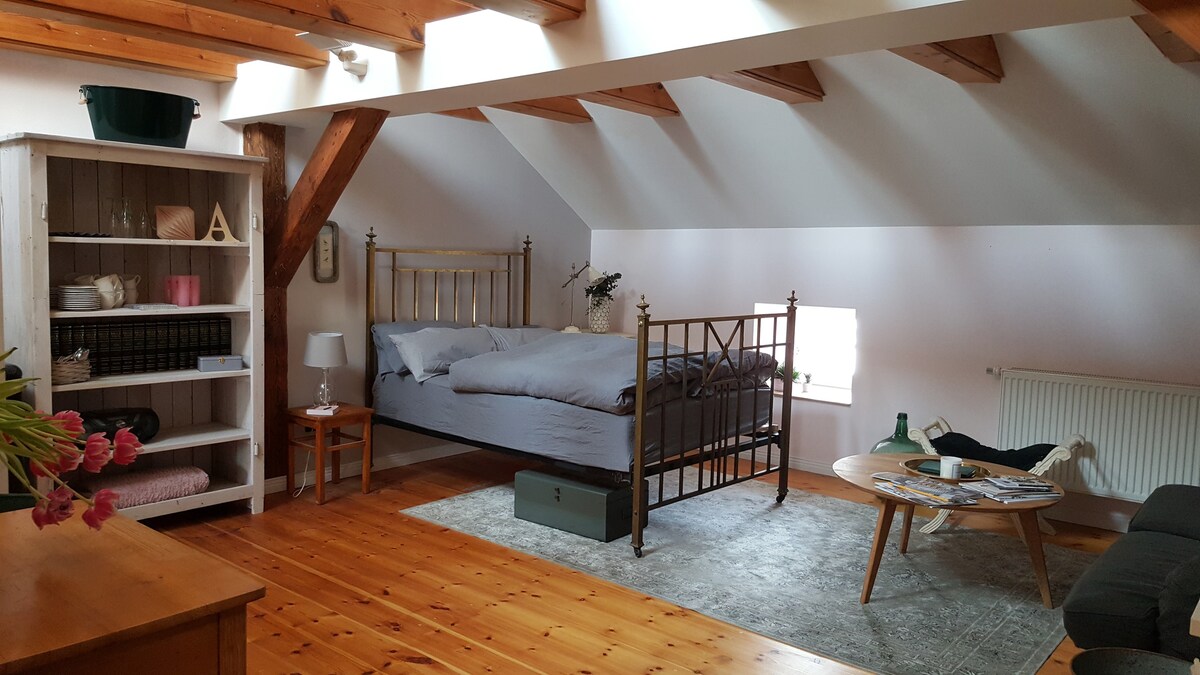
In general, I find Potsdam quite beautiful. The atmosphere is peaceful and not too hustle and bustle like in Berlin. It feels very enjoyable to have a leisurely, gentle day walking around the city after a few days in the crowded capital :). If you are still wondering where to go when traveling to Berlin, then do more research on this place.
Some best day tours, trips, activities and transfer services, tickets in, from and to Potsdam you can refer to
- Potsdam Half Day Tour from Berlin
- Potsdam Day Tour from Berlin
- Potsdam Hop-On Hop-off City Sightseeing Bus Tour
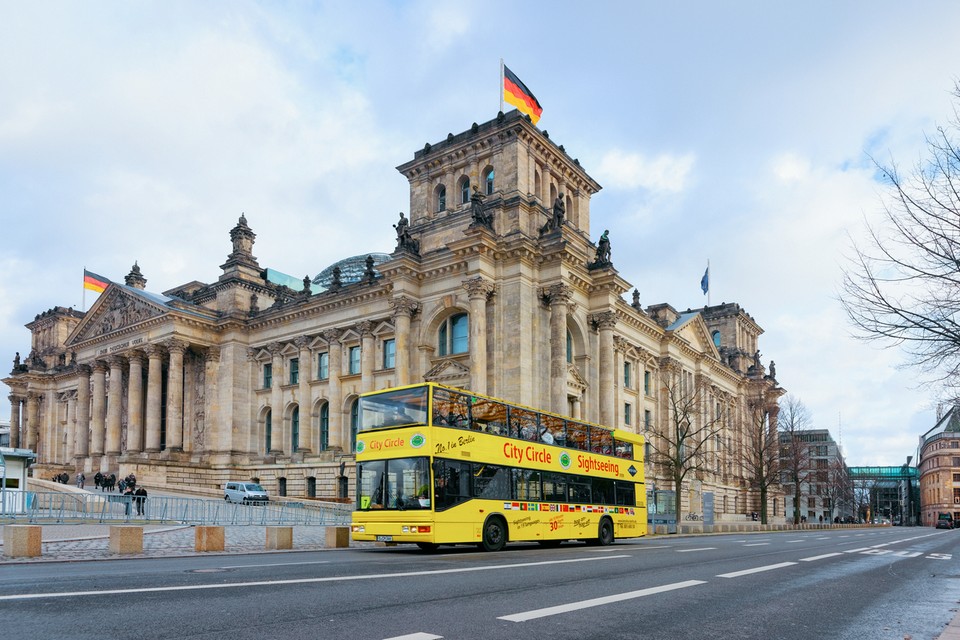
See more Berlin travel guide here and Germany guide here .
Related articles

RELATED ARTICLES MORE FROM AUTHOR
Suggested tokyo travel itinerary 3 days. how to spend 3 days in tokyo on a budget, where to go in hsinchu 14 famous attractions, best places to visit in hsinchu.
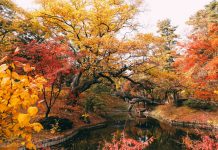
21+ best places to visit Korea in autumn
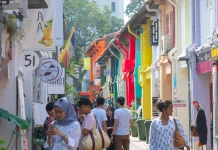
Suggested Singapore Malaysia itinerary 6 days to visit Singapore & Kuala Lumpur
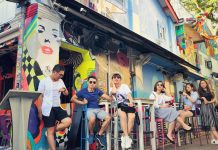
Singapore Malaysia itinerary 5 days — What to do & suggested 5 days 4 nights Singapore Malaysia itinerary
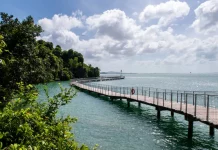
Pulau Ubin travel guide. The ultimate guide to the green island of Singapore
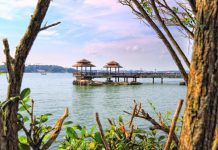
Pulau Ubin blog — The guide to Pulau Ubin & suggested perfect Pulau Ubin one day trip
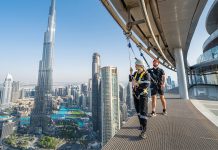
18+ top things to do in Dubai
Editor picks.

Suggested Tokyo travel itinerary 3 days. How to spend 3 days...

POPULAR POSTS

What to buy in USA? — 17+ must buy in USA...

What to buy in Korea? — Top +23 cheap, famous &...

Must buy souvenir in Taiwan — Top 17+ most famous, cheap...
Popular category.
- Inspiration + Guide 1522
- Trip Inspiration 468
- Food + Drink 223
- Thailand 216
- Coasts + Islands 199
- South Korea 179
- Vietnam 172
- Travel Photos 144
- Work for Us
- Terms & Conditions
- Privacy Policy
Turn your dream vacation into reality

One Day in Potsdam Itinerary (Day Trip from Berlin)
- Milena Yordanova
- August 22, 2024
A complete 1-day itinerary for a Potsdam day trip (+ a map with all key sights, how to skip the lines at Sanssouci Palace and how to get to Potsdam from Berlin).
Situated on the River Havel, Potsdam is only a 30-minute train ride from Berlin. This makes it an ideal day trip from Germany’s capital city. Potsdam is famous for its royal palaces and gardens. The city also hosted the Potsdam Conference, where the Allied leaders met to decide the post-World War II order.
Potsdam was the residence of the Prussian kings and German emperors until 1918. It all started in 1660 when the Great Elector Frederick William of Brandenburg chose the city as his hunting residence. Later under Frederick II (Frederick the Great), Potsdam became the capital of the Kingdom of Prussia . Today Potsdam is a vibrant city, packed with history, culture, stunning palaces, and architecture.
Best 1-day Potsdam day trip itinerary
This one-day itinerary for Potsdam is perfect for anyone planning a day trip from Berlin . In fact, it’s the exact route I followed on my last visit. I planned the itinerary in such a way that you can see most of the city with minimal walking. However, note that Sanssouci Park is huge, so this itinerary still involves a fair amount of walking.

One-day trip to Potsdam from Berlin
- Visit the Neues Palais, a Baroque masterpiece
- Explore Sanssouci Park
- Tour the stunning Sanssouci Palace
Lunch at Theaterklause Potsdam
- See the Brandenburg Gate
- Explore the Dutch quarter
You can easily make this day trip on your own or choose a guided tour . If you prefer not to deal with all the logistics or have limited time, I recommend the Sanssouci Palace Guided Tour from Berlin . It covers all the city’s main attractions, with admission to Sanssouci Palace included.
Tips on your 1-day Potsdam itinerary
Don’t stay overnight – Potsdam is just a 30-minute train ride away from Berlin. Even if you can’t see everything you want in one day, you can easily come back the following day. You’ll spend less time travelling compared to changing hotels.
Still, if you want to stay overnight, I’d recommend Hotel Villa Monte Vino . It’s a charming boutique hotel housed in a historic 19th-century tower villa, less than a 5-minute walk from Sanssouci Palace.
Map – find here a map of this Potsdam day trip itinerary (with all attractions and restaurants’ websites).
Potsdam Day Trip Itinerary
There aren’t many cafés along the route to the palace. That’s why I recommend having an early breakfast in Berlin before heading to Potsdam. Additionally, it’s best to arrive as early as possible since you need to book a timed entry for your visit, even if you purchase tickets online in advance.
The New Palace
10:00 AM – 11:00 AM
Most tourists begin their visit to Potsdam with the famous Sanssouci Palace, but I’d recommend starting with the New Palace instead. Arrive at Bahnhof Potsdam Park Sanssouci station (instead of Potsdam Hauptbahnhof), which is closer to the New Palace. This way, you can start with the New Palace and make your way through the gardens to Sanssouci Palace and the city centre .
New Palace (Neues Palais) is one of the most impressive Prussian Baroque palaces in Germany . It was built between 1763 and 1769 under the reign of King Frederick II of Prussia (Frederick the Great). Unlike other palaces built as royal residences, the New Palace was designed to demonstrate the strength and wealth of Prussia. Indeed, it mainly served as a guesthouse for visiting dignitaries and hosted grand state occasions.
With over 200 rooms , the New Palace stands as one of Germany’s largest palaces. Among its most spectacular rooms are the Marble Hall, the Grotto Hall (decorated with shells and semi-precious stones) and the Upper Gallery .
Right across the palace, you’ll find the Communs. This is where the royal kitchens and servants’ rooms were.
To visit the palace, you must purchase a timed entry ticket, which you cannot buy online (unlike Sanssouci). In fact, you can buy a ticket online, but selecting a time slot is only possible in person at the ticket office. This is why I recommend visiting the New Palace before Sanssouci . Additionally, note that the ticket office is approximately 300 meters from the palace entrance. Therefore, head directly to the palace after purchasing your tickets to avoid missing your designated time slot.

I’ve visited many European palaces, but the New Palace was one of the most stunning I’ve ever seen! That’s why I’d recommend skipping Sanssouci and visiting the New Palace (Neues Palais) if you only have time for one palace. While Sanssouci Palace is more popular, it pales in comparison to the grandeur of the New Palace in my opinion.
If you plan to visit both Sanssouci and New Palaces, buy the Sanssouci+ pass . It grants you free entry to all palaces in Potsdam for one day . Plus, the price of the Sanssouci+ pass is cheaper than buying individual tickets. Keep in mind, that even if you buy in advance the Sanssouci+ pass, you still need to visit the ticket office at the New Palace to reserve a time slot for your visit. Make sure to do this promptly upon arriving at the palace grounds.

Sanssouci Park
11:00 AM – 11:50 AM
Explore the beautiful Sanssouci Park on your way to Sanssouci Palace. With more than 70km (about 43 miles) of walkways, it is the largest park in Brandenburg . So make sure to wear comfortable shoes for your visit.
Besides Sanssouci Palace and the New Palace, Sanssouci Park is home to several smaller palaces and buildings . The most impressive in my opinion are the Orangery Palace, the Chinese House and the New Chambers. You can visit them for free with the Sanssouci+ pass.
The Orangery Palace is a gorgeous building in the Italian Renaissance style . It was built after the image of the Villa Medici in Rome and the Uffizi in Florence.
The Chinese House is a small garden pavilion , built by Frederick the Great to adorn his flower and vegetable garden.
The New Chambers is an extension of Sanssouci Palace . Initially, they served as an orangery to keep the terraces’ potted plants safe during the cold winter months. Later, the chambers were transformed into a gallery.

The Sanssouci+ pass also grants access to Charlottenhof Palace, Belvedere on Klausberg, and the Roman Baths . Realistically, it’s not possible to visit all these attractions in just one day, so prioritize based on your interests and available time.
Sanssouci Palace
11:50 AM – 12:30 PM
Sanssouci Palace is one of the most renowned palaces in Germany. It is famous for its Rococo architecture and beautiful terraced gardens . The palace was constructed between 1745 –1747, during the reign of King Frederick the Great. It served as his summer residence , where he could escape from the pomp and ceremony of the Berlin court life. The palace’s name, Sanssouci, reflects this – it means “without a care” in French.
Booking in advance is recommended (tickets are timed-entry and often sold out) Entry ticket : Skip-the-line Sanssouci Palace

As I already mentioned earlier, this ticket grants you entry to all palaces in Potsdam. So, be sure to make the most of it! Also note, that Sanssouci Palace is closed on Mondays, while the New Palace – on Tuesdays .
Despite its modest size, I found the Sanssouci Palace charming and its lavishly decorated rooms truly impressed me.

12:45 PM – 01:45 PM
For lunch, make your way to Theaterklause Potsdam . This charming restaurant and wine bar features a fantastic lunch menu that changes daily .
Brandenburg Gate
02:00 PM – 02:10 PM
Situated in the heart of the city centre, the Brandenburg Gate is one of Potsdam’s iconic landmarks . The gate was originally a part of the city walls of Potsdam and served as one of the main entrances to the city. In 1770, it underwent a complete reconstruction under Frederick the Great. The gate was transformed into a triumphal arch to commemorate Prussia’s triumph in the Seven Years’ War .
An interesting fact is that despite being less famous than its Berlin counterpart, the Brandenburg Gate in Potsdam is older than the one in Berlin .

The Dutch Quarter
02:30 PM – 03:00 PM
Potsdam has a unique Dutch Quarter (Holländisches Viertel). It was built between 1733 and 1742 under the rule of King Frederick William I of Prussia. Its aim was to attract skilled artisans from the Netherlands to settle in Potsdam. The quarter consists of four blocks with a total of 134 red-brick houses in Dutch style.
Today, the Dutch Quarter is famous for its picturesque streets , small boutiques, cafes and restaurants. It’s one of the city’s most charming quarters in my opinion.
While you’re in the area, be sure to visit Café Guam . They offer fantastic cheesecakes , and there are always numerous flavours to choose from. It’s a perfect place to unwind and relax after a day of exploring.

More ideas for one day in Potsdam
Take a palace tour by boat.
Experience the beauty of Potsdam and its palaces with the Palace Tour by Boat . Glide along the Havel River, passing the grand palaces and parks of the Hohenzollern Dynasty. Admire the beautiful Babelsberg Palace, Pfaueninsel Palace, and the historic Glienicke Bridge.
Cecilienhof Palace and the Potsdam Conference
Built between 1914 and 1917, the Cecilienhof Palace was the last palace constructed of the House of Hohenzollern. It serves as the residence for Crown Prince Wilhelm and his wife, Duchess Cecilie of Mecklenburg-Schwerin . The palace was designed in the style of an English Tudor manor , featuring half-timbered walls and brick chimneys.
Cecilienhof Palace is most famous for hosting the Potsdam Conference in 1945. The leaders of the Allied powers (Truman, Churchill and Stalin) met here to discuss the future of Europe and shape the post-war world order.
You can tour the historic rooms, including the room where the Potsdam Conference took place. The Sanssouci+ pass gives you free entry to the palace .
St. Nicholas’ Church
Built between 1830 to 1837, St. Nicholas’ Church (Nikolaikirche) is the largest and most important church in Potsdam . Standing at a height of 78 meters (256 feet), its dome dominates the historic Old Market Square. The four corners of the building are crowned with towers, each topped with an angel.
You can visit the church to admire its stunning dome and climb one of the towers . After 223 steps, you’ll reach a 42-meter (138-foot) high platform, offering a 360-degree view of the city .
If you visit between 11:15 AM and noon, you might be lucky enough to hear the impressive organ being played. There are also regular concerts almost every Sunday at 6 PM ( check the concert program here ).

Church of Peace
Located within the grounds of Sanssouci Park, the Church of Peace (Friedenskirche) is an ideal stop on your way to the historical centre. It served as a private chapel for the royal family during the 19th century . Friedenskirche was commissioned by King Frederick William IV and built between 1845 and 1848.
The church’s design is inspired by Italian Romanesque architecture, particularly the Basilica di San Clemente in Rome. Make sure to check out the apse, decorated with an original 13th-century Venetian mosaic .

Babelsberg Palace
Babelsberg Palace is a stunning example of 19th-century Gothic Revival architecture . Built in 1835 it served as a summer residence for Prince William (later Emperor William I) and his wife, Princess Augusta. The palace features a beautiful English garden with lovely river views .
Although Babelsberg Palace is not open to visitors, you can access its gardens free of charge.
What to see next
Continue your journey to Berlin, the capital city of Germany. For more details, check out my 3-day Berlin itinerary . It includes all the key sights, tips for avoiding long lines, and my favourite German restaurants.
Must buy tickets in advance
Sanssouci Palace – it’s the most popular sight in Potsdam and the tickets are timed entry. Even if you’re travelling outside the season, book in advance your skip-the-line Sanssouci Palace here .
Getting around in Potsdam
Since the attractions are spread out, be ready for a lot of walking, especially in Sanssouci Park. Remember to wear comfortable shoes!
You can also opt for the hop-on hop-off bus tour . It takes you to all points of interest, including the New Palace, Sanssouci, Cecilienhof and Glienicker Brücke (Bridge of Spies).
How to get to Potsdam from Berlin
Organized tour
To visit Potsdam as a part of a guided tour, take this Sanssouci Palace Tour from Berlin (it’s the most popular one). The tour includes a bus transfer directly from the Berlin city centre, a guided tour of Potsdam and a tour of Sanssouci Palace.
Potsdam is an easy day trip from Berlin , just a 30-minute ride on the S-Bahn. To get there, hop on the S7 S-Bahn train or the RE1 and RB23 trains. The S7 train stops at Potsdam Central Station (Potsdam Hbf), while the RE1 train stops at Park Sanssouci Station (Park Sanssouci Bhf).
To follow my Potsdam itinerary, take the RE1 or RB23 train to Potsdam in the morning, and return to Berlin on the S7 train. This way, you can start your day at the New Palace, explore the park, and finish in the historic city centre.
Potsdam is located in zone C, so the regular Berlin zone AB ticket is not enough. You’ll need to buy an ABC ticket. If you plan to use public transport in Potsdam or Berlin, consider buying a Tageskarte Berlin ABC (day ABC ticket) to save money.
Best time to visit Potsdam
A day trip to Potsdam involves a lot of walking, and one of the main attractions is Sanssouci Park, which is best enjoyed in nice weather. Therefore, the ideal time to visit Potsdam is from May to October. Additionally, many of the smaller palaces in the park close during the winter months (see all opening hours of the palaces here ).
During my first visit on a cold December day, I couldn’t reach the New Palace due to heavy snow, and the terraced gardens of Sanssouci Palace were not particularly appealing in winter.
Also, keep in mind that Sanssouci Palace is closed on Mondays, and the New Palace is closed on Tuesdays. So, I’d recommend visiting Potsdam from Wednesday to Sunday.
Faqs about visiting Potsdam
No, Potsdam is not in Berlin. It is a separate city located just southwest of Berlin, about a 30-minute ride on the S-Bahn. Potsdam is the capital of the state of Brandenburg, while Berlin is a separate city-state.
To get to Potsdam from Berlin, take the S7 S-Bahn train or the RE1 and RB23 regional trains. The S7 train stops at Potsdam Central Station (Potsdam Hbf), while the RE1 and RB23 trains also stop at Park Sanssouci Station (Park Sanssouci Bhf).
Potsdam is approximately 30 kilometres (about 19 miles) southwest of Berlin. The journey by train typically takes around 30-40 minutes.
Potsdam is famous for its historic palaces and gardens, particularly Sanssouci Palace, which was Frederick the Great’s summer residence. The city is also known for its beautiful parks, such as the Sanssouci Park, and the historic Glienicke Bridge, which was a notable Cold War crossing point.
Yes, Potsdam is definitely worth visiting for its stunning palaces and gardens, particularly Sanssouci Palace and its park. Situated just 30 minutes away by train, Potsdam is an ideal day trip from Berlin.
One day in Potsdam is enough to see the main highlights, such as Sanssouci Palace, Neues Palais and the historic city centre. In fact, Potsdam is a perfect choice for a day trip from Berlin.
Pin for later

Follow now for exclusive content
About the author
Now it’s the 24th of November and we just visited the Neue Palace. The tour was nice, however short. But it was long enough to get a nice glimps. We followed your instructions to walk through the park towards the city center. Very nice. Then went along the Branderburger Tor and the main street towards the Dutch houses. There we had a nice lunch at Poffertjes en Pannenkoeken. Typical Dutch delights. Mittelstrasse 32, Potsdam.
I’m glad you enjoyed Potsdam, Mariëlle. 🙂
Thank you Milena so much ! for the information. I will follow your itinerary on our upcoming trip. but we would like to deviate and go to Schloss Cecilienhof after the tour at Sanssouci Palace, then after that probably head back to Berlin. How would you suggest we get around to Schloss Cecilienhof after Sanssouci ?
You can take bus 603 from the Rathaus (1.6km walk from the palace) and get off at Schloss Cecilienhof bus station (or tram 91 or 94 from Luisenplatz-Süd/Park Sanssouci to Platz der Einheit/West and then change to bus 603 again). Unfortunately, there is no direct line which connects both sights.
Greetings. Thanks for all the precious information. Getting to the New Palace first from the Park Sanssouci train station is perfect. FYI, in the website the park opens at 09:00, but the Palaces open at 10:00. Between the New and Sanssouci, there is a 20-30 minutes walk, so plan adequately. About 45 minutes to visit each Palace. Walk to town is 15 minutes. Loved the old town and small boutique and shop. Thanks again.
Thank you for your comment and the helpful info! 🙂
Good morning. What is best way to get to the “Bridge of Spies” ? Also if time is limited and you had to choose between walking around Potsdam city center or Sansouci which would you suggest? Thank you
I’d recommend visiting Sansouci, as it’s really beautiful palace with a lot of history. The easiest way to get to the Bridge of Spies (Glienicker Brücke) is by taking tram 93 (15min journey) from Potsdam Hauptbahnhof (the central train station). It will take you directly to the bridge.
I’d recommend visiting Sansouci first, as you need a timed-entry ticket booked in advance, then Glienicker Brücke. However to get from Sansouci to Glienicker Brücke you have two options: either take two trams (or buses), or walk for about 30 minutes to the city centre and then catch tram 93 from Alter Markt/Landtag.
Leave a Reply Cancel Reply
Your email address will not be published. Required fields are marked *
Name *
Email *
Add Comment *
I accept the privacy policy
Post Comment
Chelsea Dinen
The Ultimate Guide to a Charming Day Trip to Potsdam, Germany
I stepped off the train, the crisp Autumn air brushing past my face. As I made my way down the tree-lined path, I looked up at the golden leaves stretched out far above me, noticing the peaceful hush in Potsdam. The birds were singing their morning song while the occasional bicyclist whirred past me. And then, peeking out from behind the last tree, I saw the corner of a large rose-colored facade. There it was; the Neues Palace.
If you’re looking for a day trip from Berlin, Germany that is charming and filled with history and beautiful palace grounds, you will want to plan a trip to Potsdam, Germany. Situated just 20-30 minutes from Berlin by train, you can easily spend an entire day (or more!) exploring vast gardens and royal palaces. By the way, you can find all of my Berlin-related posts here.
Even on a cold, blustery late October day, I spent hours upon hours wandering the UNESCO World Heritage Site. If you follow me on Instagram @ChelseaDinen , then you know how much I love days spent touring palaces, castles, and other buildings of historical significance. With 2064 hectares (approx. 5100 acres) of parks and 150 buildings constructed between 1730 and 1916, UNESCO inscribed the “Palaces and Parks of Potsdam and Berlin” in the World Heritage List in 1990 after the fall of the Berlin Wall.
Many of the parks had been disfigured beyond recognition due to the 3.60 meter (approx. 12 ft) high wall, watchtowers, and “Death Strip” that tore through them. The UNESCO commendation along with German reunification made it possible to reconstruct the cultural landscape.
Before we get into all the details about what to see while you’re in Potsdam, let’s first discuss how exactly to get there.
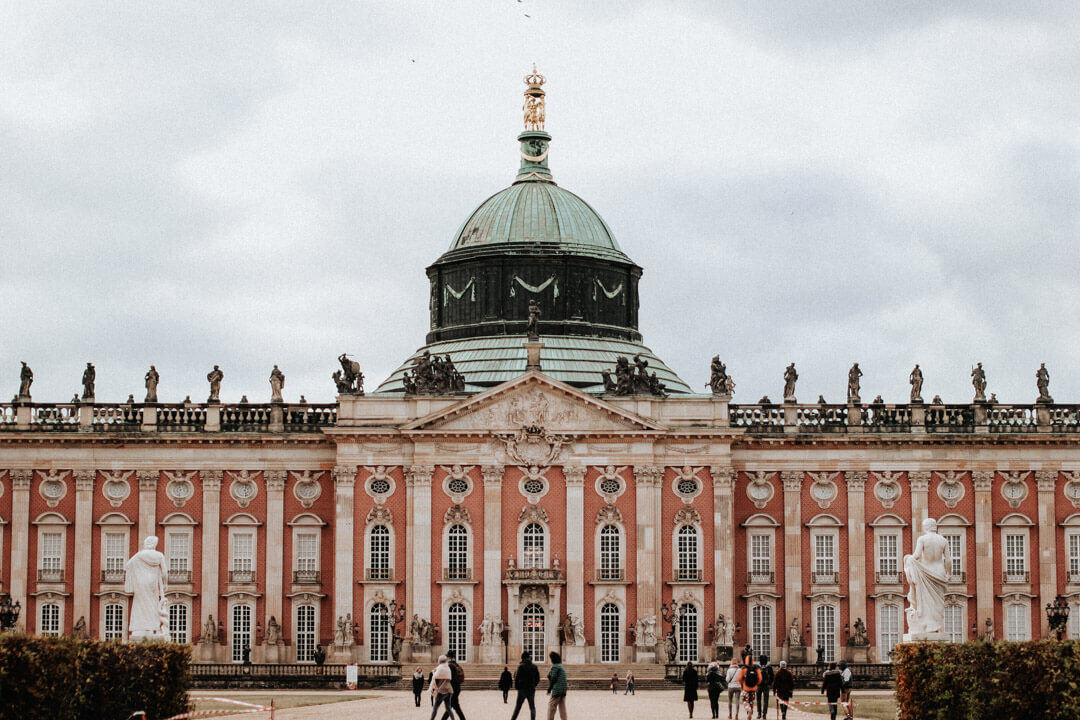
Getting to Potsdam
From Berlin Central Station, you can take either the RE1 towards Magdeburg or hop on the S-Bahn and take the S7 towards Potsdam.
You need ABC tickets, as Potsdam is in Zone C. I would recommend buying a day ticket for Berlin ABC (EUR 7,70) as this ticket will also cover the trams and buses in Potsdam as well. You can buy these tickets on the platform from the ticket machines or electronically through the BVG app. Also, if you buy a paper ticket, be sure to validate it in the little red machine on the platform, otherwise you could be fined.
I prefer taking the regional RE1 train into Potsdam because it’s much more convenient if you’d like to start at the Neues Palace , which is what I did. Simply take the RE1 train past Bhf Potsdam and get off at Bhf Park Sanssouci . The Neues Palace is an enjoyable 8-10 minute walk from there.
If you want to go to the Sanssouci Palace first, take either the S7 or RE1 to Bhf Potsdam and take the bus from there to Schloss Sanssouci . I’ve been told this approach is entirely underwhelming as the bus drops you off at the back of the Sanssouci Palace. So, if you want to approach the palace from the front (as it was designed) get off at Potsdam and, instead, take the bus to Luisenplatz-Süd/Park Sanssouci.
Again, I really recommend starting at the Neues Palace and walking through all of the beautiful gardens/Park Sanssouci and ending at Sanssouci Palace. I found the Neues Palace to be far more impressive (and less crowded) than the Sanssouci Palace. But let’s just keep that our little secret ;)
What to Do in Potsdam
Depending on the time of year you visit, be sure to check which attractions will be open. Most palaces/castles are closed on Mondays, with the exception of the Neues Palace (which is currently closed on Tuesdays instead). You can find more information here.
The only tickets that may be purchased online are the combined Sanssouci+ Tickets (see below). All other tickets may be purchased at the palace information centers in Potsdam.
Sanssouci+ Ticket: 19,00 €. This is worth it if you’re planning to visit more than one palace. When purchasing online tickets (plus 2 euros service charge), a fixed admission time for Sanssouci Palace will be booked as well. For the details on which palaces are included, check here. You can also buy these tickets in-person but the allotment of tickets is limited, so you might want to buy in advance during the peak summer months.
Regular Day Ticket: 8,00 €.
Photo Permit: 3,00 € for one day for all palaces. No flash/tripod.
Visit the Neues (New) Palace
Built between 1763 and 1769 under Frederick the Great, King of Prussia, this is considered to be the last great Prussian Baroque palace. Though it was not a principal residence for the King, it was used to host guests and royals. After the death of King Frederick, the palace fell into disuse until 1859 when it became the summer residence of the German Crown Prince, Frederick William, later German Emperor Frederick III. (Lot of Fredericks to keep up with!) Then, Wilhelm II, the last German Emperor and King of Prussia lived there with Empress Augusta until his abdication and the end of the German monarchy in 1918.
It became a museum until the Second World War when it was looted by members of the Soviet Army. Look for the room with the red letters painted on the wall by Soviet soldiers! Because it escaped bombing in the war, the palace today looks much as it did in 1918.
I had the 10:35am slot and as you can see from the photos, I had the palace entirely to myself so I definitely suggest going early! I found the audio tour, which is included in the price of the ticket, to be a disappointment so take your time reading the supplementary signs in each room for more information.
What to look for:
The Grotto Hall. This is the most breathtaking room I have ever seen. Over 20,000 shells, stones, marble, quartz and semi-precious stones decorate the walls.

The Marble Gallery, just to the right of the Grotto Hall is the finest example of Rococo decoration within the palace. Similar to the famous Hall of Mirrors at Versailles, the Marble Gallery, windows are set opposite of a wall of mirrors which reflect light throughout the room.
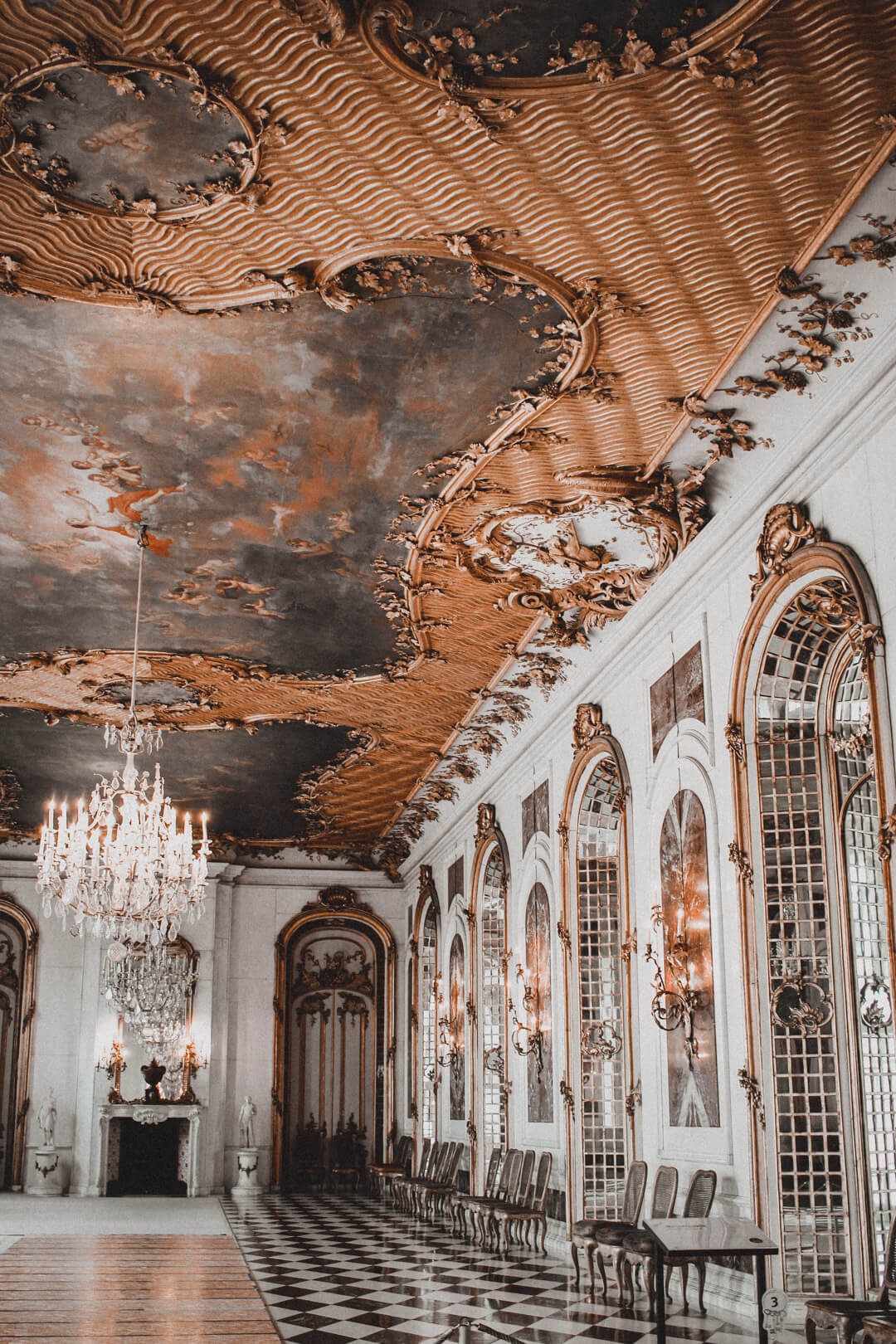
The Marble Hall. Not to be confused with the Marble Gallery, this elaborately-detailed hall spans two stories in height. It is massive and absolutely beautiful. The painting on the ceiling measures 240 square meters, making it the largest canvas ceiling painting north of the Alps .
The Hall was actually closed in 2008 due to the risk of the 90-ton room collapsing and falling into the Grotto Hall directly below. The Marble Hall was restored and opened again to the public in 2016.
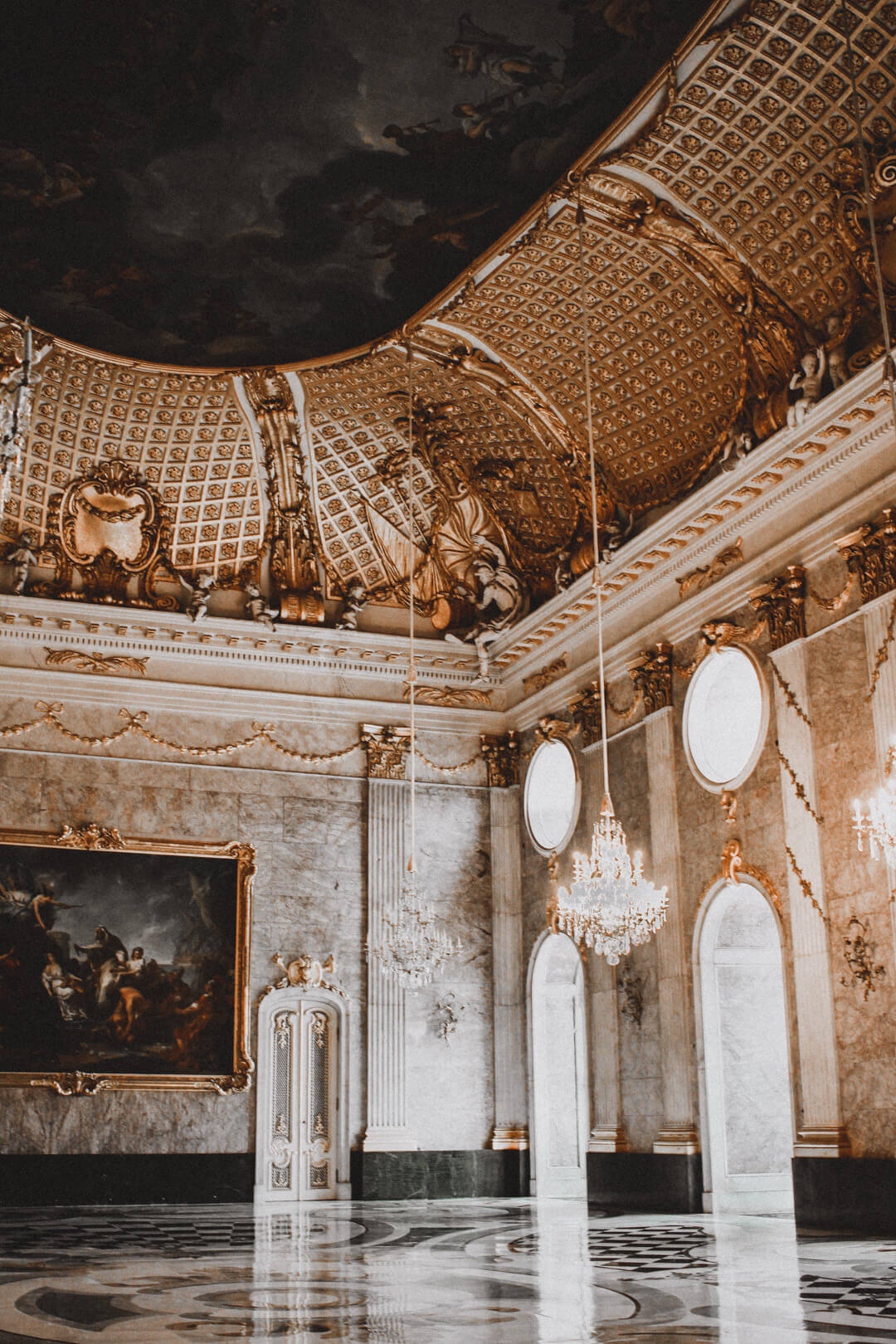
See the Communs
Directly across from the west side of the New Palace, you’ll find the Communs which once housed the royal kitchens, utilities, gardeners’ shops, palace guards, and servants. A beautiful, curved colonnade stretches between the two buildings. Walk through the colonnade and pretend you’re a royal. If only for a moment.
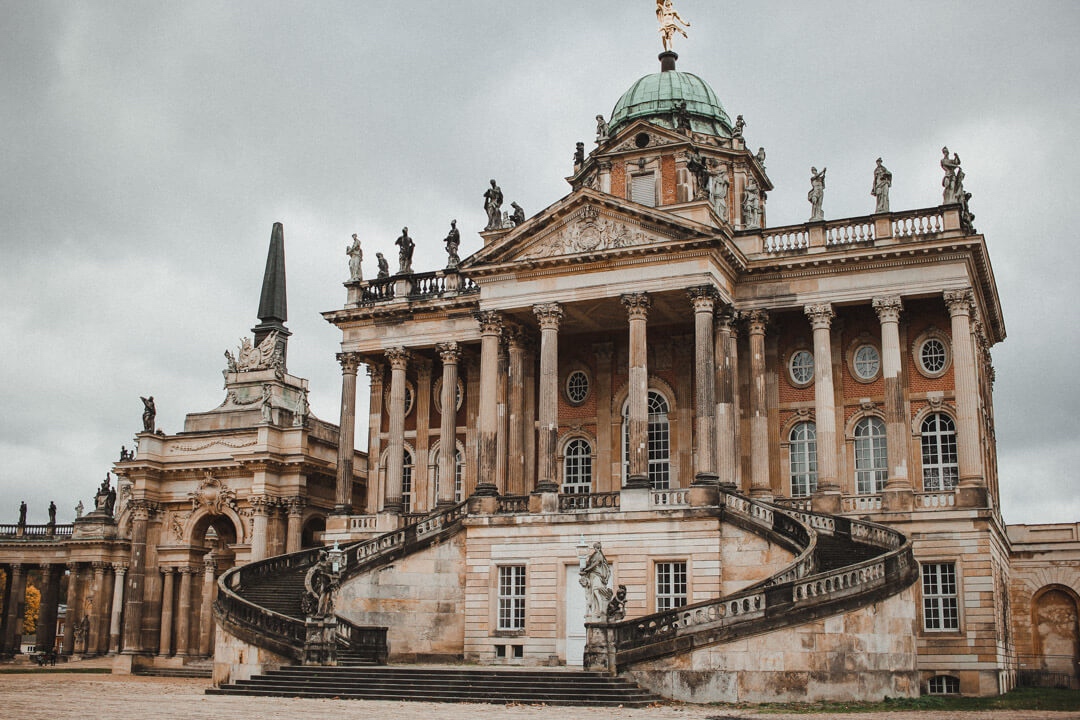
Park Sanssouci
I stopped into the information center to warm up and grab a little snack. The wind had really started to pick up and I knew I still had a few hours left of outdoor exploring to do. About twenty minutes later, I walked around to the other side of the New Palace and began my lovely Autumnal walk through Park Sanssouci.
If you look at a map, you’ll see that there are a couple paths cutting straight across from the New Palace to the Sanssouci Palace. It’s a gorgeous path that cuts through lush trees (perfect in the Autumn!), various gardens, and grassy areas. There are many buildings and smaller palaces to explore. You could easily spend days here to see it all!
Instead of looking at the map, I just leisurely wandered along the pathway and was pleasantly surprised by what I stumbled upon. The Orangery, the historical Dutch mill, and so many interesting sculptures. Aside from the New Palace, this was my favorite part of my visit to Potsdam. Simply wandering through the gardens.

Sanssouci Palace
Frederick the Great had his Sanssouci summer palace constructed in 1745 –1747. A personal sanctuary for him to relax, it is the most popular palace with beautiful gardens leading up to the front. I did not take a tour of this palace so I cannot give any feedback on that but I recommend walking the sprawling steps up to the front of the palace and taking in the wonderful view of Potsdam.
If you like castles and palaces, don’t miss my guide to Copenhagen!
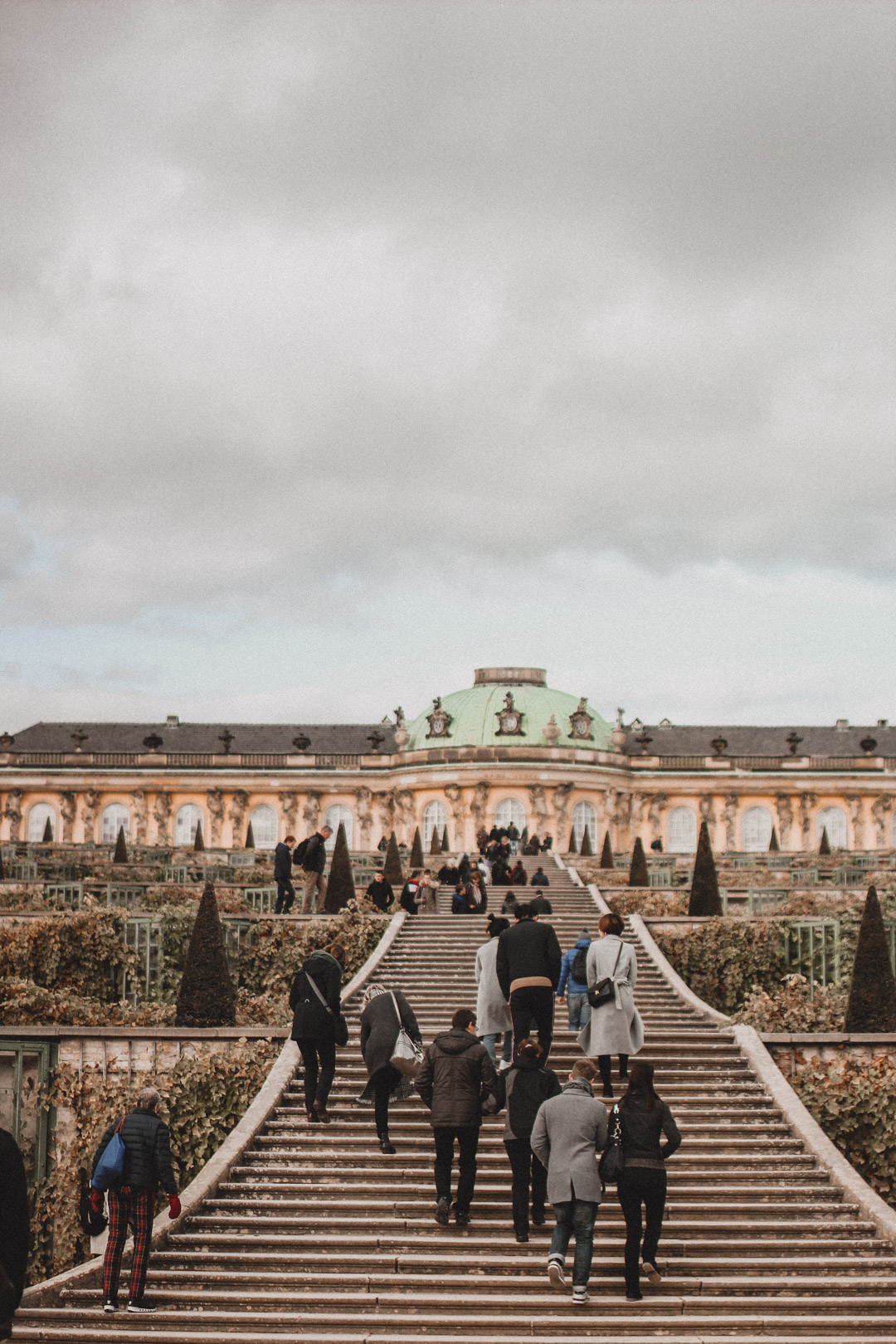
Alexandrowka, The Russian Colony
Frederick William III and the Russian Czar Alexander were close friends and so he had this small colony built for him. I walked here from the Sanssouci Palace which took me through the most charming German neighborhood. It’s about a 25-minute walk or you can take the bus. There’s a traditional Russian restaurant within the colony, several houses, and a museum.
If you are limited on time, I’d say maybe skip this. Though it’s very unique, the area is quite small and I found it to be slightly underwhelming.

Brandenburger Tor/Heart of Potsdam
Right in the heart of Potsdam, you’ll find all sorts of European charm. I saved this for last and it was a memorable way to end a day trip to the city. As the sun began to set, it cast a warm glow on the Brandenburger Tor/Brandenburg Gate. Not to be confused with the Brandenburg Gate in Berlin, this gate stands as a triumphal arch after the Seven Years’ War was won in 1770.
Just behind the Brandenburg Gate, you’ll find Brandenburger Straße, Potsdam’s pedestrian-only area that offers lots of shopping and dining options. The Baroque houses that line this street date back to the 18th Century.
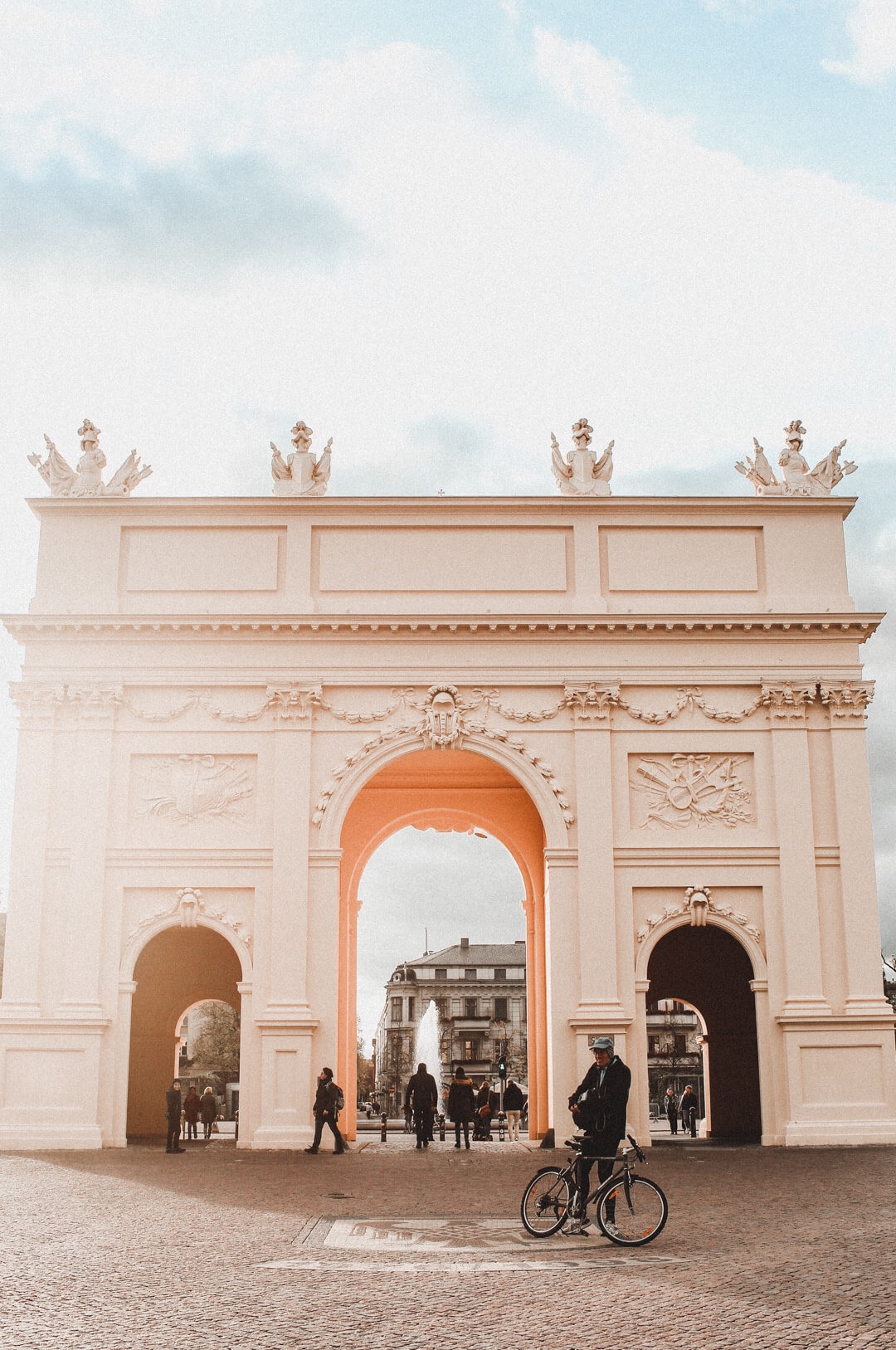
The Dutch Quarter
Built from 1733 to 1740, the Dutch Quarter is a neighborhood that consists of 134 red Dutch brick buildings. I didn’t get a chance to visit while I was in Potsdam recently but it’s definitely on my list for next time.
Accommodation
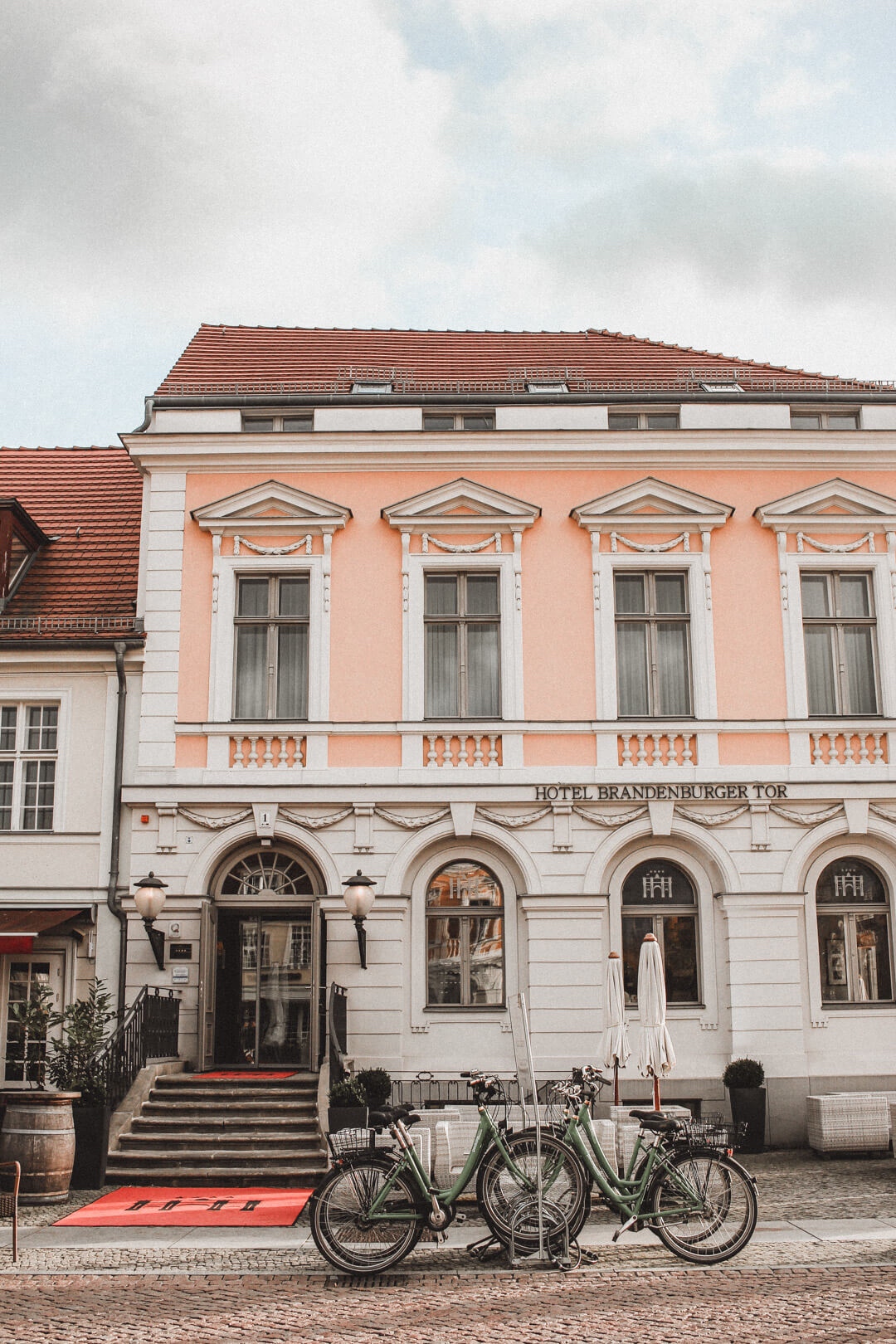
Book a room at the gorgeous Hotel Brandenburger Tor (pictured above) which is right in the historic center of Potsdam. The Hotel Am Jägertor is another favorite Potsdam hotel.
Since I just took a short day trip from Berlin to Potsdam, I returned home that evening using the bus to Hbf Potsdam and took the S7 from there all the way to Berlin. If you’re planning to stay in Potsdam, I recommend using Booking.com for the best deals on hotels!
As you can see if you’ve made it all the way through, I fell in love with Potsdam and all of its historical charm. If you’re a culture lover like I am, you could easily spend days there exploring everything. A popular destination in the summer months, I found Autumn to be especially beautiful.
If you’ll be in Berlin and are interested in some of my favorite places for a beautiful walk, read this post on The Most Picturesque Walks in Berlin.
You can find my other Berlin guides here.
Pin it for later
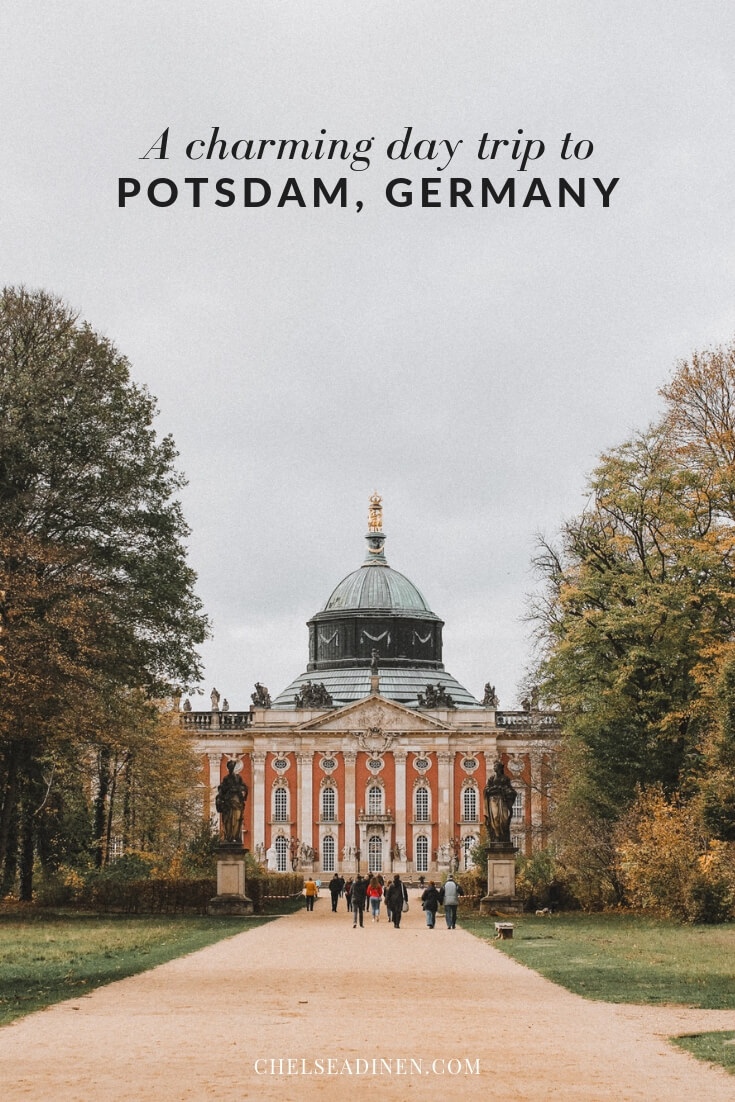
Similar Posts
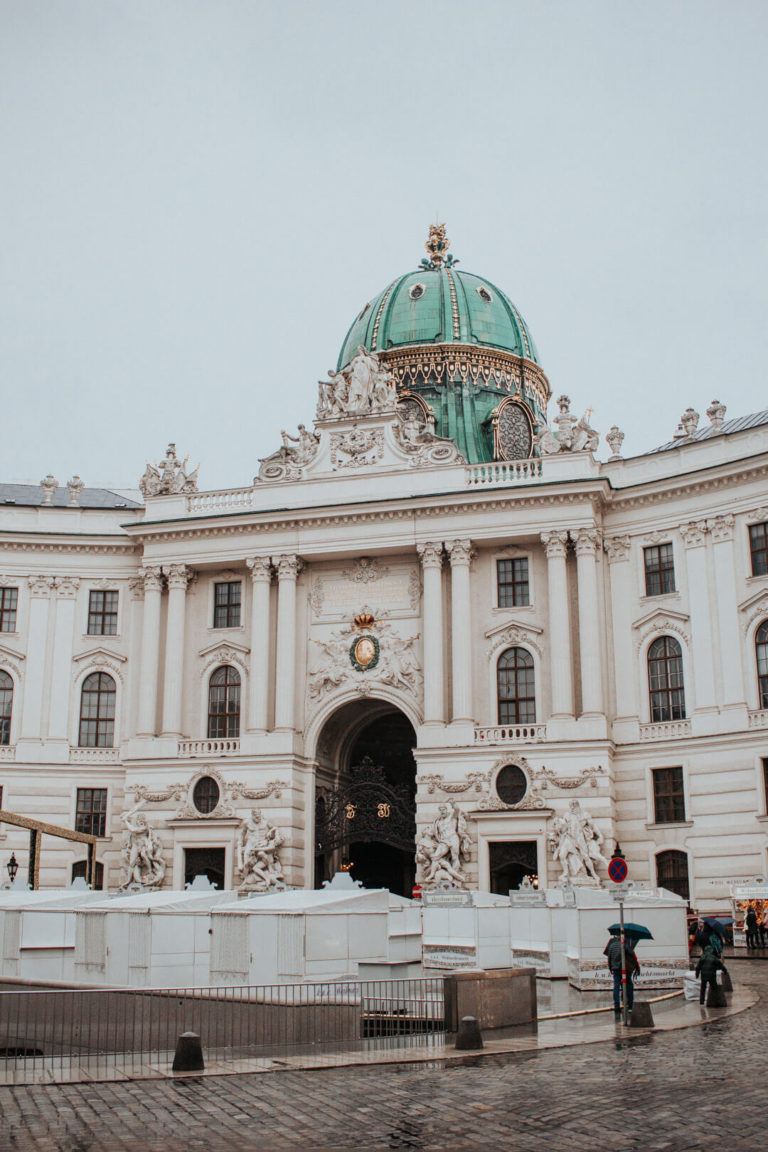
How to Spend 24 Hours in Vienna

The Single Girl’s Guide to Amtrak
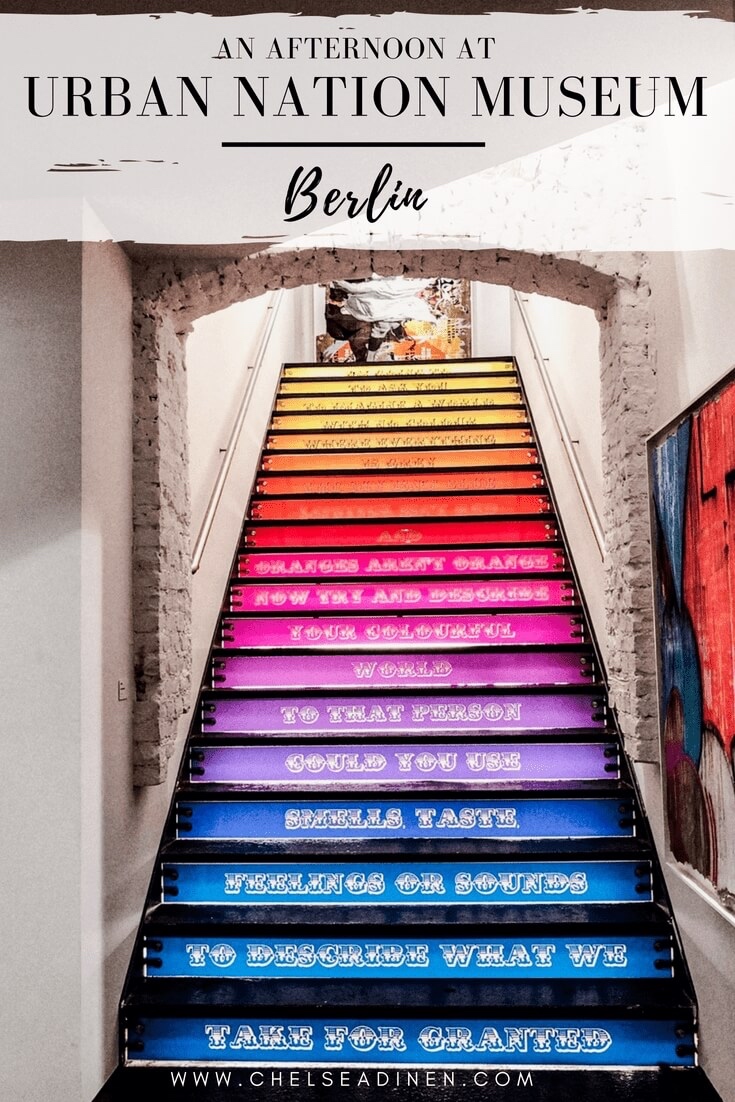
An Afternoon at Berlin’s Urban Nation Museum

Flying with Your Cat | Pet Travel Tips
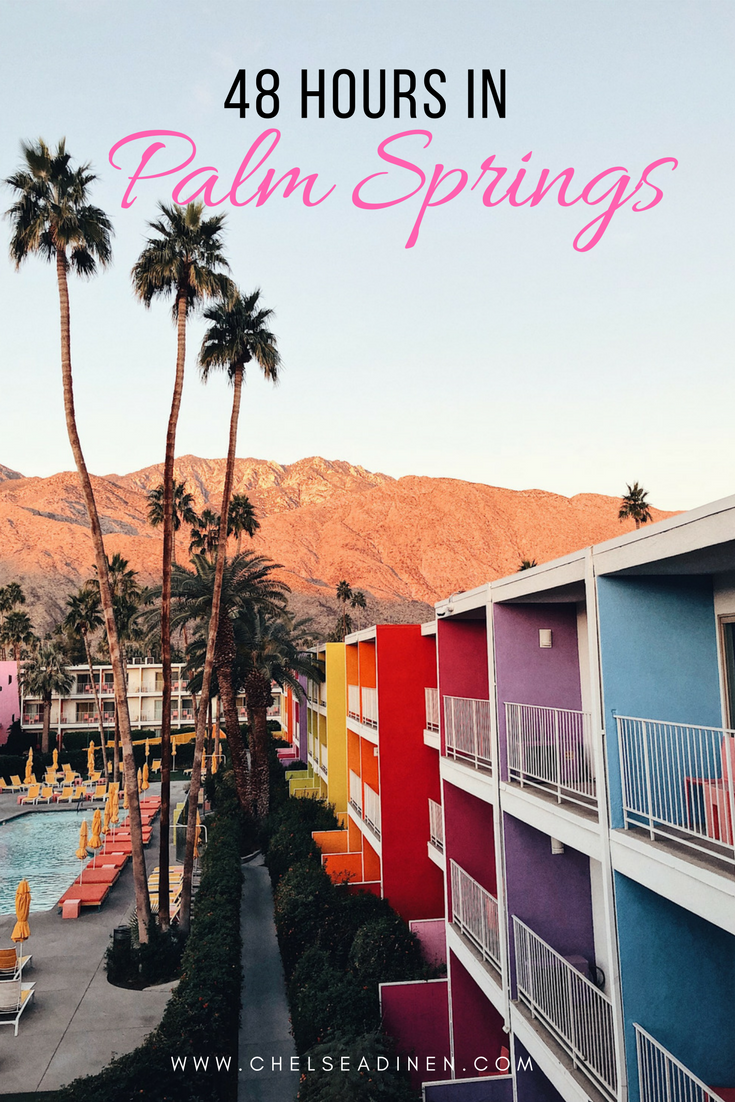
48 Hours in Palm Springs | What to See, Do, and Eat
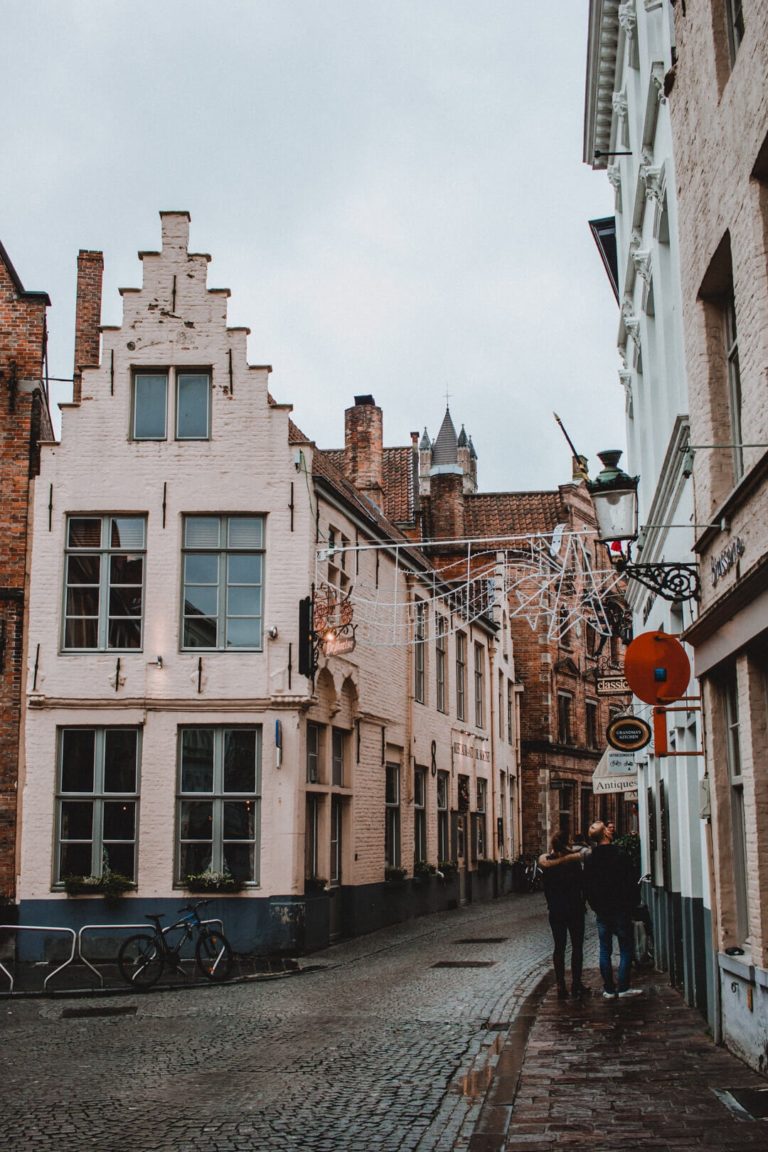
What to Do in Bruges, Belgium
24 Best Things To Do in Potsdam Germany: Day Trips from Berlin

- Written by Post author: Chloe Smulian
- Post last modified: Updated on April 2, 2024
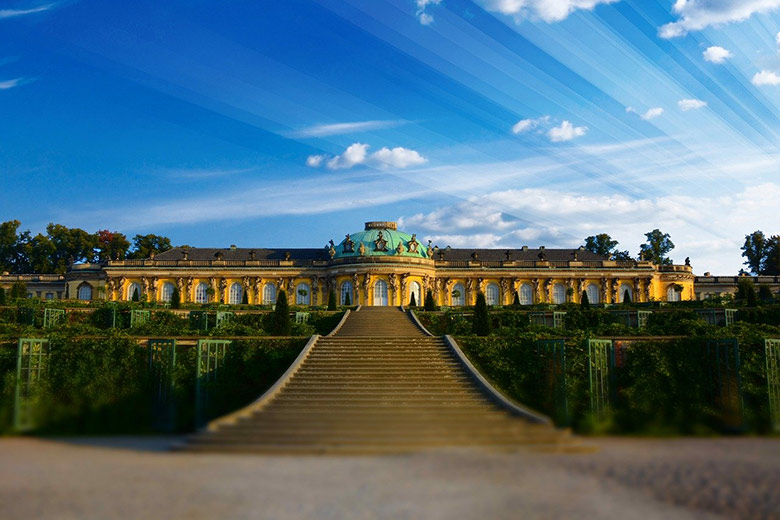
Experience one of the best day trips from Berlin, Germany with this Things To Do in Potsdam Ultimate Guide.
Visit the largest World Heritage Site in Germany and explore the beautiful city of Potsdam. Travel back in time and catch a glimpse of how the Prussian and German Royalty once lived here.
The charming city of Potsdam is only a short 45 – 50 minute train ride from the capital of Germany and is one of the best day trips to experience from Berlin. So make sure you add this to your Berlin itinerary!
Discover the best things to do in Potsdam (along with some interesting historical facts) on this self guided tour. Most of these Potsdam attractions are free things to do too!
If you already know how to get from Berlin to Potsdam by train, skip straight to the Things To Do In Potsdam – Self Guided Tour .
Where Is Potsdam, Germany
The beautiful city of Potsdam lies along the banks of the Havel River, a short 35km distance from the city centre of Berlin, Germany.
The city captures more than 200 years of history and culture dating back from the Prussian Empire. It’s also famous for the role it played during World War II and the Cold War that followed.
Today, it is the capital and largest city of Brandenburg and world renowned for being home to the largest UNESCO World Heritage Site in Germany.
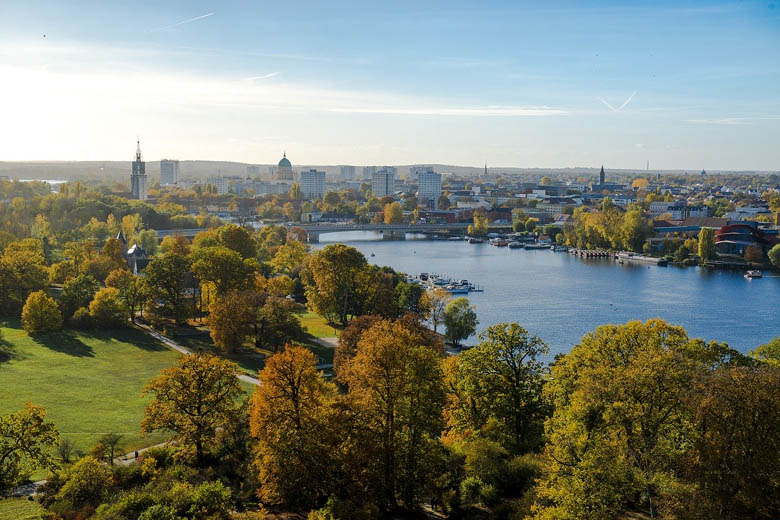
Was Potsdam in East or West Germany
If you’ve read our Berlin Wall By Bike Tour , you’re probably wondering whether Potsdam was part of East or West Germany. Well, the answer may surprise you.
Although Potsdam lies on the western border of Berlin, which was technically West Berlin during the time of the Berlin Wall, the city was actually part of East Germany and therefore a part of the GDR (German Democratic Republic).
Is Potsdam Worth Visiting
If you love visiting fairytale cities in Europe like Prague , that are rich in history and opulent architecture, then Potsdam is definitely worth visiting. It’s referred to as ‘The Versailles of Germany’ and is also considered to be one of the most beautiful royal cities in Europe.
Potsdam is most famous for being the summer home of the Prussian Royalty during the 19th century. So if you love wandering down intricately crafted gardens and admiring extravagant palaces, then you’ll love Potsdam.
In addition to the iconic Sanssouci Palace, there’s 16 other grand palaces in Potsdam alone to see and explore! We’ll take you to see 5 of these palaces on this day trip from Berlin.
Besides palaces and gardens, the city of Potsdam also played a significant role during World War II and the Cold War.
And if all that is not enough to charm you. Then how about the fact that you can visit the largest UNESCO World Heritage Site in Germany for free!? Yes, you can meander through the fairytale gardens of Sanssouci Park for free too. You only need an entrance ticket if you want to go inside the museums and palaces.
With the heritage site covering around 500 hectares and 150 buildings, there’s plenty of free things to do in Potsdam on your day trip from Berlin.
Day Trips From Berlin
Berlin to potsdam.
Potsdam is one of the best day trips from Berlin because there’s so much to do and see there, plus it’s an easy and short 45 – 50 minute train ride from Germany’s capital city.
To get from Berlin to Potsdam by train, buy the BVG ticket for A, B and C zones. You’ll need 2 single trip tickets (valid for 2 hours each) for a return trip from Berlin to Potsdam. The return train trip will cost you €7.20 in total.
If you already have the BVG transport ticket for A and B zones, simply buy an extension ticket for Zone C to take the train from Berlin to Potsdam. Extension tickets cost €1.70 each and are also valid for 2 hours. You’ll need 2 extension tickets for the return train trip from Berlin to Potsdam (i.e. total cost €3.40).
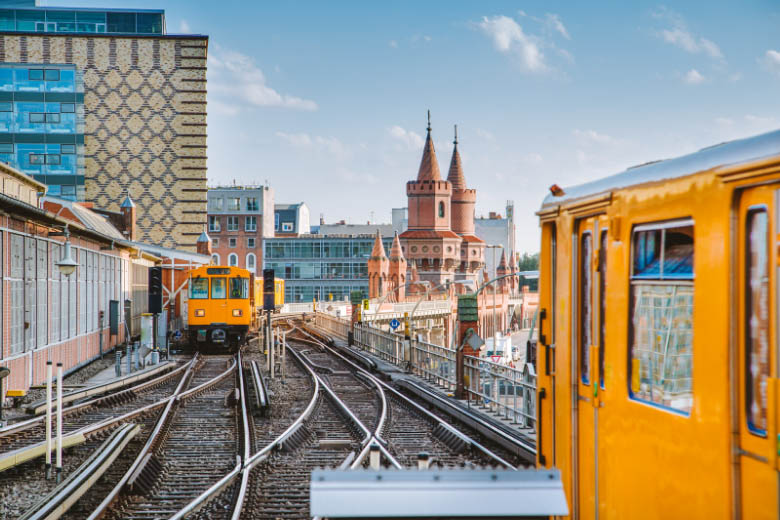
Taking Bikes On Board The Train
Bring your bikes with you if you plan to cover more ground in Potsdam. Just remember to buy train tickets for your bikes (or risk a €60 fine).
BVG Bike Single Trip tickets cost €2.60 each and are valid for 2 hours.
Getting Around in Potsdam, Germany
Once you’ve arrived in Potsdam, getting around is easy. Use some of the options below or simply walk. Make sure you wear comfortable walking shoes as this Potsdam self guided tour is more than 10km.
Public Transportation in Potsdam
Potsdam, Germany is part of Berlin’s zone C. So you can use your BVG train ticket to get around in Potsdam. This way you won’t need to walk as much.
If you prefer using public transportation in Potsdam, buy the BVG Berlin ABC Day Ticket instead. It costs €9.60 but is valid until 3AM the next day so you won’t need to pay for any other transportation costs for the day.
Potsdam Bike Rental
Another great way to experience the best day trip from Berlin in Potsdam, is by bike. You can easily rent one if you don’t already have a bicycle.
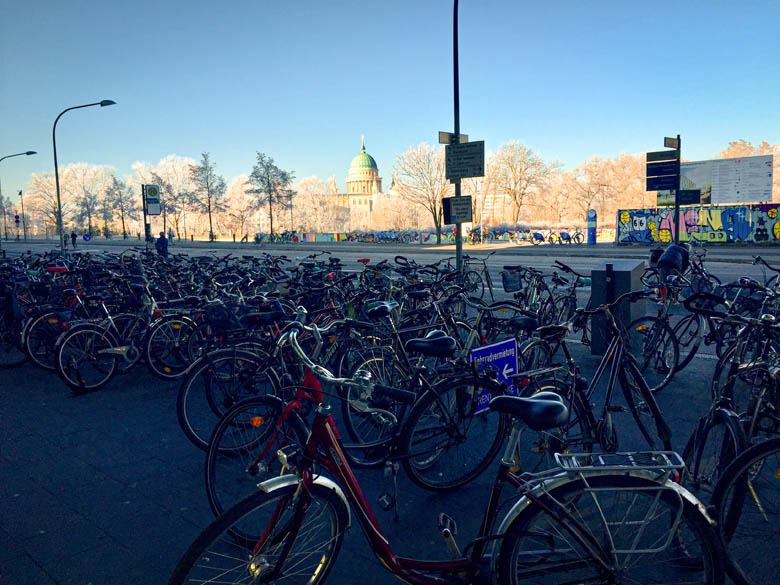
Easily rent a bike in Potsdam via bike sharing. Nextbike bicycles is available in Potsdam. It will cost a maximum of €12 to rent a Nextbike for a 24 hour period if you select the €3 day tariff option.
Simply download the Nextbike app and pick up a bike when you’ve arrived in Potsdam.
Read our Berlin Bike Sharing Guide if you’ve never used bike share before and curious to know which one gives you the best value for money.
Another great Potsdam bike rental option (especially if you have kids) is to rent bicycles from Cityrad Rebhan Fahrradverleih . The store is located close to the main train station in Potsdam. They rent bikes for €11 for adults and €8 for kids.
Make sure you’re familiar with bike road rules for cycling in Germany before hopping on that bike. You don’t want any unexpected traffic fines.
Potsdam Hop-On Hop-Off Bus
If you love exploring new cities from the iconic red Sightseeing Bus, you can combine this walking tour with the Potsdam Hop On Hop Off Bus .
Get live commentary as the bus drives past the main sights and attractions, and hop on and off at any of the 12 stops.
Another popular option is the Potsdam City and Castles Tour . It’s a 3 hour bus and walking tour to see the city of Potsdam and the castles that make the city so famous.
Potsdam Things To Do: Self Guided Tour
Well now that all the logistics is out of the way, let’s get straight to the best things to do in Potsdam and enjoy the ultimate day trip from Berlin!
Click on the interactive map below to easily find these Potsdam attractions from your location.
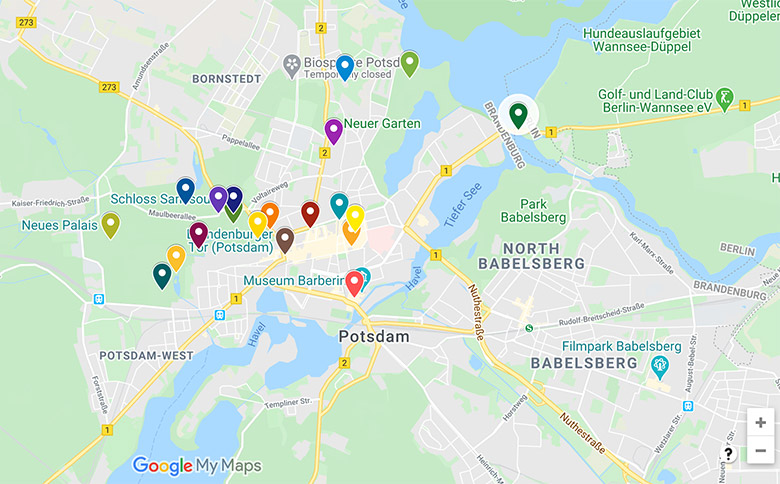
1. Town of Potsdam, Germany
Our first stop is to see the main town square in Potsdam, Germany. It’s a short 700m walk or cycle from the main train station. You’ll know you’ve arrived when your eyes can’t help but dart back and forth between one architectural masterpiece to another.
The town of Potsdam is filled with fascinating architecture. Most of which were built during the 18th and 19th centuries when the city was the residence of the Prussian Royalty.
The most outstanding landmark in the Old Town Square (or Alter Markt) of Potsdam, is St Nicholas’ Church.
St Nicholas’ Church (St. Nikolaikirche)
Does St Nicholas’ Church look eerily familiar? Well, that’s because its large dome was inspired by St Paul’s Cathedral in London.
Never seen St Paul’s Cathedral before? Visit this iconic landmark in London on a free virtual tour !
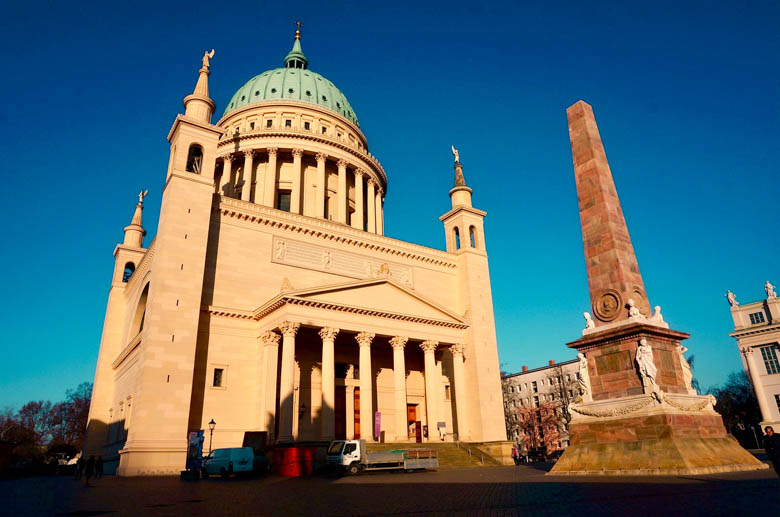
St Nicholas’ Church was badly damaged during World War II and was rebuilt to its original state again in the 1970s and 1980s. Today, it’s the largest church in Potsdam.
Alter Markt and Neuer Markt, Potsdam
Potsdam has two market squares: The Old Town Square (Alter Markt) and the New Town Square (Neuer Markt). Both exquisitely designed in the intricate and decorative Baroque architecture style that originated in Italy more than 400 years ago.
You can easily tell which market square you’re in by looking for the giant 16 meter tall obelisk. If you see the obelisk, it means you’re in Alter Markt.
Neuer Markt is tucked away behind a row of houses on the western part of the town of Potsdam. Make sure you see it because Neuer Markt square is one of the best preserved baroque squares in Europe.
Museum Barberini
Before Barberini became a museum, it was actually built as the stately mansion for the King of Prussia, Frederick the Great. Back then it was known as Barberini Palace and its design was modelled on the Palazzo Barberini in Rome – hence the name.
Today Museum Barberini in Potsdam, Germany, is known for exhibiting artworks from the Old Masters to contemporary art.
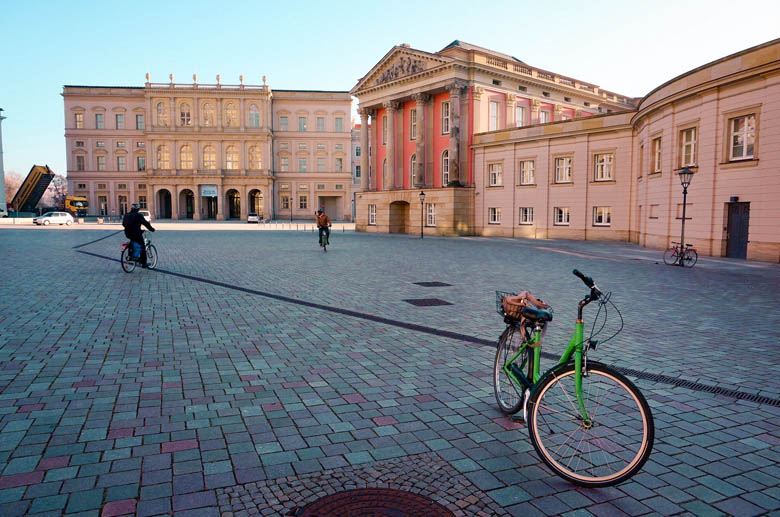
Film Museum Potsdam
If you love film and movies, then you must see The Film Museum in Potsdam. It’s located in Stadtschloss Palace (The Potsdam City Palace) and it’s the oldest film museum in Germany.
You can spend an entire afternoon in this interactive and immersive museum. Wandering through the rooms learning how movies are made. And if you’ve always wanted to try your hand at acting, you can even make your own audition tape or digitally insert yourself into famous movie scenes. How cool is that?!
But if you’d rather stick to watching movies instead, the museum also screens films everyday for a reduced price. Check out the Film Museum Potsdam Schedule to see what’s on.
2. Bassinplatz
Just outside one of the most famous Potsdam attractions, The Dutch Quarter, lies another one of the city’s lesser known town squares, Bassinplatz.
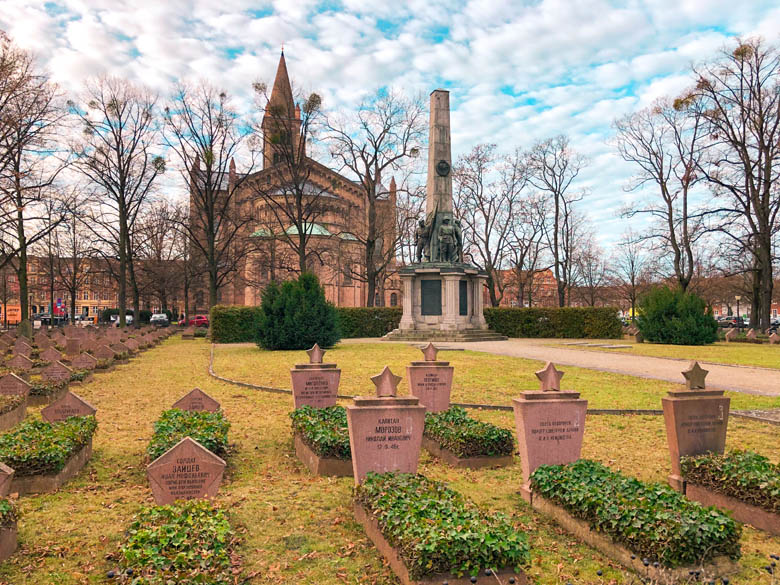
The square was named ‘Bassinplatz’ (which translates to ‘basin place’) because it was originally created to drain the surrounding swamp area almost 400 years ago.
Today, it’s home to the St Peter and Paul Roman Catholic Church and the Soviet Cemetery of Honor.
3. Dutch Quarter, Potsdam Germany
There’s a reason why the Dutch Quarter, or Hollandisches Viertel, is one of the top things to do in Potsdam. It’s the only place in the world that has the most Dutch houses outside of the Netherlands and how it earned its name ‘Little Amsterdam’.
The Prussian King had 134 red brick, Dutch style houses built here in the middle of the 18th century, to help recruited expert craftsmen from Holland feel more at home in Potsdam.
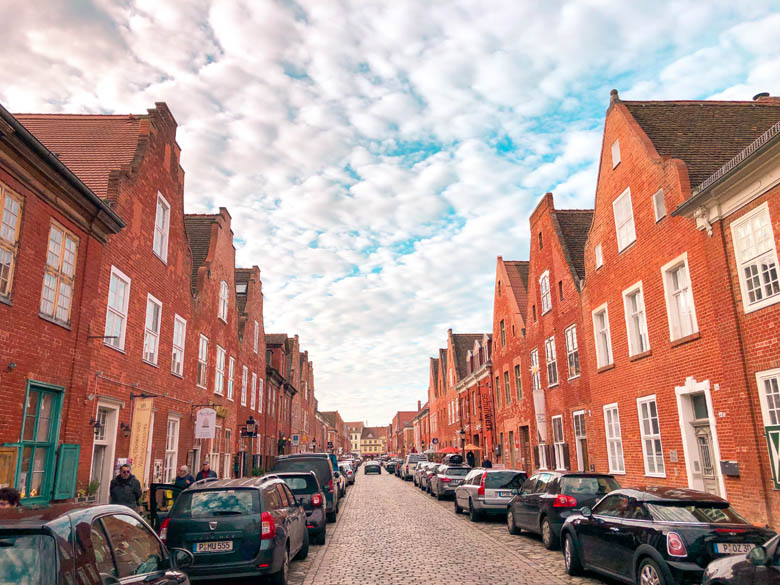
Today, the Dutch Quarter remains the largest Dutch housing development outside of Holland and is home to cute cafes, pubs, boutique shops, galleries and workshops.
Make sure you stop by Poffertjes en Pannekoeken for some traditional Dutch poffertjes! They’re delicious, Dutch mini pancakes and they’re so yum you won’t want to share.
4. Cecilienhof Palace
This unassuming English Tudor manor house was first the royal residence of the Prussian monarchy. And later the meeting place for one of the most important events in history: The Potsdam Conference where the Potsdam Declaration was signed.
Today, it remains a significant site of world politics and a top attraction to visit in Germany.
You can take a guided tour inside Cecilienhof and see the meeting rooms and the infamous conference table used to discuss the Potsdam Declaration.
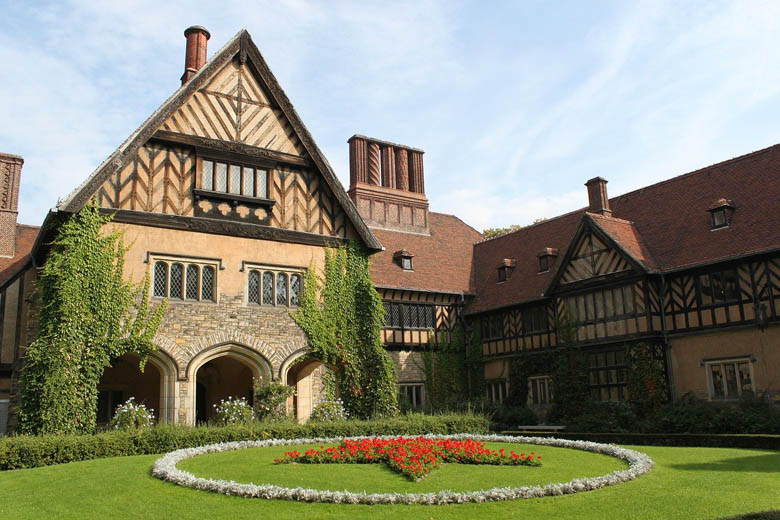
Ever wondered what the giant red star in front of Cecilienhof, Potsdam means?
The red star is crafted out of geranium flowers and was planted by the Soviets to mark the occasion of the Potsdam Conference.
Why was the Potsdam Conference and Potsdam Declaration important?
In short, the Potsdam Conference and the signing of the Potsdam Declaration was significant because of how it shaped world history.
Firstly, it was here at Cecilienhof where US President Truman had authorised (casually over the phone) the use of the world’s first weapon of mass destruction (i.e. the atomic bomb) to be used against Japan.
Two atomic bombs and more than 300,000 deaths later, Japan finally surrendered, bringing World War II to an end.
The Potsdam Conference therefore came to symbolise the end of World War II but also the beginning of the Cold War and the division of Germany into 4 different sectors. These events then led up to the division of East and West Berlin and the construction of the world famous, Berlin Wall.
If you loved this simplified explanation of the Potsdam Declaration, make sure you read our simplified version of the Berlin Wall Story too.
Save Me For Later
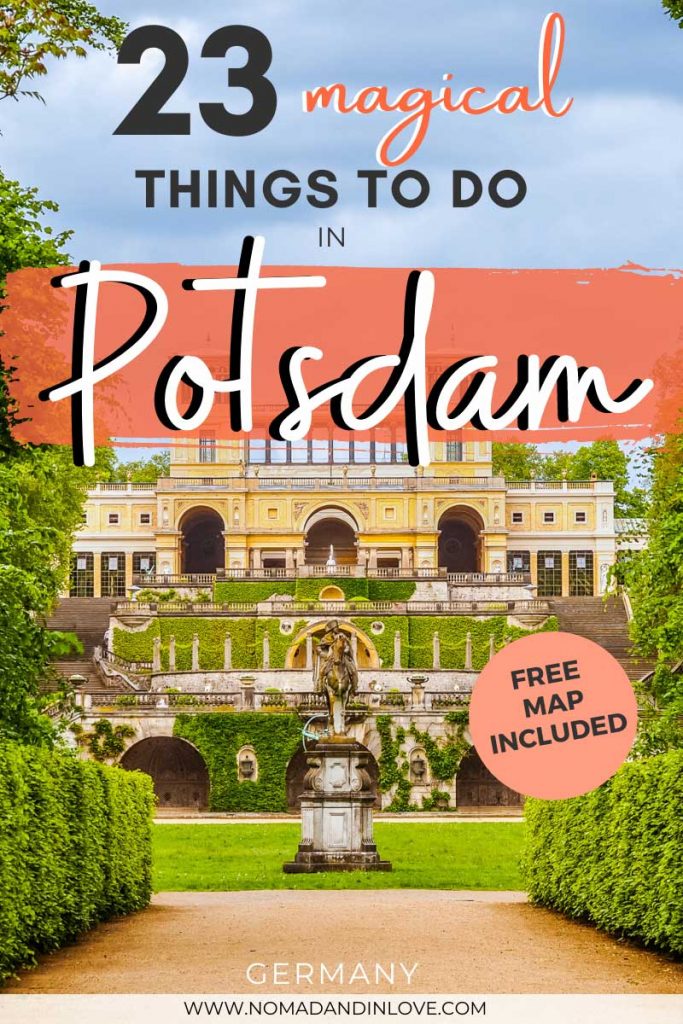
5. Belvedere Castle on Pfingstberg
The next stop on our day trip from Berlin in Potsdam, is to see the fairytale setting of Belvedere Castle on Pfingstberg.
Belvedere Castle is perched on the highest point in Potsdam, at 76 meters above sea level. More than 10,000 visitors visit the castle every year to enjoy the best views over Potsdam from Belvedere’s Palace towers.
Looking from the outside, you would never know that this magnificent building remains unfinished. Even in its incomplete form, Belvedere Castle on Pfingstberg is still a sight to behold and listed as a UNESCO World Heritage Site.
You can take a tour inside Belvedere Castle and see the permanent exhibition in the palace. And if you’ve always dreamt of a fairytale wedding, you can hire the venue out for the special occasion.
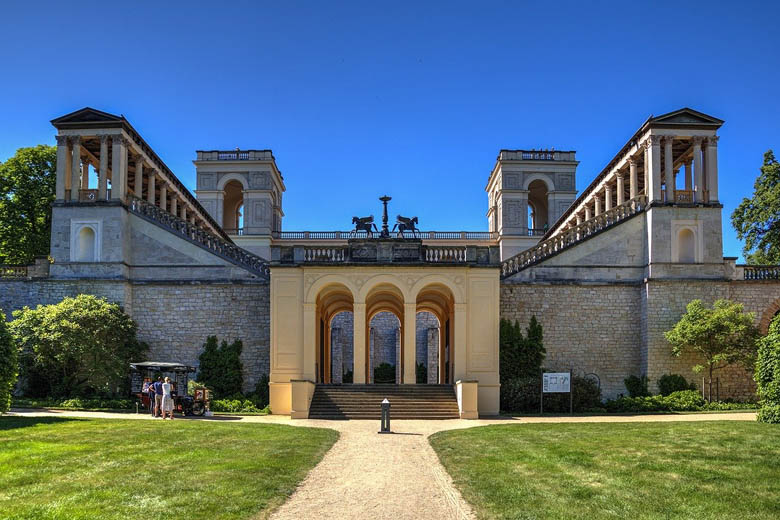
Interesting facts about Belvedere Castle, Pfingstberg
The story goes that the then King of Prussia, Frederick William IV, was inspired to build an Italian style villa after returning from his travels in Italy.
He was inspired by not one, but three Italian Villas. The soaring towers from Villa Medici in Rome, the water fountains and terraces from Villa D’Este in Tivoli and finally, the cascading waterfalls and rounded flights of stairs from Villa Farnese in Caprarola.
You can imagine how massive Belvedere Castle was envisioned to be. But sadly only a part of the original plan was completed. The King ran out of funds and had died before Belvedere was finished.
6. Alexandrowka
The next attraction in Potsdam will transport you to Russia.
Alexandrowka is a Russian colony that was build by the Prussian King, Frederick William III. He built 12 traditional Russian wooden houses, farms as well as a Russian orthodox church for the 12 Russian singers who entertained the Prussian troops during his reign.
King Frederick William III named Potsdam’s Russian colony ‘Alexandrowka’, after the Russian tsar, Alexander I, because of the close friendship they shared.
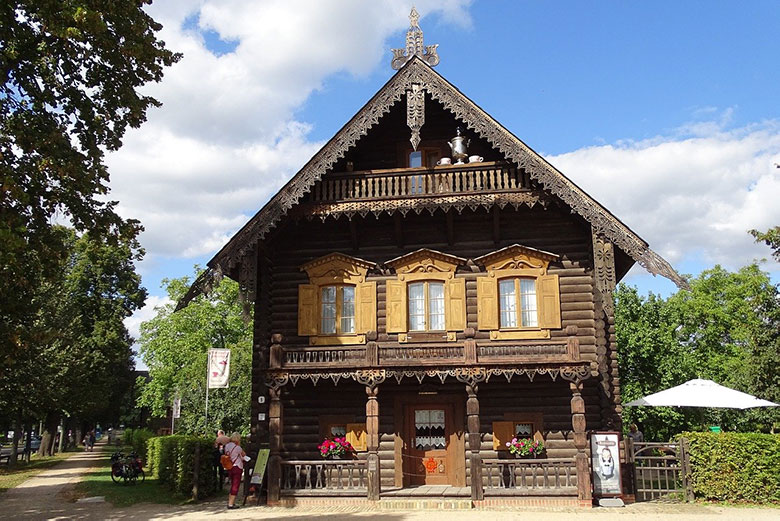
A few descendants of the former inhabitants still live in Alexandrowka today. Make sure to stop by the museum if you want to learn more about the history of the community.
7. Nauener Tor
We are slowly approaching the highlight of Potsdam, but first we must visit the Royal Palace Section Gates that lead you to Sanscoucci.
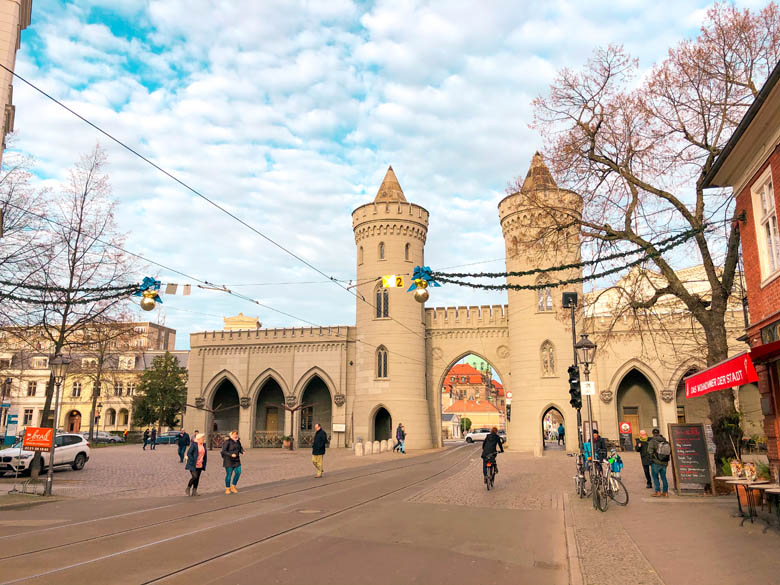
More than 300 years ago, Sansoucci was surrounded by an extended wall where you could only enter via its 7 Royal City Gates. Only 3 of Potsdam’s original city gates remain standing today and Nauener Tor is one of the them.
Nauener Tor was mostly used by the military, merchants, craftsmen and administrators back in the day. Today, it is surrounded by lots of cafes, restaurants, bars and is a popular meeting spot for locals.
8. Jagertor Potsdam, Germany
A few steps away from Nauener Tor, takes you to see the oldest of the 7 Royal City Gates in Potsdam – Jagertor.
Jagerstor, or Hunter’s Gate, is the only Royal Gate that has been preserved in its original state. The decorative sculpture on top of the gate, encapsulates a hunting scene that was very popular back in those times.
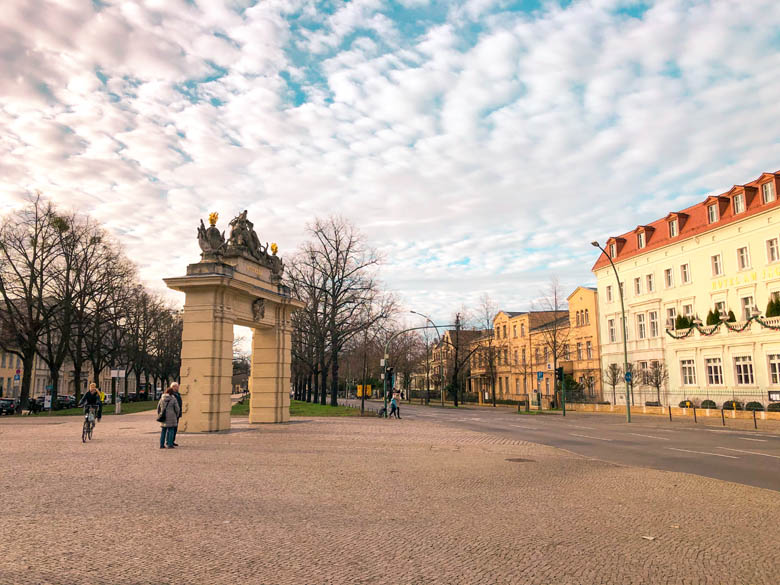
9. Obelisk Hauptallee, Sansoucci East Entrance
Now that you’ve entered the Royal Gates and breached Sansoucci’s walls, it’s time to officially enter the Royal Gardens.
It’s a short 700 meter walk from Jagertor before you’ll come across a mammoth obelisk at Sansoucci’s east entrance. The obelisk with what appears to be hieroglyphs seems out of place. And there doesn’t seem to be any particular reason why it was built here.
But what’s interesting is the fact that the ‘hieroglyphs’ contain no text or meaning. They were simply decorative and created from the imagination of the artist.
As you enter the garden gates of Sanssouci, you’ll see two sculptures on either side: Flora, the goddess of flowers and Pomona, the goddess of fruit.
You’ll notice that their backs are facing you as you enter. That’s not because they’re being rude, but rather that the eastern entrance was initially built to only serve as an exit. So both goddesses are positioned to look into the interior of Sanssouci so that they can bid guests a warm farewell as they leave.
Related Guide: Visiting Potsdam in spring? Then make sure you read our Cherry Blossoms in and around Berlin guide to find out where to see them in Potsdam.
10. Kaiser Friedrich Mausoleum
The first attraction you’ll see in Sanssouci to your left is the Kaiser Friedrich Mausoleum and Friedenskirche (Peace Church). The church was built by the same Prussian King who commissioned Belvedere Castle.
His love affair with Italian architecture did not end with Belvedere Castle because he then personally designed Friedenskirche to resemble a High Medieval Italian monastery.
It was only a few decades later, that Kaiser Friedrich Mausoleum was added. And this is where the artistically gifted, Frederick William IV and his family are buried.
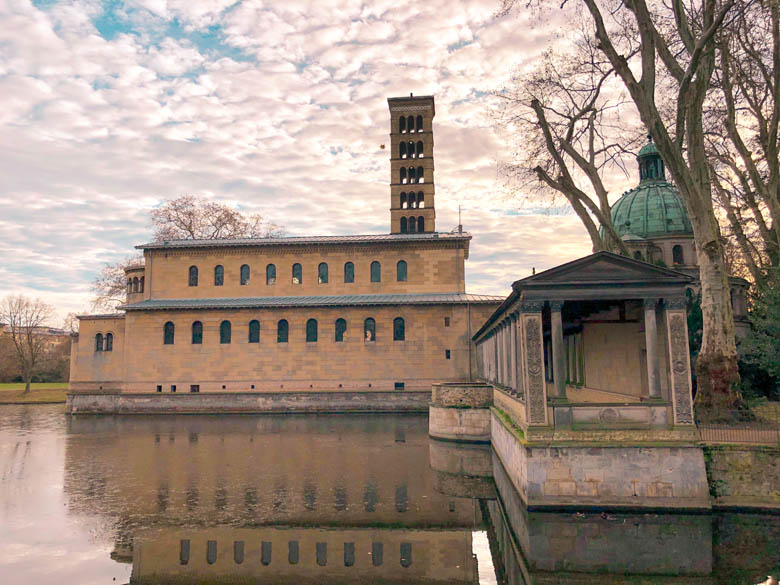
11. Sanssouci
The moment you’ve been waiting for! The top thing to do in Potsdam and the ultimate highlight on your day trip from Berlin – Sanssouci Palace and the surrounding royal gardens in Sanssouci Park.
Sanssouci may be world famous and a top attraction to visit in Germany, but it’s also free. There is no entrance to pay except if you want to visit the museums.
King Frederick the Great named his summer residence ‘Sanssouci’ for good reason. The word literally translates to ‘without a care’ in French and it aptly describes it as the sanctuary he could go to escape the neighbouring city of Berlin.
Bonus Tip: Spend a day feeling like royalty and see the majesty interiors of Sanssouci Palace. Skip the queue and book your Sanssouci Palace tickets online or take this guided tour of the Sanssouci Palace and Park Tour .
Sanssouci Park
Most people visit Sanssouci in Potsdam, Germany, mistakingly believing Sanssouci Palace to be the highlight of this world-renowned park. When it is in fact the entire Sanssouci Park and gardens itself, that earned the park its UNESCO World Heritage Site status since 1990.
Beyond its beauty, Sanssouci Park captures 250 years of the highest level of garden design in history. It also united the best landscape designs and artworks by the most competent architects and sculptors of that time.
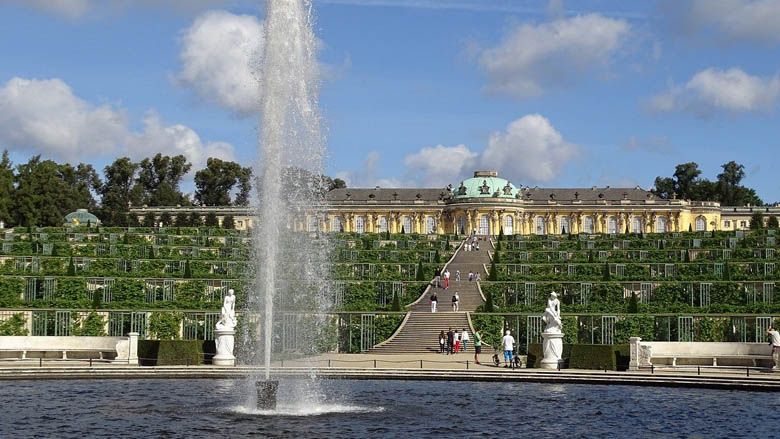
Interesting Facts About Sanssouci Park
Today, visitors can enjoy an entire day just admiring all the sights and attractions in Sanssouci Park alone. The park is as big as 420 soccer fields (300 hectares) and spans more than 2 kilometers from east to west. So make sure you’re wearing your most comfortable shoes on this day trip from Berlin in Potsdam.
As you wander around Sanssouci Park, you’ll find changing styles of exquisite garden design, buildings from different architectural periods, fountains and more than 1,000 sculptures.
A small army of gardeners (almost 60) are hired to maintain Sanssouci Park’s expansive lawns, flowerbeds, hedges, meadows and trees. Just on the landscaped platforms at the foot of Sanssouci Palace alone, there are more than 230,000 plants to maintain and care for.
Sanssouci Palace
Believe it or not, but Sanssouci Palace or Schloss Sanssouci was built to represent the Prussian King’s humble and artistic lifestyle. Not as a show of strength. The King never used Sanssouci Palace for state matters or formal meetings, but rather as a retreat and a place of relaxation.
The King had intended for his new palace to be built in the rococo style. This meant that Sanssouci Palace would be built to have a simple looking exterior but an intricate and highly decorative interior.
During its construction, the Prussian King often added new features to the palace. As more of his personal touches were added, Sanssouci came to become a unique piece of architectural style. The new style was named ‘Frederican Rococo’, named after King Frederick himself.
Today, you can see other buildings built in this unique style at Charlottenburg Palace in Berlin and the Potsdam City Palace (Stadtschloss).
12. Historic Mill of Sanssouci
The next stop on our Potsdam itinerary is to see the Historic Mill of Sanssouci. Walk behind Sanssouci Palace towards the left (west) to find it.
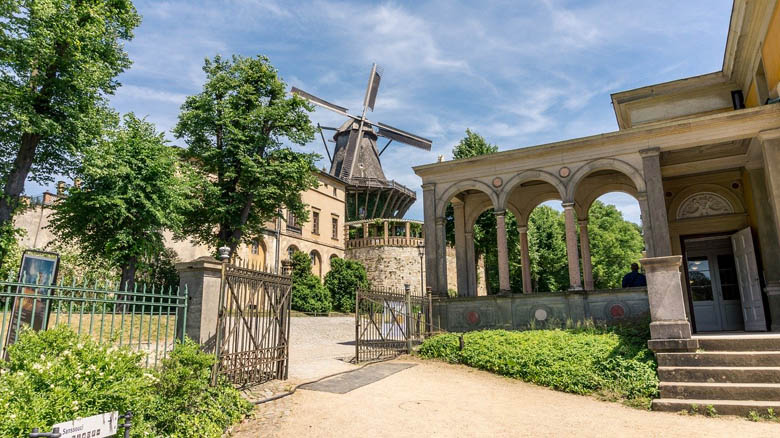
The Historic Mill of Sanssouci has been here for more than 280 years. Residents from the surrounding areas use to come to grind their corn at this mill.
The mill eventually became famous because King Frederick II had tried to get this mill removed and rebuilt elsewhere. The rattling sounds and noise didn’t appease his Royal Highness. Luckily one of the millers was brave enough to stand up to the King with a lawsuit, forcing him to reluctantly accept the mill and the noise that comes with it.
Today, the Historic Mill of Sanssouci is a museum and you can head inside to learn more about its history and how corn was milled back in the day.
13. Orangery Palace
Orangery Palace was the last and largest palace built in Sanssouci Park and was another one of King Frederick William IV’s (the romantic royal) commissioned designs.
He named it ‘Orangery Palace’ because it was literally a palace combined with an orangery. To combine what was essentially a greenhouse or plant conservatory with a palace, was quite a challenge for the architects.
But it was finally completed after 13 years and today you can still admire the two huge plant halls that connect the magnificent central building. And standing in the front and centre of Orangery Palace, is the marble statue of King Frederick William IV himself.
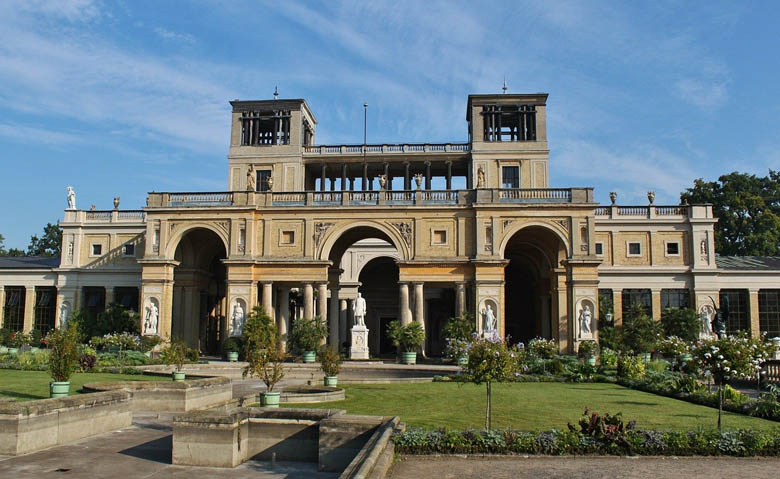
When you’re visiting Orangery Palace in Potsdam, make sure you see the Raphael Hall. It’s the jewel of Orangery Palace and one of the most important museums in Sanssouci Park and the whole of Germany.
The Raphael Hall houses more than 50 copies of paintings created by the famous Renaissance painter, Raphael. These copies were commissioned by young Prussian painters in Paris and are hung in the two-storey gallery hall.
14. Chinese House in Sanssouci
The Chinese House in Sanssouci (Chinesisches Haus) was built by Frederick the Great as a retreat within a retreat. The exotic garden pavilion of the Chinese House, was his escape to a far off and more cheerful world.
It was also incredibly ‘hip’ for royals and courtiers to embrace the Chinoiserie fashion during those times. Not only in Germany, but throughout Europe.
Today, you can still see the life-sized gilded figures, playing instruments, smoking tobacco and drinking tea, outside the Chinese House in Sanssouci.
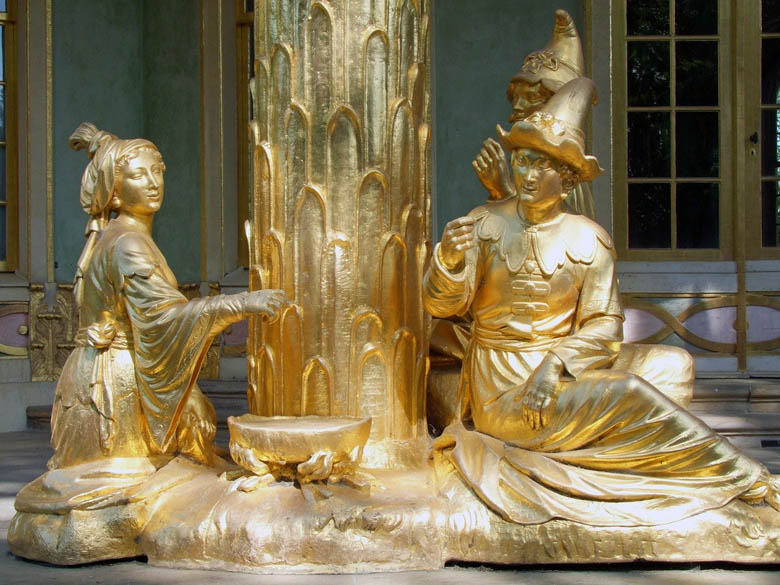
15. Roman Baths, Potsdam Germany
The Roman Baths in Sanssouci, Potsdam is another one of Frederick William IV’s creations from his love of all things Italian. But his version of the Roman Baths was more of an inspiration, rather than an accurate representation of the Roman thermae.
These Roman Baths in Potsdam are composed of different elements. The Great Arbour, a tea house, a garden house, a gardener’s lodge and assistants’ house and finally, the Roman baths.
But these Roman baths were never actually built to be a bathing facility. It was built for the King to have a piece of Italy close to his summer residence in Sanssouci.
16. Neues Palais, Potsdam Germany
Whilst Sanssouci Palace was built to be humble and modest. New Palace or Neues Palais was built to impress and show the Prussian state’s undiminished power and wealth following the Seven Years’ War.
It was the last royal residence Frederick the Great built in Sanssouci, but he rarely stayed there himself. Instead, New Palace was mostly used to accommodate guests and as a venue to host celebrations.
The palace looks impressive enough from the outside, but did you notice something weird with the red brick facade? Well, that’s because it’s fake. The red brick facade was a painted imitation to save money.
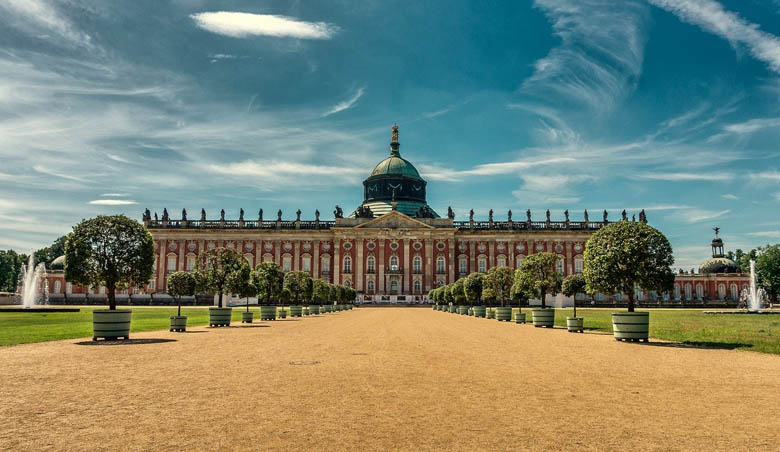
Today, you can go inside Neues Palais and see its exquisitely lavish interiors. The recently restored Lower Royal Suite, with its Braided Room, Concert Room and Oval Cabinet is considered to be the most extravagant interiors in Europe.
Make sure to stop by the Fredersdorf Cafe & Restaurant here if you need a little break and an afternoon pick-me-up.
17. Charlottenhof Palace
Seeing any palace after Neues Palais can be underwhelming. But it’s worth visiting Charlottenhof Palace to see its beautiful gardens and its opulent, unique interiors. The interior design of the palace rooms are well preserved and the ‘tent room’ in particular, is a highlight to see in Potsdam, Germany.
The ‘tent room’ is the most distinctive room in Charlottenhof Palace because its design was inspired by Roman Caesar’s tent. The entire interior from its ceilings, walls, window treatments and even furniture are fashioned in the same blue and white striped draping.
18. Brandenburger Tor Potsdam, Germany
Brandenburger Tor is the last of the Royal City Gates to see as you leave Sanssouci. It’s easy to get this royal gate confused with the much bigger and grander Brandenburger Tor in Berlin, but it’s actually not the same.
Brandenburger Tor in Potsdam, was built 20 years before the one in Berlin and is therefore the original, not the mock up. This was also the most important gate in Potsdam because it marked the entrance to the city as well as the entrance to the entire Brandenburg region itself.
This gate started out as a more simple wooden gate and was rebuilt to what you see today after the Seven Years’ War. It was rebuilt to this grander version to commemorate the Prussian’s victory.
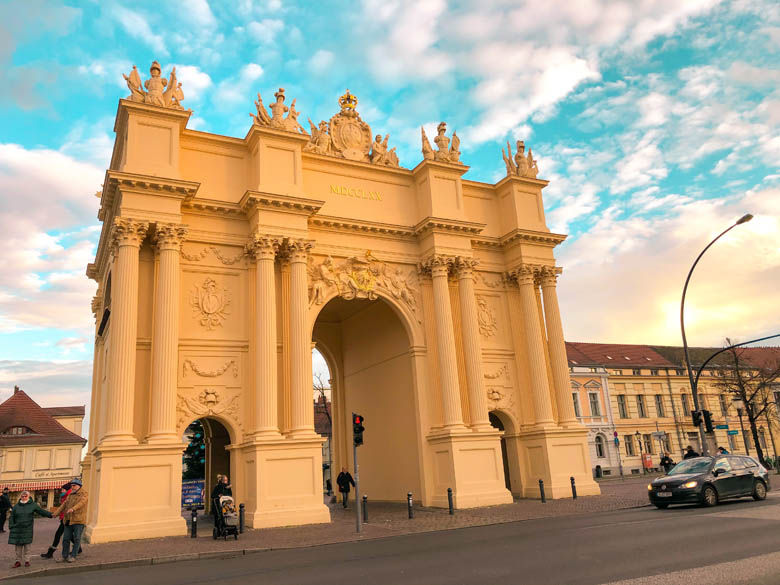
19. Glienicke Bridge, The Bridge of Spies
And your last destination on this Best Things to Do in Potsdam Tour – Glienickebrucke. It’s a little bit out of the way to get to from Brandenburger Tor, but it’s absolutely worth it.
Glienicke Bridge may look like an ordinary bridge today. But back in the day when the Berlin Wall was still standing, this was the spot where East and West exchanged secret agents and spies. And that’s how it got its other name, The Bridge of Spies.
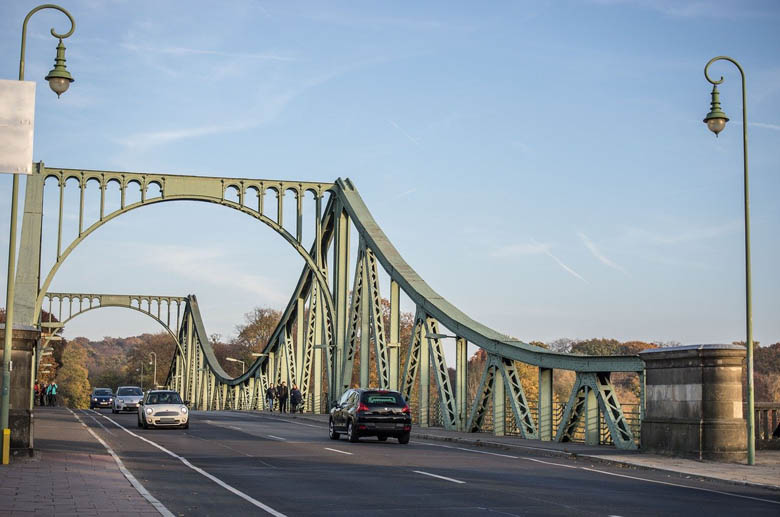
You probably recognise it if you watched the movie with the same name, The Bridge of Spies (2015), that starred Tom Hanks.
It’s a must-visit for all the history fanatics out there. But if that’s not your thing, you should still see Glienicke Bridge for its views over the Havel River, Glienicke castle grounds, Babelsberg Castle and the Sacrower Heilandskirche church.
Other Things To Do in Potsdam, Germany
If you’re looking for more things to do in Potsdam on your day trip from Berlin, here’s some ideas:
20. Potsdam Palace Tour Boat Cruise
Admire the countless palaces and beautiful parks from the Hohenzollern Dynasty and see a true piece of history on a 90 minute boat cruise along the Havel.
The Potsdam Palace Tour By Boat is available in both English and German. Book online to avoid the queues.
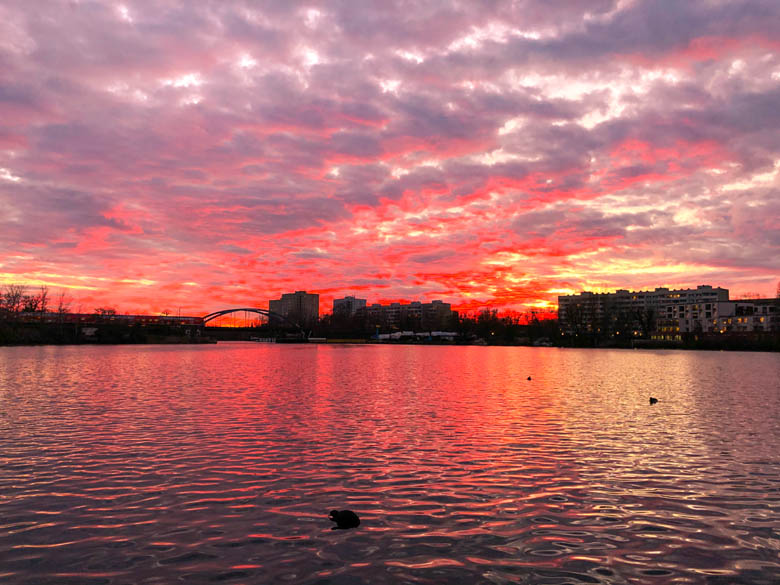
21. Potsdam by Boat: Island Cruise
Enjoy this 4 hour boat cruise along the Havel and discover all of Potsdam and its surrounding villages.
Admire Caputh Castle, Babelsberg Castle, the fishing and vine town of Werder and other beautiful sights on the Potsdam Island Cruise Tour .
22. Potsdam to Wannsee 2 Hour Cruise
Enjoy a well deserved swim at Wannsee Lake after your long walking tour in Potsdam and swim in one of the most beautiful lakes in Berlin.
See the iconic residences of the Prussian Hohenzollerns, mansions of famous film and television stars as well as the residences of President Truman and Winston Churchill during the Potsdam Conference of 1945 on this 7 Lakes Tour from Wannsee Berlin .
Otherwise you can also make another day trip from Berlin to visit Wannsee Lake on your own. Check out our Best Outdoor Activities To Do In Berlin guide to find out how to get there.
23. Babelsberg Film Studio Tour
Last but not least – take a look behind the scenes and visit the famous Babelsberg Film Studio on this 5 hour guided tour from Berlin .
Studio Babelsberg is the world’s oldest studio and the largest of its kind in Europe. More than 3,000 productions have been made here. International cinema productions such as Inglorious Basterds , The Pianist , and Cloud Atlas were filmed here!
It was once considered Europe’s Hollywood, but after the Nazis came to power, many actors and artists moved to America.
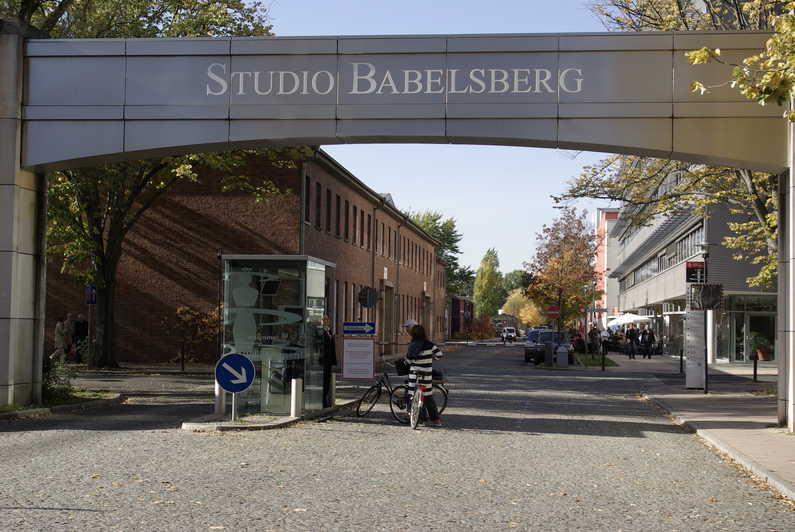
24. Babelsberg Park (UNESCO)
Visit another UNESCO World Heritage Site in Potsdam – Babelsberg Park. Take a guided tour to find out what role Babelsberg played at the end of World War II and how it was once used as a point to escape across the Berlin Wall.
Best Things To Do In Potsdam – Day Trip From Berlin
- Town of Potsdam, Germany
- Bassinplatz
- Dutch Quarter
- Cecilienhof Palace
- Belvedere Castle on Pfingstberg
- Alexandrowka
- Nauener Tor
- Obelisk Hauptallee
- Kaiser Friedrich Mausoleum
- Historic Mill of Sanssouci
- Orangery Palace
- Chinese House in Sanssouci
- Roman Baths, Potsdam Germany
- Neues Palais
- Charlottenhof Palace
- Brandenburger Tor, Potsdam
- Glienicke Bridge
- Potsdam Palace Tour Boat Cruise
- Island Cruise: Potsdam by Boat
- Potsdam to Wannsee 2 Hour cruise
- Babelsberg Film Studio Tour
- Babelsberg Park
So there you have it, 23 awesome and free things to do in Potsdam on your day trip from Berlin! Feel free to do it in 1 day or split it over a 2 to 3 day itinerary.
Thank You For Reading
If you enjoyed reading this guide, share it with your friends and family. Have a question or need advice? Contact us via Email, Messenger or WhatsApp. And if you'd like to leave a comment, tweet us . Oh, and don’t forget to subscribe and follow us on social media !
Help the site by leaving a review:
Buy Us A Coffee
Our content is free and always will be. But if this guide has saved you time, money or made your life easier, feel free to buy us a coffee . We’ll really appreciate your support.

Support Our Work
Can't donate? No problem! You can still support us by booking hotels , car rental , and tours with us. Check out our resource page for all offers and discount codes.
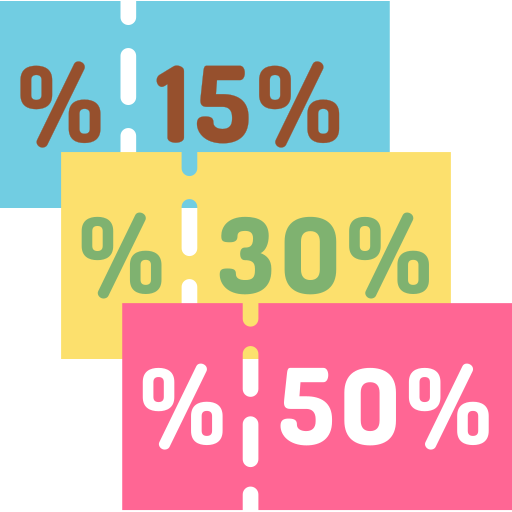
📣 This guide contains affiliate links. This means if you click on our links and buy something, we may earn a commission at no extra cost to you. This allows us to work on the website full time and keep Nomad And In Love alive and thriving.
Related Guides
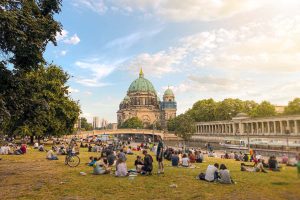
Locals Share 13 Secret Insider (And Not-So-Obvious) Tips To Travel Berlin On A Budget: Germany Travel Guide
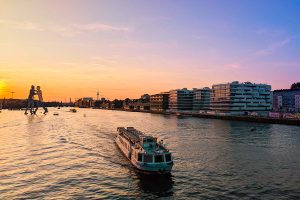
A Local’s Guide On Where You Should REALLY Stay in Berlin as a Tourist (Besides Mitte): Germany Travel Guide
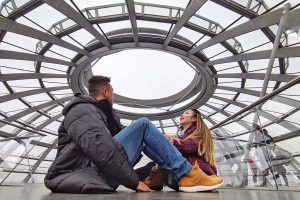
Berlin 3 Day Itinerary: 11 Free Indoor Things To Do in Berlin this Winter (With Interactive Map)

Visit Potsdam, The Perfect Day Trip from Berlin
Updated November 9, 2019
// By Margherita
Are you looking for the perfect day trip from Berlin ? Visit Potsdam! You’ll find plenty of things to do, historical sights, museums, palaces and the best cheesecake in Germany, all a 30 minute S-Bahn ride from central Berlin!
I’ve always hated stereotypes and statements like ‘X city doesn’t feel like X country’ – after all, my hometown Milan is often billed ‘not very Italian’ , something I believe is complete rubbish.
Yet, I must admit Berlin has a very different feel from the rest of Germany . We’ve visited Berlin countless times during the past few years, and always loved the alternative vibe and many things to do in winter – but until last March, we’d never made it to Potsdam , one of the most popular destinations for a day trip from Berlin.
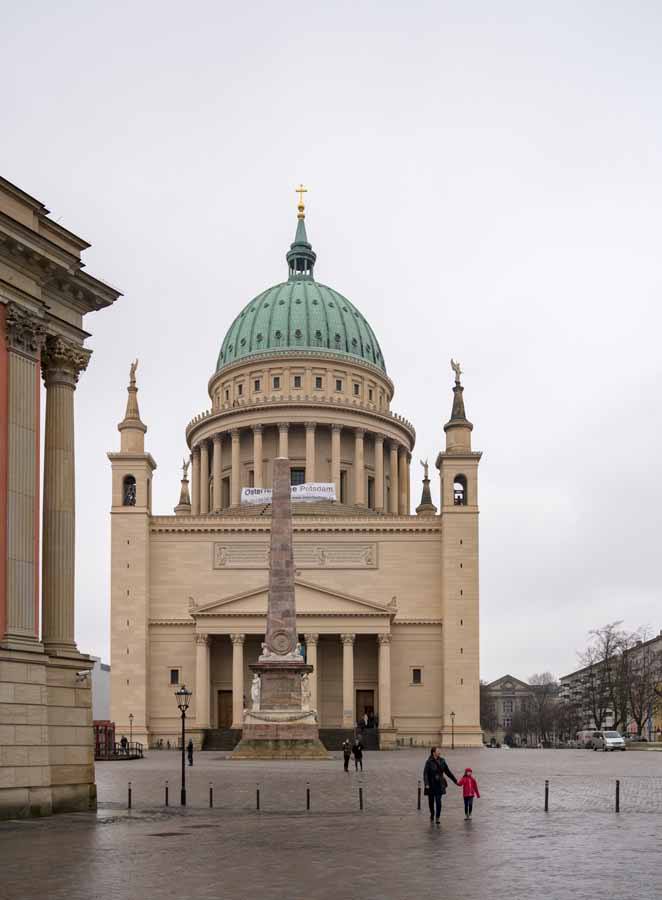
Potsdam is the capital of the German state of Brandenburg, and it’s located just outside Berlin – but it feels a world away from the busy German capital . Last March, we enjoyed visiting on a typical winter day, even though the weather was terrible and the temperature just above freezing.
Potsdam is a kind of alter ego to Berlin – romantic and gemütlich , while the latter is urban and gritty; full of nature and pretty UNESCO-listed palaces , rather than Brutalist architecture; still with a very ‘local’ feel, while Berlin’s charm lies in its multiculturalism.
Why Visit Potsdam?
On top of that, Potsdam is steeped in history. A former hunting residence, Potsdam was chosen as a full time residence by King Frederick the Great in the 17th century, eager to escape the chaos of Berlin. Frederick’s moniker ‘Great’ is not just due to his mighty size, but also to his great achievements – he united Prussia and was a supporter of the Enlightenment, and regularly hosted artists, thinkers and philosophers in his palaces.
Even though Berlin was always the capital, Potsdam remained the residence of the royal family all the way to 1918 , when Germany became a republic. The city was of strategic importance during the 20th century – the Potsdam Conference between the Allied powers at the end of WW2 took place in Cecilienhof Palace, and the nearby Glienicke Bridge was used to exchange spies between West Berlin and East Germany, where Potsdam was located.

For history lovers, a Potsdam day trip from Berlin probably won’t be enough – whereas if you just want to get an idea of the city, enjoy its chilled, small-town vibe and check out the main Potsdam points of interest , a day trip is a great idea.
Here’s the plan we followed – we had a local guide who introduced us to the history of Potsdam, something that really helped us enjoy the trip. Otherwise, just wander around and enjoy this break from busy Berlin!
Morning – The City Centre and Dutch Quarter
The easiest way to reach Potsdam from Berlin is via the S-Bahn . You’ll find yourself in a juggernaut station-cum-shopping centre – inside there’s also the Potsdam Tourism Info Office , a great place to stop and pick up a map if you don’t have a guide.
Looking at the map, north of the station you’ll find a bridge crossing the river Havel – walk across it, passing the river island called Freundschaftsinsel on your right hand side, and you’ll find yourself in the Alter Markt , a square originally constructed in the mid-18th century, during the times of Frederick the Great.
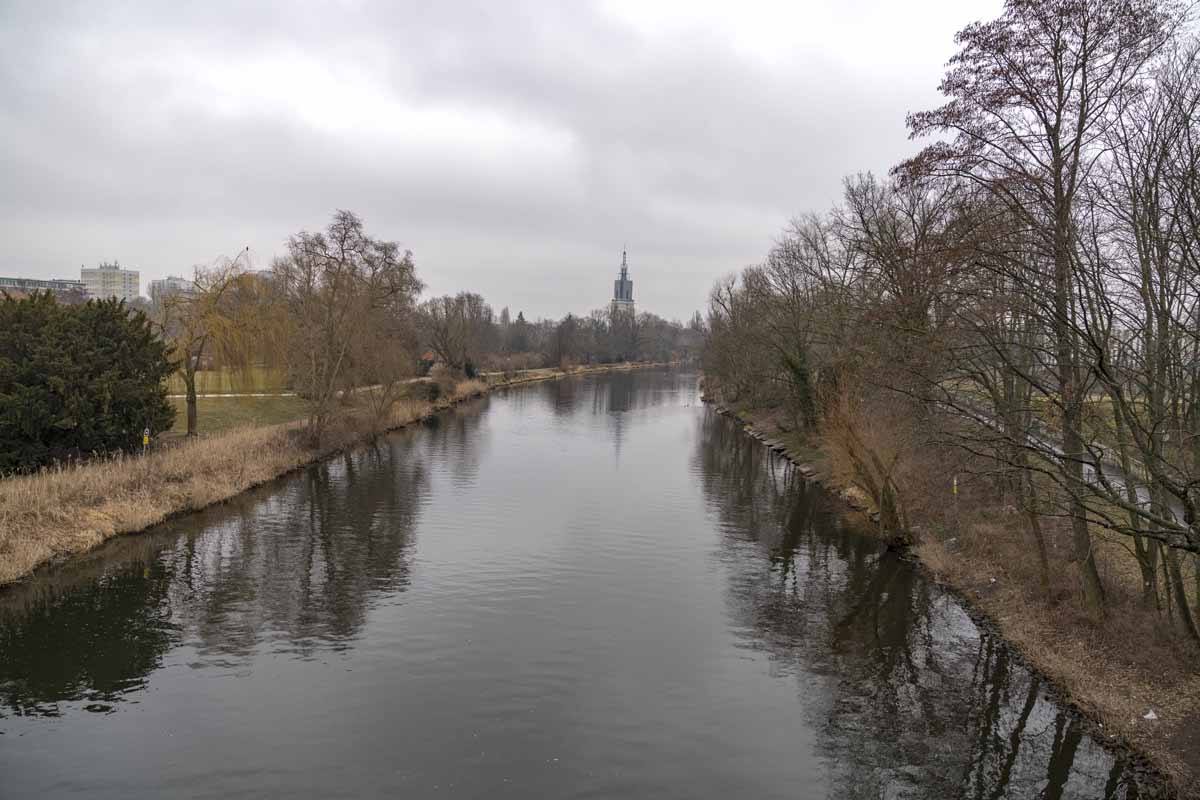
The architect who planned the square aimed to recreate the feel of the great Italian squares of Rome and Florence – on the south side of the square is the Pompei Palace , inspired by the palace of the same name in Verona, to the east is the Old City Hall , fronted by a façade planned (but never constructed) by Palladio, and in the middle of the square there’s an obelisk, to emphasise the ‘Roman’ feel.
The square was largely destroyed during WW2 – the plan of rebuilding it to its former 18th century grandeur is still ongoing . Some interesting buildings surrounding the square are St.Nicholas Church , rebuilt in 1981, the Museum Barberini with an impressive modern art collection, and a Modernist East German building which formerly housing a vocational college, which is being torn down – sadly, may I add. All history is worth preserving.

Not far from Alter Markt there’s the Filmmuseum Potsdam , dedicated to East German movies produced in the nearby Babelsberg Film studio, and housed in a beautiful Baroque building. Another place in the vicinity that’s worth a visit is the Lindenstraße Memorial , used as a political prison by the Nazi, the Soviets and the Stasi.
By then, Potsdam’s very own Brandenburg Gate is just a short walk away alongside the Alter Stadtkanal , a waterway built in the Middle Ages to drain water from the river Havel. It was sadly empty when we were there, but it is filled with water once a year, in occasion of a canoe racing event.
From Brandenburg Gate, you can spend some time wandering the main streets of the city centre like Jägerstrasse , lined with local and independent shops, or you can keep heading East towards the Dutch Quarter, framed by Kurfürstenstraße, Friedrich-Ebert-Straße, Gutenbergstraße and Hebbelstraße, one of the coolest places to see in Potsdam.
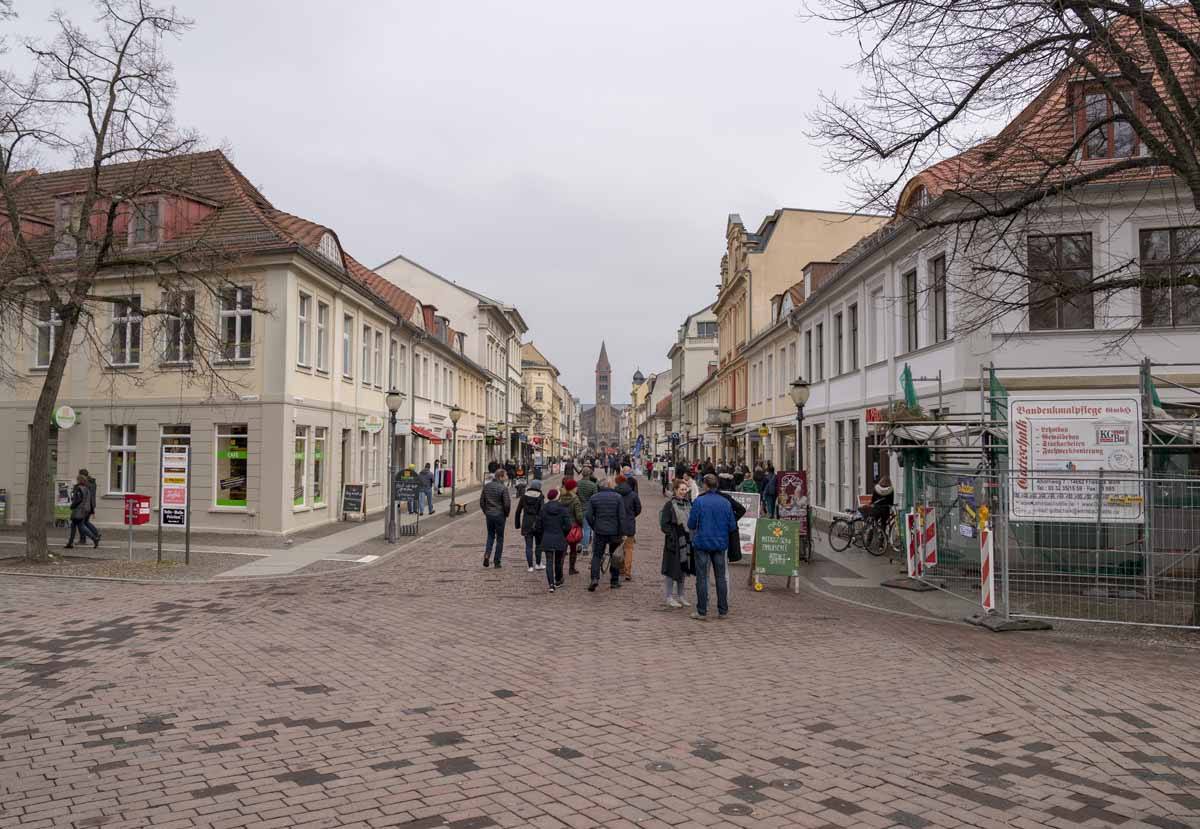
In the mid-18th century, Potsdam was a garrison town, and King Frederick William I ordered it to be extended, but there were few skilled workers. He invited Dutch people to settle in the city , and ordered the construction of 130 brick houses in Dutch style, with gabled façades and painted shutters – so that they would ‘feel at home’.
Weirdly enough, not many Dutch people ended up inhabiting the Quarter – it became the residence of an elite corps of the Prussian army, and of several artists before falling into disrepair during DDR times. Nowadays, the houses have been restored and house cute boutiques, cafes and galleries. Dutch cultural festivals and events are also regularly organised, like the yearly Tulip Festival.
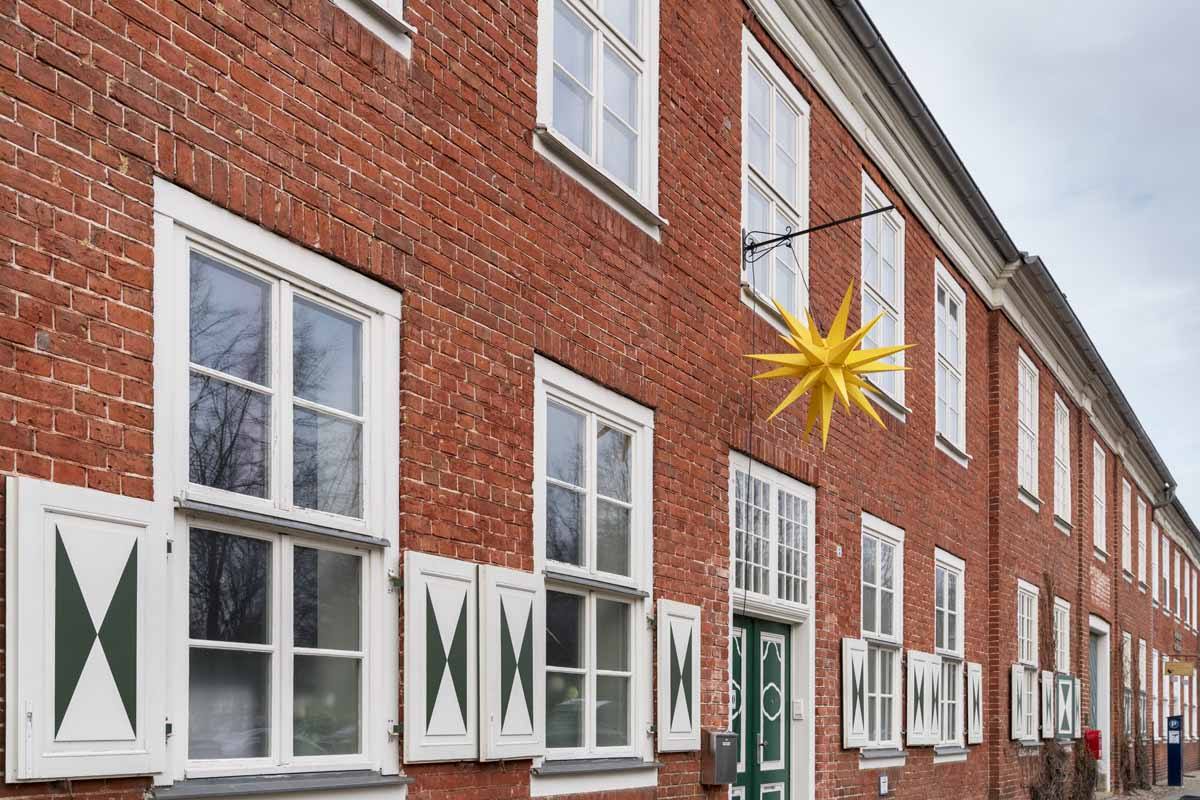
All houses also have an internal courtyard, but those are reserved to residents – if you see front door left open, try to discreetly peek inside. The courtyards are really pretty!
Afternoon – The Russian Quarter and Sans Souci Palace
I found it incredible that not one, but two of Potsdam’s best things to do were actually created to honour other cultures. About 15 minutes walk north from the Dutch Quarter you’ll find yourself in a park, surrounded by 13 log houses, looking uncannily like a mid-19th century Russian village. No, you haven’t entered a time warp – this is Potsdam’s Alexandrowka, or Russian Quarter.
During the Napoleonic Wars, Prussia was an ally of France against Russia. Over a thousand Russian prisoners were taken to Potsdam , and 62 of them decided to settle permanently after the war came to an end, to sing in King Frederick William III’s choir. Shortly afterwards, Russia and Prussia entered into an alliance, and when the Russian Czar Alexander died in 1825, the Prussian king decided to honour this new ‘friendship’ between the two countries, and built 13 ‘Russian style’ homes for the singers and their families.
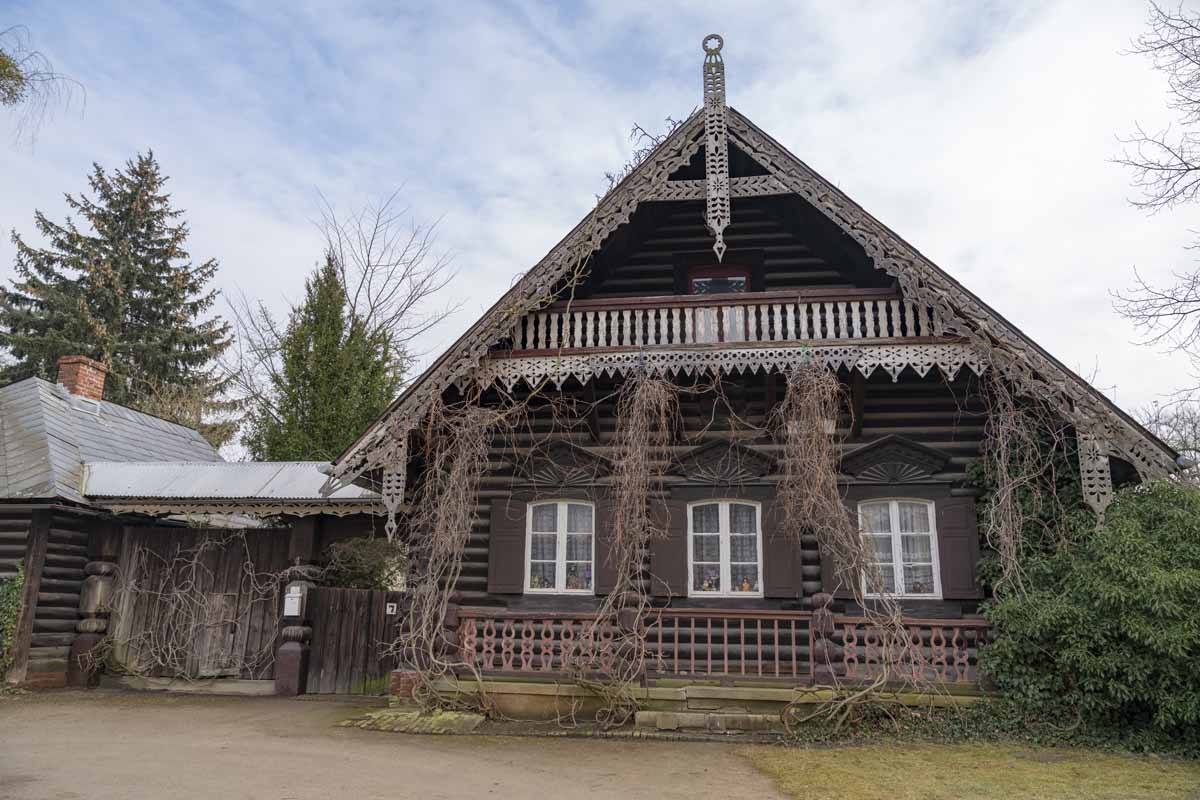
The houses couldn’t be bought or sold, and the deed had to stay in the family. Some descendents of the Russian singers still live in a few of the houses , while one has been turned into a museum and another into a restaurant.
After the Russian Quarter, it will be time to head to Potsdam’s star attraction, the marvellous Sans Souci Palace, built by none other than Frederick the Great. Sans Souci is often called ‘the Versailles of Germany’ , but it’s far smaller than the famous French palace – with only 12 rooms, it can easily be visited in an hour or so. Entrances are strictly timed, and you’ll be provided with a handy audioguide detailing the history of this palace.

The French term ‘Sans Souci’ translates as ‘without worries’ or ‘carefree’ – it was Frederick’s summer palace, never intended to be the seat of a government, but a place to relax and enjoy nature, art and music.
The palace was built in Rococo style , a light-hearted, whimsical architectural style that was completely in line with the palace’s purpose. The interiors are decorated with flowers, animals and nature motifs, with pastel colours and plenty of references to a carefree lifestyle.
The rooms we liked best were the small circular-shaped library , covered in cedar wood, and Voltaire’s Room , taking its name from the French philosopher who resided in the Palace for several summers.
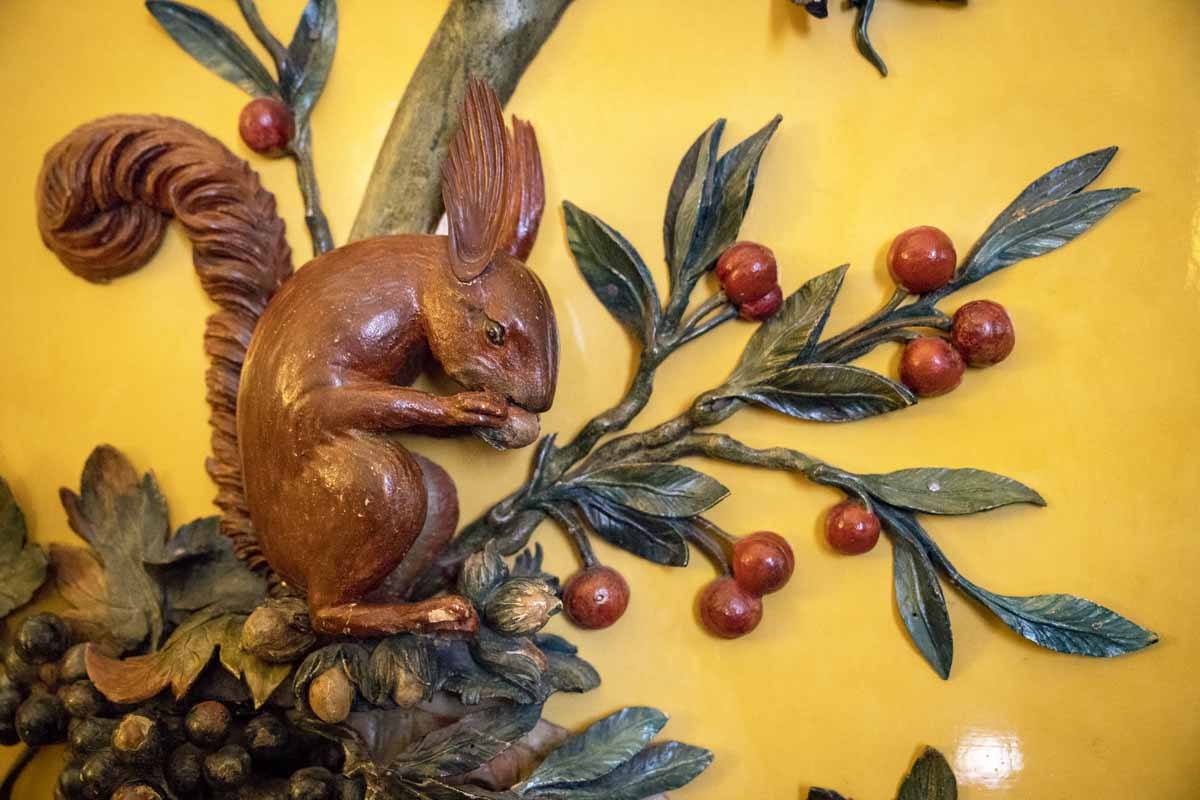
Sans Souci is surrounded by a vineyard and sprawling terraced gardens – the idea behind Sans Souci was that it was supposed to be a place for the king to relax and indulge in his passions , surrounded by nature, in line with the pre-Romantic thought that was developing around that time. Frederick called the palace “mein Weinberghäuschen” – my little house in the vineyards.
The Sans Souci grounds house several buildings and follies like the Chinese House and Temple of Friendship , built by Frederick in memory of his sister. However, it was drizzling and cold by the time we left Sans Souci, so we decided to make our way back to Berlin.

Bonus – The Best Cheesecake in Germany
However, we did have one last stop on the 30 minute walk between Sans Souci and the S-Bahn station – hot chocolate and cheesecake at Café Guam , a cake shop famous for offering the best cheesecake in Potsdam, if not in Germany!
There are about 7 or 8 cheesecake flavours on offer at any given time – traditional ones like blueberry and chocolate and more unusual ones like eggnog, poppy seeds and apricots. Paired with a steaming mug of thick hot chocolate, laced with eggnog liqueur and topped with a swirl of whipped cream, I honestly can’t think of anything better for an afternoon snack in Potsdam!
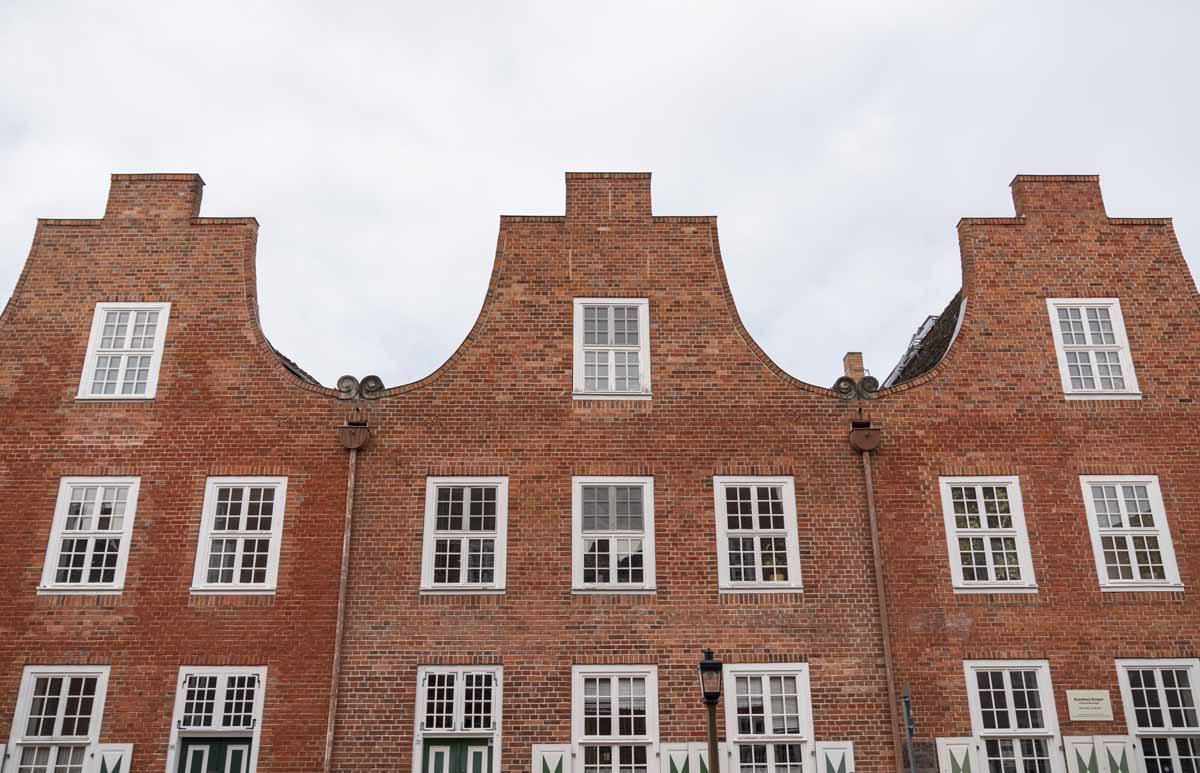
Practical Potsdam Info
- Getting to Potsdam is super easy – just hop on a S7 S-Bahn train and ride all the way to the end of the line. Not all S7 trains make it all the way to Potsdam – make sure you check the destination at the platform before boarding. Potsdam trains run approximately every 30 minutes.
- Potsdam is in zone C, so your regular Berlin zone AB ticket won’t do. Make sure you get an ABC ticket – it will be €3.40 each way.
- If you have a Berlin weekly card for zone AB you’ll have to get an Anschlussfahrausweis (extension) ticket.
- With a ticket valid for zone C, you can also ride on Potsdam’s buses and trams.
- The Berlin Welcome Card also offers discounts for several Potsdam attractions – check this site for more info.
- We didn’t stay in Potsdam, but if you want to, the Hotel am Jagertor and Mercure Hotel look like great options!
- Check Broadway Travel for info on city breaks all over Europe!
We would like to thank Tourismus-Marketing Brandenburg GmbH for having hosted us on this day trip to Potsdam.
Pin it for later?


Home » Travel Guides » Germany » 15 Best Things to Do in Potsdam (Germany)
15 Best Things to Do in Potsdam (Germany)
The capital of Brandenburg, Potsdam is a World Heritage city of palaces and royals parks for the Kings of Prussia. After being devastated in the Thirty Years’ War in the 17th century, Potsdam was remodelled 100 years later by Frederick the Great.
And even after the Kingdom of Prussia was dissolved in 1918, the town witnessed a momentous event in 1945 when the Cecilienhof palace hosted the Potsdam conference. Potsdam’s palaces all tell us something about their Kings and Princes, as well as Prussia’s standing in the world at the time.
Take the Sanssouci, the compact palace where Frederick the Great would get away from it all, the colossal Neuer Schloss, built when Prussia was more confident than ever, or the Orangery Palace, representing Frederick William IV’s love for the Italian Renaissance.
Let’s have a look at the best things to do in Potsdam :
1. Sanssouci Palace

Frederick the Great’s summer palace was built between 1745 and 1747 as somewhere he could escape from the strictures of the Berlin court.
That thinking is clear from the name, Sanssouci, which roughly translates to “without cares”. This sublime Rococo palace is also surprisingly intimate in its scale, standing at only one storey tall (only the secondary wings have upper floors) and settled at the top of a terraced vineyard that holds his simple mausoleum.
Inside, despite the virtuoso stuccowork, carved marble and gilding of the Rococo period, the main purpose was comfort and conviviality.
The finest of the rooms is the ceremonial Marmorsaal (Marble Hall), that has pairs of Corinthian columns from Carrara marble rising from a marble intarsia floor to a white and gilt dome.
2. Sanssouci Park

The palace and its terraced garden are at the centre of an expansive park designed and landscaped in the decades that followed.
The size of this project is almost bewildering, as the park encompasses almost 300 hectares and is crisscrossed by alleys framed by hedges trimmed at right angles.
To get an idea of scale it’s 2.5-kilometres from Sanssouci to the Neues Palais in the west, also built by Frederick the Great in the 1860s.
You’ll need a map, but there’s a host of smaller buildings to discover, all beautiful in their own way, and most containing something exciting.
Take the Bildergalerie holding the King’s art collection, which has pieces by Van Dyck, Caravaggio and Rubens.
Frederick also ordered the Chinese House, a captivating example of Chinoiserie, built from 1755 to 1764 to accompany his vegetable and flower garden.
3. Dutch Quarter

During Potsdam’s second expansion between 1733 and 1742 a whole neighbourhood of Dutch-style red brick gabled houses cropped up either side of Mittelstraße.
There are 134 buildings in all, designed by the Dutch architect Jan Bouman.
The quarter is testament to Frederick William I of Prussia’s love for Dutch culture and desire to attract Dutch artisans and engineers to Potsdam as they were famed for their technical knowhow.
Today these fine houses are in perfect condition, and are occupied by antiques shops, cafes, galleries, design stores and ateliers.
There’s museum about the quarter’s background at the Jan-Bouman-Haus, as well as a tulip festival in April, a pottery market in September and a Dutch-style Christmas market in December.
4. Cecilienhof

The House of Hohenzollern’s final palace was built during the First World War in the style of an English Tudor mansion.
Cecilienhof is half-timbered and has decorative turreted chimney stacks.
The whole palace was inspired by Hill Bark on Merseyside, which itself is a Victorian reproduction of a Renaissance half-timbered design and was adored by German Crown Prince Wilhelm when he visited.
But far outweighing the architecture, what makes Ceclienhof so significant is that it was the stage for the Potsdam Conference from 17 July to 2 August 1945. President Truman, Winston Churchill (followed by Clement Atlee) and Josef Stalin all slept and worked here as they thrashed out a plan for the future of Germany and Europe in the wake of the Second World War.
5. Neues Palais

The other end of the spectrum to the cute, personal Sanssouci, the Neues Palais is a huge Baroque palace built as a statement of Prussian power by Frederick the Great at the conclusion of the Seven Years’ War with France.
Frederick had a preference for the outdated Baroque over the new Neoclassical style, and he roped in Johann Gottfried Büring, who had already designed the Chinese House and the Bildergalerie.
The Neues Palais was intended to create an impression on foreign visitors at banquets and has 200 rooms and four galleries in the Rococo style.
The most peculiar is the Grottensaal, where the walls are clad with over 24,000 seashells, gemstones, fossils and minerals.
To the rear are the Communs, utility structures linked to the palace by a tunnel.
6. Brandenburg Gate

Not to be mixed up with the Brandenburg Gate in Berlin, Potsdam’s own Neoclassical arch was built around 20 years earlier, in 1770/71. The monument, based on Rome’s Arch of Constantine, was ordered by Frederick William II to celebrate Prussia’s victory in the Seven Years’ War.
It replaced the Medieval gate that stood here before, and was part of Potsdam’s walls until they were torn down at the start of the 20th century.
Something worth noting about the Brandenburg Gate is how it has completely different designs on the city and “field” side.
They were created by separate architects: The city side and its pilasters was by Carl von Gontard, while the busier field side and its double rows of Corinthian columns was by his pupil Georg Christian Unger.
7. Belvedere auf dem Pfingstberg

Frederick William IV commissioned this grand viewing platform in the middle of the 19th century to take advantage of the view from the top of the Pfingstberg hill, which rises to 76 metres.
Although the structure is only a small piece of what was here before it’s still a marvellous piece of heritage: The belvedere was restored in the 1990s after being closed off during the days of the wall for providing a view of West Berlin.
Sitting on a tall podium around a courtyard are two towers, above three viewing terraces.
The east and west sides have dignified colonnades with Corinthian style pillars, while the north side has Renaissance-style arches.
8. Park Babelsberg

On Potsdam’s northeastern fringe is a 124-hectare park bordering the Tiefen See lake on the River Havel, laid out for Frederick William IV in the 1830s and 1840s.
The undulating terrain descending to the lake was first shaped by Peter Joseph Lenné, followed by Hermann, Fürst von Pückler-Muskau another celebrated landscape architect.
The latter designed a system of narrow, winding and criss-crossing paths in this hilly scene, which is now sprinkled with mature trees and has uplifting vistas of the lake.
Frederick William IV’s palace in the park was designed by Karl Friedrich Schinkel in the Gothic Revival style and looks like fairytale castle.
Other structures around the park have a similarly Romantic aspect, like the fortress-like pump house on the water and the Kleines Schloss (Little Place).
9. Neuer Garten

In the north of Potsdam on the shores of the Jungfernsee and Heiliger See lakes, Frederick William II (Son of Frederick the Great) plotted a new garden from 1787 onwards.
This differed from Sanssouci, and where his father’s park had arrow-straight alleys and parterres, the Neuer Garten was in the looser English style.
And as with Sanssouci there’s much to discover around this 102.4-hectare park.
The servants’ quarters were set in gabled Dutch-style houses, the palace’s ice house was in styled as an Egyptian pyramid, while there’s also an orangery with an Egyptian portal, a Gothic-style library and the Marmorpalais (Marble Palace) designed by Carl von Gontard.
10. Museum Barberini

The Palast Barberini was an 18th-century Italianate palace on Alter Markt that was completely destroyed in 1945. Since 2013 the facades of the palace have been resurrected, while the interiors are completely modern and are home to a new museum that only opened in 2017. Among the guests for the unveiling were Angela Merkel and Bill Gates, while the collection belongs to the American Hasso Plattner Foundation and focuses mainly on art from the GDR as well as movements the last 25 years.
There’s also a summary of painting from the Old Masters to the 2000s, via Impressionism and Symbolism, with pieces by Monet, Renoir and Munch.
11. Alexandrowka

A reminder of the kinship between the Prussian Hohenzollern and Russian Romanov houses, Frederick William III built this Russian colony in the 1820s in memory of the Tsar Alexander I, who died in 1825. The origins of the colony go back to 1812, when Russian soldiers captured by Napoleon settled in Potsdam and formed a choir with the permission of the Russian Tsar.
After Tsar Alexander I died more than a decade later, the remaining choir members were given Russian-style timber houses.
The colony was plotted in the shape of a St Andrew’s cross by Lenné, while the designs of the 13 houses were provided by the Italian-born Russian architect Carlo Rossi.
The last of the choir members died in 1861, but the houses were passed down through their families and the last direct descendant passed away only in 2008.
12. Neuer Markt

One place full of Potsdam’s typical grandeur is this market square bordered by striking palaces and townhouses from the 1700s and 1800s.
In the southwest of the square is maybe the most eye-catching of these buildings: The Neoclassical Kutschstall used to be the royal coach house and now has a museum for Prussian and Brandenburg history.
The Kabinetthaus at Am Neuen Markt 1 was Frederick William II’s “city palace” in the days that he was Crown Prince.
This building was the birthplace of the philosopher Wilhelm von Humboldt, as well as Frederick William III three years later in 1770.
13. Orangery Palace

One of the later additions to Sanssouci Park was a luxurious palace constructed for King William IV, who was famed for his devotion to Romanticism.
Built between 1851 and 1864 the Orangery Palace is in the Italian Renaissance style and took its cues from the famed Uffizi in Florence and the Villa Medici in Rome.
The facade is 300 metres in length, the longest of any in the Sanssouci Park, and its side wings are still used to store the gardens’ exotic plants in winter.
The plush royal apartments and the servants’ quarters are in the complex’s middle building, capped with two towers.
Also in this edifice is the “Raffael” hall, designed like the Vatican’s Sala Regia.
Illuminated by an enormous skylight, this hall is adorned with red silk and has 50 copies of famous Renaissance paintings.
14. Filmmuseum

In the majestic stables Potsdam’s old city palace is the oldest film museum in Germany.
The attraction has also just come through a renovation, and has more than a million exhibits on the evolution of filmmaking.
The main exhibition is on Studio Babelsberg, the world’s oldest film studio, in business since 1912. There’s a totally interactive step-by-step guide to how movies get made, going into the screenplay, casting, makeup, costume design, set design, filming, editing, sound design, marketing and much more.
There are also original props, costumes, cameras, microphones and much more, all used in productions down the years.
One fantastic exhibit is the working cinema organ, made for Chemnitz’s Luxor-Palast cinema in 1929.
15. Nikolaikirche

Opposite the rebuilt facade of the Palast Barberini on Alter Markt is a regal Neoclassical church grabbing your attention for its dome and portico.
Court architect Karl Friedrich Schinkel drew up the plans, and the church, the largest in Potsdam, was built in two phases from 1830 to 1850. The last thing to be completed was that dome, which rises 77 metres above the city streets and took inspiration from St Paul’s in London.
The Nikolaikirche was hit on two occasions during the war and its restoration and was only re-consecrated in 1981.
15 Best Things to Do in Potsdam (Germany):
- Sanssouci Palace
- Sanssouci Park
- Dutch Quarter
- Cecilienhof
- Neues Palais
- Brandenburg Gate
- Belvedere auf dem Pfingstberg
- Park Babelsberg
- Neuer Garten
- Museum Barberini
- Alexandrowka
- Neuer Markt
- Orangery Palace
- Nikolaikirche
- Destinations
- Travel Tips
- Travel With Us
- Paid Travel Internship
- TTIFridays (Community Events)
- SG Travel Insider (Telegram Grp)

Potsdam Day Trip Guide: The Fairytale Town 40mins From Berlin
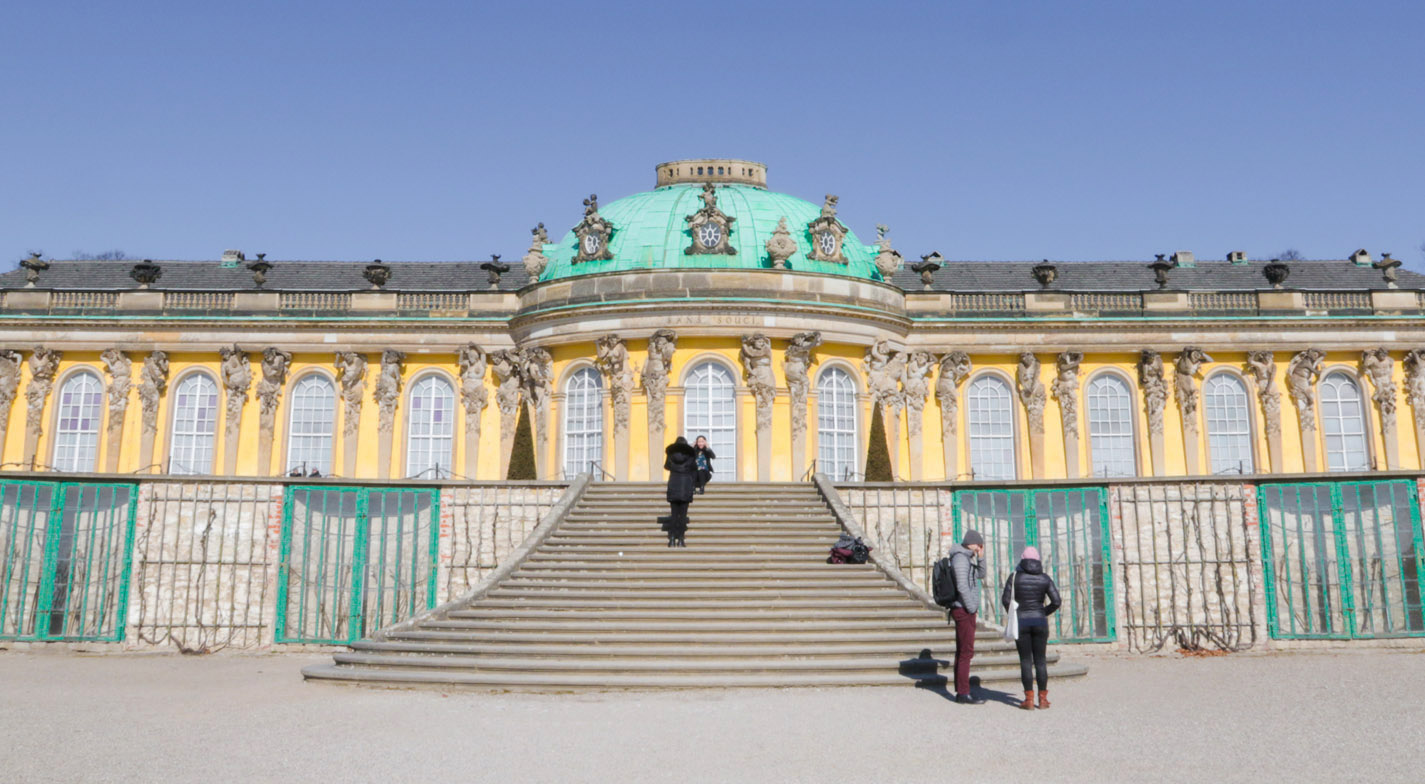
Roughly 40 minutes away from central Berlin, Potsdam is a quiet and beautiful town that’s one of Berlin’s most popular day trip spots.
When Berlin’s former mayor Klaus Wowereit described Berlin as “poor but sexy”, Potsdam authorities described their town “rich and beautiful”. True to form, Potsdam is home to quaint, Baroque buildings, scenic landscapes and 17 majestic palaces. We’d say stepping into Potsdam felt almost fairytale-like.
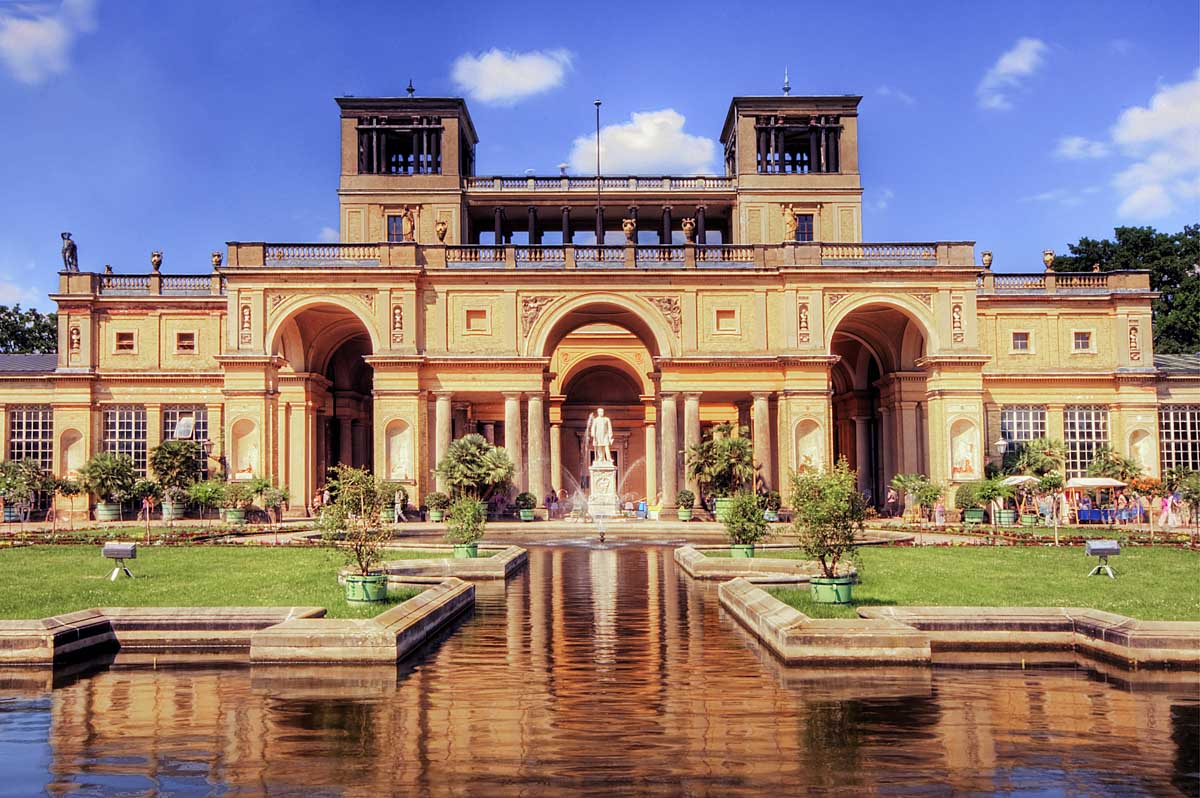
Potsdam is a favourite summer getaway with its spacious parks and clear lakes that make it perfect for cycling and picnics.
If you’re looking to escape from the bustle of Berlin city, this day trip to Potsdam is for you.
Read Also: 5-Day Budget Berlin Travel Guide
Potsdam Essentials
1) berlin welcomecard.
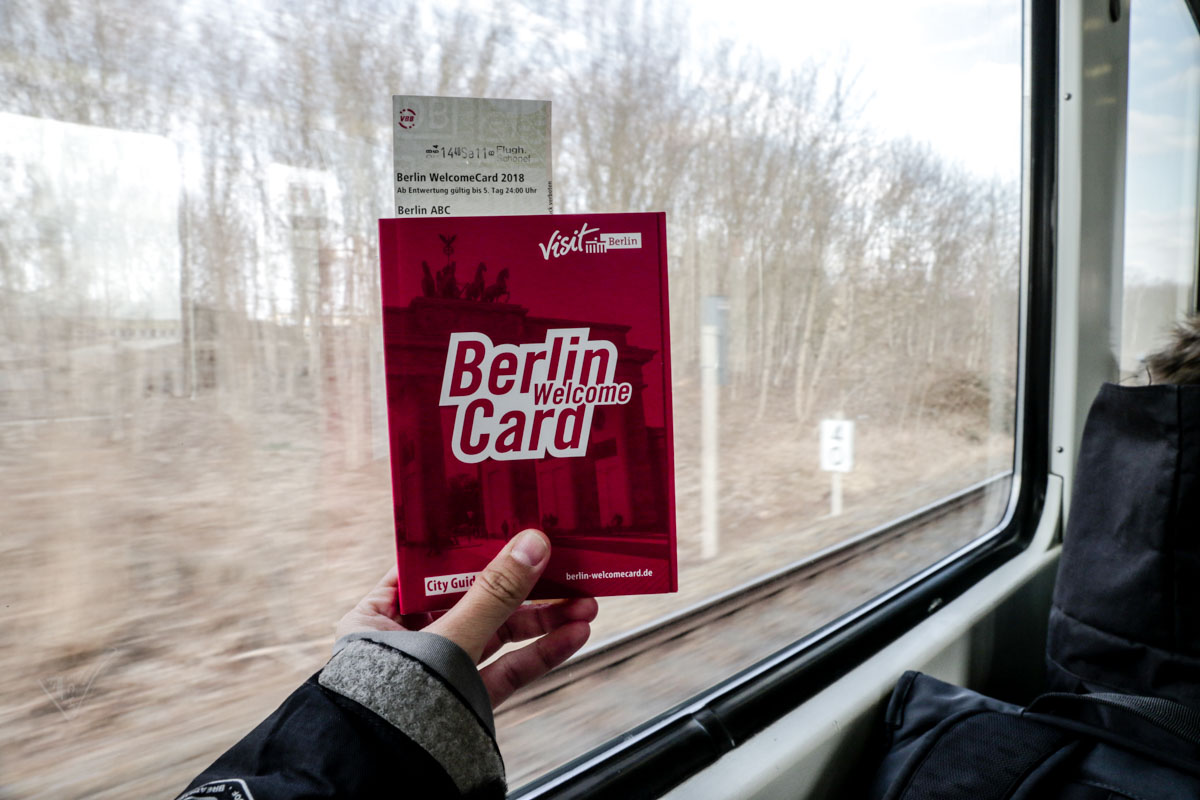
If you’re already travelling around Berlin with the Berlin WelcomeCard , getting to and around Potsdam is free as long as you purchase the Berlin + Potsdam ABC zones.
In addition, you’ll be eligible for discounts up to 25% selected tours, museums and bicycle rentals.
2) Sanssouci+ Ticket (optional)
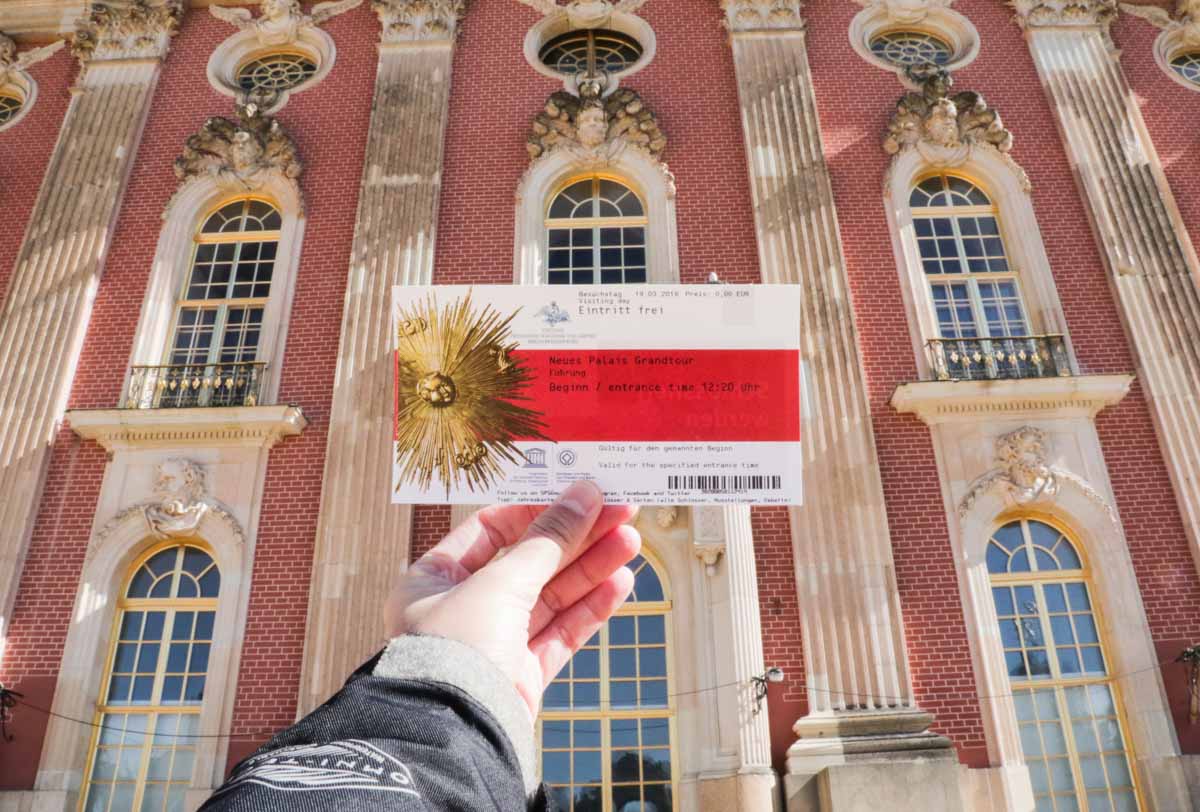
This Sanssouci one day pass (€19) grants you entry to most palaces and gardens in the Sanssouci area. You can purchase it online, or at the tourist information counter once you arrive at Potsdam Hauptbahnhof Station.
Most of the places do no need advanced bookings except for the Sanssouci Palace and New Palace.
*Pro-tip: Enjoy discounted rates for the Sanssouci pass (€15.20) by presenting your Berlin WelcomeCard when making your purchase.
Getting from Berlin to Potsdam
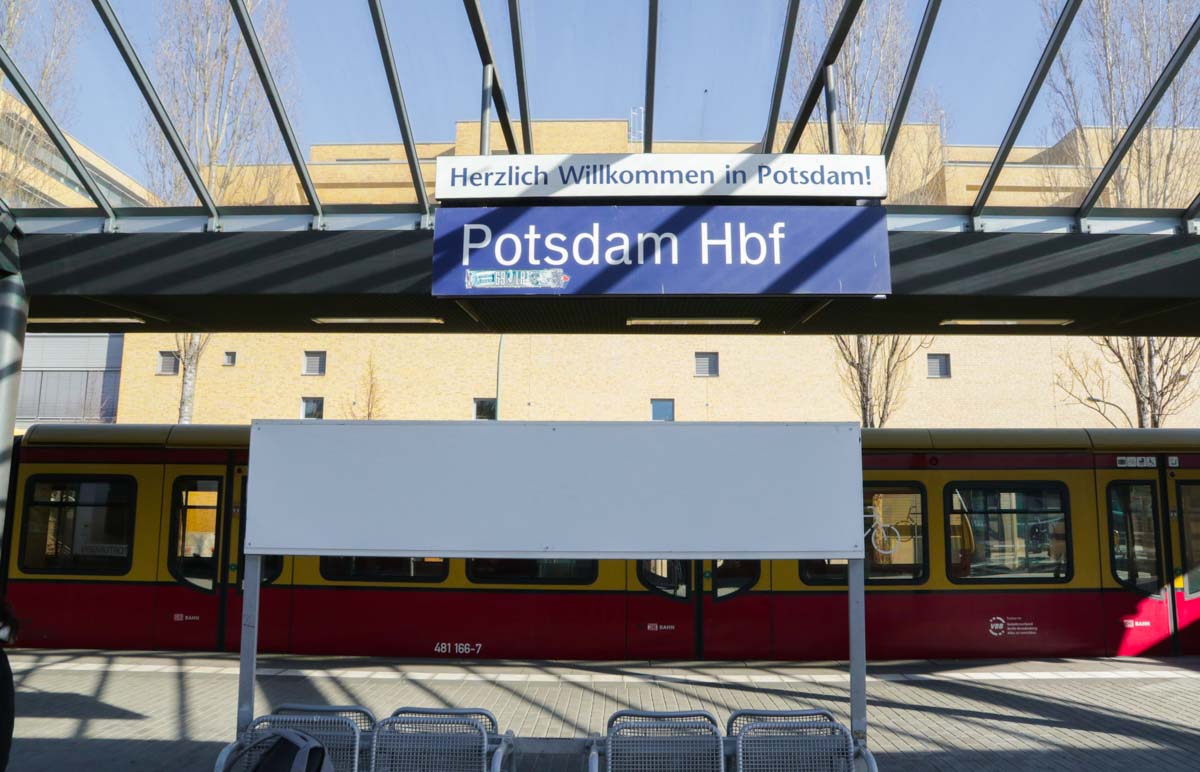
From Berlin Central Station (Berlin Hauptbahnhof), take the S-Bahn S7 train to Potsdam Hauptbahnhof, the terminal station. The journey takes 40 minutes, and arrives in 10 to 30-minute intervals.
Alternatively, you may also take the Regionalexpress RE1 train towards Brendenburg / Magdeburg, which takes slightly less time at about 25 minutes, but only arrives every 30 minutes.
Potsdam Day Trip Itinerary
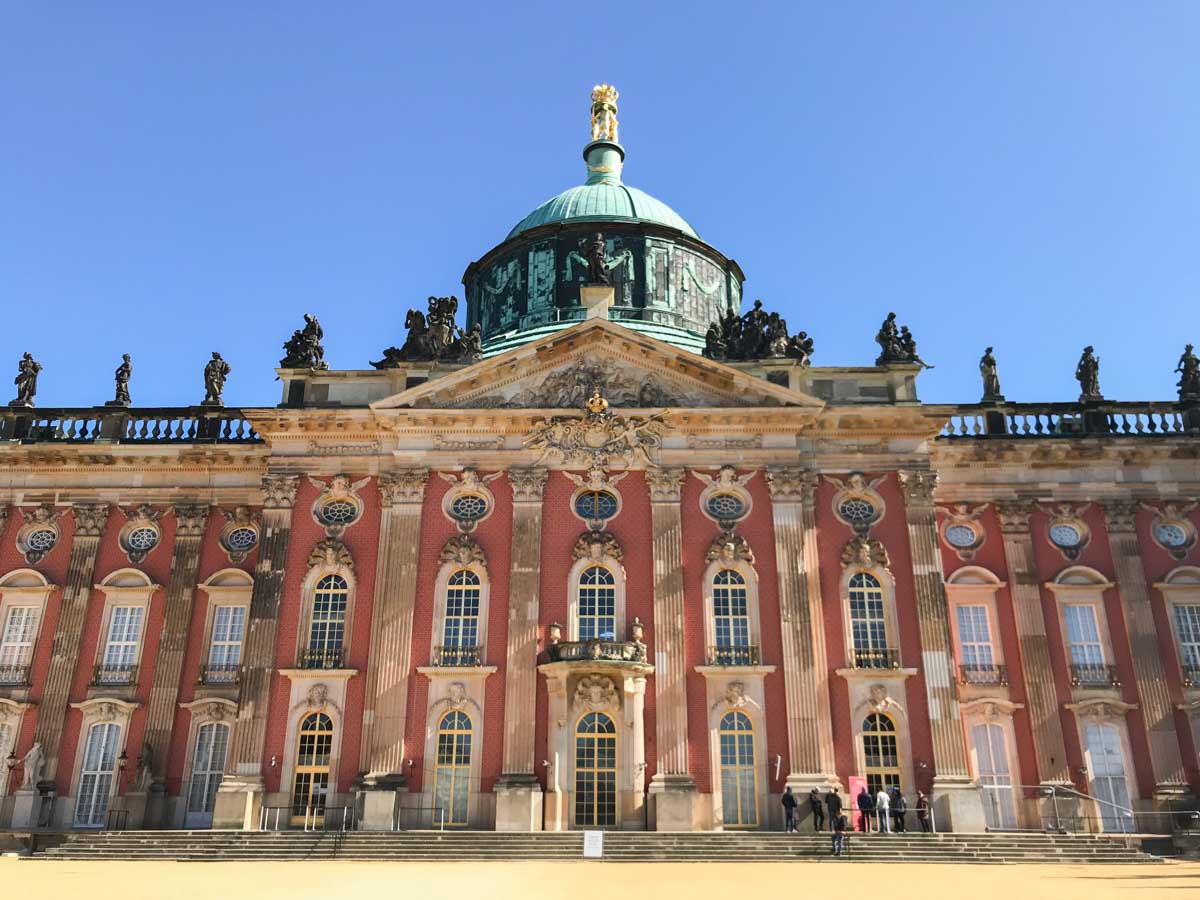
Getting Around: As the attractions are quite scattered, renting a bicycle for this is one of the best ways to get around with this itinerary. Bicycles can be rented straight from Potsdam Hauptbahnhof Station (Taxi Stand) from €1 per hour to €5 for the whole day ( prior registration required ), with 20 other designated drop-off points you can return them to.
Bicycle parking is free as long as you park them at designated racks around.
1) Filmmuseum Potsdam
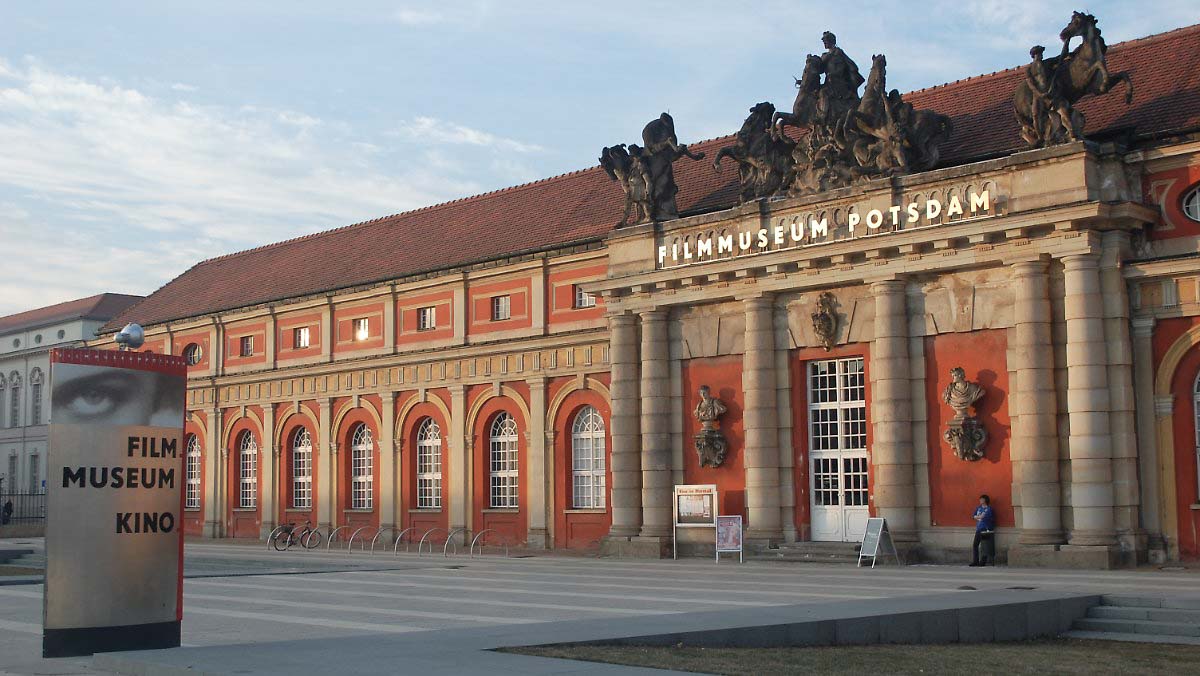
Only a short distance from the train station, enter Germany’s oldest film museum showcasing 100 years of film in Babelsberg in a permanent exhibition. They also house a special, seasonal exhibition along with a cinema that screens films at selected times (at additional cost).
Entrance Fees: €8 (~S$12.90) or €6 with the Berlin WelcomeCard (~S$9.65) Opening Hours: 10AM – 6PM, closed Mondays (Box office closes 5:30PM) How to get there: Cycle 850m from Potsdam Hauptbahnhof Station
2) Brandenburg Gate Potsdam
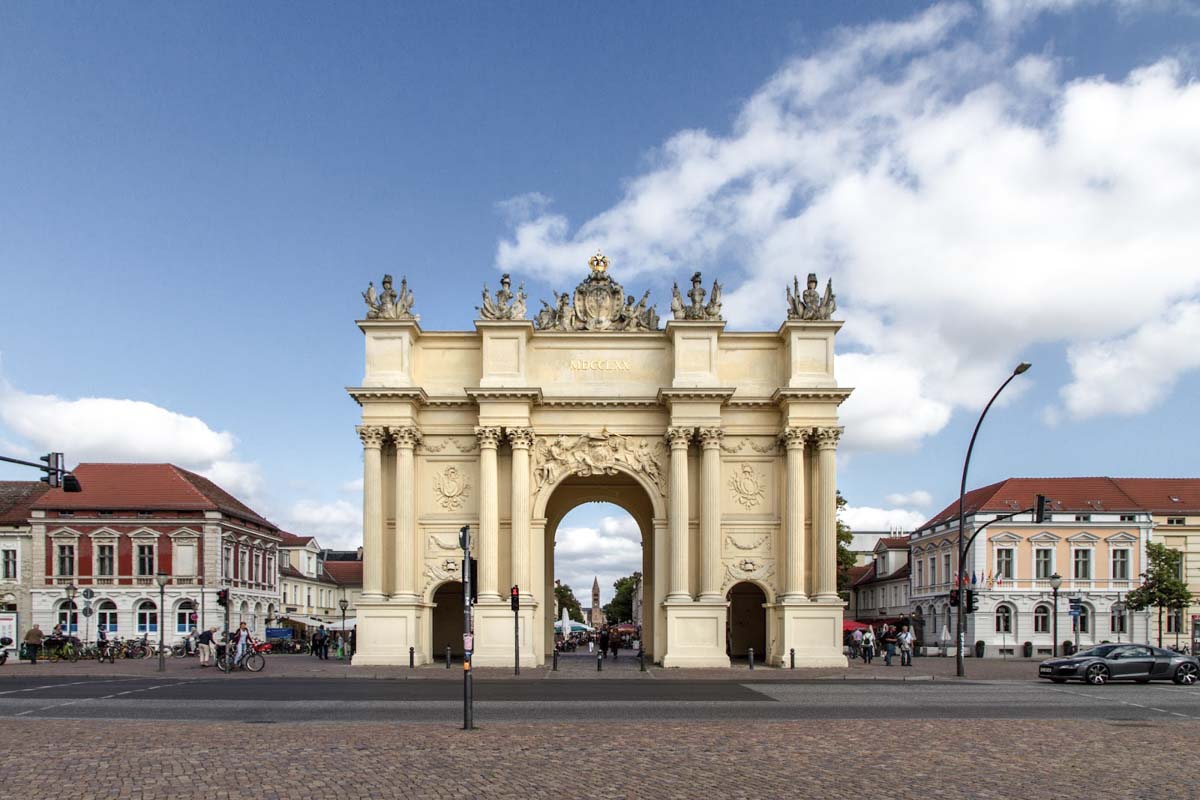
Don’t mistake this for a mini replica of the other Brandenburg Gate in Berlin — this is the OG gate that was first built; 20 years before its famous cousin.
How to get there: 1.1km cycle from Filmmuseum Potsdam
3) Sanssouci
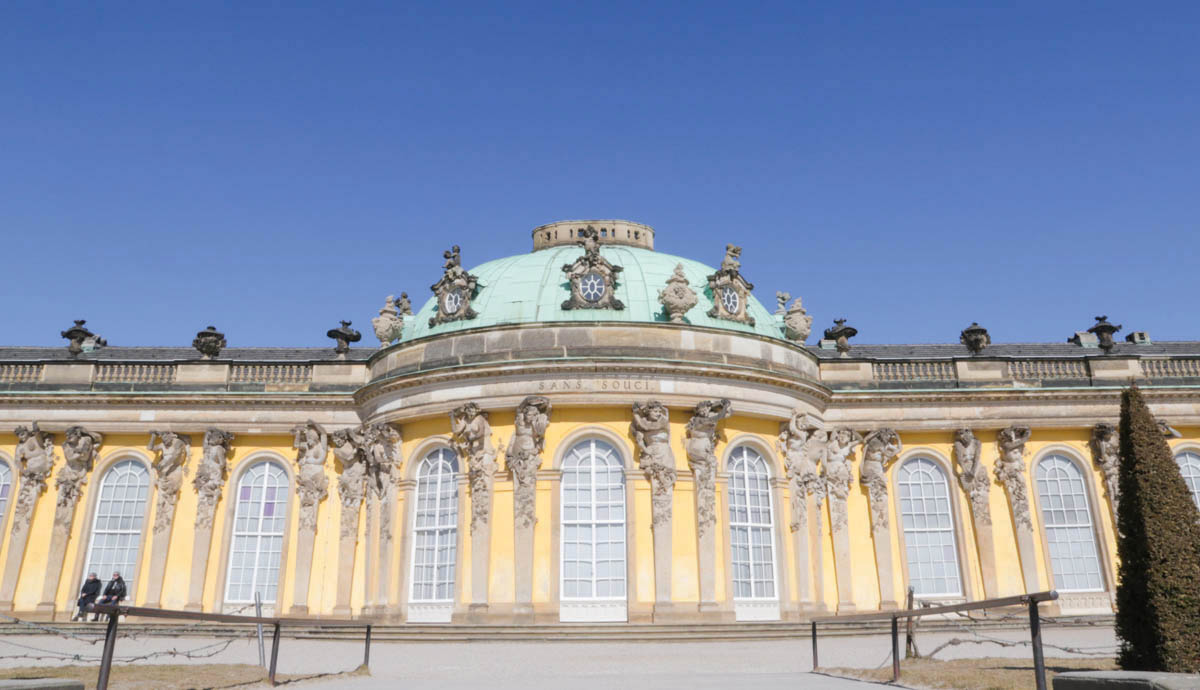
A garden spanning 300 hectares (roughly the size of 400 football fields), Sanssouci Park is where you can find the famed, rococo-style Sanssouci Palace that resembles a yellow wedding cake. The palace was the former King of Prussia’s favourite summer residence then, reportedly having spent 40 of his summers there during his lifetime.
An interesting feature here is, as you reach each base of the staircase, the palace disappears from your view, and gradually reappears as you reach the top of each flight.
Other places worth checking out are the Chinese House , Chinese House (requires reservation for guided tour to enter), Orangery Palace and Charlottenhof Palace .
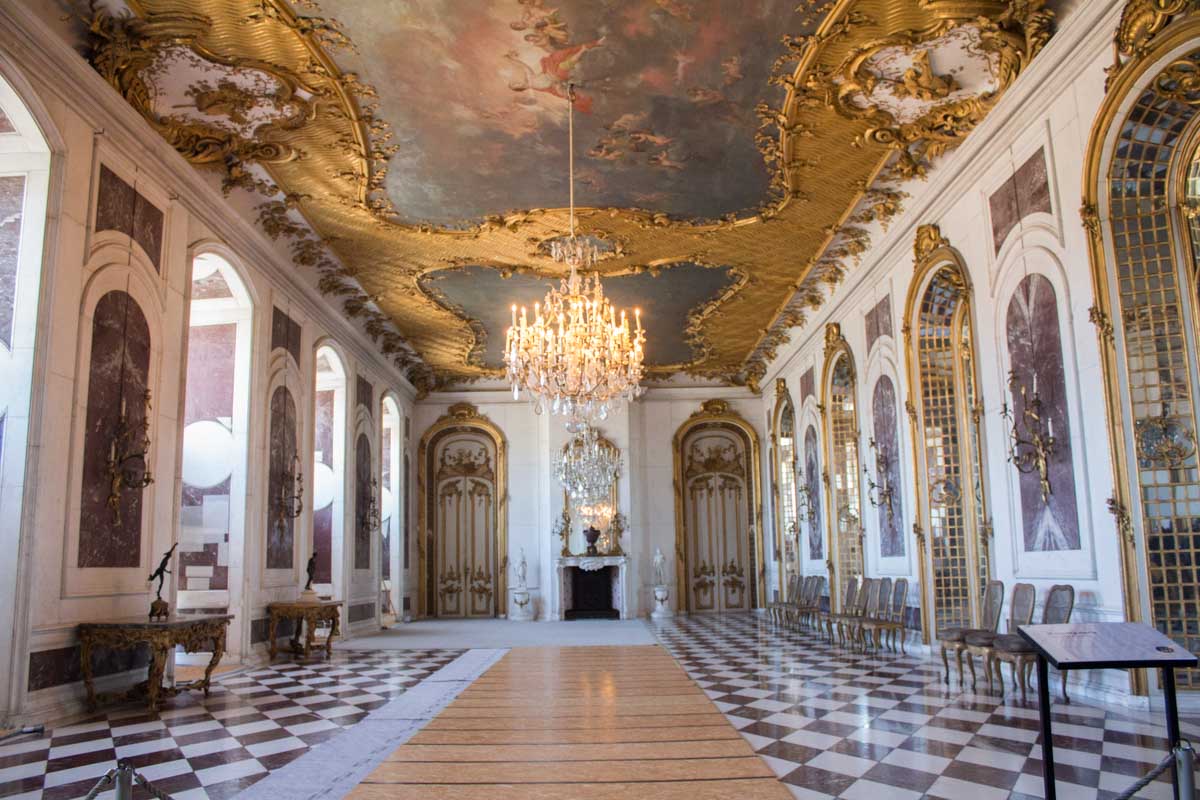
Cost: Free with sanssouci+ ticket Opening Hours: Varies Address (Sanssouci Palace): Maulbeerallee, 14469 Potsdam, Germany How to get there: 1km cycle from Brandenburg Gate
4) Dutch Quarter
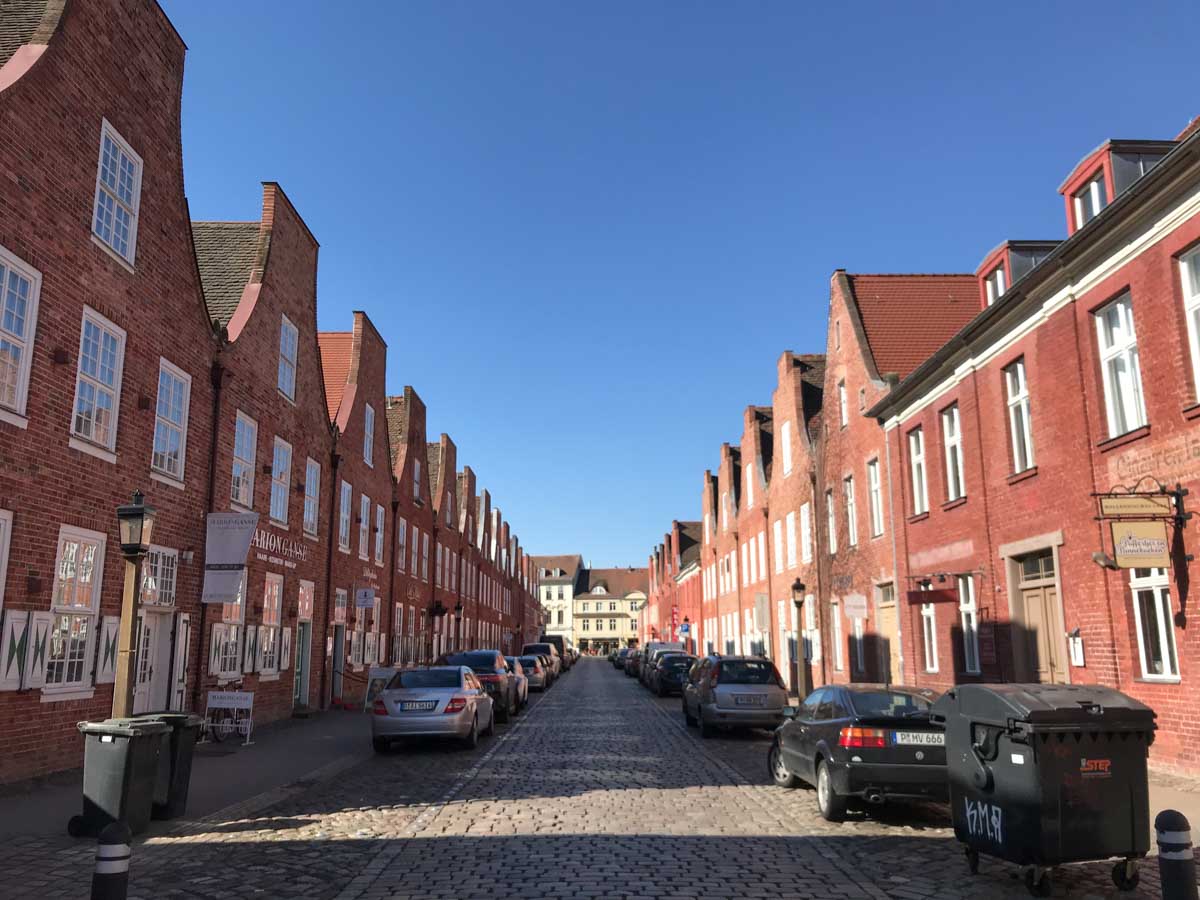
Experience Holland vibes with 134 brick houses built in the 18th century for Dutch immigrants. To date, this is the largest Dutch-only neighbourhood outside of the Netherlands! There are many antique and craft boutique shops, as well as restaurants, cafes and pubs to take a break at.
Address: Holländisches Viertel, Benkertstrasse, 14467 Potsdam, Germany How to get there: 1.8km from Sanssouci Palace — if you’re not walking or cycling, you can take Bus 695 from Sanssouci Palace (Potsdam, Schloss Sanssouci Station) to Potsdam, Jägertor/Justizzentrum Station, and walk/cycle the remaining 700m.
5) Babelsberg Park
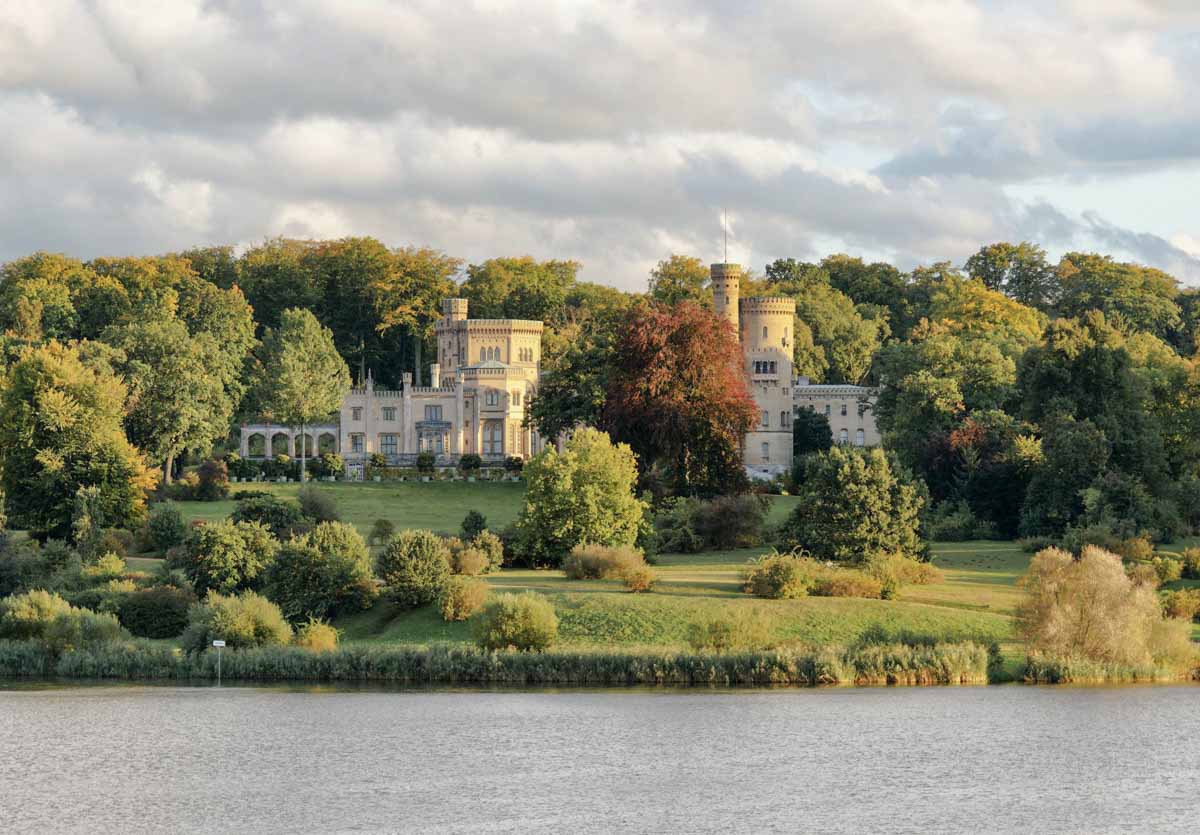
Several architects and landscape artists have left their mark on this 124-hectare park over a decade, resulting in a beautifully organised chaos upon completion. Here, it houses the neo Gothic-styled Babelsberg Palace and the Steam Engine Building that resembles a mosque, but was actually where the most powerful steam engine of the early 1840s sat.
A scenic, calming garden-park to relax and immerse in greenery, Babelsberg Park is a good vantage point to catch the sunset, and look at the famous Glienicke Bridge.
Opening Hours: 6AM – 7PM Address: Park Babelsberg 11, 14482 Potsdam How to get there: Cycle 4km from Dutch Quarter. For public transport: cycle 550m to Potsdam, Platz der Einheit/Nord Tram Station, take Tram 94/99 to Potsdam, Plantagenstrasse Station, then take Bus 616 to Potsdam, Sternwarte Station. You will arrive at Babelsberg Park after cycling another 550m.
6) Glienicke Bridge
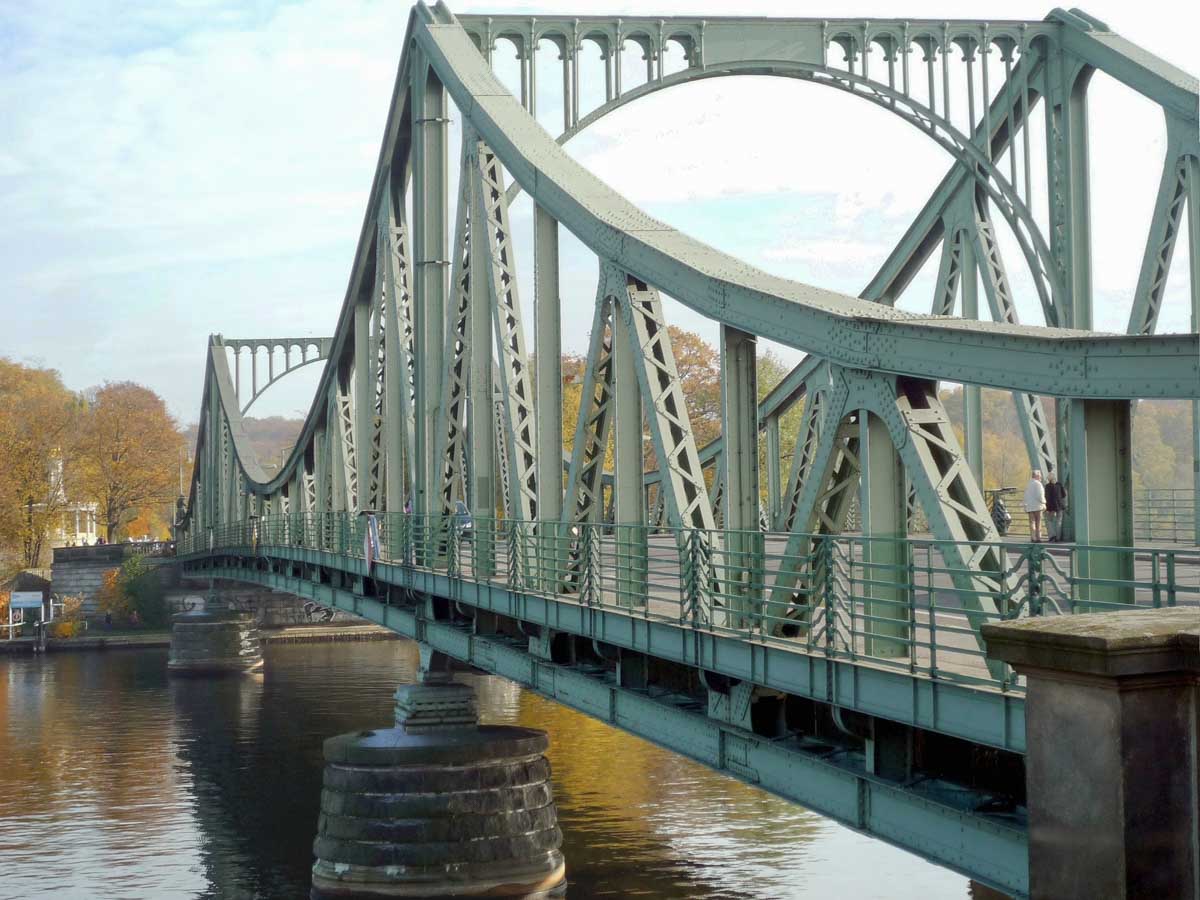
A bridge connecting Berlin’s Wannsee with Potsdam, it was once used to exchange captured spies between the Americans and Soviets during the Cold War. You might also recognise this bridge as it was featured in the 2015 film, Bridge of Spies.
Address: Glienicker Brücke, Königstraße, 14467 Berlin, Germany How to get there: Walk / Cycle 2.9km from Babelsberg Park
We hope you found this Potsdam Travel Guide useful! As an idyllic country retreat, we definitely think a day trip there from Berlin is worth it. If you’re up for someplace with even more nature, check out our Day Trip Guide to Spreewald !
Did we miss out on anything? Let us know in the comments!
For more travel inspiration, follow us on Facebook , Instagram , and YouTube .
A post shared by The Travel Intern (@thetravelintern) on Feb 22, 2018 at 7:31pm PST

RELATED ARTICLES MORE FROM AUTHOR

5 Budget Europe Itinerary Ideas under S$2.3k for Your Next European Adventure
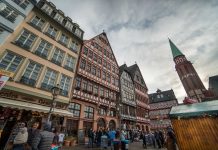
10D Germany Itinerary under S$1.1k — Gems in Munich, Düsseldorf, Cologne, Dortmund, Frankfurt
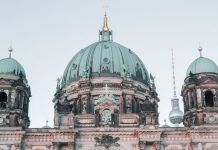
Berlin Photo Guide: 9 Spots Your Instagram Feed Should Have
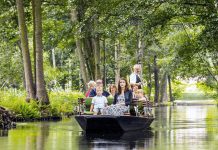
Spreewald Day Trip Guide — The Perfect Nature Escape 1 Hour Away From Berlin

Berlin’s Iconic Street Art: 10 Must-Visit Spots Great For Photos
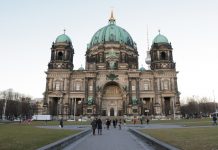
5-Day Berlin Budget Guide for less than S$600
Excellent post. The information you provided is useful to all of us. Keep on posting like this. Thanks for sharing. – shirdi flight package from chennai
LEAVE A REPLY Cancel reply
Save my name, email, and website in this browser for the next time I comment.
Singapore Travel Promos (26 Aug to 1 Sep 2024) — Deals,...

Family-friendly Johor Bahru Guide — 17 Things to Do, Eat and...

2D1N Desaru Itinerary — Exciting Things to Do on a Weekend Getaway...

9 Fun Things to Do in Iskandar Puteri, Less Than 30mins...

The Ultimate Guide to eSIM Cards When Travelling

- Terms Of Use
- Privacy Policy
What to Do on a Day Trip to Potsdam From Berlin
This post contains links which earn me a small commission at no cost to you.
Ali Garland, Berlin expert & long term resident What to Do
Are you planning a day trip to Potsdam from Berlin ? Potsdam is one of the most popular day trips from Berlin , not only because it’s nearby, but also because it is rich in culture and history.
It also makes for a nice change of scenery if you’re spending several days in Berlin. In this article you’ll find lots of practical tips for how to get to Potsdam from Berlin and what to see in Potsdam in a day .
What you'll find here
Book a tour for your day trip to Potsdam from Berlin
If you’re planning a day trip from Berlin to Potsdam, a tour can really help you make the most of your time. Consider one of these Potsdam tours.
- Tours of Berlin private Potsdam tour : This private tour of Potsdam is led by a local Rick Steves guide and is a great way to see the sights with just your family or group. Tell Matti you heard about his tours from Berlin Travel Tips!
- Discover Potsdam : A half day walking tour of Potsdam from Berlin
- Potsdam Sanssouci Palace : A guided tour from Berlin including bus transport
- Potsdam Bike Tour : Tour Potsdam by bike with rail transport from Berlin
Why should you do a Potsdam day trip from Berlin?
I wouldn’t suggest any day trips if you’re only spending a few days in Berlin since there’s so much to see in the city. But if you have a longer trip, probably more than 3 days in Berlin , a day trip might be just the thing.
So why Potsdam? Well, it’s gorgeous for one thing. But let’s get into the specifics.

The town is significant from a historical perspective and worth visiting if you’re a WWII or Cold War buff.
Potsdam was the location of the Potsdam Conference in 1945, which was held shortly after the official end of World War II . It’s where the leaders of the USA, the UK, and the Soviet Union met to work out all the details of dealing with Germany after the war.
Mostly a day trip to Potsdam includes visiting the many castles and palaces and their elaborate adjoining gardens.
In fact, the Palaces and Parks of Potsdam and Berlin is one of Berlin’s 3 UNESCO World Heritage sites , and though some pieces are in Berlin, most are in Potsdam. Sanssouci Palace is the most famous palace in Potsdam, but trust me, you’ll be impressed by the others too.
The town of Potsdam is also worth spending time in. The Old Town and Dutch Quarters are charming areas to explore with several monuments, old city gates, and museums.
Hotels in Potsdam, Germany
Potsdam makes for a wonderful day trip from Berlin. But there is a lot to see here! If you want to explore more of the city, the parks, and the palaces, it might be worth booking a hotel in Potsdam and staying for a few days.
Where to stay in Potsdam
How far is potsdam from berlin.
Potsdam is located southwest of Berlin in the state of Brandenburg. It is roughly 35 km (a bit less than 21 miles) from Berlin Hbf to Potsdam.

This means it doesn’t take long to get to Potsdam, and you won’t lose too much of your day to transport.
You could drive to Potsdam from Berlin. But Berlin has such great public transport , and it could actually take longer to drive.
For this reason, I don’t think it’s worth it. Driving could take 35 minutes to well over an hour if there’s traffic, plus you’d have to figure out where to park.
Instead I recommend taking the train from Berlin to Potsdam. Here’s how to do it.
How to get from Berlin to Potsdam by train
There are two options to get from Berlin to Potsdam by train. You can either take the regional train or the Sbahn, but they’re both pretty similar.
The regional train is a little faster, but depending on where you’re staying in Berlin , the Sbahn might be easier. It also depends on which Potsdam train station you want to arrive at.
Another great option is to book a tour like this one that takes you from Berlin to Potsdam. You’ll still take the train (either the regional train or the Sbahn) but you’ll have a guide who will explain everything and tell you all about the history of the palaces and other sights in Potsdam.

>>Read: 101 Fun and Essential Things to do in Berlin
Option 1: Regional train from Berlin to Potsdam
Taking the regional train is the best option in most cases because it will take you from Berlin Hbf to Potsdam Hbf in just 25 minutes. The regional train also makes fewer stops than the Sbahn.
Look for RE1 going towards Brandenburg Hbf. This route stops at Potsdam Hbf, which is the closest station to the old town. This is a good station to get out at if you are starting your Potsdam day trip in the old town and Dutch Quarter.
Otherwise, if you prefer to start with the palaces, stay on the train for one more stop and get out at Potsdam Charlottenhof, or two more stops and get out at Park Sanssouci Potsdam. This will get you close to the park and palace and save you some walking time.
Note: Not all RE1 train routes are exactly the same. The one that goes to Magdeburg as the end station stops in Potsdam Hbf but it does not stop in any of the secondary Potsdam train stations.
So you can take that one, but you’ll either have to walk from Potsdam Hbf to Sanssouci Palace, or you’ll have to switch to another train (RB21, RB 22, or RB23).
The RE1 going to Brandenburg Hbf runs once an hour, so plan accordingly. But if that timing doesn’t work out for you, switching to a different train at the Potsdam station shouldn’t be a big deal.
Where else can you get the RE1 from Berlin to Potsdam? The RE1 runs through several stations within Berlin, such as Alexanderplatz, Zoologischer Garten, and Ostkreuz, among others. To decide which train station in Berlin you should use , check which one is closest to where you’re staying so you don’t waste time getting to Potsdam.

Option 2: Sbahn from Berlin to Potsdam
You could take the Sbahn to Potsdam, but it will take about 10 minutes longer. From Berlin Hbf to Potsdam Hbf it takes about 35 minutes instead of 25 minutes. The Sbahn also makes more stops along the way.
If you decide to take the Sbahn to Potsdam, you will need the S7 going towards Potsdam Hbf.
Also note that the Sbahn does not go to Park Sanssouci Potsdam Bahnhof. So if you want to go to that station, you will need to switch to the RB20, RB21, or RB22 for an additional 5 minutes.
The Sbahn might be a good option depending on where you’re staying and where the closest Ubahn or Sbahn station is to your hotel. It might also work out that a slightly longer ride still gets you there earlier than waiting until the next regional train.
Schedules and tickets
You can check train schedules on the Deutsche Bahn website . But they can’t actually sell you tickets for this route because the local transport organization handles shorter routes like this.

Instead you’ll need to buy tickets at a ticket machine or through one of the transport apps.
I highly recommend downloading either the BVG Fahrinfo app or the VBB Bus & Bahn app. These will show you routes and schedules in Berlin and the nearby areas in Brandenburg. And you can buy transport tickets in either app.
Potsdam is in zone C, so you’ll need a ticket that covers zones ABC in order to get from central Berlin to Potsdam. Your best option is most likely going to be a 24 hour ticket for zones ABC.
For more details, read my full guide on how to get to Potsdam from Berlin .

Things to see in Potsdam on a day trip
Potsdam really is a charming town filled with gorgeous sights and interesting history. There are plenty of things to see in Potsdam on a day trip from Berlin .
In fact, you probably won’t have time to see everything in Potsdam in a day , but if you want to spend one day in Potsdam , you won’t be bored.
Sanssouci Palace and Park
This is the most well known palace in Potsdam. It was built in the mid 1700s for Frederick the Great, King of Prussia, and it served as his summer palace.

Sanssouci is often compared to Versailles in France, though it is smaller. This Rococo palace now sees more than 2 million people a year.
The park that surrounds the palace is also a gorgeous sight to see. The palace sits at the top of a terraced vineyard, and at the bottom of this hill is the Great Fountain. Throughout the park, you’ll see flower beds, various statues, and more fountains.

Join our Facebook group!
Have questions about planning your trip to Berlin?
Join the Facebook group here to chat with Ali (she runs this site) and other people who have been to Berlin for tips.
New Chambers of Sanssouci
Part of the same palace complex, the New Chambers of Sanssouci was built as a guest house for close friends of the king when they were visiting. To show how important his guests were to him, these chambers were lavishly designed.
Historic Mill of Sanssouci

Dozens of windmills once stood in Potsdam, but only this one remains, though it has been rebuilt several times. Once again, the mill processes grain, and you can buy bread that was baked with Sanssouci flour in the gift shop.
Chinese House

Frederick II enjoyed thinking of faraway lands, and he had the Chinese House built to accent his garden. Golden life-sized figures are place around the outside of the building, and paintings on the ceiling were designed to depict Chinese society.
Orangery Palace
King Frederick William IV loved Italy and Italian architecture, and he had the Orangery Palace built in the mid 1800s with inspiration from several well known Italian buildings.
The palace has an impressive wing of copies of Raphael paintings, a large plant hall, and towers you can climb for views of the whole park.
Charlottenhof Palace
Charlottenhog Palace, or Charlottenhof Villa, was the summer residence of Crown Prince Frederick William, who later became King Frederick William IV. He had the architect remodel a farmhouse into the neo-classical villa you see today.
The interiors of the palace have remained mostly the same over the years. The surrounding land was redesigned into an English garden and connected into Sanssouci Park.

Roughly 20 years after Frederick the Great had Sanssouci Palace built, he had the New Palace built in stark contrast.
Where Sanssouci is more modest, the New Palace is more elaborate. It has over 200 rooms and was primarily used for hosting events and receiving important guests, such as royalty and dignitaries.
The palace is located at the end of a long pathway and is an impressive part of Sanssouci Park.
Babelsberg Palace and Park
Babelsberg Palace and Park were built for Prince William of Prussia and his wife Princess Augusta of Saxony-Weimar in an English neo-Gothic style. It served as their summer residence for more than 50 years.

Though it was looted after WWII and the furniture lost, the facade has recently been renovated, and the fountains, which hadn’t functioned in over 100 years, have been fixed and are working again.
It’s mostly only open for special events, but it’s still an impressive palace to see from the outside. Plus it’s in a completely different area than most of the other palaces, so the grounds are generally less crowded.
This garden is located in the northern section of Potsdam near the Heiliger See and the Jungfernsee lakes. It was designed in the English garden style for Frederick William II in the late 1700s.
Here you’ll find Cecilienhof Palace, Marble Palace, and several other buildings and sights.
Cecilienhof Palace

Built from 1914 to 1917 in the style of an English Tudor manor house, Cecilienhof Palace was the last palace built by the Hohenzollern family. They were the family who ruled the Kingdom of Prussia and German Empire until the end of World War I.
Cecilienhof Palace is also famous for being the location of the Potsdam conference, which took place after the end of World War II. This is when the Allies met to discuss and decide how to handle post war Europe and Asia.
Read more about Cold War sites to see in Berlin .
Marble Palace
The Marble Palace sits on the shores of the Heiliger See (lake) and is a former royal residence of Frederick William II of Prussia. The facade is made of marble, hence the name.
Under Soviet rule, the palace served as a military museum until 1972. Today it’s a popular attraction in the New Garden and offers great views of mansions across the lake.
Belvedere Pfinstberg
The Belvedere Pfinstberg pleasure palace was built on Potsdam’s highest elevation for Frederick William IV in the mid 1800s, though he did not live to see it finished. His brother Wilhelm I had a modified version completed several years later.
Today this hilltop palace makes for excellent views over Potsdam, and you can even see Berlin in the distance.
Brandenburger Tor

Don’t confuse this with the more famous Brandenburg Gate in Berlin ! The one in Potsdam is actually older than its Berlin counterpart.
It lies at the western end of Brandenburger Str. Each side was designed by a different architect, so you’ll see a city-facing side and a countryside-facing side.
The oldest of the remaining city gates in Potsdam is Jägertor. The top of the gate shows hunting dogs taking down a deer as this was the way to go to get to the former royal hunting grounds north of the city.
Nauener Tor

Nauener Tor is located near the Dutch Quarter of Potsdam near lots of shops and cafes.
A promenade connects it with the other two remaining city gates where city walls once stood. Today a tram runs through the gate.
Museum Barberini
Opened only a few years ago, the Museum Barberini displays impressionist paintings. Though the museum is fairly new, the building is a reconstructed former palace on the Old Market Square.
Want more museums? In Potsdam, you’ll also find a film museum, a museum of natural history, a museum of Prussian history, a museum of art and history, and more!
The Neue Markt is one of the best-preserved Baroque squares in Europe, and one of the prettiest in Potsdam. Most of the buildings date back to the 18th century.
You’ll find the Museum of Brandenburg and Prussian History and the Potsdam City Palace Royal Stables, which houses the Film Museum, on this square.
St. Nicholas’ Church

One of the many pretty churches in town, the St. Nicholas’ Church has a viewing platform that will give you a great look at Potsdam from above.
Other notable churches to check out include the Church of Peace on the edge of Sanssouci Park and the St. Paul and St. Peter Church at the eastern end of Brandenburger Str.
Dutch Quarter
In Potsdam’s historical area, go for a stroll in the Dutch Quarter. This is considered the biggest collection of Dutch-style houses outside of the Netherlands.
They were built for Dutch immigrants in the mid 1700s, and today you’ll find cafes with Dutch food, shops, galleries, and a couple of museums.
Glienicke Bridge

This famous bridge once separated West Berlin from Potsdam in East Germany. The bridge was closed to civilians, and it became used for exchanging spies and agents during the Cold War.
The movie “Bridge of Spies” with Tom Hanks was about this very bridge and was filmed there.
Book a tour for your trip to Berlin
- Private Tours of Berlin with Matti : As a lifetime Berlin resident and local Rick Steves guide, Matti really knows Berlin. Tell him you heard about his tours from Berlin Travel Tips!
- Third Reich Berlin Walking Tour – Hitler and WWII : Learn about Berlin’s WWII history with an expert guide.
- Berlin TV Tower Skip-the-Line Ticket : Offering some of Berlin’s best views.
- Discover Berlin Half-Day Walking Tour : See Berlin’s highlights with a knowledgeable tour guide.
Berlin Travel Resources
I want you to have the best trip to Berlin, and hopefully this information for how to take a Potsdam day trip from Berlin helps. But there are lots more tips on the site!
- 101 Best Things to do in Berlin
- 23 Impressive Castles in Berlin (And Nearby)
- 27 Best World War II & Cold War Sights in Berlin
- 29 Fun Day Trips From Berlin
- 75 Things to Know Before Visiting Berlin: Essential Berlin Travel Tips
- What to Wear & What to Pack for Berlin, Germany: Your Ultimate Berlin Packing List
- How to Get Around in Berlin: An Easy Guide to Berlin Public Transportation
Check out my favorite travel planning sites and resources
These are the sites I like for travel planning, plus items I like to travel with.
Planning Booking.com : Find a Berlin hotel here.
Rick Steves and Lonely Planet : My favorite guidebook resources.
Tours, Activities, Tickets Viator : Great site for finding tours and other activities.
GetYourGuide : Another good option for tours and activities.
Transport Welcome Pickups : No stress option for airport pickups.
Discover Cars : Find a rental car for Germany road trips.
Deutsche Bahn and FlixBus : Best options for getting around Germany.
Packing Orange SIM & eSIM : Great option for SIM & eSIM cards for German & EU.
Collapsible water bottle , plug adapter , and stuff bag : Small things that will make your trip a little easier.
Packing Orange SIM & eSIM : Great option for SIM & eSIM cards for Germany & EU.
Book a local photographer Flytographer : Hire an amazing local photographer anywhere in the world.

Related Posts

Berlin Christmas Markets Itinerary: How to Combine Markets & Sightseeing

What to do in Berlin on Monday: 25+ Museums & More

What to do in Berlin on Sunday: 15+ Ideas
This was super helpful, I’m going to Berlin in March! Thank you!
Glad to help!
Uber helpful! I shall definitely visit Potsdam when I’m there in August.
Please advise if it’s possible to buy a day trip in person at a tourist information/sales office rather than in advance over the Internet. I’m reluctant to book and pay so many months in advance as things could change given factors such as mood on the day, prevailing weather, being tired from the previous day’s travels/outings etc. etc.
I would like to able to decide a day or two before – on a day trip – and head out to buy a tour ticket and join the group, which I’m aware will be affected by availability etc. However, given that I will have 2 weeks in Berlin, I’ll be able to plan around such factors.
I look forward to your advice, Ali. Thank you.
Hi Deon, it’s probably possible to book a tour or day trip in person, but I haven’t done it in many, many years, and not in Berlin. I’m pretty used to booking everything online these days, so I’m not sure how to go about it in person. If you know of a particular tour company you want to use, you can email them and ask how likely it is to book last minute. I’m sure it also depends on what time of year since summer is busy but November, for example, is a slow period. And since you have a good amount of time here, you could look at the availability for the next few days and decide based on that.
Leave a Reply Cancel reply
Your email address will not be published. Required fields are marked *
Save my name, email, and website in this browser for the next time I comment.
This site uses Akismet to reduce spam. Learn how your comment data is processed .

Germany Travel Guide
Potsdam Germany: 1-day Itinerary and Map
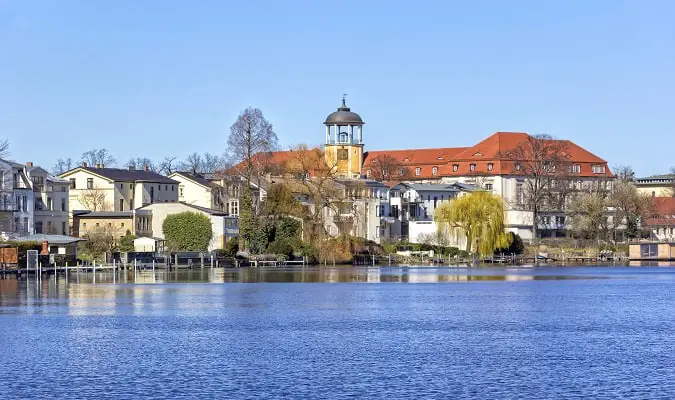
Potsdam is the state capital of Brandenburg , Germany located near the city of Berlin in an area of beautiful forests and lakes. This former residence of Prussian rulers is filled with palaces and gardens.
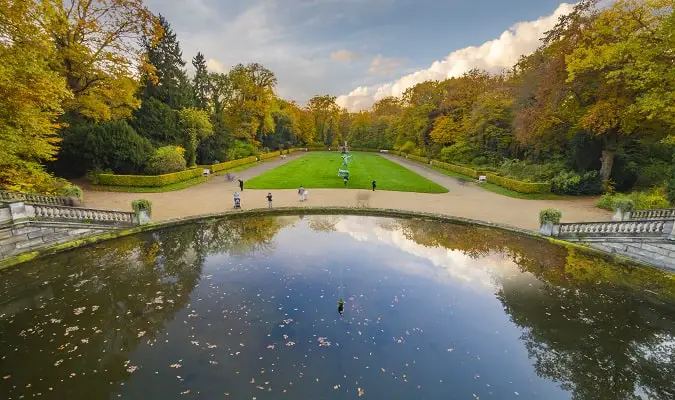
How to spend 1 day in Potsdam Germany
In this 1-day itinerary in Potsdam , discover the main attractions of the city.
Day 1 in Potsdam
The main attraction of Potsdam is Sanssouci Park , where you will find palaces, gardens. In the park, start by visiting the New Palace , head to the Chinese House , pass by the Orangerieschloss and head to the beautiful Sanssouci Palace , visit its interior and enjoy the view from the garden.
Schloss Cecilienhof is another attraction in the city, located 3.2 km (2 miles) from Sanssouci Palace .
Things to see
- Neues Palais Potsdam
- Chinese House in Sanssouci Park
- Orangerieschloss
- Sanssouci Palace
- Neptungrotte
- Brandenburg Gate Potsdam
- Schloss Cecilienhof
Day 1 Itinerary Map
Sights in Potsdam
1. sanssouci park.
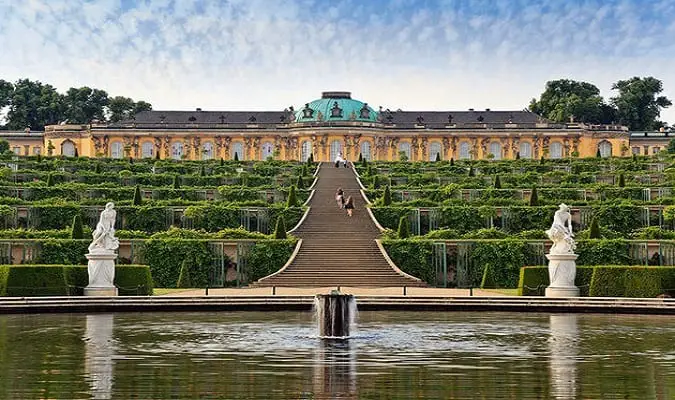
The Sanssouci Park is a large park surrounding the Sanssouci Palace .
The park has numerous attractions such as the New Palace of Sanssouci , the Chinese House , the Ancient Temple , the Temple of Friendship , The Neptungrotte .
Zur Historischen Mühle 1, 14469
2. Cecilienhof
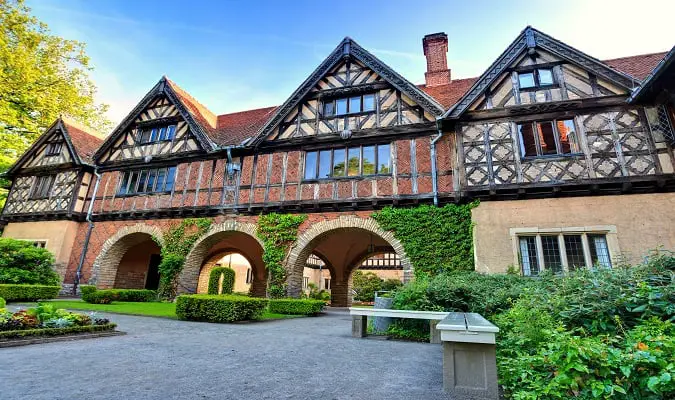
The Cecilienhof Palace was built between 1914 and 1917 for Prince William and his wife Cecilie.
At the site, the winning powers of World War II, Churchill Trumann, and Stalin wrote history. Today the castle is a historic memorial in which the conference rooms can be visited.
Im Neuen Garten 11, 14469
3. Russische Kolonie Alexandrowka
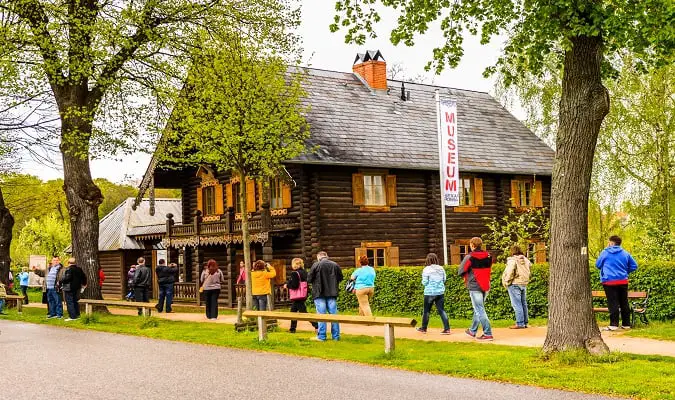
Frederick William III and Czar Alexander were close friends. To give expression to this friendship Frederick III built the Russische Kolonie Alexandrowka .
Russische Kolonie 2, 14469
4. Babelsberg Palace
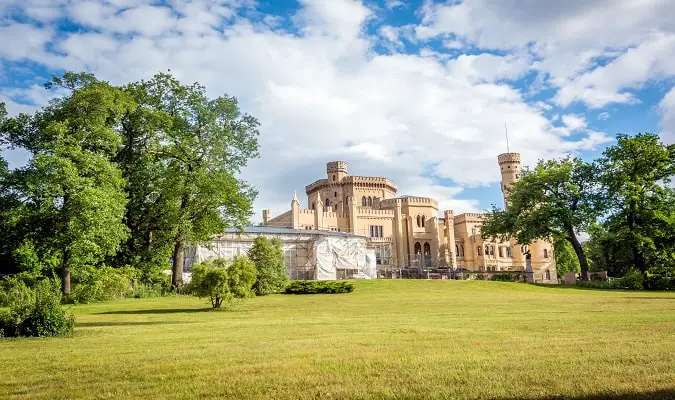
The Babelsberg Palace was built in 1833. From 1871 the palace was the summer residence for Prince William.
It is closed for visits due to restoration. Only the park can be visited.
Park Babelsberg 10, 14482
Where to stay in Potsdam
1. mercure hotel potsdam city.
The Mercure Hotel Potsdam City is located near the Central Station and 2.6 km (1.6 miles) from the Sanssouci Park
Rooms are equipped with a flat-screen TV and a minibar.
Lange Brücke, 14467
2. NH Potsdam
Located in the center of Potsdam , NH Potsdam offers excellent value for money.
The rooms are cozy and have a TV, desk, and minibar
The hotel has a gym and a sauna.
Friedrich-Ebert-Straße 88, 14467
3. Steigenberger Hotel Sanssouci
The Steigenberger Hotel Sanssouci is located 1.3 km (0.8 miles) from the Sanssouci Park .
Rooms are equipped with a flat-screen TV, minibar, safe.
Allee nach Sanssouci 1, 14471
4. Hotel Am Jägertor
Hotel Am Jägertor is an elegant hotel located in the city center opposite the historic Jägertor Potsdam Gate .
Rooms have a seating area, work desk, and TV.
The hotel has a bar and a terrace.
Hegelallee 11, 14467 Potsdam, Germany
5. INSELHOTEL Potsdam
INSELHOTEL Potsdam is located beside Lake Templiner See on Hermannswerder Island , 2.8 km (1.8 miles) from the city center.
All rooms have a TV, work desk and minibar. Some rooms have a balcony or a terrace.
The hotel has an indoor pool, an outdoor pool, and a spa.
Hermannswerder 30, 14473 Potsdam, Germany
6. Seminaris Hotel Potsdam Griebnitzsee
Located on the banks of the Griebnitz See in Babelsberg , 6.8 km (4.2 miles) from the Potsdam city center , Seminaris Hotel Potsdam offers quiet and comfortable rooms.
Rooms have a small seating area, TV, and minibar. Some rooms offer lake views.
The hotel has a restaurant that serves seasonal German and international dishes.
Rudolf-Breitscheid-Straße 190, 14482 Potsdam, Germany
7. Hotel Brandenburger Tor Potsdam
The Brandenburger Tor Potsdam Hotel is located right in the heart of the city next to Potsdam’s Brandenburg Gate .
All rooms have a flat-screen TV, work desk and minibar.
The hotel has a terrace where you can enjoy delicious drinks.
Brandenburger Str. 1, 14467 Potsdam, Germany
8. Waveboard
Waveboard is an aparthotel located beside the Tiefer See lake , a 20-minute walk from the center of Potsdam .
The apartments are modern and equipped with a full kitchen. Some rooms offer a view of the lake.
Schiffbauergasse 13, 14467 Potsdam, Germany
Shopping in Potsdam
1. karstadt potsdam.
Karstadt is a German department store chain with many stores in Germany .
The company features brands like Cacharel, Clarins, Coach, Desigual, Estée Lauder.
Brandenburger Str. 49/52, 14467
2. Stern Center Potsdam
The Stern Center Potsdam is located 5.9 km (3.7 miles) from the Central Station .
Brands: Deichmann Schuhe, Camp David, Tom Tailor.
Stern-Center 1-10, 14480
Plan your Trip
Potsdam has easy train access from Berlin .
Berlin – 35.8 km (22.2 miles)
Lübeck – 279 km (173 miles)
Schwerin – 205 km (128 miles)
Bremen – 364 km (226 miles)
Dresden – 203 km (126 miles)
Leipzig – 160 km (99.5 miles)
Book a Train Trip
Potsdam Germany Map
Book your trip, book your accommodation.
Book your hotel with Booking.com as they consistently provide the cheapest and lowest rates.
Book Your Flight
Find cheap flights to Germany by using Momondo . Momondo is a flight search engine that searches a lot of different airlines, including many budget carriers.
Book a Train Ticket
Check the train routes and schedules with Omio . Omio is an authorized Deutsche Bahn ticket seller, which compares and combines transport options for complete flexibility.
Don’t Forget Travel Insurance
Travel insurance will protect you against illness, injury, and cancellations. It’s a protection in case anything goes wrong. You can book your travel insurance with Travelexinsurance.com .
Train from Berlin to Potsdam: Travel Tips & Guide
10 Reasons to Visit Berlin
10 Best Hotels in Mitte Berlin
10 Suggested Itineraries for Germany + Top Destinations
Outlets & Department Stores in Germany: Shopping Guide
40 Popular Train Routes in Germany
German States Map
German States and Regions

Day Trip from Berlin to Potsdam, Germany: The Best Things To Do In Potsdam
Potsdam, Germany is just a short 30 minutes train ride from Berlin, making it the perfect day trip for everyone. The train runs from early in the morning until after midnight, giving you a complete day in Potsdam.
Potsdam was the historic residence of the Prussian kings and is now home to many UNESCO World Sites due to its diverse culture and architecture.
Read on to see how you can enjoy all that Potsdam has to offer in our 14km walking travel guide. If you would like to visit the many museums of the city, we suggest giving yourself two days in the city.
➳ Read More: The Best 5 day itinerary to see Berlin
How to get from Berlin to Potsdam?
Take the S-Bahn S7 train to Potsdam Hauptbahnhof from Berlin Hauptbahnhof (Central Station). The train ride is about 30 minutes and arrives in 10 to 30-minute intervals. Another option is to take the Regionalexpress RE1 train towards Brendenburg / Magdeburg, but keep in mind that it only arrives every 30 minutes.
What to see in Potsdam walking map:
Potsdam Day Trip from Berlin Ultimate Guide: The best things to do in Potsdam in one day
The Sanssouci one day pass cost €19 and grants you entry to most palaces and gardens in the Sanssouci area. The tickets are sold online or at the information center at the Potsdam Hauptbahnhof Station.
➳ Tip: If you have a Berlin WelcomeCard you are eligible for a discounted rates for the Sanssouci pass (€15.20).
The attractions are quite scattered. We made a walking guide because we love walking but you could also rent a bike if this is too much walking for you. Bicycles can be rented straight from Potsdam Hauptbahnhof Station. The rentals go from €1 per hour to €5 for the whole day. There are 20 other designated drop-off points where you can return them to. Parking for the bikes is free at the designated racks.
Potsdam one day trip itinerary:
1. nikolai kirche.

Our first stop after getting off the train from Berlin was the Nikolai Church, a grand church with large green dome. It was badly damaged at the end of WWII, but has since been restored to its full glory.
In front of the church is the Old Market Square, with a large marble obelisk in its center.
2. Potsdam Museum
Just to the right of the church is the Potsdam Museum. The museum displays the cultural history and day-to-day life of Potsdam throughout its last 1000 years of history.
3. Steam Engine Building (Mosque)
Our next stop was small and beautiful mosque looking building by the Havel River. While it looks like a mosque, it never served as a house of prayer, rather it was built as a home for a steam engine.
4. Brandenburger Tor ( Brandenburg Gate Potsdam)

Passing through the gate leads to a beautiful square. It is also the start of the pedestrian Brandenburger Street, full of many stores and cafes.
This gate is similar to the Brandenburg Gate in Berlin, in fact it was built 20 years before.
5. Park Sanssouci
We then walked west to the main highlight of Potsdam, the massive Park Sanssouci . The garden is 300 hectares! It is so big! It is a beautiful legacy of the historic Prussian empire.
While entry into the park itself is free, you do need to purchase tickets to enter the different palaces and buildings. We suggest getting the one day combined ticket for €19. This gives you general entrance to most of the buildings as well as a set entry time at Sanssouci Palace. It is best to order your tickets online to get your desired ticket time.
The buildings are generally open from Tuesday to Sunday from 10AM to 6PM, with last entry 30 minutes before closing. However, you should verify the exact hours for each building you want to visit online .
Sanssouci Palace
The first place we went to in the park is Sanssouci Palace, the most visited attraction in Potsdam. This classic Rococo-style castle is full of art to enjoy as well as the final resting place of Frederick the Great.
Historische Muhle

Just down the walk is the Historic Mill of Sanssouci. This beautiful mill is a reconstruction of the 200 year old mill which was destroyed at the end of WWII.
Orangerie schloss
We then walked up a long hill to the Orangery Palace . This grand palace consists of the main central building and a long plant hall, with floor to ceiling windows.
In front of the building there is a beautiful fountain, with a great view of much of the park below.
Krongutt Bornstedt
Our next stop was behind the Orangery and beyond the park, the Bornstedt Crown Estate. This spectacular former royal estate is home to many events and fairs throughout the year.
Belvedere on the Klausberg
Walking back into Sanssouci Park, our next stop was the Belvedere. This small round building stands out with its twenty ionic columns around the building and twenty sandstone figures on top. The building provides the best view of all Sanssouci Park!
Entrance to the Belvedere is not included in the daily combined ticket.
Neue Palais

At the far end of the Park Sanssouci is the New Palace, the last great Prussian baroque palace. Built to show off, through its history it has gone often unused due to its pretentious nature.
Leave plenty of time to tour this vast building with its many halls and galleries to enjoy as well as an 18th century theatre!
Schloss Charlottenhof
We then walked through the park to Charlottenhof Palace . This small palaces is surrounded by beautiful gardens and flowers, worth visiting alone.
Chinesisches Haus (Chinese House)
Our last stop in the park is the beautifully ornate Chinese House with its many gold adornments. It was built in the 1750s at the height of Chinoiserie in this area. This small elegant building is fantastic to photograph both inside and out.
Alexander Newski Church

Walking half an hour north, we arrived at the Alexander Newski Church. This UNESCO site is a nice little Russian Orthodox church and the oldest in Germany.
Nauenre Tor and the Dutch Quarter
Heading back down south to the downtown area, we passed through the Nauener Gate into the Dutch quarter. This is the second of three standing gates to the historic city walls. The area around the gate has a high number of cafes, restaurants and bars, the perfect place to stop for a meal.
An interesting fact about the Dutch Quarter is that it is the largest Dutch-only neighbourhood outside of the Netherlands.
St Peter and Paul Church
The last stop of our day in Potsdam was St Peter and Paul Church. This towering yellow brick church stands over the eastern end of Brandenburger Street. Make sure to head inside the church to see some of Antoine Pesne paintings, one of the fathers of rococo in painting.
⇟ More articles from Germany that might interest you:
➳ Read More: The Best Things To Do and See in Berlin in 5 Days
➳ Read More: The best things to do in downtown Munich
➳ Read More: The Ultimate guide to see Munich
➳ Read More: 4 amazing day trips from Munich
Save this article for later ⇟

Sharing is caring!
Join our newsletter!
Jennifer Mcmillen
Tuesday 14th of June 2016
Fantastic information! We will have to check this out the next time we go close to Berlin! Looks beautiful! I'm sure my kids would love it!
Jessica Friend
I visited Potsdam some 10 years ago I think on my German exchange - man! did my feet hurt at the end! The Orangerie definitely was my favourite and I've got some great snaps of me and my chums in some excellent 90s gear with the Orangerie as the backdrop :-)
Travel To Blank
Classic 90s photos are the best!
Miriam Ernst
Monday 13th of June 2016
It looks like a lovely city. I have always enjoyed walking tours not only because you go at your own pace but you get to discover places a guided tour might not show!
Guided tours are great to see just the highlights and nothing more, for those on a time crunch.
What a great post on a place which is a little tucked away from the tourist hum-drum. And you have listed quite a few things to do in Potsdam.
I have never been to a mosque but really want to. All the ones I have seen online are so beautifully decorated and so detailed.

Home » Europe » Germany » Potsdam
Travel blogs, photos and features from Potsdam, Germany
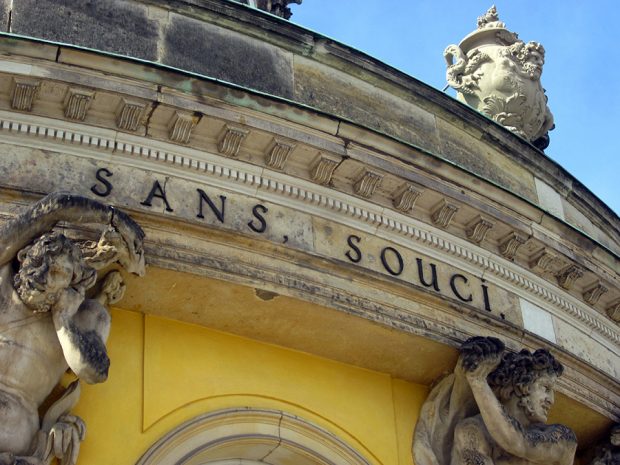
Potsdam Travel Guide
The ultimate guide to the best things to do and see in potsdam.
Right beside Berlin, Potsdam is an extremely old city that often gets overlooked and only considered for a daytrip from the capital. But as the capital and largest city in the state of Brandenburg, Potsdam has a lot to see and it can be a very worthwhile place to stay a couple of nights. Start here with my basic Potsdam travel tips, or jump down below to read my latest Potsdam travel blogs .
When to Visit
Potsdam is a great summer destination, since a lot of the sights worth seeing are gardens and palaces! Visiting in fall can be beautiful too, and winter with the Christmas markets (and maybe snow!) can be charming too.
Top Things To See
Sanssouci Palace – Probably the most recongisable place in Potsdam, this UNESCO World Heritage Site has been restored to its former glory after damage in the Second World War and a lot of neglect during the GDR times. It was originally the country residence of Frederik the Great in the 18th century, and in its Rococo style, is reminiscent of the Palace of Versailles in France.
Holländische Viertel – Literally, the Dutch Quarter , this area of a few streets in central Potsdam was constructed in the 18th century by Dutch immigrant Johann Boumann with the intention of attract other artisans from the Netherlands to move to the area. The houses are all in the typical Dutch style and nowadays it’s full of cute little boutiques, antique shops and cafés.
Filmpark Babelsberg – A little to the east of downtown Potsdam is this fun theme park all about German film making. The first ever German expressionist film was shot here, and you’ll get to peek behind the curtain and get a look at how films are made!
Potsdam Tours
Although it’s a relatively small place (and in fact still feels like a part of Berlin!), taking a tour around Potsdam will save you time and get you in to some areas of the city you might otherwise overlook, so it’s definitely worth you time to consider one. Take a look at this selection of Potsdam tours.
LGBTQ – Gay Potsdam Travel Guide
Potsdam is a small town and doesn’t have a gay scene as such. It’s only 20 minutes by suburban train to downtown Berlin , which doesn’t lack gay life at all!
More gay travel resources here.
Potsdam Hotel Deals
Potsdam has plenty of hotels,but you should definitely consider booking in advance if you want to stay there rather than in nearby Berlin.
Follow @ travelsofadam on Instagram for more travel tips!
Potsdam Travel Blogs
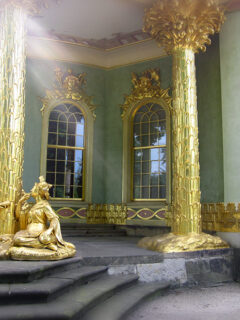
Chinoiserie architecture around Europe
Barcelona, Potsdam and Brighton are all home to some important and extensive Orientalism & Chinoiserie architecture around Europe.
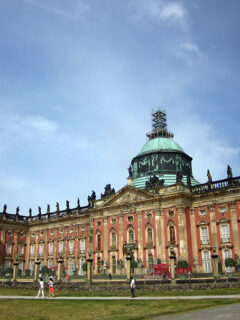
Pretty Potsdam: a day trip from Berlin
Photos of the very pretty Potsdam (day trip from Berlin) and its palaces & colorful parks, notably the Rococo Sanssouci summer palace.

The Jenna Way
Unapologetic – Queer – Unstoppable
How To Take A Beautiful Day Trip: Berlin To Potsdam
If you’re looking for a day trip from Berlin, then look no further than the quaint town of Potsdam. Potsdam is a UNESCO World Heritage Site and a small city just outside of Berlin, Germany. It’s incredibly easily reachable by train, making it a perfect Berlin day trip.
In September, we spent 7 days in Berlin, and so there was plenty of time to explore beyond the main city to see another part of Germany. And although it’s only half an hour away by train, it feels like a whole other world from Berlin. I would describe Potsdam like taking a day trip from Berlin to a miniature Amsterdam. It’s full of picturesque buildings, green spaces, cute streets and plenty of delicious eateries.
Read on for all you need to know about planning a day trip from Berlin to Potsdam.

Where is Potsdam, Germany?
Potsdam is South West of Berlin, and the capital city of the state of Brandenburg . It’s a city with a population of less than 200,000 people.

How To Get From Berlin To Potsdam
The fastest and easiest way to get from Berlin to Potsdam is by train.
The best travel options are departing from Berlin Central Station on the S-Bahn (S7), Berlin’s city train (meaning that not only is it fast, it’s super cheap too) or the Regional train (RE1).
Check out the S-Bahn times and schedules here.
- Depart : Berlin Hbf (Central Station)
- Cost : €3 each way
- Journey : 25 – 35 minutes
When To Go To Potsdam, Germany

A day trip from Berlin to Potsdam is a great idea all year around. However, when you visit may provide different perspectives & alter the overall experience.
Visiting Potsdam Germany in the spring
Temperatures will range from 15°C to 20 °C and the flowers will have started to bloom. Filling Potsdam with as many colours as the rainbow.
Visiting Potsdam Germany in the summer.
Temperatures will rise considerably, as will the volume of visitors, who flock to enjoy all the wonderful outdoor beauty Potsdam has to offer. Not to mention, Potsdamer Schlössernacht, the magical palace illumination, which happens every August. ( Find out more about Potsdamer Schlossernacht here ).
Visiting Potsdam Germany in the Autumn
Temperatures will range from 15°C to 20 °C again, and the leaves start to turn gorgeous Autumnal colours. Additionally, you can still catch some warm sunny days, without the associated crowds of summertime. (We visited in late September and it was warm enough for just a t-shirt.)
Visiting Potsdam Germany in the Winter
Temperatures will range from 0°C to 10 °C and from December to March temperatures occasionally reach as low as -5°C. But despite the cold, winter in Potsdam brings opportunity for exploring Christmas markets or seeing the beauty of Sanssouci in the snow.
Things To do In Potsdam, Germany
1. explore the beauty of sanssouci palace.
The palace is by far the most stunning attraction in Potsdam. Located inside expansive grounds, the palace itself is a stunning building to walk around. Whether you choose to head inside, and take a tour of the building, or like us, just walk about outside and around the grand staircases taking some incredibly beautiful photos. You won’t regret making Sanssouci Palace a highlight and main stop on your day trip to Potsdam.

2. Take A Stroll Around Sanssouci Park
Alongside the palace itself, the land that the palace is situated in is well worth taking a few hours to explore. Particularly if you are visiting Potsdam in the summer. But, I imagine it will be beautiful all year round. There are rose gardens, an orangery, a Japanese garden and more. Not to mention, the hedge quarter is home to over 3,000 fruit trees. Whether you are super into discovering different botanicals or just like to be outdoors in nature, it’s the perfect place for a stroll. Particularly in contrast to the very concrete Berlin, Potsdam’s Palace Gardens feel like entering another world.

3. Meander Through The Dutch Quarter
The main area of Potsdam is referred to as the Dutch quarter. And as soon as you arrive off the train from Berlin it will be easy to see why. It’s like leaving Germany and entering a miniature Amsterdam. From the cobbled streets to the colourful architecture, spend some time meandering through the many streets and doing some window shopping (or real shopping!)

4. Ride Electric Scooters
Those who know me know how much I absolutely love hiring electric scooters when travelling. Whilst they are perhaps not the most sustainable new craze to hit Europe, I can’t pretend they are not a ton of fun. Whether it be Lime, Bolt or one of the many other brands now available, download the app, pick up a nearby scooter and zip around the outskirts of Potsdam. Whilst the city centre itself is fairly busy and cobbled, the surrounding streets have wide open bike path’s, making it super easy to get from one part of the city to another. If you’ve never used lime before, get a free unlock credit with this referral code; https://lime.bike/referral_signin/RIZGLYK

5. Take A Tour Of A Windmill
Inside the palace grounds is a gorgeous windmill. Once again making the day trip from Berlin to Potsdam feel like a trip to The Netherlands! The windmill is super pretty for taking some pictures, or you can even choose to buy a ticket and tour inside it and learn about how it has been used throughout the years. As a bonus, there is a lovely little café with gorgeous views of Potsdam and the park right beside it to. It’s the perfect place to stop and refuel after all the exploring.

6. Eat Delicious Dutch Poffertjes
These are one of my absolute favourite Dutch foods, so I was very excited to discover them on our day trip to Potsdam. Order a plate of delicious tiny pancakes from Poffertjes en Pannekoeken and a topping of your choice. I went for the classic dusted icing sugar with apple sauce, but the world is really your oyster when it comes to options.

7. Visit The Four City Gates
Potsdam city used to be walled in and accessed by five main gates which were originally used as the entrances to the city. Whilst the city itself is no longer walled in, three of the gates still stand and make for a picturesque visit. Brandenburg gate (not the famous one in Berlin!) is perhaps the most impressive, although all three are unique in their own ways. Nauen gate resembles a miniature castle with turrets, and Hunters gate is the oldest of the three remaining structures. We used the lime scooters to zip between each of them to fit everything in on our one day trip to Potsdam.

8. Grab A Caffeine Hit From Potsdam’s Local Roastery
Before heading back for our train from Potsdam to Berlin, we picked up a coffee from the highly recommended Buena Vida coffee club. It did not disappoint. Buena Vida coffee club is a local roastery based out of Potsdam, with plenty of freshly baked goods to accompany your caffeine hit. Stop by any time of day to enjoy the forever wonderful smell of freshly ground coffee beans.

And there you have it, a complete guide to taking a day trip from Berlin to Potsdam Germany. Did I miss anything? Drop me a message on Instagram and let me know!
More Blogs To Help Plan Your Day Trip To Potsdam
- 50 Ways I Can Afford To Travel The World
- Hand Luggage Only – How I Pack
- Luneberg: A Day Trip From Hamburg
Share this:
- Click to share on Facebook (Opens in new window)
- Click to share on Twitter (Opens in new window)
- Click to share on Pinterest (Opens in new window)
- Click to share on LinkedIn (Opens in new window)
- Click to share on Reddit (Opens in new window)
- Click to share on WhatsApp (Opens in new window)
- Click to share on Tumblr (Opens in new window)
- Click to print (Opens in new window)
Recommended Articles
100 resources about racism to be a better ally.

How To Install A Polyvision Aero Window Successfully

2018: A Year In Review


1-Day Potsdam Itinerary
Navigate forward to interact with the calendar and select a date. Press the question mark key to get the keyboard shortcuts for changing dates.
Navigate backward to interact with the calendar and select a date. Press the question mark key to get the keyboard shortcuts for changing dates.
- Potsdam in 1 day
- 2-Day Potsdam Itinerary
- 3-Day Potsdam Itinerary
- 4-Day Potsdam Itinerary
- 5-Day Potsdam Itinerary

Table of contents
1-day itinerary, sanssouci park.
Sanssouci Palace

Brandenburg Gate
Where to eat, der hot dog laden, theaterklause potsdam, dragon house.
Attractions

Popular road trips from Potsdam
What's the weather like in potsdam.
It depends on when you visit! We've compiled data from NASA on what the weather is like in Potsdam for each month of the year: see the links below for more information.
- Weather in Potsdam in January
- Weather in Potsdam in February
- Weather in Potsdam in March
- Weather in Potsdam in April
- Weather in Potsdam in May
- Weather in Potsdam in June
- Weather in Potsdam in July
- Weather in Potsdam in August
- Weather in Potsdam in September
- Weather in Potsdam in October
- Weather in Potsdam in November
- Weather in Potsdam in December
All road trips from Potsdam
- Potsdam to London drive
- Potsdam to Prague drive
- Potsdam to Paris drive
- Potsdam to Amsterdam drive
- Potsdam to Rome drive
- Potsdam to Barcelona drive
- Potsdam to Vienna drive
- Potsdam to Copenhagen drive
- Potsdam to Budapest drive
- Potsdam to Hamburg drive
- Potsdam to Munich drive
- Potsdam to Florence drive
- Potsdam to Milan drive
- Potsdam to Venice drive
- Potsdam to Brussels drive
- Potsdam to Krakow drive
- Potsdam to Madrid drive
- Potsdam to Edinburgh drive
- Potsdam to Dublin drive
- Potsdam to Dresden drive
- Potsdam to Warsaw drive
- Potsdam to Istanbul drive
- Potsdam to Stockholm drive
- Potsdam to Lisbon drive
- Potsdam to Turin drive
- Potsdam to Cologne drive
- Potsdam to St. Petersburg drive
- Potsdam to Bruges drive
- Potsdam to Moscow drive
Explore nearby places
- Schwielowsee
- Gross Glienicke
- Werder upon Havel
- Kleinmachnow
- Ludwigsfelde
- Grossbeeren
- Gross Kreutz
- Blankenfelde
- Grossziethen
- Hennigsdorf
- Gross Kienitz
All related maps of Potsdam
- Map of Potsdam
- Map of Bornim
- Map of Schwielowsee
- Map of Caputh
- Map of Gross Glienicke
- Map of Werder upon Havel
- Map of Michendorf
- Map of Stahnsdorf
- Map of Kleinmachnow
- Map of Ferch
- Map of Paretz
- Map of Dallgow
- Map of Teltow
- Map of Ketzin
- Map of Wustermark
- Map of Klaistow
- Map of Ludwigsfelde
- Map of Grossbeeren
- Map of Gross Kreutz
- Map of Beelitz
- Map of Falkensee
- Map of Lehnin
- Map of Trebbin
- Map of Mahlow
- Map of Pawesin
- Map of Blankenfelde
- Map of Nauen
- Map of Grossziethen
- Map of Berlin
- Map of Hennigsdorf
- Map of Gross Kienitz
Potsdam throughout the year
- Potsdam in January
- Potsdam in February
- Potsdam in March
- Potsdam in April
- Potsdam in May
- Potsdam in June
- Potsdam in July
- Potsdam in August
- Potsdam in September
- Potsdam in October
- Potsdam in November
- Potsdam in December
Looking for other day-by-day itineraries in Potsdam?
Check out our other curated itineraries that are also filled with jam-packed days:
Day itineraries for nearby cities
- 1-Day Berlin Itinerary

- Itinerary + map in one view
- Live collaboration
- Auto-import hotels and reservations
- Optimize your route
- Offline access on mobile
- See time and distance between all your places
- Top Destinations
- Mexico City, Mexico
- Tokyo, Japan
- Paris, France
- Rome, Italy
- London, United Kingdom
- All Destinations
- Upcoming Experiences
- Private Walking Tours
- Small-Group Tours
- Tours for Kids
- Museum Tours
- Food, Wine and Market Tours
- Newly Added Tours
- Audio Guides
- Pre-Trip Lectures
- Admin Dashboard
- My Experiences
- My Favorites
- Cookies Preferences
- Client Orders
- Monthly Commissions
- My Advisor Profile
- Advisor Toolkit
- Guide Dashboard
Credit Balance
Transactions are based on current exchange rates and performed in USD. There maybe slight variations in the price estimates.
Exploring Potsdam: An Easy Day Trip from Berlin with a Private Walking Tour

Experience Potsdam in the company of a local Context Expert
One of the most important but often overlooked parts of any successful vacation is a good day trip. For those travelers spending time in Berlin, a day trip to Potsdam is one of the most convenient and rewarding day trips you can take.
A Berlin day trip to Potsdam is a window into history. A short, immersive walking tour can unlock invaluable stories of Prussian history and German rule, as Potsdam was the royal retreat of Prussian kings, as well as the seat of the German Kaisers until 1918.
Getting to Potsdam from Berlin
There are many Berlin to Potsdam transportation options. Travelers can make the drive up the autobahn (A115) in less than 40 minutes. There are also regular trains that take less than half an hour. The train from the Berlin Central Station (Berlin HBF) drops riders off near the Sanssouci Palace. Looking for a bus ride? Buses to Potsdam leave every 15 minutes and cost less than €10, so it’s cost-effective and convenient to get to the best Potsdam tourist attractions.

Potsdam: A Historic and Picturesque Destination
Few cities in Europe offer the appeal and historical significance of Potsdam. Not only do all of the historical landmarks and palaces in Potsdam infuse the city with a unique historical legacy, but the architecture also gives the city an unmistakable charm.
Potsdam is the capital city of the German state of Brandenburg; it is also part of the Berlin/Brandenburg metropolitan region. Although the city has artifacts dating back to the Bronze Age, Potsdam rose to European prominence in 1660 when it was chosen as the hunting residence of Fredrick William I (grandfather of Fredrick the Great).
In 1685, when Fredrick William I signed the Edict of Potsdam, Potsdam became a center of European immigration. The edict attracted protestants seeking religious freedom, and the area became a magnet for people from France, Russia, the Netherlands, and Bohemia. The edict and subsequent wave of immigration accelerated population and economic growth in Potsdam.
All of this history is alive in the palaces, parks, and architecture that form the incredible city of Potsdam.
Benefits of a Private Walking Tour in Potsdam
The best way to engage with the legacy and allure of this magical city is on a guided walking tour of Potsdam. A Context tour guide can help you build a personalized itinerary tailored to your interests and preferences.
Whether you are looking to explore the charming restaurants of the Dutch Quarter or the lush grounds of the Sanssouci Palace, you’ll spend a memorable three hours strolling and discussing Potsdam’s fascinating evolution.
A knowledgeable guide will also be able to provide insights into the history and culture of the city, as well as reveal hidden gems around Potsdam. Finally, a tour guide will be able to answer your questions and engage in meaningful discussions about the region.

Exploring Potsdam's Key Attractions
No trip to Potsdam is complete without a visit to Sanssouci Palace. Sanssouci Palace was built by William Frederik I as his private palace. It is a model of the Rococo architectural style – an exceptionally ornamental and dramatic design style with a theatrical abundance of curves and counter curves. It is often described as one of Germany’s Versailles.
Sanssouci Palace sits in Sanssouci Park and features stunning park grounds complete with manicured lawns, Baroque flower garden s, hedges, and over 3,000 planted trees. The obelisk in the garden depicts the goddesses Flora and Pomona. They are meant to represent the connection between the growing of flowers and the growing of fruits and vegetables. Sanssouci Park was designated as a UNESCO World Heritage Site in 1990 for its distinct architectural unity and testimony to 18th and 19th-century landscaping in Europe.
Another popular stop in Potsdam is the Dutch Quarter. Also called Little Amsterdam, the Dutch Quarter in Potsdam was built by Dutch immigrants between 1732 and 1742. The quarter, which is the largest collection of closed, Dutch-Style buildings outside of the Netherlands, contains four dutch style squares and 134 Dutch Style two-story, red brick houses. Small backyard pubs, cozy cafes, and delightful bistros dot the neighborhood. Taking a stroll through the Dutch Quarter and visiting its boutiques, antique shops, art galleries, and boutiques is a great way to experience the flair of the area.
History fans will enjoy a visit to Cecilienhof Palace. Built between 1914 and 1917 in the English Tudor style, Cecilienhof Palace was the last palace built by the Hohenzollern dynasty, the rulers of the kingdom of Prussia leading up to the First World War. Cecilienhof Palace is perhaps best known for its association with World War II, as it was the site of the Potsdam Conference, where Winston Churchill, Harry S. Truman, and Joseph Stalin met in 1944 to discuss post-war peace.
Babelsberg Park and Palace is another UNESCO World Heritage Site in Potsdam. It was inscribed for its architectural cohesion and its representation of the power of the Prussian monarchy. The Palace and Park offer stunning views of beautiful landscapes. In contrast to the Rococo style of Sanssouci Palace, Babelsberg Palace is built in the Gothic revival architectural style, featuring allusions to medieval design.
Practical Tips for a Day Trip from Berlin
Potsdam is charming and wonderful in any season, but it is best to match the season with the type of experience you want. If you want to explore a Dutch Christmas Market in the Dutch quarter, then the Advent season (just before Christmas) is the best time to visit. If you would like to take in outdoor performances of music and theater, it is best to visit in the summer.
If a tour of the Sanssouci Palace is on your to-do list, remember that in order to visit, you will need to buy a ticket that will dictate when you can enter the palace.
Those traveling with mobility issues in Potsdam may need to seek some alternative access routes for some of the hillier terrain, but most of Potsdam is accessible for those with limited mobility.

Enhancing Your Potsdam Experience
Potsdam can be tailored to travelers interested in several eras of European history, architecture, and culture. With all the city has to offer, it is important to enhance your Potsdam day trip with the knowledge and expertise of a guide.
Not only can a guide help you uncover hidden stories and details about Potsdam, but they can also help you customize a private walking tour tailored to your interests. Working with a Context guide can ensure that your day trip to Potsdam can result in a deeper understanding of the region’s history and culture.
Visiting Potsdam from Berlin is an easy, rewarding day trip. Just a short drive or train ride transports you to a charming world rich with history and culture.
You Might Also Like:
- The Berlin Wall Memorial: A Powerful Reminder of History
- 15 Fantastic Things to do With Kids in Berlin
- Exploring Berlin’s Rich Heritage: A 5-Day Itinerary for Unforgettable Tours
Read More Stories

Even More from Context
Subscribe to our Newsletter
Keep Exploring

Explore Tours
Join walking tours with top experts all over the globe.
Browse Our Cities
- Our Experts
- Working with Context
- View All Cities
- Sustainable Tourism
- Refer a Friend for $50
- Travel Updates
- Advisor Login
- Expert Portal
- Privacy Statement & Security
- Cancellation Policy

- Top Attractions
- Nearby visits
Declared a World Heritage Site by UNESCO, Potsdam is one of the most beautiful cities in Europe . It was once home to the former royal palace and gardens of the Prussian Royal Family and German Kaisers .
Situated just 24km from central Berlin , Potsdam offers the perfect combination of art and nature .
Founded around the seventh century by the Polabian Slavs, Potsdam was chosen as the hunting headquarters in 1660 by Frederick William I.
Subsequently, it became the residence of Prussia ’s Royal Family . During this period numerous splendid buildings and palaces were built in the area, most of which still stand today.
Potsdam's magnificent palaces and elegant gardens made it an essential UNESCO World Heritage Site since 1990 . It is now one of the most-visited cities in Germany.
What to do in Potsdam?
Potsdam is relatively small, but it has numerous architectural gems that are worth discovering. Some of the most interesting places to see in Potsdam are:
- Sanssouci Palace : Frequently compared to the Palace of Versailles, Sanssouci Palace is one of the most popular landmarks in Potsdam. Its magnificent gardens are worth exploring .
- Dutch Quarter : Also called “Little Amsterdam”, the Dutch Quarter is a small neighbourhood with red-brick houses where the Dutch lived during the eighteenth century after moving from Holland to Potsdam.
- Babelsberg Palace : The Gothic-styled Babelsberg Palace was constructed between 1833 and 1835 as a summer residence for the German Emperor William I. Sitting on the banks of the Havel River , this mansion and its gardens are extremely romantic. Sometimes the palace is closed due to renovation works.
- Neues Palais : The enormous Baroque palace is crowned by an impressive green-coloured dome and has a red-brick façade.
- Glienicke Bridge (Glienicker Br ücke) : Built in 1907, the Glienicke Bridge crosses the Havel River connecting Berlin and Potsdam . Also known as the Bridge of Spies, it was where the Soviet Union and the U.S. exchanged captive spies during the Cold War .
- Cecilienhof Palace: The elegant palace is designed as a typical Tudor manor house. It is currently used as a hotel and museum but has an important history since it was where the Potsdam Conference of 1945 took place.
- Brandenburg Gate : Although the most famous Brandenburg Gate is in Berlin, the Brandenburg Gate of Potsdam was built before Berlin ’s landmark . It is in the Old Town, next to Luisenplatz.
- Charlottenhof Palace : This beautiful neoclassical mansion looks a bit like a Roman villa . It was built on the ruins of a farmhouse.
How long should you stay in Potsdam?
Potsdam is a city packed with iconic landmarks and things to do, but it is quite small, so one full day is enough time to explore this charming city.
How to get to Potsdam?
- Booking a guided tour : the easiest way if you're looking to visit without complication. If you book an excursion to Potsdam you'll get transport from Berlin , as well as a specialist guide who'll fill you in on all the points of interest in the city .
- Trains : Visitors can either take the S-Bahn which takes approximately 40 minutes or the regional express train which takes 20 minutes . If you prefer the S-Bahn option, you must purchase a Berlin ABC ticket (single ticket: € 3.50 ( US$ 3.90) or day ticket: € 9.90 ( US$ 11)). If you have a travel card for areas A and B, you only need to purchase a ticket for zone C which costs € 1.60 ( US$ 1.80).
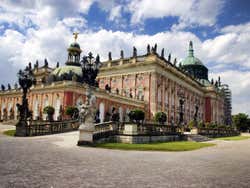
30 km southeast of Berlin
Nearby places
House of the Wannsee Conference (8.3 km) Kurfürstendamm (20.9 km) Berggruen Museum in Berlin (21 km) Charlottenburg Palace (21.2 km) Kaiser Wilhelm Memorial Church (22.3 km)
You may also be interested in
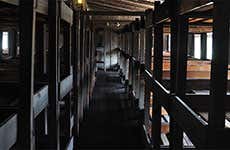
Sachsenhausen Concentration Camp
Sachsenhausen is a death camp near Berlin and is considered one of the most important in Nazi Germany. It is a must-see visit if you’re in Berlin for a few days.
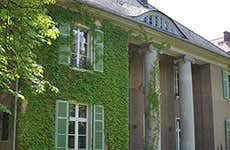
House of the Wannsee Conference
An elegant mansion built in 1915 in Wannsee, in the outskirts of Berlin, was the chosen location for the Wannsee Conference, where the SS and Nazi leaders planned the Holocaust between 1941 and 1945.
- Search Please fill out this field.
- Newsletters
- More to Explore
- Things To Do
11 Best Things to Do in Potsdam, Germany
:max_bytes(150000):strip_icc():format(webp)/ebephoto-5b7352c3c9e77c005080d5ad.jpg)
Potsdam, the capital of Brandenburg in east Germany , makes a great day trip from Berlin and provides some of the elegance missing from a modern big city. The Prussian kings left their royal imprint with lavish palaces, parks, and gardens, many of them with UNESCO World Heritage status.
Most people come to Potsdam to see the rococo style Palace Sanssouci, built for Frederick the Great, but the city has much more to offer. Here are the best things to do in Potsdam, Germany.
Vacation Like Royalty
Tripsavvy / Christopher Larson
When the King of Prussia, Friedrich der Große, wanted to get away from the hustle and bustle of city life in Berlin, he would flee to the tranquility of his summer palace. Sanssouci ("without worries" in French) was built in 1774 and is as breathtaking today as when it was first built.
Buy a ticket to step inside Friedrich's world. The interiors are decorated in the elaborate Frederician Rococo style. The highlights include the Entrance Hall and Marble Hall, although all the structures offer decadent design. The palace is regally perched on top of a terraced vineyard, overlooking 700 acres of royal gardens.
Styled after Versailles in France, the ornate gardens are as attractive as the elegant interiors. There are fountains, marble sculptures, and a Chinese tea house sprinkled throughout the expansive grounds. On the highest terrace close to the palace, there is the tomb of Fredrick, relocated here after reunification in 1990.
Botaurus / Wikimedia Commons / Public Domain
Sweeping gables, red bricks, and white window shutters straight out of the Netherlands have found a home in Potsdam. The Dutch Quarter (Hollaenderviertel) was built in the 18th century for Dutch artisans and craftsmen who were invited to settle down here by Frederick the Great.
The ensemble of over 130 houses built in the traditional Dutch style is unique in Europe and also on the UNESCO World Heritage list. Walk down the cobblestone streets of Mittelstrasse and Benkertstrasse, which are brimming with lovely cafes, specialty shops, and restaurants.
Walk the Bridge of Spies
Ulf Boettcher / LOOK-foto / Getty Images
Before the wall fell and Germany was still divided into two, the Glienicke Bridge was one of the Cold War's most mysterious sites. Spanning the Havel River, the bridge connected the Soviet-occupied Potsdam in the east with U.S.-occupied West Berlin, and the two superpowers used this checkpoint to exchange captured Cold War spies and secret agents. Perhaps most famous is the 1962 trade of Russian agent Rudolf Abel for downed U.S. pilot Francis Gary Powers.
Now just a quiet bridge in the countryside, the bridge's infamous history gained international attention with the 2015 Academy Award-nominated movie, "Bridge of Spies."
Be in the Movies at Filmpark Babelsberg
Studio Babelsberg is the oldest large-scale film studio in the world. They have been producing films here since 1912!
Visitors to the studio can learn about Germany’s golden age of film. Babelsberg has contributed such cinematic masterpieces from "Metropolis" to "Valkyrie" to "Inglourious Basterds." However, the studio also has a darker past as a tool for the National Socialists to pump out anti-Semitic propaganda, often under Josef Goebbels himself.
When the studio is filming, stages and props can be seen on the tour. There are also seasonal events like an epic Halloween celebration.
Tour the Site of the Potsdam Conference
Gettyimages / Vladislav Zolotov
Another must-see for history buffs is Cecilienhof Palace, set in the beautiful park of Neuer Garten. The last palace the Hohenzollern family ever built, it offers an interesting contrast to Sanssouci as it was designed in the rustic English Tudor style.
Visitors can tour historical rooms such as the smoking salon, the music salon, and the royal family's bedroom, but of particular interest is the Great Hall. It was here that the Potsdam Conference was held in 1945. Stalin, Churchill, and Truman gathered here to decide to divide Germany into four different occupied zones.
(House of the Wannsee Conference just outside of Potsdam is another historical site for those seeking World War II history).
Enter Russia in Germany
Von A.Savin—Eigenes Werk / Wikimedia Commons / CC BY-SA 3.0
Just north of Potsdam’s city center, you’ll find the Russian Colony Alexandrowka. Built in 1827, there are 13 wooden Russian homes that the Prussian King erected. They were built to house the Russian singers of the First Prussian Regiment of the Guards. Briefly occupied by the Red Army following World War II, some of the original Russian descendants still lived in these beautiful historic homes until the early 2000s.
Visitors today find stunning architecture, community gardens, and a Russian Orthodox chapel and Russian teahouse. The colony was plotted in the shape of a St. Andrew’s cross.
Observe Church and State
GettyImages / Vladislav Zolotov
Distinguished St. Nicholas Church can be spotted by its stand-out turquoise dome and its size—the largest in Potsdam. Located in Potsdam’s Old Market Square and completed in 1828, it is an excellent example of German classicism designed in the shape of a Greek cross. Damaged in World War II, it wasn't reopened until 1981. It now serves as the center of Potsdam's catholic community.
Located nearby is Brandenburg's pink parliament building, Landtag, which was once a palace. Potsdam is the capital of the German state of Brandenburg, and this is where state laws are decided. Steeped in history from its first elections in 1946 as part of the Soviet Occupation Zone to being abolished in 1952 to its re-establishment in 1990, it is worth a tour.
Raise a Glass at a Brewery
www.facebook.com/Meierei.Brauerei.Potsdam
Located on the picturesque lake of Jungfernsee in Neuen Garten, Meierei Brauerei provides a taste of the good life or good German life at least. The sprawling brewery features craft beers brewed in-house. There are pilsners and summery hefeweizens or the "Potsdamer" which mixes a beer with Fassbrause, a Berlin lemonade.
Complete the experience by sitting out in the sunshine facing the lake and add beloved German specialties to your order, like schweinshaxe (roasted pork knuckle). For a pleasant stroll, look for the point where the Berlin Wall once ran right next to the brewpub and follow the path with a wegbier (beer to go).
Walk Through the Gates
GettyImages / querbeet
Potsdam was once a heavily protected city with entry points only allowed through guarded city gates that lasted until the 20th century. Only three remain.
The oldest gate is Jägertor with its hunting decor. Nauener Tor was redesigned in 1755 and showcases neo-Gothic style. The third gate should remind you of another famous gate—Berlin's very own Brandenburger Tor! Potsdam's version is actually slightly older, replacing a medieval gate that stood here before. The current design is based on Rome’s Arch of Constantine, which was created to celebrate Prussia’s victory in the Seven Years’ War.
When walking through the gate, take note of the different designs on each side. This is the result of two different architects. The city side was by Carl von Gontard with his pupil, Georg Christian Unger, creating designs for the "field" side.
Stroll Through the Park
GettyImages / senorcampesino
Potsdam many parks offer spaces to run, lounge, and play. Expansive 114 hectares Babelsberg Park is part of Potsdam's recognized UNESCO World Heritage site and is pristine parkland.
Located in the northwest of Potsdam on the Havel River banks and Tiefen See, it has views of Glienicke Bridge. Its manicured lawns, leafy paths, and breezy waterfront connect historical buildings like Kleines Schloss , the mid-1800s tower, and Babelsberg Palace . This is a park in which to stroll, not run.
Eat Your Way Around the Neighborhood
GettyImages / Creativ Studio Heinemann
After a long day of exploring Potsdam's many attractions, there is no reason to trek back to Berlin to find a meal. There is something for every appetite, from wacky modern burgers to French cafe fare to East German classics. However, some of Potsdam's most unique meals can be found at restaurants that cater to one of its minority communities.
"The Flying Dutchman," or Zum Fliegenden Holländer, was built by the same court craftsmen who worked on the famed Sansoucci. The charming restaurant design of unfurling gables and red brick looks like they are straight out of Holland. Inside, both hearty German and Dutch food is served.
Note that Potsdam's crowds can make seating impossible in the busy summer months. Call ahead to reserve a spot and try out your restaurant German. Also, be advised: Most German restaurants only accept cash.
Related Articles
More related articles.
- Hohenzollern Palaces
- Filmmaking in Potsdam
- WWII / Cold War
- Our Neighbour Berlin
- Dutch Quarter
- City Center
- Colony Alexandrovka
- Freundschaftsinsel
- Mansion Colony New Babelsberg
- UNESCO World Heritage
- A journey through Europe
- Christmas Season
- Sanssouci Palace
- Orangery Palace
- Picture Gallery
- Charlottenhof Palace
- Cecilienhof Palace
- Marble Palace
- Babelsberg Palace
- Flatow Tower
- Museum Barberini
- Potsdam Museum
- Filmmuseum Potsdam
- Digital Tour
- Potsdam in One day
- Potsdam in Two Days
- Potsdam in Three Days
- Discovery Tours
- Audio Tours via App
- Arrival and Departure
Berlin WelcomeCard - Potsdam Edition
- Information for groups
- Staying in Potsdam
- Eat and Dine in Potsdam
Tourist Information Centres
- Request a Brochure
- My Wishlist
Potsdam in one day
Start your day in Potsdam at the Old Market , which is used to be one of the most beautiful squares in Europe. With the inauguration of the Brandenburg State Parliament in the reconstructed facade of the City Palace which got destroyed during World War 2, the historic heart of the city started to beat again in 2014. Only three years later in 2017 the Museum Barberini opened its gates for art lovers from all over the world. Monet, Richter, Picasso and van Gogh are just a few names of artists whose masterpieces call this gallery their temporary home.
If you are not into art, try out the Filmmuseum Potsdam . Potsdam-Babelsberg is home to the modern filmmaking as we know it. Therefore the permanent exhibition takes you on a time travel through 100 years of filmmaking in Babelsberg. Also the guided walking tour “Getting to know Potsdam” is highly recommended. The tour starts right at the Tourist Information Center in Humboldtstrasse. Within only two hours you will walk over the Old Market, to the New Market and end up with lots of inspiring Information and interesting stories at the Dutch Quarter .
Alternatively, enjoy the view from the 42m high platform of St. Nicholas’ Church. You will see blocks of red brick buildings that may remind you of houses in the Netherlands. Welcome to the Dutch Quarter. It’s considered to be Europe’s greatest collection of Dutch-style houses outside the Netherlands. Cosy cafés provide a delicious ranch from big brunch buffets to small bites of Dutch “Pannekoeken”.
After a culinary refreshment your way leads you through the retail strip of Brandenburger Strasse. Lovely backyards along the busy pedestrian area are worth more than just a glimpse. Regional shops and boutiques invite you to linger. Maybe you will find just the right souvenir for your loved ones at home.
At the end of the Brandenburger Straße you will see the gate Brandenburger Tor . No, you are not in Berlin. But yes, it has the same name. Actually the gate Brandenburger Tor in Potsdam was built 20 years before its famous brother in Berlin.
Crossing the square Luisenplatz you can continue to the main entrance of Sanssouci Park . 300 hectares of garden art await you with more than 11 palaces and historic buildings such as the Orangery Palace and the Chinese House . Entering the Park, you will firstly walk towards Sanssouci Palace sitting enthroned on its famous vineyard terraces. Looking west you are bound to be surprised by a windmill. The Historic Windmill is a perfect lookout to get an overview over this huge park area. Its creaking wings still turn to prcess grain, today. You can buy bread baked with Sanssouci flour in the museum shop right across it.
Highlight of the western part of Sanssouci Park is the colossal New Palace . It is by far the biggest palace in Potsdam and bears a strong contrast to the intimate and rather modest Sanssouci Palace. Take your time to wander around this green oasis and let your thoughts wander.
After hours of strolling along baroque facades, pompous palaces and romantic gardens, there is no doubt that you need to take it slow in the evening hours. Therefore, we suggest to get on board of one of the excursion boats. Enjoy some replenishing German food and let your feet rest. Carried across the waves of the idyllic river Havel, the sunset will immerse Babelsberg Palace in blood orange light just before you pass below the Glienicke Bridge, which, not even 30 years ago, separated West Berlin from Potsdam in East Germany. The film "Bridge of Spies" with Tom Hanks tells the story of the first agent exchange that took place here during the Cold War between the Soviet Union and the USA in 1962. Last, but not least, Cecilienhof Country House might make you curious about stories of the Potsdam Conference after World War II you will get to know. And with this in mind, you may start to plan your next 24 hours in Potsdam right away. There is a lot more to explore.
Potsdam in two days
Potsdam in three days, potsdam's neighbour berlin, #explorepotsdam-podcast, accommodatios, berlin welcomecard – potsdam edition, how to get to potsdam.
The Berlin WelcomeCard - Potsdam Edition enables you to use all public transport services in Berlin ABC and in Potsdam. On top, there are numerous discounts, which make this ticket worthwhile.
Accommodation Request

©Sergey Kohl/500px
Potsdam, on the Havel River just 25km southwest of central Berlin, is the capital and crown jewel of the federal state of Brandenburg. Easily reached by S-Bahn, the former Prussian royal seat is the most popular day trip from Berlin, luring visitors with its splendid gardens and palaces, which garnered Unesco World Heritage status in 1990.
Attractions
Must-see attractions.

Schloss & Park Sanssouci
This glorious park and palace ensemble is what happens when a king has good taste, plenty of cash and access to the finest architects and artists of the…

Schloss Sanssouci
Frederick the Great's famous summer palace, this rococo gem was designed by Georg Wenzeslaus von Knobelsdorff in 1747 and sits daintily above vine-draped…

Museum Barberini
The original Barberini Palace was a baroque Roman palazzo commissioned by Frederick the Great and bombed to bits in World War II. Since January 2017, a…

Chinesisches Haus
The 18th-century fad for the Far East is strongly reflected in the adorable Chinese House. The cloverleaf-shaped pavilion is among the park's most…

Alter Markt
Halfway between the Hauptbahnhof and the Altstadt, the Alter Markt is the site where Potsdam's settlement began. Under Frederick the Great, it evolved…

Neues Palais
The final palace commissioned by Frederick the Great, the Neues Palais has made-to-impress dimensions, a central dome and a lavish exterior capped with a…

Park Sanssouci
Park Sanssouci is the oldest and most resplendent of Potsdam's many green patches. It's open from dawn til dusk year-round and is dotted with numerous…

Memorial Leistikowstrasse (KGB Prison)
Now a memorial site, Potsdam's central remand prison for Soviet Counter Intelligence – colloquially known as 'KGB prison' – is a particularly sinister…
in partnership with getyourguide
Book popular activities in Potsdam
Book your individual trip , stress-free with local travel experts
Select Month
- roughguides.com
- berlin-and-brandenburg
- Travel guide
- Itineraries
- Local Experts
- Travel Advice
- Accommodation
Plan your tailor-made trip with a local expert
Book securely with money-back guarantee
Travel stress-free with local assistance and 24/7 support
For most visitors POTSDAM means Sanssouci , Frederick the Great’s splendid landscaped park of architectural treasures, which once completed Berlin as the grand Prussian capital. However, Potsdam dates back to the tenth-century Slavonic settlement Poztupimi, and predates Berlin by a couple of hundred years. The castle built here in 1160 marked the first step in the town’s gradual transformation from sleepy fishing backwater to royal residence and garrison town , a role it enjoyed under the Hohenzollerns until the abdication of Kaiser Wilhelm II in 1918.
Park Sanssouci
Voltaire at sanssouci.
World War II left Potsdam badly damaged: on April 14, 1945, a bombing raid killed four thousand people, destroyed many fine Baroque buildings and reduced its centre to ruins. Less than four months later – on August 2 – the victorious Allies converged on Potsdam’s Schloss Cecilienhof to hammer out the details of a divided Germany and Europe. Potsdam ended up in the Soviet zone, where modern “socialist” building programmes steadily erased many architectural memories of the town’s uncomfortably prosperous imperial past. Yet this past still provides its most popular sights.
Travel ideas for Germany, created by local experts
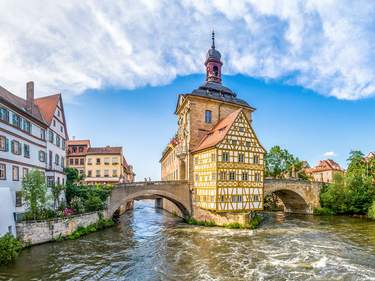
A self drive exploration of UNESCO Sites in Southern Germany
Explore UNESCO World Heritage Sites across different German states. This self drive trip allows you to design your own days with recommendations stated for each day.
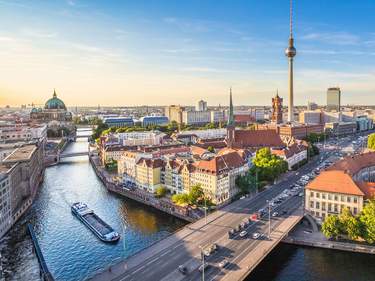
Explore Berlin and Potsdam in depth
The German capital Berlin has plenty to offer: from historical sites to world-class museums and a vibrant nightlife. Enjoy this private tour to explore a wide range of activities in Berlin and Potsdam, including several UNESCO World Heritage Sites.
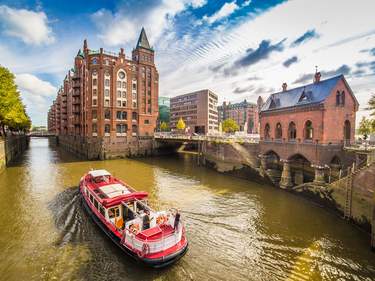
Explore Northern Germany on Your Own
From Bremen to Stralsund - Northern Germany offers plenty of gems to explore. With well-developed public transportation links, this itinerary is suited for everyone wanting to explore on their own - getting lost on the cobble-stoned streets of many UNESCO World Heritage Highlights.
_listing_1640546826392.jpeg)
Capitals of Europe - Berlin, Prague, Vienna and more
This trip is ideal for all city & culture lovers: the Reichstag in Berlin, the castle in Prague, historical Cesky Krumlov, St Stephen's Cathedral in Vienna, the fortress above Salzburg and Schloss Neuschwanstein near Munich - these are just some of the highlights of this incredible roundup trip.
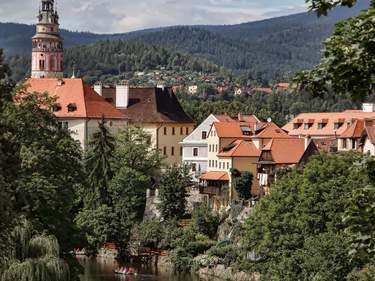
Castles across Austria and Czechia
Austria and Czechia are home to some of the world's most beautiful architecture and culture gems, such as Schloss Schönbrunn in Vienna, Prague castle, the fortress above Salzburg and many more. Finish your tour with a visit to Schloss Neuschwanstein before flying out of Munich.
_listing_1640551981693.jpeg)
Best of Germany
Germany has a lot to offer to visitors: history buffs will enjoy guided tours in Berlin and Dresden, children (and those at heart) will marvel at Schloss Neuschwanstein, scenery lovers will appreciate Rothenburg and the Black Forest. This trip truly has something for everybody!
Stretching west from Potsdam’s town centre, Park Sanssouci was built for Frederick the Great as a retreat after he decided in 1744 that he needed a residence where he could live “without cares” – “sans souci” in the French spoken in court. The task was entrusted to architect Georg von Knobelsdorff, who had already proved himself on other projects in Potsdam and Berlin. Schloss Sanssouci , on a hill overlooking the town, took three years to complete, while the extensive parklands were laid out over the following five years. As a finishing touch Frederick ordered the construction of the Neues Palais at the western end of the park, to mark the end of the Seven Years’ War and there were numerous other additions over the following hundred and fifty years or so. The park is most beautiful in spring, when the trees are in leaf and the flowers in bloom, and least crowded on weekdays. The main visitor centre is by the historic windmill.
The Grünes Gitter and around
The Grünes Gitter provides a southeastern entrance to Park Sanssouci and has an information kiosk. Immediately to the north is the 1850 Italianate Friedenskirche , designed by Persius for Friedrich Wilhelm IV. With its 39-metre-high campanile and lakeside setting, it conjures up the southern European atmosphere that Friedrich Wilhelm strove for by using the St Clemente Basilica in Rome as a model, and with the design centred on the magnificent Byzantine apse mosaic from Murano. Adjoining the church, the domed Hohenzollern mausoleum contains the tombs of Friedrich Wilhelm IV and his wife Elizabeth, and Friedrich III and his wife Victoria. The garden to the west is the Marly-Garten , once the kitchen garden of Friedrich I, who named it, with intentional irony, after Louis XIV’s luxurious Marly park.
Schloss Sanssouci
To approach Schloss Sanssouci as Frederick the Great might have done, make for the eighteenth-century obelisk on Schopenhauerstrasse. Beyond, Hauptallee runs through the ornate Knobelsdorff-designed Obelisk-Portal – two clusters of pillars flanked by the goddesses Flora and Pomona – to the Grosse Fontäne , the biggest of the park’s many fountains, around which a host of Classical statues stand, notably Venus and Mercury. The approach to the Schloss itself leads up through terraced ranks of vines that are among Germany’s most northern.
Frederick had definite ideas about what he wanted and worked closely with Knobelsdorff on the palace, which was to be a place where the king, who had no great love for his capital, Berlin, or his wife, Elizabeth Christine, could escape both. It’s a surprisingly modest one-storey Baroque affair, topped by an oxidized green dome and ornamental statues, looking out towards the high-rises of central Potsdam.
The interior
Inside the Schloss you’ll find a frenzy of Rococo in the twelve rooms where Frederick lived and entertained his guests – a process that usually entailed quarrelling with them. The most eye-catching rooms are the opulent Marmorsaal (Marble Hall) and the Konzertzimmer (Concert Room), where the flute-playing king forced eminent musicians to play his own works on concert evenings. Frederick’s favourite haunt was his library where, surrounded by two thousand volumes – mainly French translations of classics and a sprinkling of contemporary French writings – he could oversee work on his tomb. The Damenflügel , the west wing of the Schloss, was added in 1840, and its thirteen rooms housed ladies and gentlemen of the court. Nearby on the terrace is a wrought-iron summerhouse protecting a weather-beaten copy of a Classical statue, while just to the south an eighteenth-century sculpture of Cleopatra looks over the graves of Frederick’s horses.
The Bildergalerie
Overlooking the ornamental Holländischer Garten , or Dutch Garden, east of Schloss Sanssouci, is the restrained Baroque Bildergalerie , which, it’s claimed, was the first building in Europe built specifically as a museum. Unfortunately, wartime destruction and looting scattered the contents, but the new collection includes Caravaggio’s wonderful Incredulity of St Thomas and several works by Rubens and Van Dyck.
The Neue Kammern and around
On the west side of the Schloss, from a point near the Cleopatra statue, steps lead down to the Neue Kammern , the architectural twin of the Bildergalerie, originally an orangerie and later a guesthouse. Inside lie a succession of opulently decorated ceremonial halls and private suites, the highlight of which is probably the fancy Ovidsaal: a grand marble-floored ballroom surrounded by gilded reliefs from Roman poet Ovid’s Metamorphosis . Immediately west is the prim Sizilianischer Garten (Sicilian Garden), crammed with coniferous trees and subtropical plants, complementing the Nordischer Garten , another ornamental garden just to the north, whose most interesting feature is the strange-looking Felsentor or Rock Gate, a gateway fashioned from uncut stones and topped by an eagle with outstretched wings.
Frederick was prepared to go to some lengths to achieve the desired carefree rural ambience for Sanssouci and retained an old wooden windmill as an ornament just north of the Neue Kammern. Four years after his death, this was replaced by a rustic-looking stone construction, the Historische Mühle , now a restaurant.
The Orangerie and around
West of the Sizilianischer Garten, Maulbeerallee , a road open to traffic, cuts through the park past the Orangerie . This Italianate Renaissance-style structure with its belvedere towers is one of the most visually impressive buildings in the park. A series of terraces with curved retaining walls sporting waterspouts in the shape of lions’ heads leads up to the sandy-coloured building, whose slightly down-at-heel appearance adds character.
It was built at the behest of Friedrich IV and, like the Friedenskirche, inspired by architecture seen on his Italian travels. The facade is lined with allegorical statues set in niches, such as “Industry”, who holds a cog wheel. The western wing of the building is still used as a refuge for tropical plants in winter, and during the summer it’s possible to ascend the western tower for views of the Neues Palais and vistas of Potsdam’s high-rises. The Orangerie also houses a gallery, the Raphaelsaal , with copies of paintings looted by Napoleon.
The Belvedere, Drachenhaus and Antikentempel
From the western wing of the Orangerie, the arrow-straight Krimlindenallee, lined with lime trees, leads towards a Rococo Belvedere , the last building built under Frederick the Great. It was the only park building to suffer serious war damage, but has since been restored to its former glory. A couple of hundred metres short of the Belvedere, a path off to the left leads to the Drachenhaus , a one-time vintner’s house built in the style of a Chinese pagoda for the small vineyard nearby. Today the café inside is an ideal place to interrupt wanderings. Southwest of the Drachenhaus, a pathway leads to the Antikentempel , built in 1768 to house part of Frederick the Great’s art collection. This domed rotunda is now the last resting place of a number of Hohenzollerns, including the Empress Auguste Victoria, and Hermine, the woman Wilhelm II married in exile, and who became known as the “last Empress”.
The Neues Palais
Rising through the trees at the western end of Park Sanssouci, the Neues Palais is another massive Rococo extravaganza from Frederick the Great’s time, built between 1763 and 1769 to reaffirm Prussian might after the Seven Years’ War. At the centre of the palace is a huge green-weathered dome, topped by a crown, while the edges of the roof around the entire building are adorned by mass-produced sculptures of Classical figures. The main entrance is in the western facade, and once inside, you’ll find the interior predictably opulent, particularly the vast and startling Grottensaal on the ground floor which is decorated entirely with shells and semiprecious stones to form images of lizards and dragons. The equally huge Marmorsaal is the other highlight, with its beautiful patterned marble floor. The southern wing contains Frederick’s apartments and theatre where he enjoyed Italian opera and French plays. The last imperial resident of the Neues Palais was Kaiser Wilhelm II, who packed sixty train carriages with the palace contents before fleeing with his family in November 1918, following the revolution and abdication. Facing the Neues Palais entrance are the Communs , a couple of Rococo fantasies joined by a curved colonnade. They look grandiose, but their purpose was mundane: they housed the palace serving and maintenance staff.
The Rehgarten, Park Charlottenhof and the Römische Bäder
From the Neues Palais, Ökonomieweg leads east between the Rehgarten or Deer Garden, the former court hunting ground (and still home to a few deer) and Park Charlottenhof , created by Friedrich Wilhelm III as a Christmas present for his son, and today one of Sanssouci’s quieter corners. A path leads over a bridge past a small farm building to the Römische Bäder , built by Schinkel and Persius in convincing imitation of a Roman villa.
Schloss Charlottenhof and around
South across the lawns from the Römische Bäder, Schloss Charlottenhof is another Roman-style building, again designed by Schinkel and Persius for Friedrich IV. Though called a Schloss, it’s little more than a glorified villa, but its interior, unlike most Sanssouci buildings, is original. The effect is impressive: the hallway is bathed in blue light filtered through coloured glass decorated with stars, a prelude to the Kupferstichzimmer , or Print Room, whose walls are covered in copies of Italian Renaissance paintings. Immediately east of Schloss Charlottenhof is the Dichterhain (Poets’ Grove), an open space dotted with busts of Goethe, Schiller and Herder, among others. West of here through the woods and across a racetrack-shaped clearing called the Hippodrom is the Fasanerie , another Italian-style edifice built between 1842 and 1844.
The Chinesisches Teehaus
On the Ökonomieweg – en route back to the Grünes Gitter entrance – you’ll pass the slightly kitsch Chinesisches Teehaus , a kind of Rococo pagoda housing a small museum of Chinese and Meissen porcelain and surrounded by eerily lifelike Oriental statues.
One of Frederick’s most celebrated house guests was Voltaire, who lived here from 1750 to 1753, acting as a kind of private tutor to the king. He finally left when he’d had enough of Frederick’s moody and dictatorial behaviour, damning the king’s intellect with faint praise and accusing him of treating “the whole world as slaves”. In revenge Frederick had Voltaire’s former room decorated with carvings of apes and parrots.
The Rough Guides to Germany and related travel guides
In-depth, easy-to-use travel guides filled with expert advice.

Find even more inspiration here

Planning your own trip? Prepare for your trip
Use Rough Guides' trusted partners for great rates
written by Rough Guides Editors
updated 27.04.2021
Ready to travel and discover Germany?
Get support from our local experts for stress-free planning & worry-free travels.
- Travel advice
- Where to stay

Potsdam Sanssouci Park | Sanssouci Palace | Best Potsdam Sights | Potsdam City History | Events in Potsdam
Potsdam travel guide with tours and information
We have put together some good travel guides for you that can help you plan and organize your trip to Potsdam. Most travel guides also offer a helpful city map so that you do not miss any of Potsdam’s many sights and also find your way back to your own hotel. They also contain mostly marked tours, gastro tips but also interesting information about the theater, scene and museums as well as other helpful information.
Table of contents
What should a good Potsdam travel guide contain?
Do you ask yourself this question shortly before buying? But what is important in a good travel guide? This question is not so easy to answer, as it also depends on the trip itself and the reader. A good travel guide for Potsdam should include the following points:
- the most important Potsdam sights
Recommended routes in Potsdam
- a Potsdam city map
Potsdam gastrotips
Potsdam cultural scene.
- Information on the history of the city of Potsdam
- Hotel recommendations & suitable accommodations in Potsdam
General information about Potsdam
The most important potsdam sights.
Of course, a travel guide should include all of Potsdam’s major sights and districts. In addition, general information on the construction and history of the attraction. It is best to divide everything into areas with landmarks on the Potsdam city map.
It can be helpful if routes are already recommended. This saves time, especially on short trips.
A Potsdam city map
A map helps you to find your way around and plan routes. Which sights in Potsdam are close together? Every travel guide should include city maps, ideally as a removable folding map and an overview of public transport.
A good travel guide should include tips for a culinary excursion. What are the best restaurants in Potsdam. What are the recommendations of the Potsdam gastronomic scene? Which bars are trendy right now? The topic of eating and drinking is an important part of a Potsdam travel guide. From gourmet restaurants to cafes and bars to midnight snacks.
Potsdam has several galleries & museums, but also theaters, cabaret and other events. A good travel guide should cover the main Potsdam facilities and events .
History of the city of Potsdam
If you also want to find out more about the history of the city, some travel guides and short abstracts of Potsdam’s history contain. Of course, you cannot read a detailed history of the city here. But one or the other travel guide more or less of it.
Find suitable accommodations in Potsdam
What hotels and accommodations are offered in Potsdam and where are they located. What are the special features and what does an overnight stay cost. These questions should be part of a good travel guide.
It is also important that all practical travel information on how to get there, prices, city traffic, shopping, events and help in an emergency is included. The most important telephone numbers for emergencies and hospitals.
Book form or ebook?
Most travel guides are also available as ebooks in addition to book form. So everyone can decide for themselves whether they prefer to hold the travel guide in their hand in the tried and tested way and mark important points and carry them digitally on their mobile phone or tablet.
Without a guide, you’re missing out – keep that in mind.
Selection of travel guides for Potsdam
You can find a large selection of travel guides on Amazon. We have put together some recommendations for you here.

20 Top Attractions & Things to Do in Potsdam
Written by Bryan Dearsley Updated Dec 25, 2023 We may earn a commission from affiliate links ( )
Potsdam, the capital of the German state of Brandenburg, lies just 40 kilometers southwest of Berlin in a beautiful area of woodlands and lakes. This former residence of the Prussian rulers is a city of palaces and gardens in a style that's even been given its own name: Potsdam Rococo.
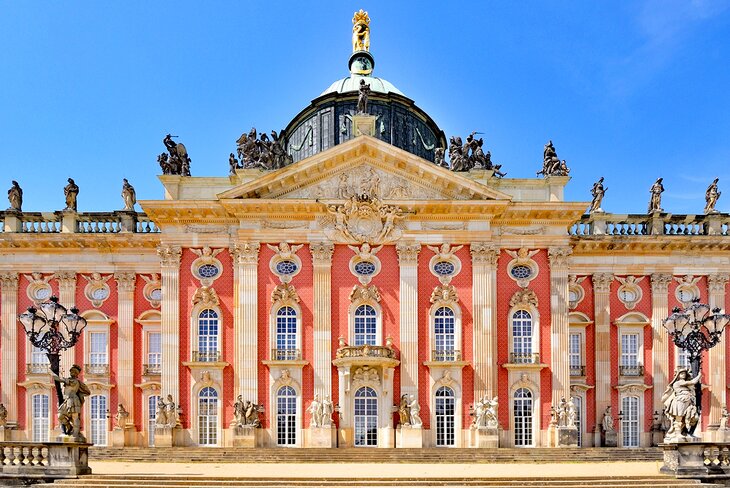
Today, much of this beautiful historic German city is protected under the UNESCO Palaces and Parks of Berlin and Potsdam World Heritage Site status.
With so many great things to do in this beautiful city, it can be somewhat challenging to know where to start. If all you can spare is one day in Potsdam, make sure the magnificent Sanssouci Palace and Park top your list. And have your camera ready: it's for good reason that this splendid palace and its grounds are regarded as one of the best places to photograph in Germany .
The city also hosts a number of exciting festivals, including the Music Festival Potsdam Sanssouci (Musikfestspiele Potsdam Sanssouci), which focuses mostly on classical music, as well as one of the country's largest and most popular Christmas markets .
Find out more about the best places to visit and things to do with our list of the top attractions in Potsdam, Germany.
See also: Where to Stay in Potsdam
1. Visit the Historic Home of Germany's Royals: Sanssouci Palace
2. take a walk in sanssouci park, 3. tour the new palace at sanssouci, 4. see the old masters at museum barberini, 5. visit the potsdam museum at the old town hall, 6. explore the dutch quarter (holländisches viertel), 7. cecilienhof country house, neuer garten, 8. explore new garden and marmorpalais, 9. see the chinese house in sanssouci park, 10. the church of peace, sanssouci park, 11. st. nicholas church, 12. learn about german film-making at filmmuseum potsdam, 13. enjoy movie-themed rides at filmpark babelsberg, 14. charlottenhof palace, 15. biosphäre potsdam, 16. take a tour of the steam pump house, sanssouci, 17. view the observatory at einstein tower, 18. russische kolonie alexandrowka, 19. the birthplace of the movies: babelsberg, 20. experience the chilling kgb prison (memorial leistikowstraße), where to stay in potsdam for sightseeing, tips and tactics: how to make the most of your visit to potsdam, map of attractions & things to do in potsdam.
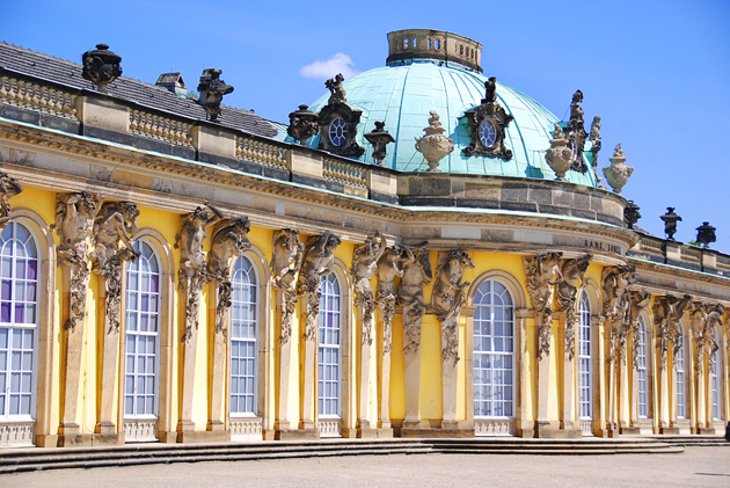
Widely considered one of the top tourist attractions in Germany , Sanssouci Palace (Schloss Sanssouci) was built in 1745 based on sketches by Frederick the Great. The result, a splendid single-story Rococo building with an elliptical dome in the center and circular rooms at each end, is simply spectacular. The garden front has rich plaster decorations, while on the rear is the Grand Courtyard, enclosed by colonnades of Corinthian columns.
The most notable interior features of Sansouci Palace are the oval Marble Hall, with its double Corinthian columns; the Little Gallery, with its elaborate decorations; the Concert Room with its large murals; the Bedroom and Study; the Library, with many antique busts; and the Voltaire Room.
Also worth checking out are the splendid New Rooms, or Neue Kammern. Built in 1747 as an orangery and later converted into a gardener's house, its interior is richly decorated. English-language audio guides are available for self-guided tours lasting approximately 40 minutes.
A fun time to visit is during the popular Night of the Palaces. This unique two-day event is held in June and sees Sanssouci Palace and Park open to the public after dark.
If you're visiting from Berlin and want to cram as much of this spectacular palace and its grounds into your itinerary as it will handle, you may want to consider joining an organized tour. The Potsdam half-day sightseeing tour from Berlin includes Sanssouci Palace and its beautiful gardens, as well as the Dutch Quarter and New Palace, all while avoiding line-ups. This fun four-hour guided tour also includes transport from a central location in Berlin.
Address: Maulbeerallee, 14469 Potsdam, Germany
Read More: Top-Rated Day Trips from Berlin
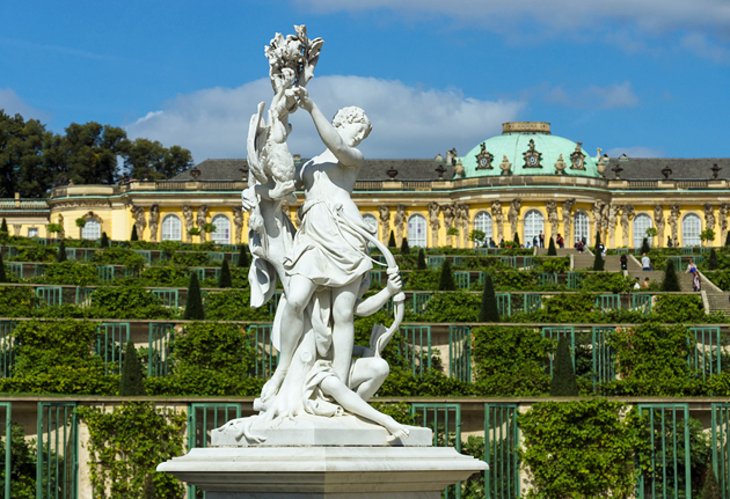
Sanssouci Park is the site of many beautiful gardens, buildings, and works of art. It's a pleasure to walk around, and makes a great starting place for a Potsdam cultural experience. The oldest part of the park dates back to 1744 and, along with its abundance of buildings and works of art, is considered the best example of Potsdam Rococo, reflecting as it does the influence of Frederick the Great.
The park entrance lies at the east end of Hauptallee, the property's main avenue. It's easy enough to find: just look for the tall obelisk near the main gate.
Once you're in you'll enjoy highlights including the lovely Neptune's Grotto, one of a series of roundels in the park, this one with the busts of four Moors. Look out for the splendid Picture Gallery at the Orange Roundel, too. Here you'll see many excellent 17th-century paintings, including works by Rubens, van Dyck, and Caravaggio.
Also worth seeing here is the Great Fountain with its representations of the four elements and of mythological figures. Have your camera at the ready!
Address: Zur Historischen Mühle 1, 14469 Potsdam
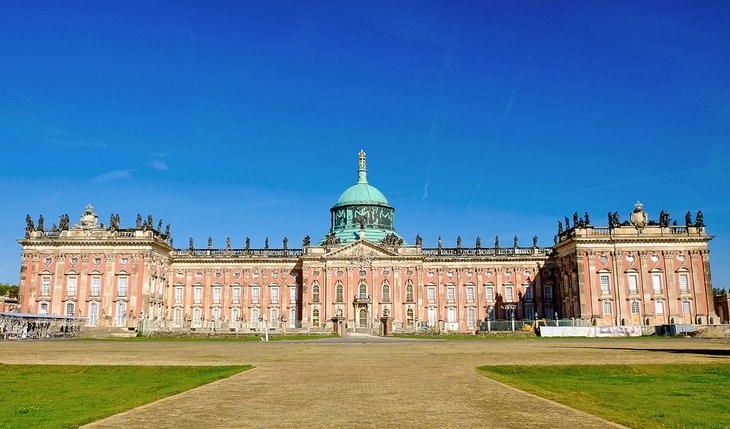
The New Palace (Neues Palais) was built between 1763-69 in red brick relieved by sandstone, with a copper dome. The palace's interior is sumptuously decorated, particularly in the Marble Hall, the Upper and Lower State Apartments, the Marble Gallery, and Theater.
You'll also see some of the palace's most valuable furniture, pictures, porcelain, and works of art. If you've got time, the New Palace is best viewed as part of an extended English-language guided tour that visits the King's Apartment.
While walking around New Palace, head to the rear of the building. Here you'll find the Communs, or Domestic Offices, two brick buildings in Baroque style with columned porticoes and curving external staircases. Between the two buildings are Corinthian colonnades and a triumphal arch.
In front of the New Palace are a number of other important structures, including the Ancient Temple and the Temple of Friendship built on the basis of sketches by Frederick the Great.
Address: Sanssouci, Am Neuen Palais, 14469 Potsdam
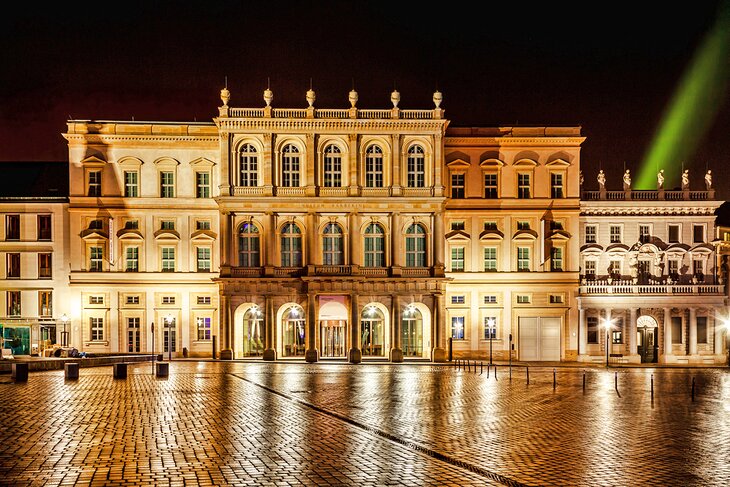
One of the newest attractions in this extremely old city, Museum Barberini opened in 2017 on the Old Market Square site once occupied by the former Barberini Palace, a building which was destroyed during a WWII bombing raid.
Already regarded as one of the top art museums in Germany, the facility's bright, modern galleries are home to a large collection of works from the country's leading painters, stretching from the time of the Old Masters to contemporary art.
Notable Impressionist artists whose work is featured include the likes of Monet and Rodin, as well as Edvard Munch. Regular temporary exhibits are also worth looking into and feature international collections of repute.
Daily English-language guided tours are available, as are audio guides. There's also a shop and a restaurant located on-site; weather permitting, opt for courtyard seating.
Address: Humboldtstraße 5-6, 14467 Potsdam
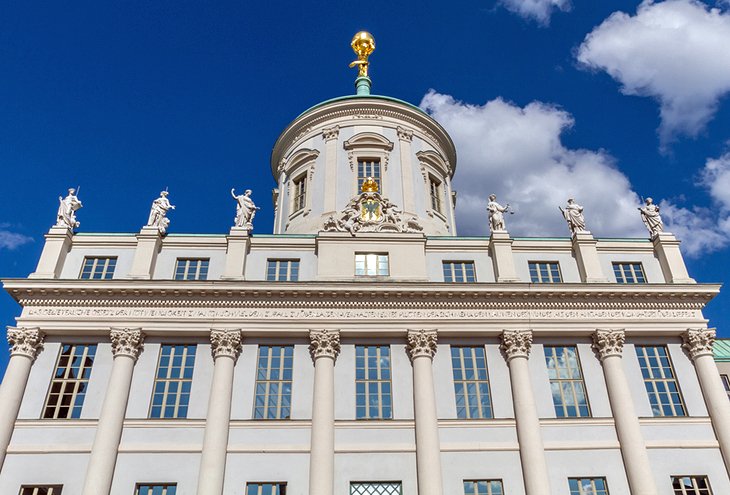
In Potsdam's Alter Markt, the Old Market Square, stands the former Town Hall, or Altes Rathaus. Now better known as a center for cultural events and activities, this splendid Baroque building was built in 1753 with three-quarter-length Corinthian columns and a tower with a stepped dome.
Be sure to look for the gilded figure of Atlas with the world on his back, the one original feature to survive the vagaries of weather and war. Extensively rebuilt after WWII, the building is used for exhibitions and concerts and houses the Potsdam Museum. It's worth visiting for its fine collections related to local art, culture, and the city's 1,000-plus-year history.
The Old Town Hall is linked by an intervening wing to the Baroque Knobelsdorff-Haus dating from 1750, also used for cultural programs.
Address: Am Alten Markt 9, 14467 Potsdam
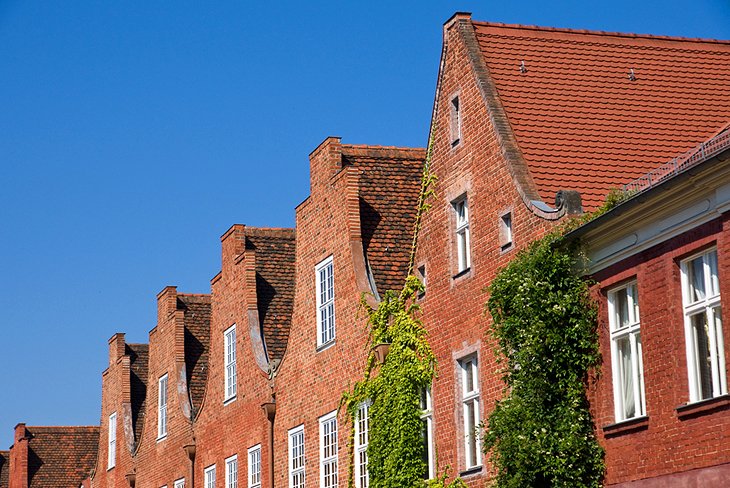
To the north of Bassinplatz lies the famous Dutch Quarter, the Holländisches Viertel. Notable for its 134 charming red brick houses graced by shuttered windows, gables, and white trim, the neighborhood was built between 1737 and 1742 by Dutch craftsmen. Today, this charming community is the largest collection of Dutch-style homes outside the Netherlands.
Covering four city blocks, it's as popular a place to visit for tourists as it is with locals, who flock here for its numerous boutique shops, quaint cafés, and first-rate restaurants. Anticipate spending a few hours exploring the area on foot, especially if you take in Johann Boumann House , a museum dedicated to the architect who led this remarkable 18th-century building project.
An easy stroll leads to the Brandenburger Strasse pedestrian zone with its houses built between 1733-39 for the billeting of troops.
Address: Holländisches Viertel 1, 14467 Potsdam
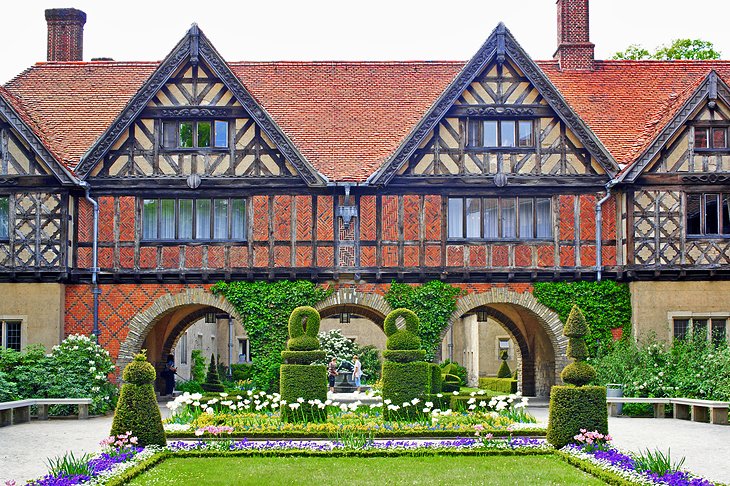
One of the more interesting of the many other buildings found in Neuer Garten is Cecilienhof Country House (Schloss Cecilienhof). Built between 1914-17 in the style of an English Tudor country house, Cecilienhof is most famous as the meeting place of the Potsdam Conference of July-August, 1945, between the US (Truman), the UK (Churchill), and the USSR (Stalin) at the end of WWII.
Now set up as a museum, the building is wonderfully preserved in the state it was in during the conference, including the main conference room itself. Many original artifacts remain in place, along with displays detailing the event and its significance. Other highlights include the obelisk in the courtyard and the property's lovely gardens.
Address: Im Neuen Garten, D-14469 Potsdam
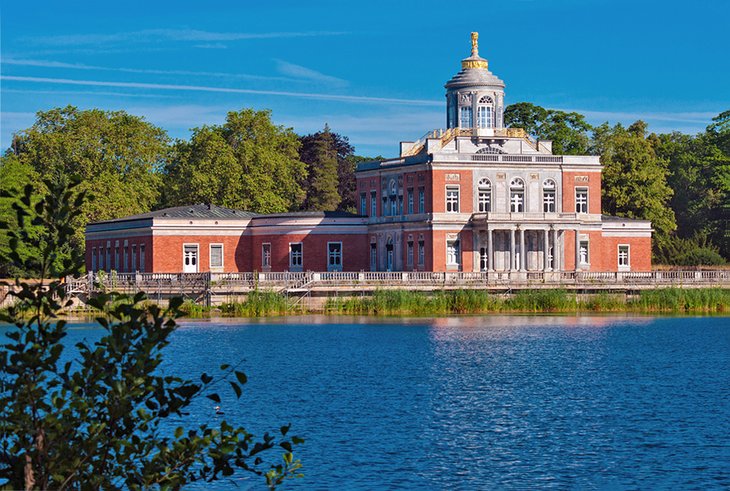
Potsdam's other large park, the New Garden (Neuer Garten) lies on the shores of the Heiliger See and covers an area of 253 acres. Splendidly landscaped in the sentimental style of the late 18th century and laid out in 1789, it was meant to reflect the style of a rural English country estate. The gardens are now a little more formal, but certainly retain their original splendor.
A highlight of your visit should be the lovely Marble Palace (Marmorpalais), a Neoclassical brick building constructed between 1787-91. Notable features are its columned portico on the lake side, as well as a unique, pyramid-shaped cold-storage room or icehouse. A pleasant café is located in the garden's original Orangery.
Address: Am Neuen Garten, 14467 Potsdam
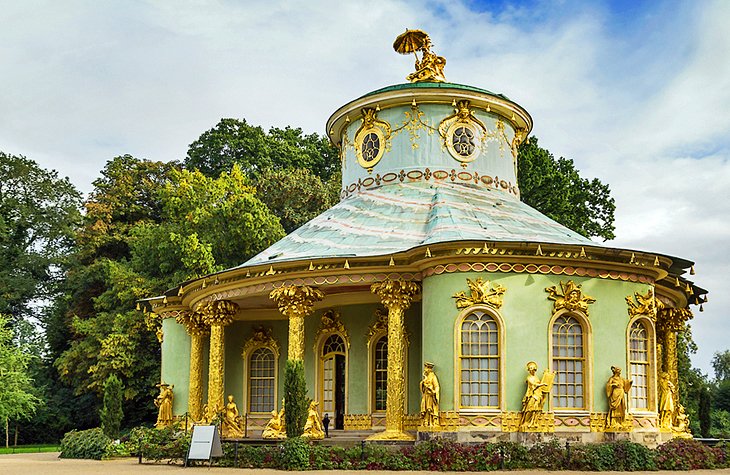
A highlight of a visit to Sanssouci Park is the elegant Chinese House (Chinesisches Haus), sometimes also referred to as the Chinese Teahouse. Although listed as a garden pavilion, it's a description that really doesn't do this sumptuously decorated building justice.
Completed for Frederick the Great in 1763 as a focal point of his extensive flower and vegetable gardens, it encompasses many elements associated with Asian design so popular at the time, with a sprinkling of Rococo influences.
Its interior contains many interesting features, from its stucco marble walls to its musical monkeys and fine collections of porcelain and murals. Also of note are the nearby Chinese Kitchen and Dragon House , the Orangery with its Raphael Room containing copies of 47 works by the artist, and the Sicilian Garden with its Mediterranean plants and sculptures.
Address: Am Grünen Gitter, 14469 Potsdam
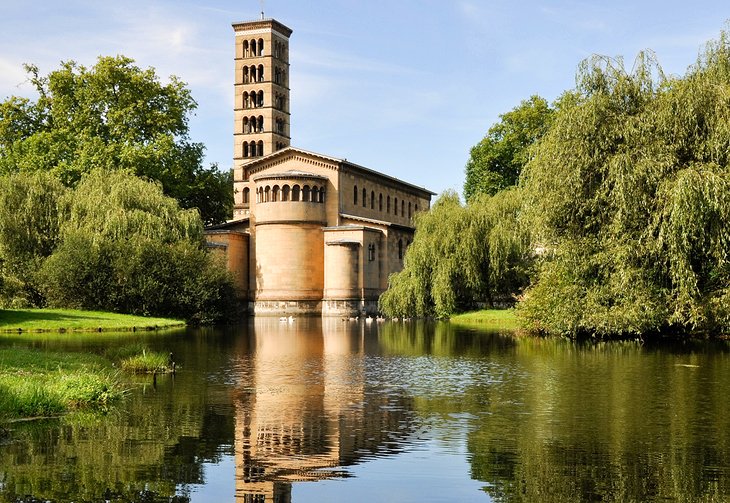
At the east end of Sanssouci Park stands the Church of Peace , or Friedenskirche. Built in 1844, it was modeled on the Early Christian basilica of San Clemente in Rome. Its greatest treasure is its apse mosaic dating from 1108 from the church of San Cipriano, Murano, purchased and installed here in 1834. Also of importance is the Kaiser Friedrich Mausoleum , added between 1888 and 1890.
Be sure to spend time wandering the park areas surrounding the church, too. Highlights include the aptly named Garden of Peace, a romantic-styled garden notable for its shrubbery and trees, as well as its Pool of Peace. On the avenue leading to the Grünes Gitter, the park's exit, are Villa Illaire, built in 1846, and the Villa Liegnitz dating from 1841, both built in the style of an Italian villa.
Address: Am Grünen Gitter 3, 14469 Potsdam, Germany
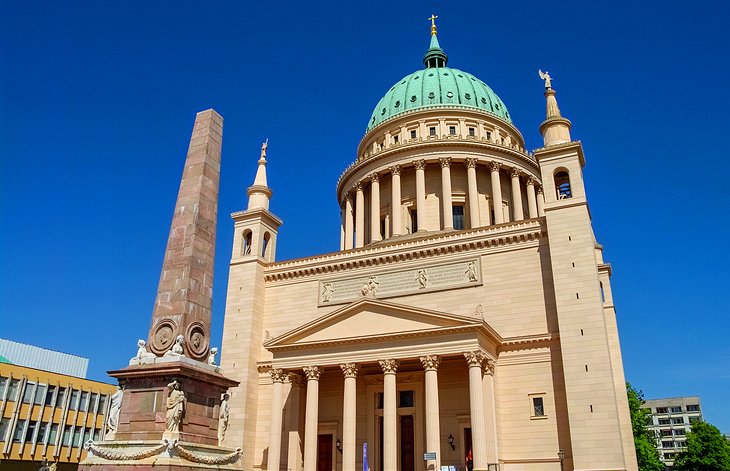
Located opposite the Old Town Hall in Potsdam, St. Nicholas Church (Nikolaikirche) is a beautiful Neoclassical church built between 1830-37 on the city's Old Market Square (Alter Markt ). The most outstanding feature of this impressive structure is its 77-meter-high dome, which rises high above most other buildings in the vicinity.
Although not reconsecrated until 1981 due to the rebuilding needed from extensive damage caused during WWII, it's a testament to the city's rich architectural history, a pleasing structure open to visitors for services and sightseeing. In front of the church is an obelisk built in 1753 with the likeness of the principal architects of Potsdam.
Also of note is nearby Friendship Island with its lovely gardens laid out in 1953.
Address: Am Alten Markt, 14467 Potsdam, Germany
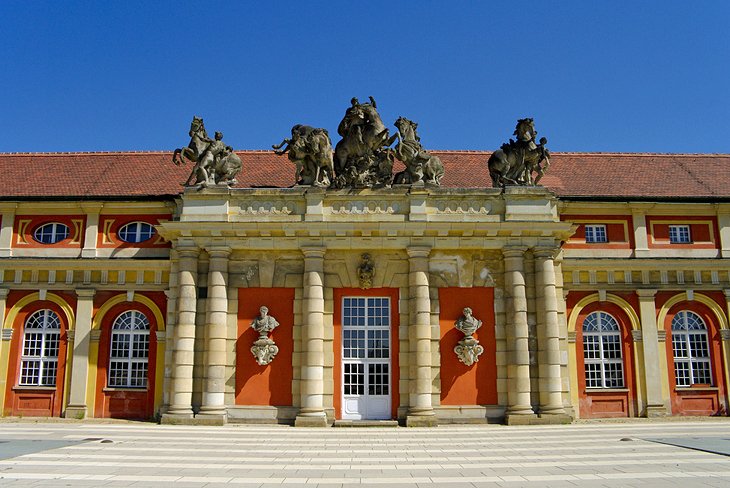
Located in the stunning 17th-century Baroque Marstal, the former Court Stables (Potsdamer Stadtschloss), Filmmuseum Potsdam is an excellent resource of fun facts for film fans. With a worldwide focus, the museum regularly screens international and German movies and has many fascinating exhibits relating to the country's rich cinematic history.
One of the most interesting exhibits focuses on the famed Babelsberg studio, where many of the country's movies have been made over the past 100 years, including such recent classics as Grand Budapest Hotel . A great café is located on the premises, and the museum is easily reached by public transit.
Another nearby attraction is the French Church , a Baroque church remodeled in Neoclassical style in 1833.
Address: Breite Straße 1 A, 14467 Potsdam, Germany

Fun to visit after seeing Potdam's Filmmuseum, Filmpark Babelsberg is the world's oldest film studio and is home to a fun film-based theme park. In addition to the often thrilling rides, guests can enjoy tours of historic film sets, props, and costumes.
It's very much still a working film studio, and you can often also see domestic and international stars in action, or simply passing by on the way to the next big shoot. Fascinating behind-the-scenes tours are available in English and other languages, and include hands-on experiences that allow you to sit behind a news or weather desk in a TV studio.
There's also a 4D cinema showing the latest Hollywood blockbusters and other shows, plus movie-themed dining options. Special experiences are also available for children, including seeing the filming of popular kids' TV shows.
Address: Großbeerenstraße 200, 14482 Potsdam
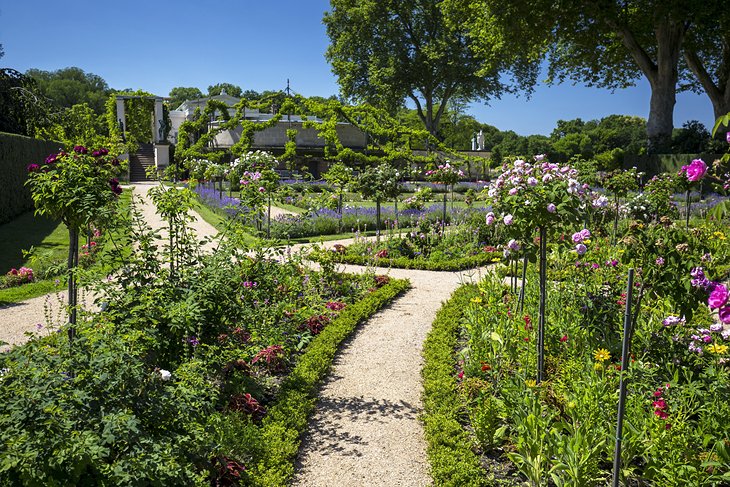
Although much smaller than its neighbor, the Sanssouci Palace, the Neoclassical Charlottenhof Palace (Schloss Charlottenhof) is certainly worth including on your Potsdam itinerary. Often referred to as Charlottenhof Manor, it can, in fact, be included on a tour of Sanssouci Palace.
Built on grounds given by King Frederick William III of Prussia to his son, the Crown Prince, in 1825 as a Christmas gift, it's a pretty property to explore for its parklike setting and its many charming outbuildings. Much of the ensuing summer palace was in fact designed by the Crown Prince himself, evidence of which can still be seen in the interior design flourishes in the 10 rooms that are open to the public.
Highlights of a tour include the original elegant furniture and the famous "tent room," a colorful room said to be modeled after a royal tent from Roman times and once used as a guest room. As you tour the garden, you'll no doubt be impressed by its English styling, including its fountains and porticos, the creation of landscape designer Peter Joseph Lenné.
Address: Geschwister-Scholl-Straße 34A, 14471 Potsdam
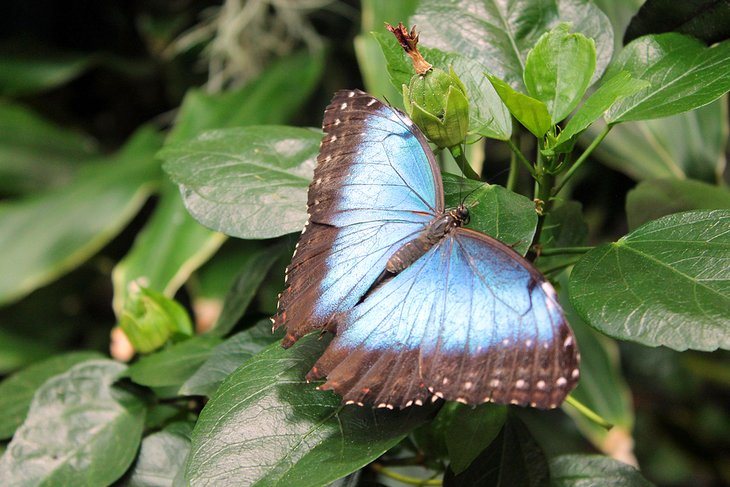
If you're able to squeeze in another garden attraction on your already busy Potsdam itinerary, make sure it's Biosphäre Potsdam . This huge indoor tropical garden, found in Volkspark Potsdam near Sanssouci Park, is home to more than 350 species including some 20,000 individual plants.
Among its collections are beautiful orchids, a palm grove, a mangrove swamp, and tropical wildlife including snakes, lizards, butterflies, and spiders.
Address: Georg-Hermann-Allee 99, 14469 Potsdam
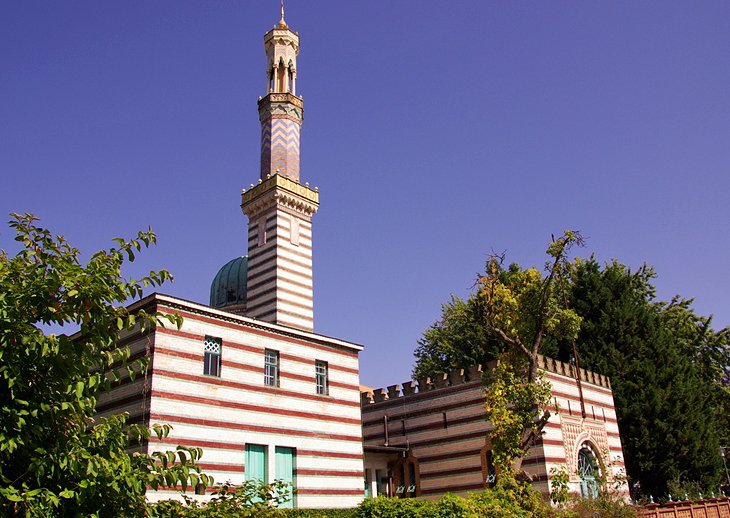
Built in 1841 to provide water for the numerous fountains in Sanssouci Park, the Steam Pump House , or Dampfmaschinenhaus, resembles a Moorish-style mosque with its chimney cleverly disguised as a minaret. Prior to its construction, Frederick the Great's plans for his fountains couldn't be realized.
Located on the edge of the Neustädter Havelbucht, today you can explore the facility during the warmer months via guided tours. These fascinating behind-the-scenes experiences take in the old steam machinery, permanent exhibits on the facility's history, as well as its architecture.
Address: Breite Straße 28, 14467 Potsdam
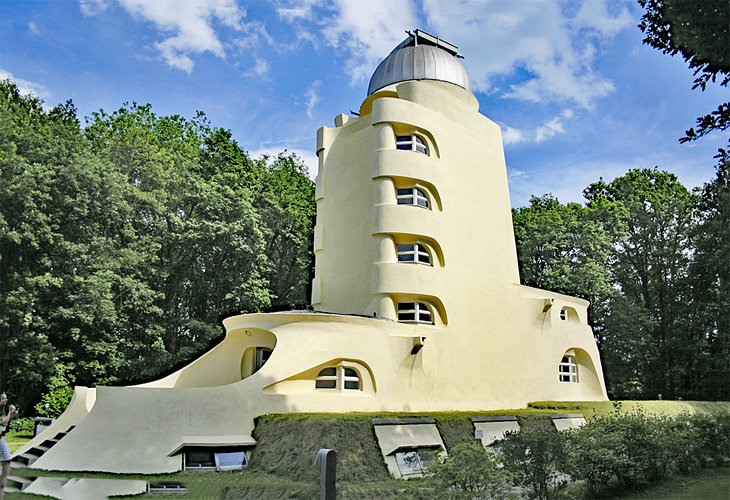
Those interested in science won't be disappointed with a visit to the Einstein Tower (Einsteinturm). Located in the Albert Einstein Science Park, the tower was built in 1924 and is in fact an important astrophysical observatory built to hold a large solar telescope.
The telescope itself was designed to prove Einstein's theory of relativity through observations and experiments and is still in operation as a solar laboratory, housed in its basement.
The brick and stucco building's unusual Expressionistic design reflects the great scientist's theories, rather euphemistically (and somewhat generously) described by Einstein as "organic."
Highlights of a visit include a rare pre-war sculpture that had evaded detection (the Nazi government would have destroyed them), and the curious, small bronze brain sculpture that references the theories of German scientist Ernst Poppel.
Address: Albert-Einstein-Straße, 14473 Potsdam
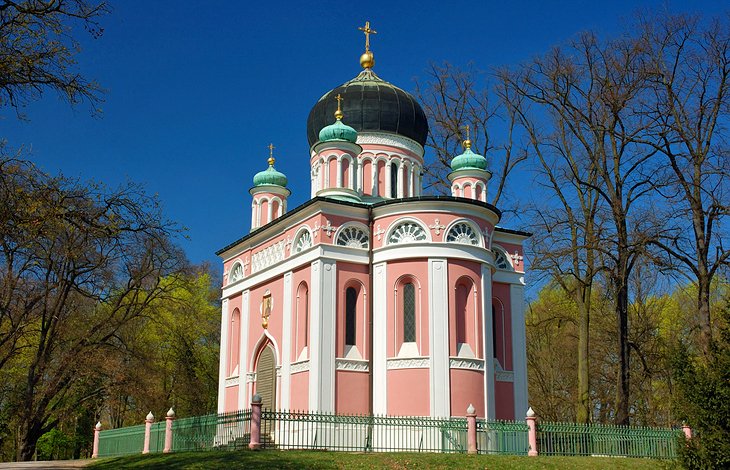
The houses in the little settlement of Alexandrowka in Potsdam were built to demonstrate the close friendship that existed between the rulers of Germany and Russia, Frederick William III, and the Czar Alexander. The houses were based on Russian models, and the settlement was laid out in the form of a St. Andrew's cross.
Other highlights of this quaint community include the Alexander Nevsky Church , a Russian Orthodox church built in 1829, with rich furnishings from St. Petersburg, as well as the Jewish cemetery started in 1743.
Address: Russische Kolonie 2, 14469 Potsdam
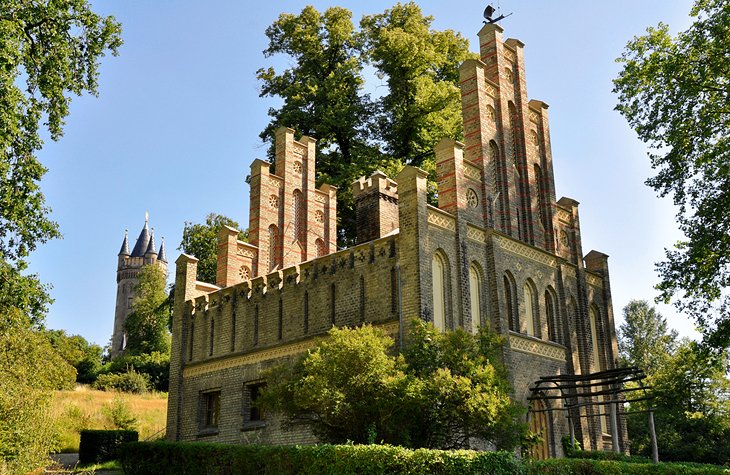
The district of Babelsberg, the largest area of Potsdam, was famous in the early days of cinema as the home of UFA film studios. Originally developed around Nowawes, an old colony of spinners and weavers, the district's heritage can still be detected near the church on Weberplatz, a modest building constructed in 1753.
Other highlights of this delightful area include Babelsberg Park . The third-largest public green space in Potsdam, it was laid out in 1832 and enlarged from 1843 onwards. You'll also want to take a look at Schloss Babelsber, or Babelsburg Palace, a Neo-Gothic English-style palace built in 1834.
Address: Park Babelsberg 10, D-14482 Potsdam-Babelsberg
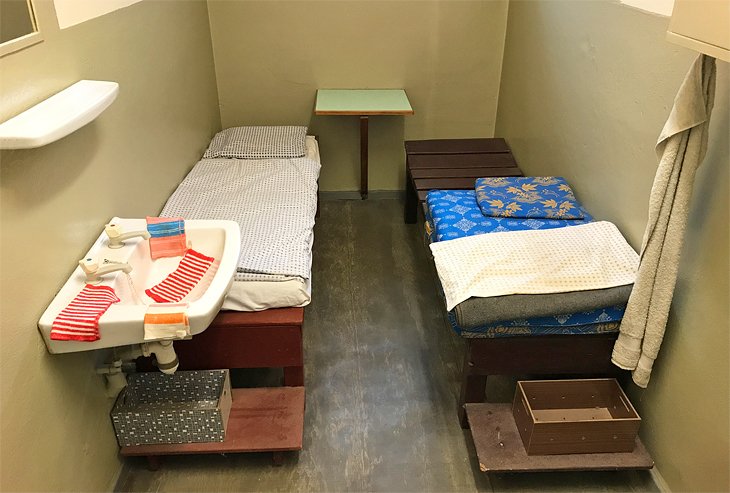
For a fascinating yet chilling look at the often tough life in East Germany, pay a visit to the KGB Prison (Memorial Leistikowstraße). Operated by SMERSH, the Soviet counter-intelligence organization, this former detention center started off, ironically, as the offices of a Christian charitable group.
The prison also served the adjacent military camp and German KGB headquarters and was notorious for holding both German and Russian prisoners suspected of being spies or collaborators throughout the 1950s right up until the 1980s.
Now a memorial to those who were held and tortured here, you'll get to tour the former prison cells, some still with prisoner graffiti scratched into their walls. You'll also see the notorious detention room. There's also a permanent exhibit relating to its terrible history. Free audio guides are included with the cost of admission.
Address: Leistikowstraße 1, 14469 Potsdam
Luxury Hotels :
- A great choice of luxury accommodation in this important cultural city is the Hotel Brandenburger Tor Potsdam . Named after the beautiful Brandenburg Gate Potsdam, which it's close to, this luxe hotel is popular for its classy rooms and apartments.
- The Potsdam Hotel Am Jägertor is situated across from another historic city gate, the Jägertor, and offers a variety of chic rooms and suites with great city or courtyard views.
Mid-Range Hotels :
- The centrally-located Maxx Hotel Sanssouci Potsdam offers affordable four-star hotel quality along with friendly staff, a fun classic movie theme, and a variety of spa services, including a Finnish sauna.
- Other good mid-range accommodation options include NH Potsdam , popular for its great-value rates, its fabulous location near the city's top restaurants and shops, and its excellent breakfast; and the elegant Hotel Villa Monte Vino , a charming, family-owned boutique hotel set in a historic building within easy walking distance of Sanssouci Palace.
Budget Hotels :
- A high-quality big-brand hotel offering, the Mercure Hotel Potsdam City offers surprisingly affordable, budget-friendly rates with modern rooms in a convenient location. A great breakfast is also included.
- Other great accommodations offering affordable stays include the Seminaris SeeHotel Potsdam ; though located a little farther from the main sites, it's worth considering for its lovely lake views. Also worth checking into is the Wyndham Garden Potsdam, offering straightforward, clean rooms within an easy walk of the city's top attractions.
Take a Bike :
- Given its high density of top historic attractions, Potsdam is a great place to tour on two wheels. A great option for day-trippers arriving via Berlin, the fun 4.5-hour guided Potsdam Day Bike Tour takes in such important tourist attractions as Sansoucci Palace, the historic Dutch Quarter, and the famous Cecilienhof Palace (audio-guide provided), scene of the famous Potsdam Conference at the end of WWII. In addition to return rail fares from Berlin, insurance, bike rentals, and helmets are included (suitable ages 12 and up).
Take a Hike :
- If you prefer foot-power to pedal-power, there are also a variety of great walking tours of Potsdam worth shelling out for. One of the best is the Potsdam Half-Day Walking Tour . Highlights of this six-hour walk around one of the most pedestrian-friendly cities in Germany, if not Europe, include the exquisite Sanssouci Palace and Gardens, plus Cecilienhof Palace. Along the way, you'll see the Marble Palace, the Dutch quarter, and the city's Babelsberg castle, as well as enjoy a lunch break (the latter at your own expense). This particular walking tour experience starts in Berlin (meet up at the Hackescher Markt train station) where you'll be greeted by your guide before embarking on the short ride to Potsdam. And if you need more time to see additional sites, you can carry on touring afterwards at your own pace (your guide will provide you with maps and tips). A note regarding rail tickets: the handy Berlin Transport ABC Zone Day Pass will also get you all the way to Potsdam.
More Related Articles on PlanetWare.com
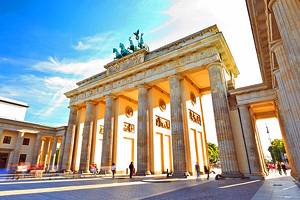
The Nation's Capital, Berlin : Less than a 30-minute train ride northwest of Potsdam, Berlin is also worth visiting for its many fine cultural attractions. Of particular interest are its many museums and art galleries , some of the best of which can be found on its famous Museum Island. It's also possible to enjoy some great day trips from Berlin , too, including to beautiful Peacock Island, and the lovely Spree and Havel rivers.
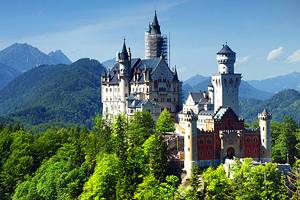
Germany's Best Castles : Germany has done a magnificent job of preserving (or, in some cases, rebuilding) its many old castles. Some of the best places to view these majestic fortresses, some of which date back to medieval times, include the lovely Rhine Valley , including Marksburg Castle and more than 20 others, and the Mosel Valley , home to the imposing Etz Castle. One of the most impressive old fortresses, though, is Nuremberg Castle, the home of German kings since the early 11th century, and one of the top attractions in Nuremberg .
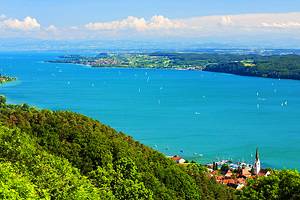
Top Vacation Spots in Germany : One of the largest countries in Europe, Germany has many great places to spend a vacation. Those seeking a big-city getaway should consider either Munich , famous for its magnificent cathedral and royal palace, and Frankfurt , a great choice for those who enjoy walking pedestrian-friendly streets and market squares. For those seeking a slightly slower, rural pace, head for lovely Lake Constance , home to some of the prettiest scenery in the country.
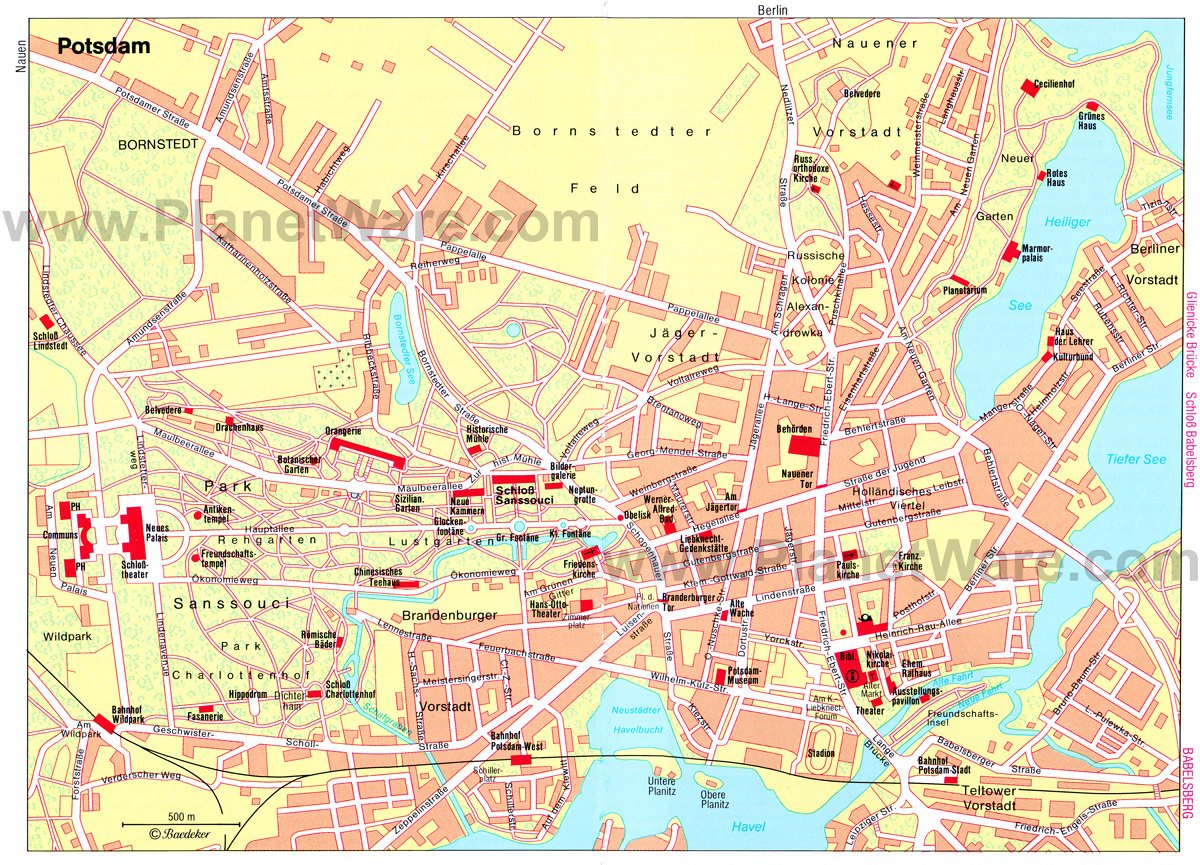
More on Germany


IMAGES
COMMENTS
If travel by S7: Get off at Potsdam-Babelsberg station, walk about 2 minutes to Rathaus Babelsberg station, take bus 616 to visit the first Babelsberg Palace (vice versa the route above). Potsdam Hbf - The Potsdam's central station. | potsdam blog Potsdam tourist guide: Getting around Potsdam
Potsdam is an easy day trip from Berlin, just a 30-minute ride on the S-Bahn. To get there, hop on the S7 S-Bahn train or the RE1 and RB23 trains. ... I'm an expert in travel planning and I am here to help you plan your dream vacation. 8 Comments Mariëlle Kappetein. November 24, 2021 / 3:43 pm Reply. Now it's the 24th of November and we ...
Simply take the RE1 train past Bhf Potsdam and get off at Bhf Park Sanssouci. The Neues Palace is an enjoyable 8-10 minute walk from there. If you want to go to the Sanssouci Palace first, take either the S7 or RE1 to Bhf Potsdam and take the bus from there to Schloss Sanssouci.
Visit the largest World Heritage Site in Germany and explore the beautiful city of Potsdam. Travel back in time and catch a glimpse of how the Prussian and German Royalty once lived here. The charming city of Potsdam is only a short 45 - 50 minute train ride from the capital of Germany and is one of the best day trips to experience from Berlin.
Potsdam trains run approximately every 30 minutes. Potsdam is in zone C, so your regular Berlin zone AB ticket won't do. Make sure you get an ABC ticket - it will be €3.40 each way. If you have a Berlin weekly card for zone AB you'll have to get an Anschlussfahrausweis (extension) ticket.
15. Nikolaikirche. Opposite the rebuilt facade of the Palast Barberini on Alter Markt is a regal Neoclassical church grabbing your attention for its dome and portico. Court architect Karl Friedrich Schinkel drew up the plans, and the church, the largest in Potsdam, was built in two phases from 1830 to 1850.
From Berlin Central Station (Berlin Hauptbahnhof), take the S-Bahn S7 train to Potsdam Hauptbahnhof, the terminal station. The journey takes 40 minutes, and arrives in 10 to 30-minute intervals. Alternatively, you may also take the Regionalexpress RE1 train towards Brendenburg / Magdeburg, which takes slightly less time at about 25 minutes, but ...
Option 1: Regional train from Berlin to Potsdam. Taking the regional train is the best option in most cases because it will take you from Berlin Hbf to Potsdam Hbf in just 25 minutes. The regional train also makes fewer stops than the Sbahn. Look for RE1 going towards Brandenburg Hbf.
1. Karstadt Potsdam. Karstadt is a German department store chain with many stores in Germany. The company features brands like Cacharel, Clarins, Coach, Desigual, Estée Lauder. Brandenburger Str. 49/52, 14467. 2. Stern Center Potsdam. The Stern Center Potsdam is located 5.9 km (3.7 miles) from the Central Station.
2. Potsdam Museum. Just to the right of the church is the Potsdam Museum. The museum displays the cultural history and day-to-day life of Potsdam throughout its last 1000 years of history. 3. Steam Engine Building (Mosque) Our next stop was small and beautiful mosque looking building by the Havel River.
Just 15 miles southwest of Berlin, the former royal seat of Prussia can easily be reached on the S-Bahn. This makes it the most popular day trip from the city, for tourists and locals alike. You can look forward to lovely palaces and alluring gardens in this jewel of a destination, which is also on the UNESCO World Heritage List.
Travel photos, blogs and features from Potsdam in Germany. This 1000 year old city has a turbulent history and offers a lot to visitors from nearby Berlin. ... Start here with my basic Potsdam travel tips, or jump down below to read my latest Potsdam travel blogs. When to Visit. Potsdam is a great summer destination, since a lot of the sights ...
How To Get From Berlin To Potsdam. The fastest and easiest way to get from Berlin to Potsdam is by train. The best travel options are departing from Berlin Central Station on the S-Bahn (S7), Berlin's city train (meaning that not only is it fast, it's super cheap too) or the Regional train (RE1). Check out the S-Bahn times and schedules here.
Take RE 1, and go to Postdam and then Take RB 23, and go to Park Sanssouci...Walk for 10 mins and you will reach this beautiful destination called Neune palais ( New Palace). The building was begun in 1763, after the end of the Seven Years War, under King Friedrich II (Frederick the Great) and was completed in 1769.
Getting to Potsdam from Berlin. There are many Berlin to Potsdam transportation options. Travelers can make the drive up the autobahn (A115) in less than 40 minutes. There are also regular trains that take less than half an hour. The train from the Berlin Central Station (Berlin HBF) drops riders off near the Sanssouci Palace.
Glienicke Bridge (Glienicker Brücke): Built in 1907, the Glienicke Bridge crosses the Havel River connecting Berlin and Potsdam. Also known as the Bridge of Spies, it was where the Soviet Union and the U.S. exchanged captive spies during the Cold War. Cecilienhof Palace: The elegant palace is designed as a typical Tudor manor house.
8. The KGB Prison. Address: Leistikowstraße 1, 14469 Potsdam, Germany. Also known as the Memorial Leistikowstrabe, the KGB Prison gives you a glimpse of life during East and West Germany. Remember to add it to your list of things to do in Potsdam and learn more about the tough times of this era.
Get directions. Phone +49 331 8170203. Visit website. Just north of Potsdam's city center, you'll find the Russian Colony Alexandrowka. Built in 1827, there are 13 wooden Russian homes that the Prussian King erected. They were built to house the Russian singers of the First Prussian Regiment of the Guards.
Potsdam in one day. Morning. Start your day in Potsdam at the Old Market, which is used to be one of the most beautiful squares in Europe.With the inauguration of the Brandenburg State Parliament in the reconstructed facade of the City Palace which got destroyed during World War 2, the historic heart of the city started to beat again in 2014.
Europe. Potsdam, on the Havel River just 25km southwest of central Berlin, is the capital and crown jewel of the federal state of Brandenburg. Easily reached by S-Bahn, the former Prussian royal seat is the most popular day trip from Berlin, luring visitors with its splendid gardens and palaces, which garnered Unesco World Heritage status in 1990.
Rough Guides® is a trademark owned by Apa Group with its headquarters at 7 Bell Yard London WC2A 2JR, United Kingdom. Plan your visit to Potsdam, Germany: find out where to go and what to do in Potsdam with Rough Guides. Read about itineraries, activities, places to stay and travel essentials and get inspiration from the blog in the best guide ...
Every travel guide should include city maps, ideally as a removable folding map and an overview of public transport. Discover Potsdam from the water! Experience boat trips, island, and castle tours starting from 20 euros with GetYourGuide. Book flexibly, securely, and with a refund option up to 24 hours before the start.
Find out more about the best places to visit and things to do with our list of the top attractions in Potsdam, Germany. See also: Where to Stay in Potsdam. On This Page: 1. Visit the Historic Home of Germany's Royals: Sanssouci Palace. 2. Take a Walk in Sanssouci Park. 3. Tour the New Palace at Sanssouci.